Early Views of Santa Catalina Island
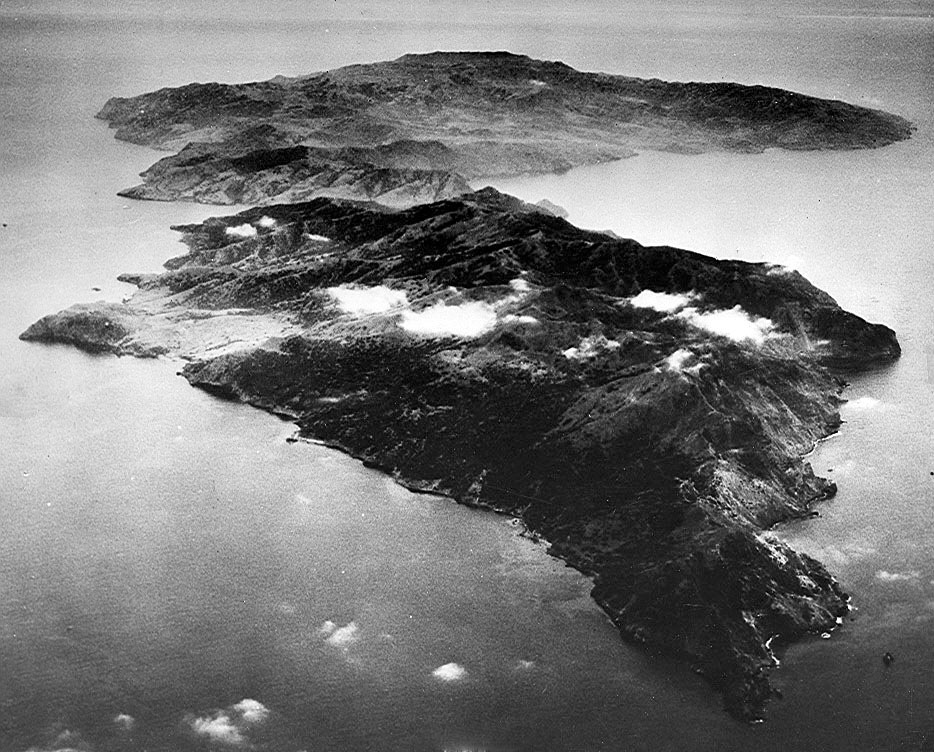 |
|
| Aerial view of Catalina Island before it was developed. View is looking south. The Island was created by a force known as "tectonic uplift."* |
Historical Notes Santa Catalina Island, often called Catalina Island, or just Catalina, is a rocky island off the coast of California, just 22 miles south-southwest of Los Angeles. The island is 22 miles long and 8 miles across at its greatest width. The highest point on the island is 2,097 feet Mt. Orizaba. Part of the Channel Islands of California archipelago, Santa Catalina lies within Los Angeles County. |
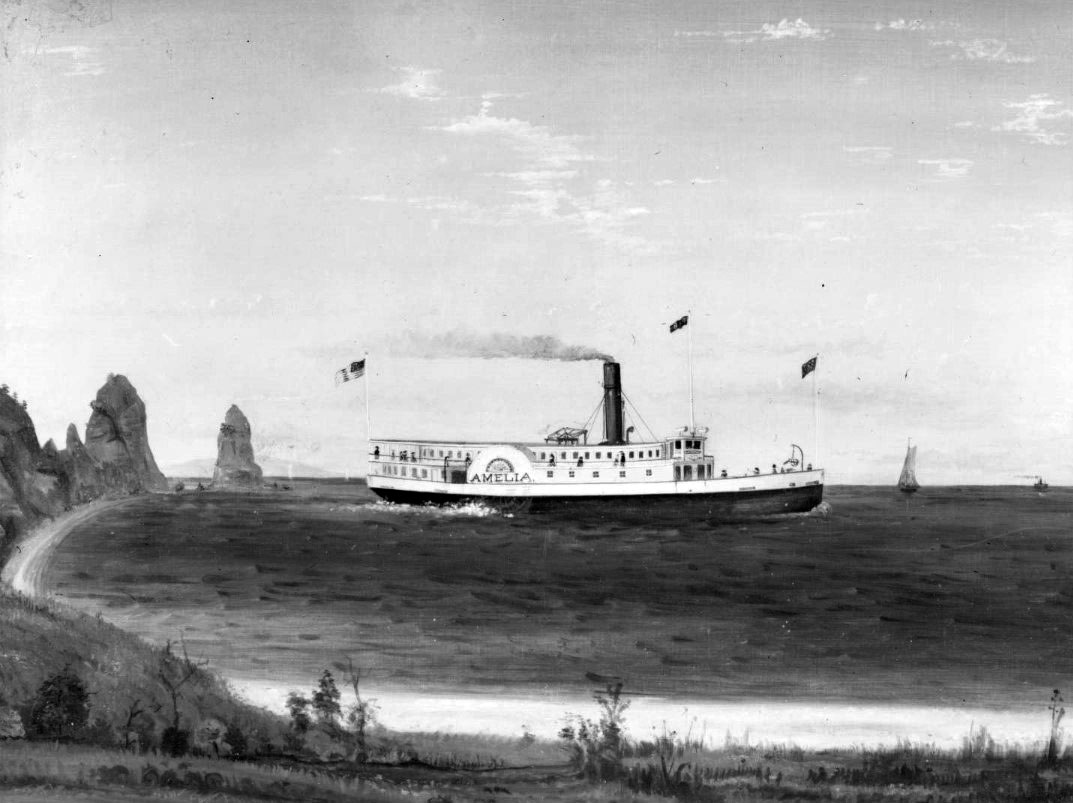 |
|
| (1880s)^^ - Photograph of a painting of the S.S. Ameilia near the shore of Avalon Bay. To the left, the coastline of Catalina Island curves to the right and ends at a point with a sureal-like rock formation, called "Sugarloaf Point". |
Historical Notes Picture file card reads: S.S. Amelia, first steam vessel on Wilmington - Catalina run, from 1880 to 1883. Owned by Wilmington Transportation Co., whose president was Phineas Banning. |
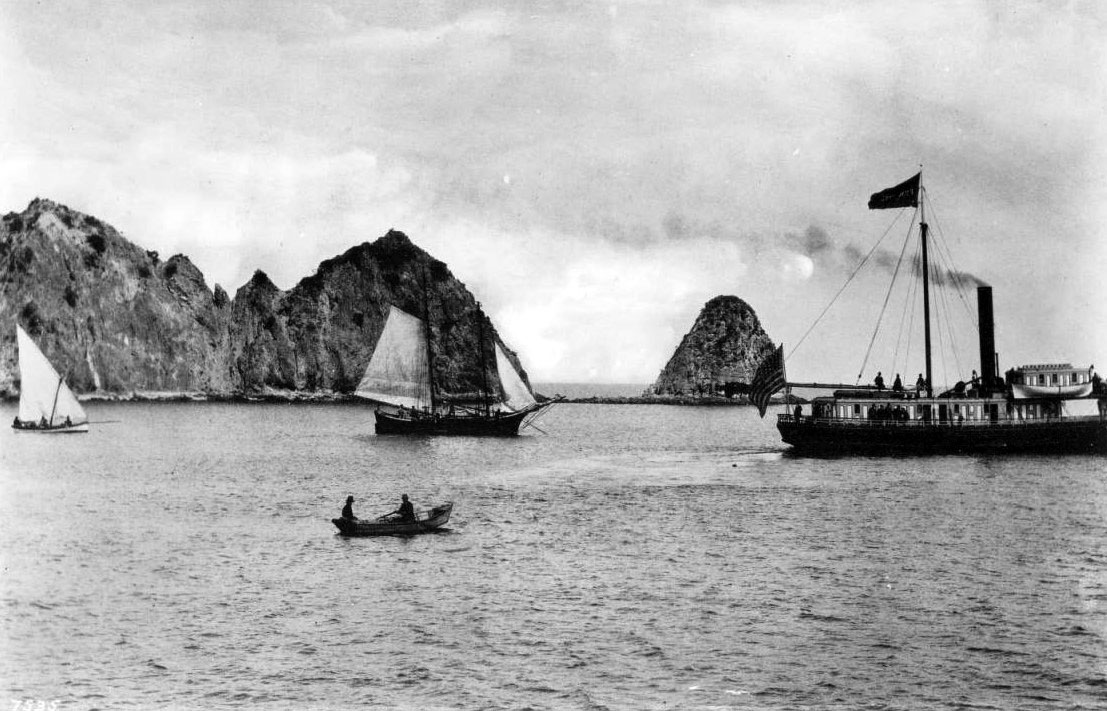 |
|
| (1887)^^ - View of Avalon Bay and Sugarloaf, showing a Ferndale steamboat and a Ruby schooner. The schooner is visible on the water at center, a small flatboat with two people visible in front of it. Farther to the left of it, a second sailboat can be seen. The steamer is pictured flying an American flag off of its stern at right. A mountain ridge and large hill are pictured in the background. |
Historical Notes The first European to set foot on Santa Catalina Island was the Portuguese explorer Juan Rodríguez Cabrillo, who sailed in the name of the Spanish crown. On October 7, 1542, he claimed the island for Spain and christened it San Salvador after his ship. Over half a century later, another Spanish explorer, Sebastián Vizcaíno, rediscovered the island on the eve of Saint Catherine's day (November 24) in 1602. Vizcaino renamed the island in the saint's honor. |
.jpg) |
|
| (ca. 1886)^^ - View of Sugarloaf Point (rock formation rising from the water) and Avalon harbor, Santa Catalina Island. Four small boats are anchored in the harbor. Catalina Island rises steeply from the water's edge. The rocky slopes are covered with brush and a few scraggly trees. |
Historical Notes The Gabrielino Indians lived on Catalina Island for over 7,000 years. When Cabrillo discovered the island in 1542, it was claimed by the king of Spain. Mexican ownership dates from 1821, when Mexico achieved its independence from Spain. |
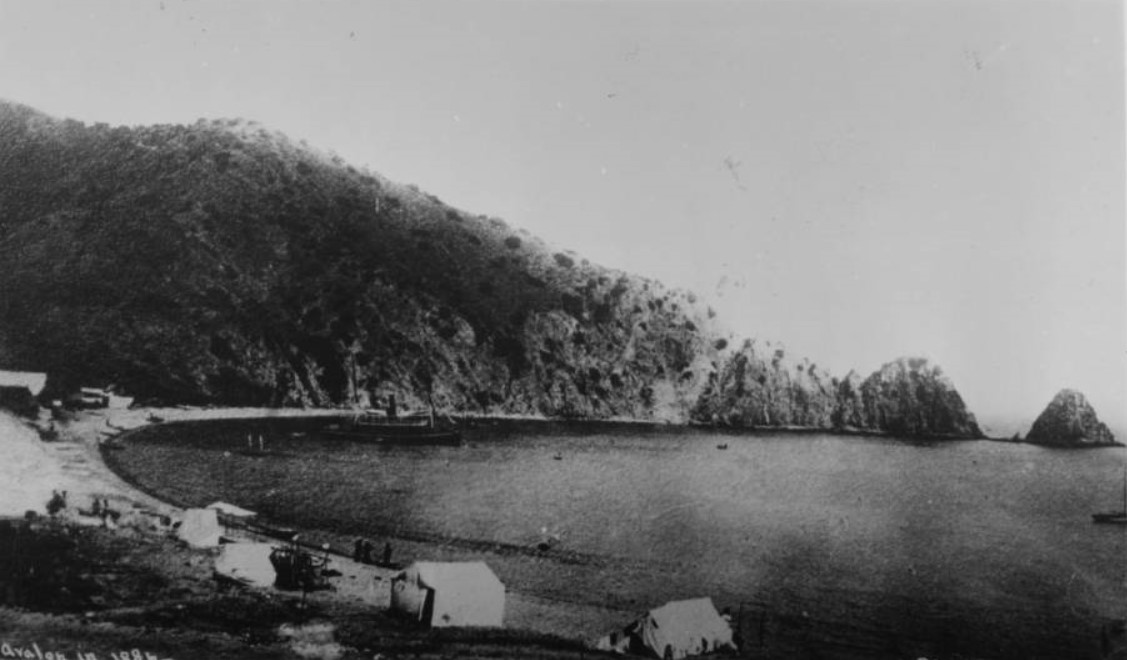 |
|
| (1886)^^ - Photograph of an early view of Avalon Bay, Catalina. The shoreline curves around from the foreground at center to the background at right to a rock formation called Sugarloaf Point. Tents can be seen along the beach and a steamship is in the harbor at left. |
Historical Notes In 1846, Governor Pio Pico of Mexican California granted Catalina Island to a private citizen, Tomas Robbins, who owned it until 1850. In that year, he sold Catalina to Jose Maria Covarrubias for $10,000. Covarrubias sold the island to Albert Packard of San Francisco in 1853. The Island then went through a complex phase of ownership changes and divisions until it was acquired by James Lick in 1864. By 1867, Lick had entire ownership of the Island. |
* * * * * |
The Hotel Metropole and Avalon’s First Resort Era
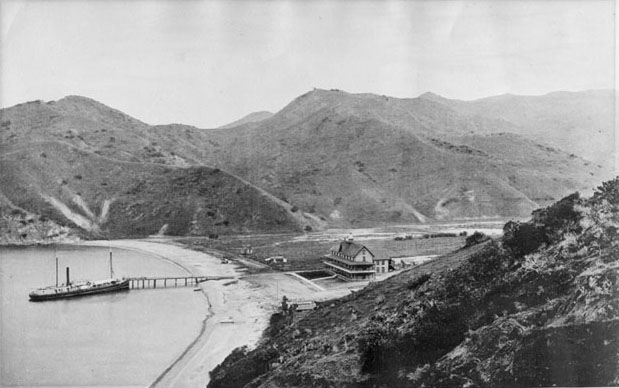 |
|
| (ca. 1888)* - View of a steamer docked at a pier in Avalon Bay in front of the newly constructed Hotel Metropole, Catalina Island. |
Historical Notes In 1887, real-estate developer George Rufus Shatto, originally from Grand Rapids, Michigan, bought Santa Catalina Island from the Lick estate for around $200,000. Catalina had already passed through Tongva, Spanish, Mexican, and early American hands before James Lick, the San Francisco philanthropist, became its long-time owner. Shatto’s purchase marked the beginning of Catalina’s modern resort era: he laid out the settlement of Avalon, built its first pier and the original Hotel Metropole, and promoted land sales to spark tourism. His sister-in-law, Etta Whitney, gave the town its name, inspired by Tennyson’s Idylls of the King. |
 |
|
| (ca. 1888)^^ - View of Avalon Bay looking south, showing a sail boat and departing Ferndale steamer. The steamer is departing out into the bay from the wharf that extends out from the shore, the Ruby schooner visible sailing in front of it. The three-story building of the Metropole Hotel is visible just off the beach to the left, with mountains filling the frame behind it. |
Historical Notes By summer 1888, Shatto’s vision was underway: the small resort opened to tourists, with steamers ferrying visitors to the island—representing the earliest introduction of Avalon as a vacation destination. |
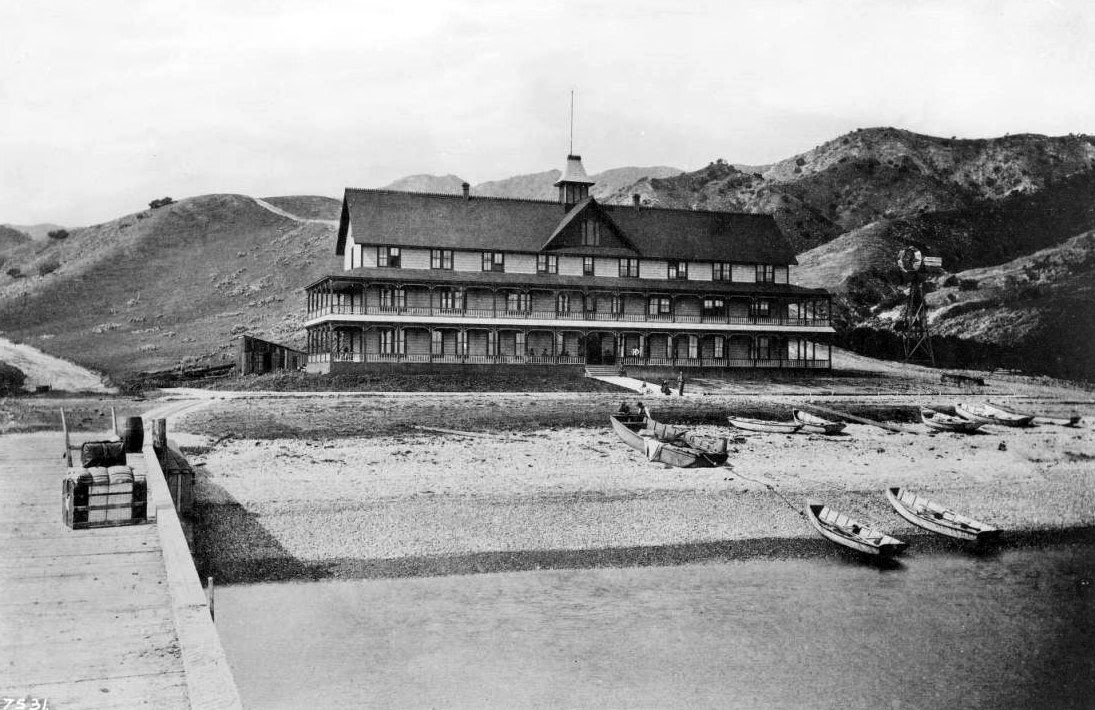 |
|
| (ca. 1888)* - View of the Hotel Metropole at Avalon Bay. The long, three-story hotel is pictured at center, just off the beach, featuring both a porch on which several people are visible, and second-floor balcony. More people stand at the end of the paved walkway from the hotel, watching two boatmen pull their boat ashore. Several other boats are in their vicinity. Mountains are visible in the background. Part of the wharf, on which a steaming trunk can be seen, is visible in the left foreground. A windmill stands to the right of the hotel. |
Historical Notes Completed in 1888, the three-story Hotel Metropole was a striking wooden structure with multiple patios, dormers, and chimneys, perched just off the beach as Avalon’s grand welcoming point for early visitors. |
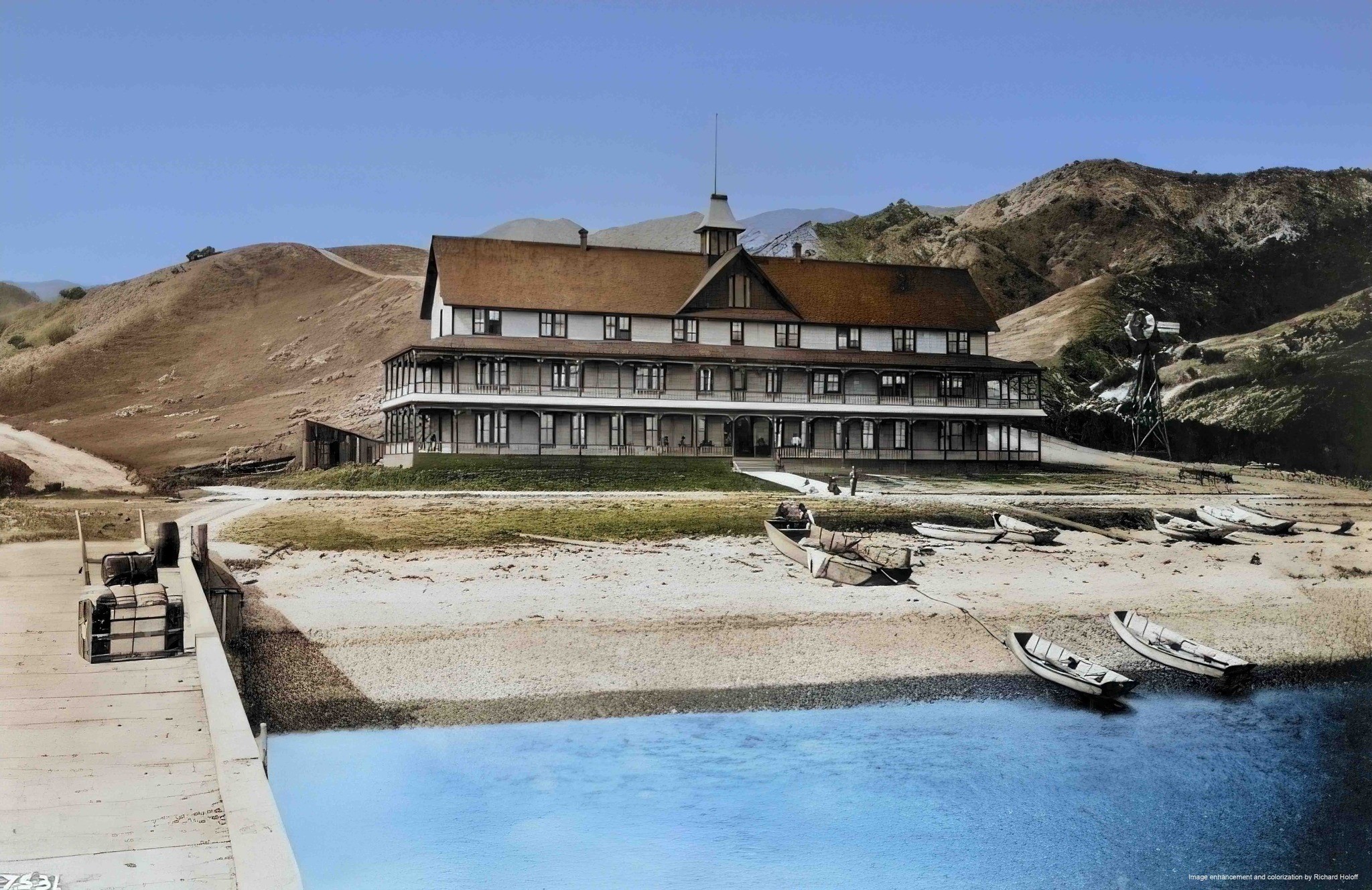 |
|
| (ca. 1888)* - View of the Hotel Metropole at Avalon Bay. The long, three-story hotel is pictured at center, just off the beach, featuring both a porch on which several people are visible, and second-floor balcony. More people stand at the end of the paved walkway from the hotel, watching two boatmen pull their boat ashore. Several other boats are in their vicinity. Mountains are visible in the background. Part of the wharf, on which a steaming trunk can be seen, is visible in the left foreground. A windmill stands to the right of the hotel. Photo by C. C. Pierce; Image enhancement and colorization by Richard Holoff. |
Historical Notes Completed in 1888, the Hotel Metropole quickly became the centerpiece of Avalon’s shoreline. The three-story wooden structure, with its porches, dormers, chimneys, and broad views of the bay, served as Catalina’s first grand hotel. The windmill alongside the property supplied water to guests, while small boats brought visitors and supplies ashore. This early scene—here digitally enhanced and colorized—captures the charm of Avalon at the very beginning of its transformation into a resort destination. |
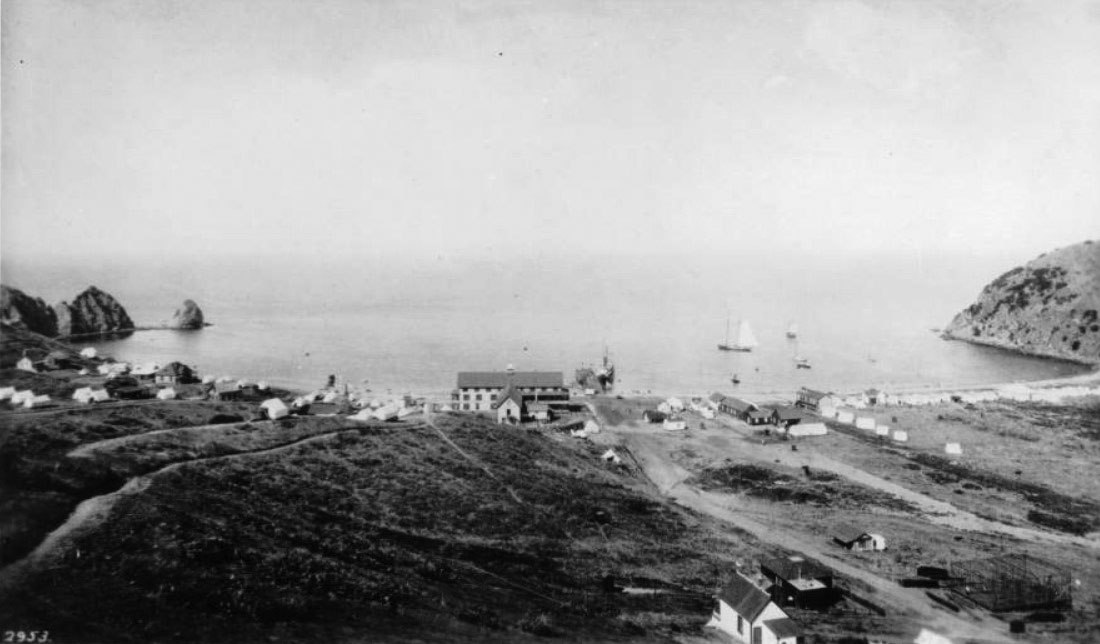 |
|
| (1890s)* - Panoramic view of Avalon harbor from the west. There is a steamer docked in front of the Hotel Metropole. The Congregational Church is under construction at lower right. Several sailboats, including a large one, are in the harbor. A rock formation (Sugarloaf) sticks up out of the water at left. Note the number of house-tents startng to pop up as Avalon begins to take root. |
Historical Notes Avalon Harbor saw its earliest wide-angle panorama in the 1890s, capturing Hotel Metropole, a steamer, tents and burgeoning construction such as the Congregational Church, along with the Sugarloaf rock formation rising from the water. |
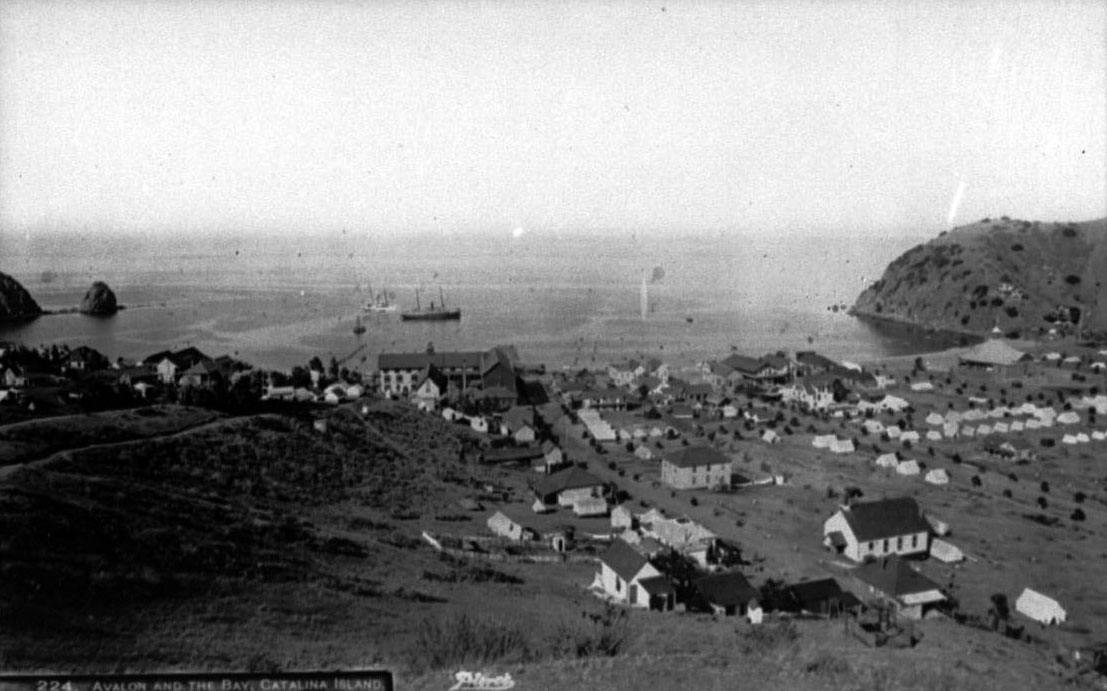 |
|
| (ca. 1890s)^^ - View showing Avalon Bay from the hillside behind the Hotel Metropole (center). A steamboat is seen in the middle of the bay just beyond the hotel. A Multitude of house-tents are seen throughout with more permanent structures now in place. The Congregational Church is now complete and stands at lower right. |
Historical Notes To expand Avalon’s tourist base, Shatto used steamships leased from the Bannings to ferry visitors to and from the mainland, and he sold lots for tents or summer cottages. But after only a few years, he defaulted on his mortgage and the island reverted to the Lick estate. In 1891, Catalina was purchased by the Banning brothers—William, Joseph, and Hancock—who invested heavily in steamship service, expanded tourist facilities, and guided Avalon through its first major growth phase. |
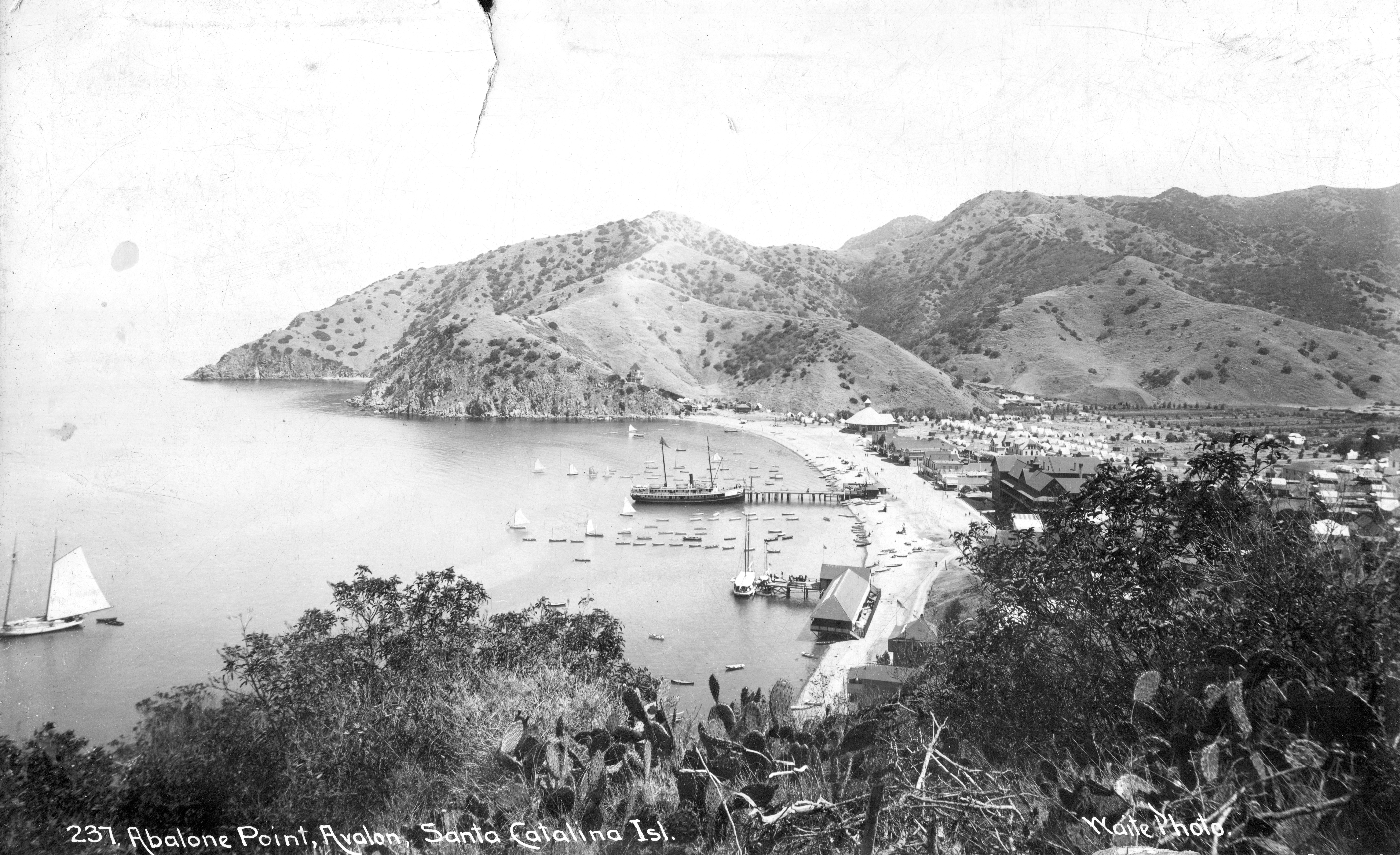 |
|
| (ca. 1890s)* - Postcard view of Abalone Point, Avalon showing the steamer S.S. Hermosa docked in the bay near the Hotel Metropole. Photo courtesy of John R. Call |
Historical Notes The S.S. Hermosa was built in San Francisco in 1888 by the Wilmington Transportation Company, owned by the Banning family, for transportation to Catalina Island during the summer season. Off-season, the ship had been leased to other operators for use in Puget Sound and Alaska. |
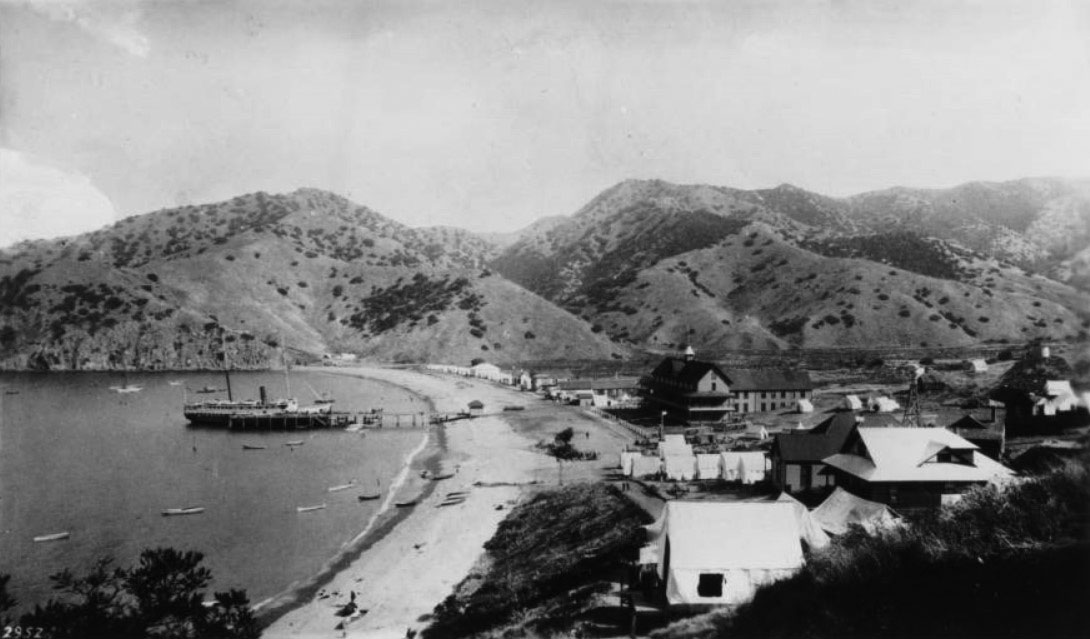 |
|
| (ca. 1890s)* - Panoramic view of Avalon Harbor showing the steamer S.S. Hermosa docked in front of the Hotel Metropole. There are appear to be more tents than permanent buildings being used as dwellings. |
Historical Notes The Hermosa carried up to 150 passengers and was elegantly decorated. It carried passengers to the island for fourteen years until it was replaced by the larger Hermosa II (1902). |
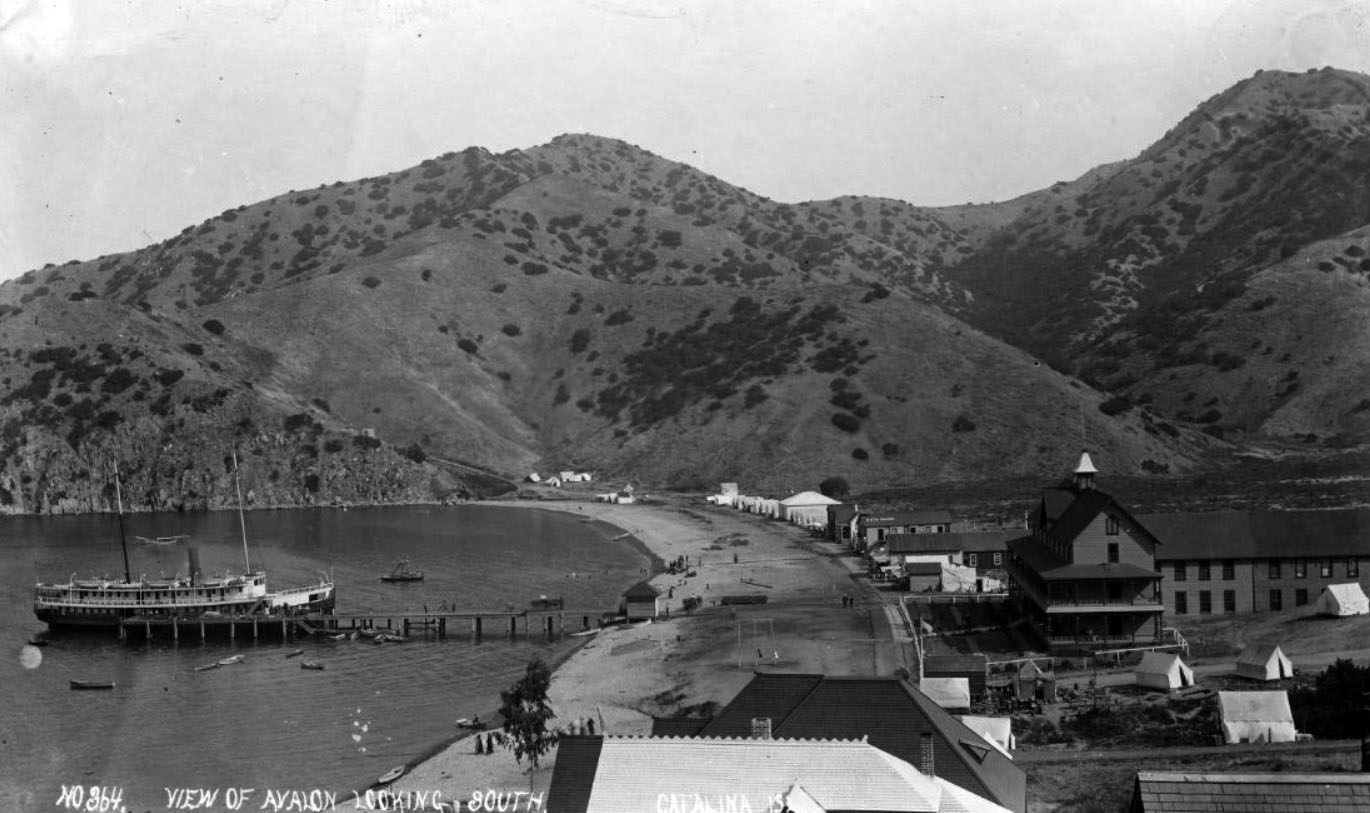 |
|
| (ca. 1890s)* - View looking south along the beach in Avalon showing the barren hills in the distance. The Hermosa is seen docked on the pier at left. On the right sits the Hotel Metropole surrounded by tents. |
Historical Notes By the early 1890s, Avalon was still a rustic seaside resort. The Hotel Metropole, completed in 1888, remained the town’s focal point, surrounded not by permanent structures but by rows of canvas tents pitched by summer visitors. The S.S. Hermosa, built in 1888 for the Wilmington Transportation Company, is seen docked at the pier, having brought tourists across the channel from San Pedro. Behind it all, the barren, undeveloped hills serve as a reminder of how new Avalon was at this time. |
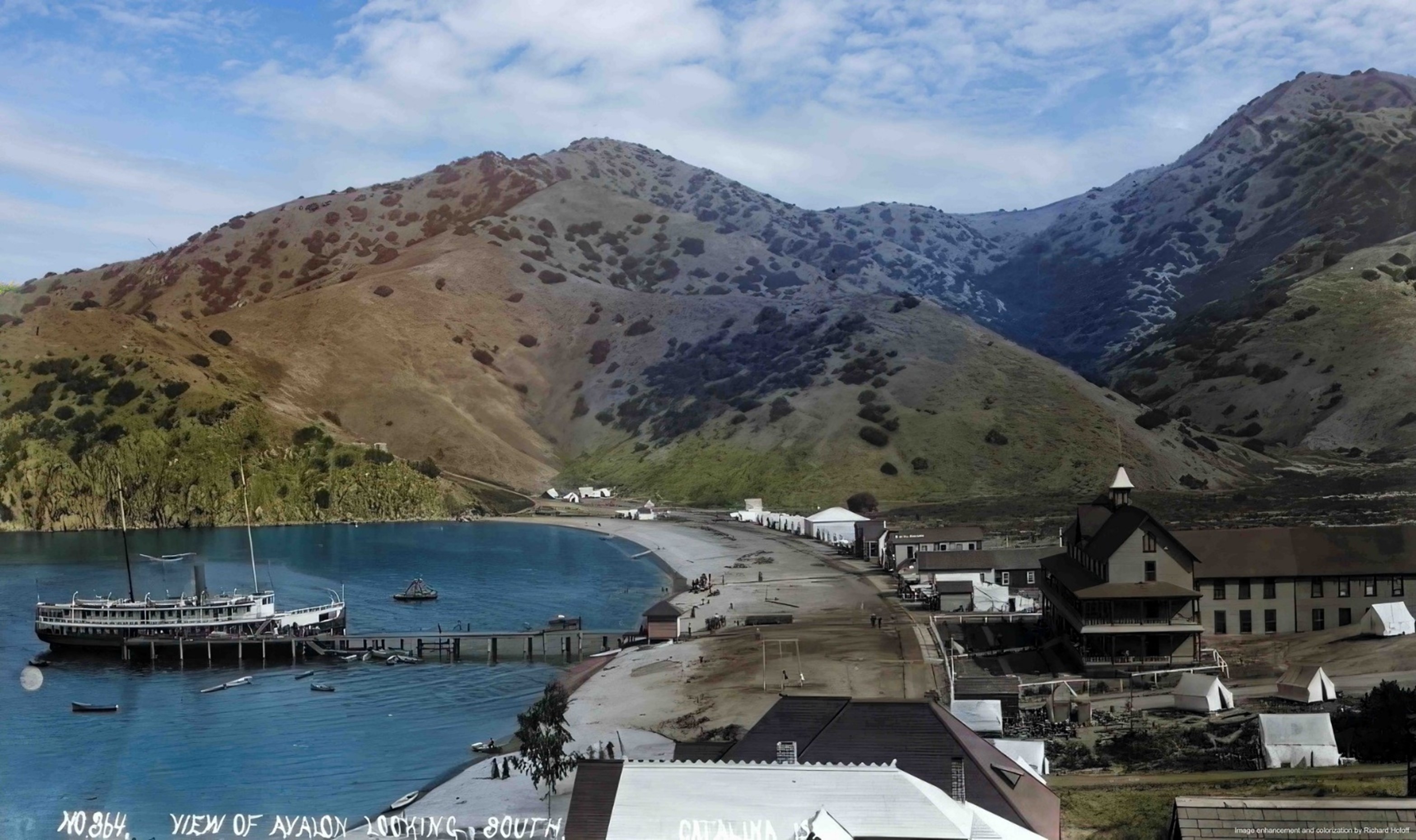 |
|
| (ca. 1890s)* - View looking south along the beach in Avalon showing the barren hills in the distance. The Hermosa is seen docked on the pier at left. On the right sits the Hotel Metropole surrounded by tents. Image enhanced and colorized by Richard Holoff. |
Historical Notes This colorized view vividly conveys the character of Avalon in the 1890s, when the island was in transition from a tent colony to a permanent resort town. The S.S. Hermosa linked Catalina to the mainland, while visitors stayed either in the grand Hotel Metropole or in the tent city that spread out along the beach. The barren hillsides behind Avalon highlight just how early in its development this image was captured. Enhanced and colorized by Richard Holoff, the photograph brings to life the textures and tones of Catalina’s formative years. |
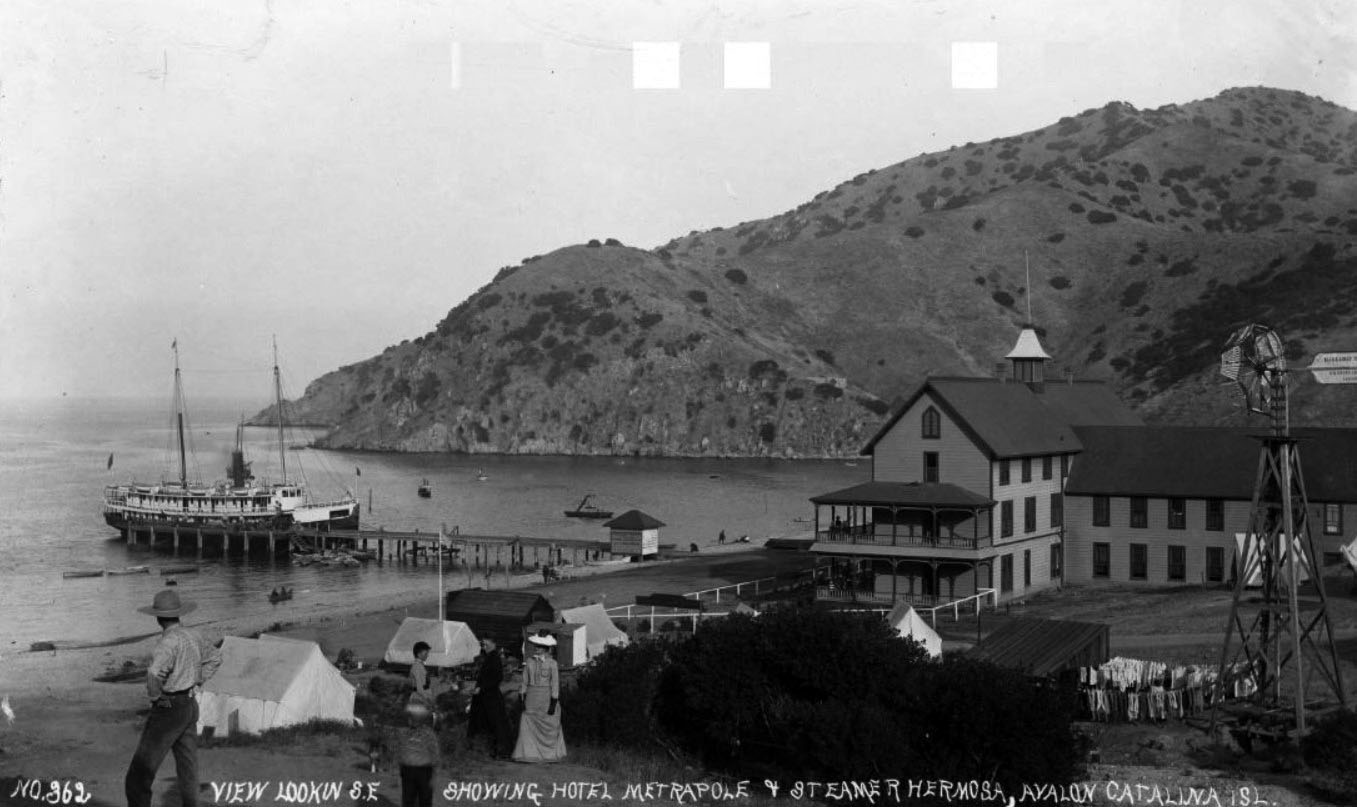 |
|
| (ca. 1890s)* - Panoramic view looking southeast showing Hotel Metropole and steamer S. S. Hermosa. The large boat is docked at the pier with smaller boats in the water. Tents are visible close to the beach as well as buildings. Women are wearing high collared long sleeved dresses and gloves. On the right can be seen a windmill and clothes hanging on a clothesline. |
Historical Notes This panorama captures a lively scene of Avalon Harbor during the 1890s. The S.S. Hermosa is docked at the pier, with smaller rowboats clustered nearby. The Hotel Metropole anchors the shoreline, while tents crowd the beachfront, reflecting the continued popularity of tent living among visitors who purchased lots in Avalon. In the foreground, townspeople in formal dress—long skirts, high collars, gloves—mingle near a windmill that provided fresh water, with laundry hung on a line nearby. The contrast between genteel vacationers and the modest camp-style accommodations illustrates Avalon’s unique blend of refinement and frontier atmosphere at the close of the 19th century. |
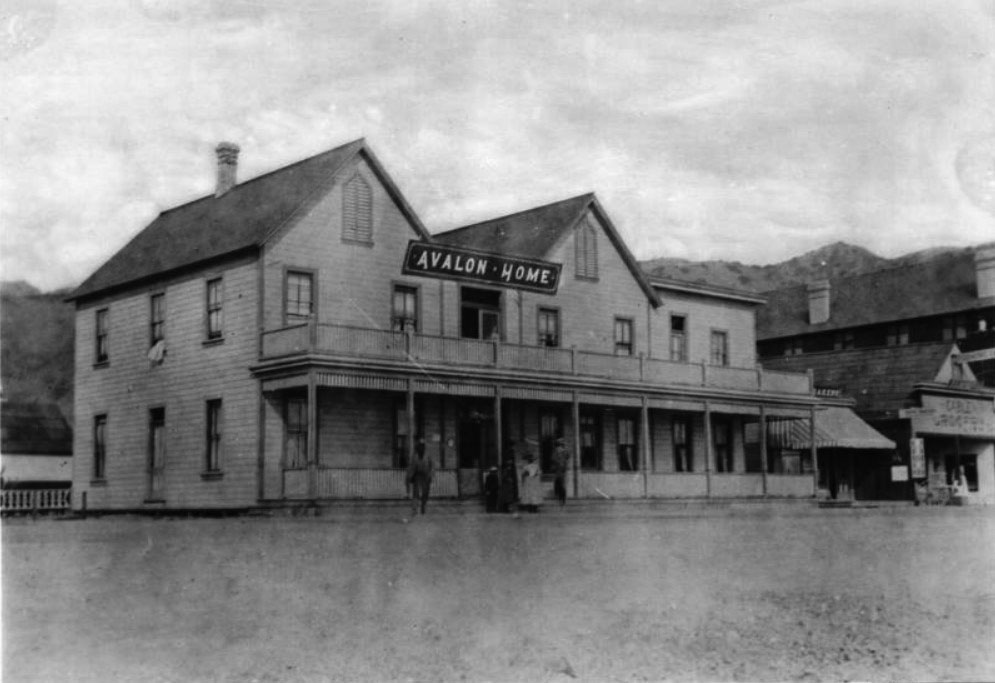 |
|
| (1889)* – View of Avalon Hotel on Crescent Avenue, Santa Catalina Island. The Hotel Metropole can be seen at the far right. Alonzo W. Wheeler was proprietor. The two-story wooden building has a covered porch in front with balcony overhead. About six people are standing near the entrance beside or on the porch. Visible adjacent buildings include a bakery and grocery store. Legible signs include: "Bakery" and "Cable Grocery". |
Historical Notes Alonzo W. Wheeler, who purchased Avalon’s first sold lot, operated the Avalon Hotel and owned the schooner Ruby—one of the first vessels making regular runs to Avalon. |
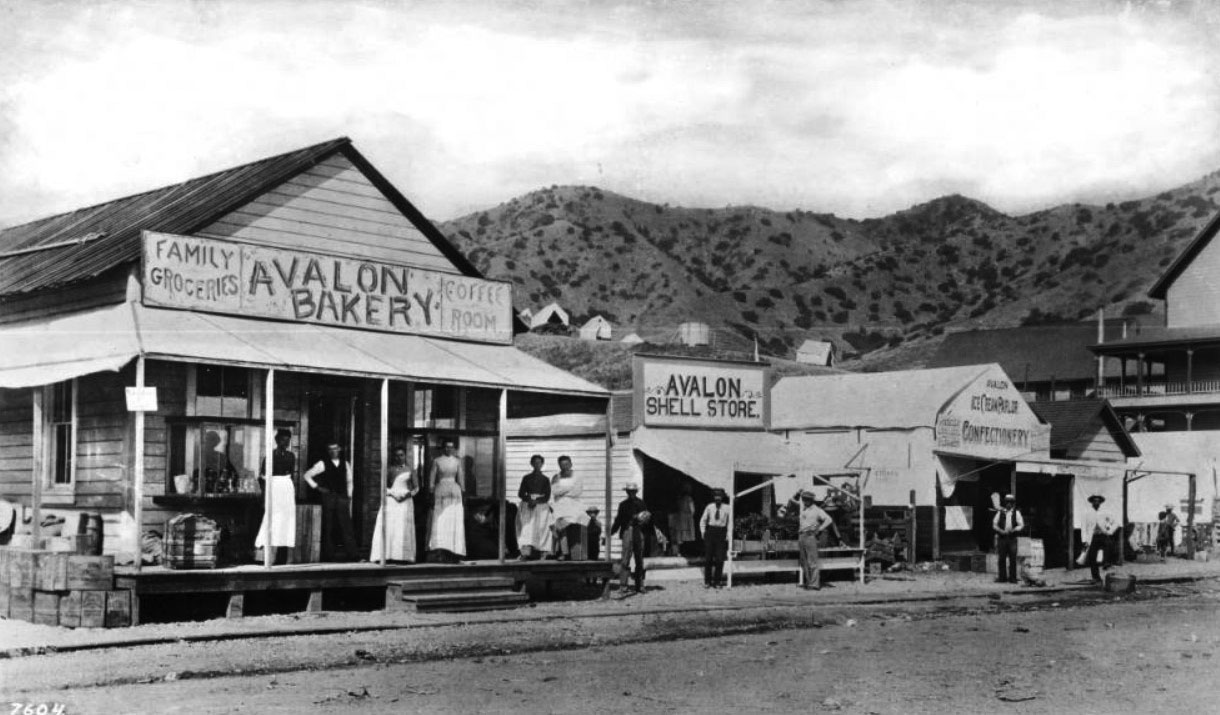 |
|
| (ca. 1895)* – View of Alonzo Wheeler's Bakery located to the north of his Avalon Hotel (out of view on the left). Six people stand on the porch of the bakery, with more near the Avalon Shell Store and Avalon Ice Cream Parlor and Confectionary, which extend down the unpaved road, respectively. A steamer trunk sits on the left side of the bakery's porch. Crates of goods stand off of it further left. |
Historical Notes By the mid-1890s, Avalon’s commercial life expanded beyond hospitality: Wheeler’s Avalon Hotel stood alongside his bakery, shell store, grocery, and ice cream parlor—signs of a maturing town economy building around early tourism. This period set the stage for the next chapter in ownership: in 1919, William Wrigley Jr., the chewing gum magnate, purchased the island from the Bannings. Wrigley’s investments transformed Catalina into a world-class resort, while his family later established the Catalina Island Conservancy to protect most of its wild interior. |
* * * * * |
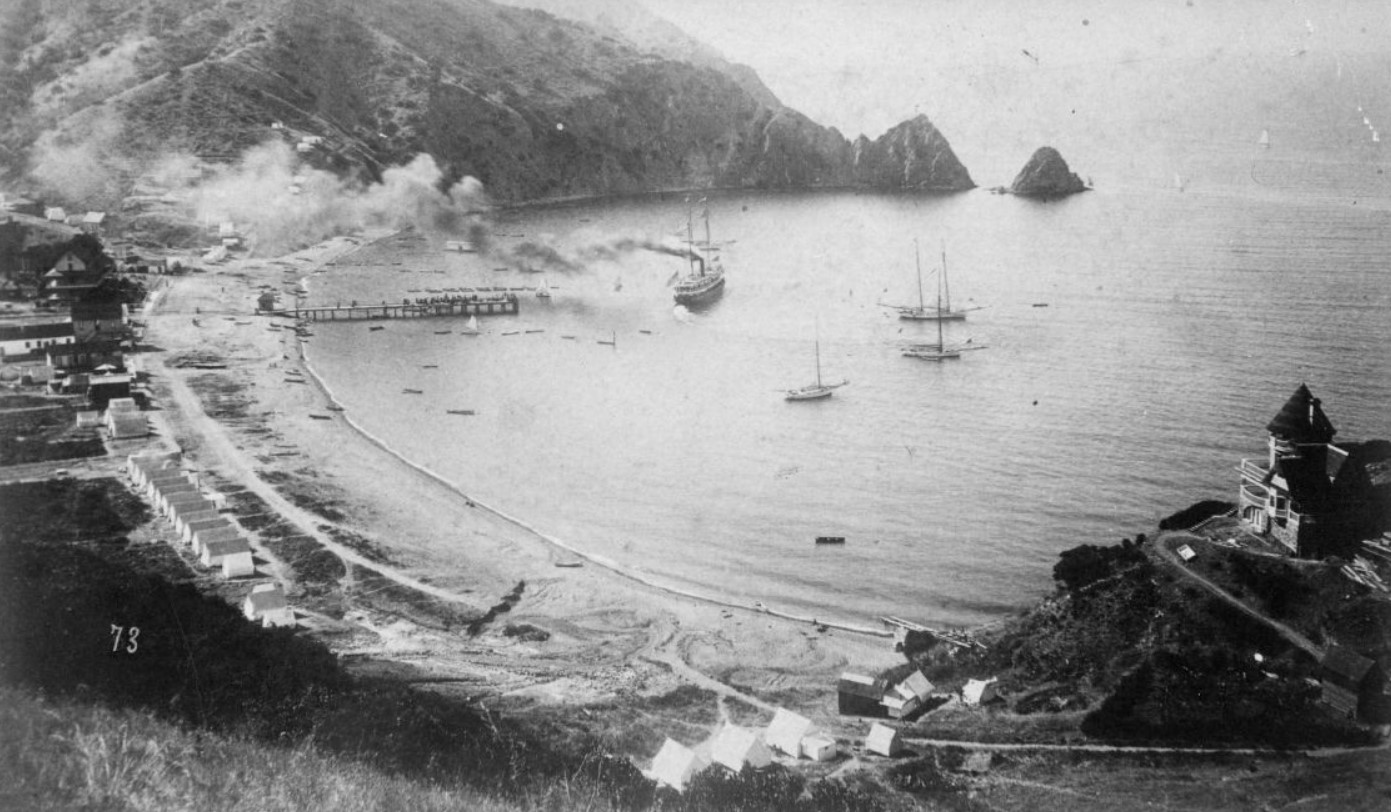 |
|
| (1891)#^^ – Panoramic view of Avalon Bay on Santa Catalina Island. The rock formation called Sugarloaf Point is at upper-right. The steamship S.S. Hermosa makes its way out toward the ocean away from a pier which is located near where the Hotel Metropole stands. House-tents can be seen all along the beach. At right stands a large Victorian-style home (Holly Hill House) with unobstructed views of the bay. The house still exists today and is Avalon's oldest remaining structure. |
Historical Notes The sons of Phineas Banning bought the island in 1891 from the estate of James Lick and established the Santa Catalina Island Company to develop it as a resort. They had a variety of reasons for doing this. They wanted Catalina's rock to build a breakwater at Wilmington for their shipping company. They had also just built a luxurious new boat, the Hermosa, to bring tourists to the Island. If tourism failed, this investment was at risk. By owning Catalina, they would not only get their rock, but also money from tourists for their passage as well as everything on the Island. |
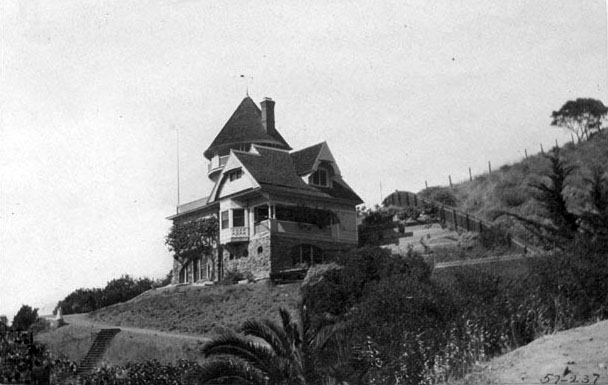 |
|
| (1892)* - View of the Peter Gano home (first named 'Lookout Cot' and now known as 'Holly Hill House'), located on the hill overlooking Avalon Bay. |
Historical Notes Lookout Cot (later Holly Hill House) was built in 1890 as a private residence by Peter Gano, a retired engineer from Pasadena. It was constructed on a lot purchased from Shatto and his agent C.A. Summer for $500 in 1888. |
 |
|
| (1903)* - View looking up toward the Holly Hill House as seen from the beach in Avalon Bay. Jennett Family Collection - Courtesy of Gilbert C. Jennett |
Historical Notes The Holly Hill House still stands today, over 120 years since it was originally built. It is Avalon's oldest remaining structure. |
Then and Now
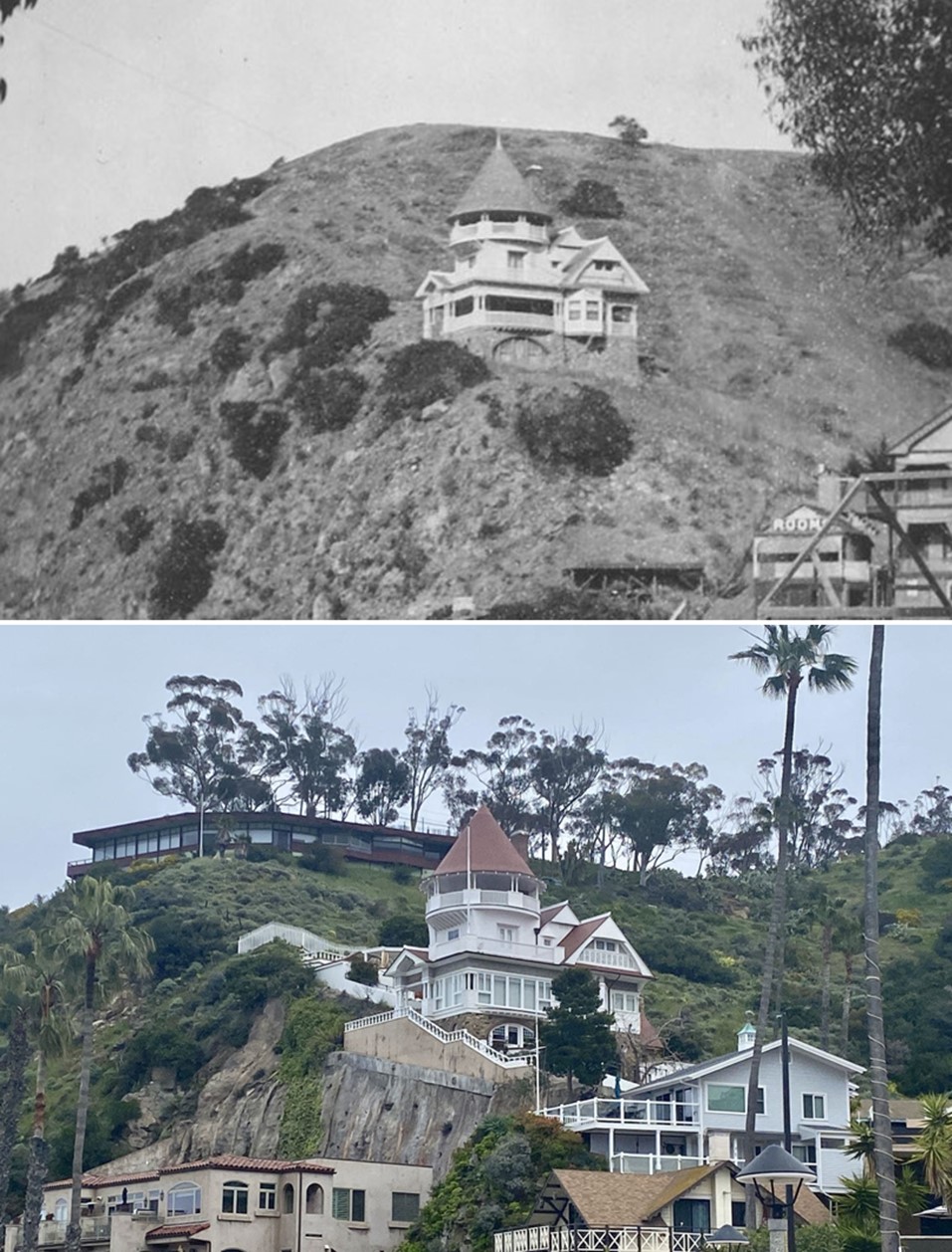 |
|
| (1903 vs. 2023)* - Holly Hill House - Then and Now. Photo comparison by Jack Feldman. |
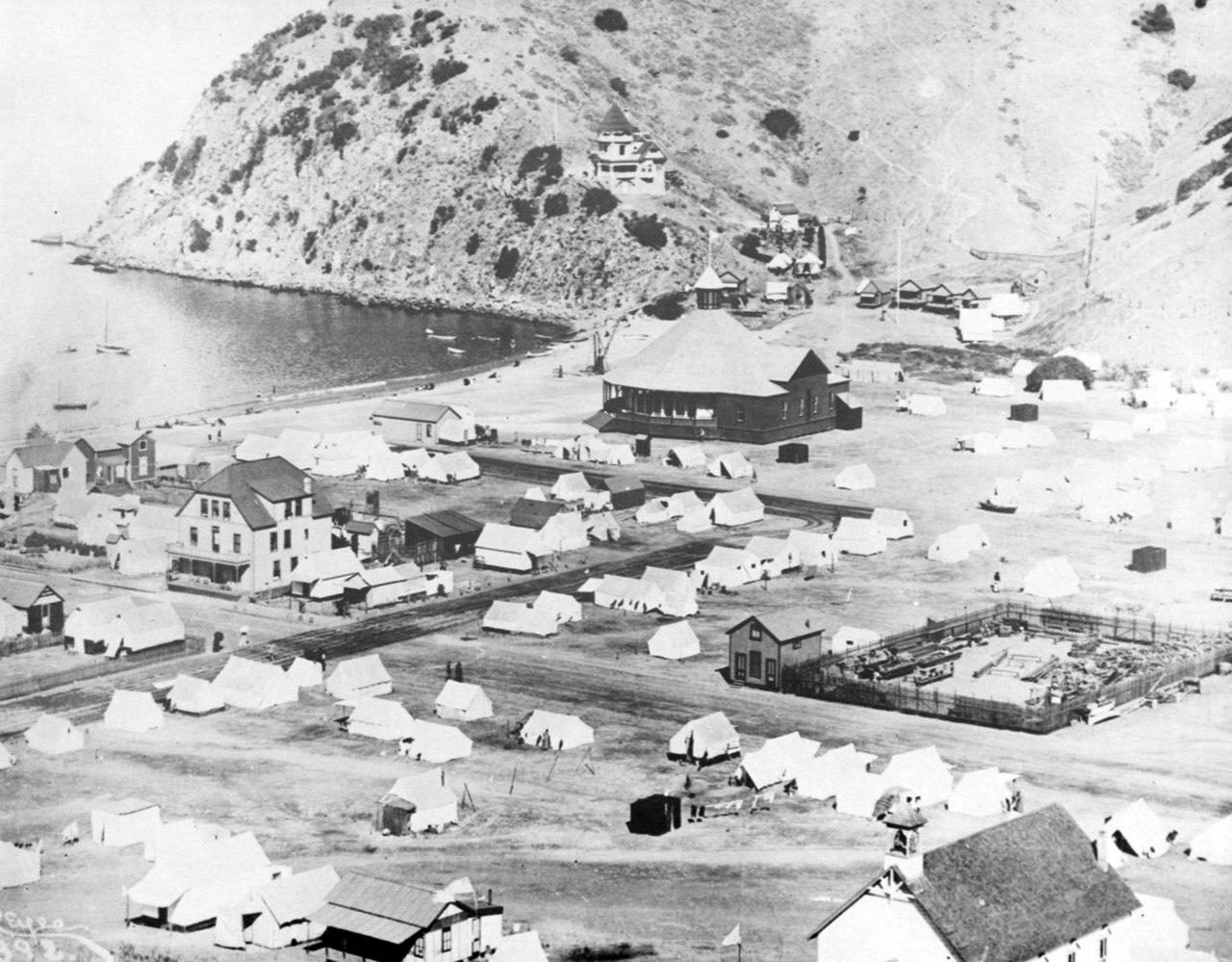 |
|
| (ca. 1893)* - Avalon Bay and Avalon, nicknamed "Rag City" for its tents. |
Historical Notes Some visible buildings include the dance pavilion (large, round building at center), Holly Hill House (center, up on hill, with cupola, also called Lookout Cottage) and Community Congregational Church (cropped at lower right corner). |
 |
|
| (1892)* – View looking east toward Avalon Bay. Buldings and house-tents share the land in the foreground. A steamboat with black smoke billowing out of its stack is seen in the background. |
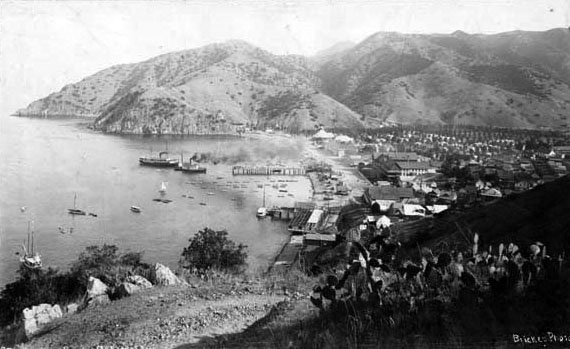 |
|
| (ca. 1898)^*# - View looking south toward Avalon from the top of a mountain above Sugarloaf Point. Two steamboats can be seen in the bay near the pier. The Hotel Metropole is the largest structure in town, however more and more buildings are beginning to spring up near the hotel. A large number of tents occupy the land between the hotel and the mountains. |
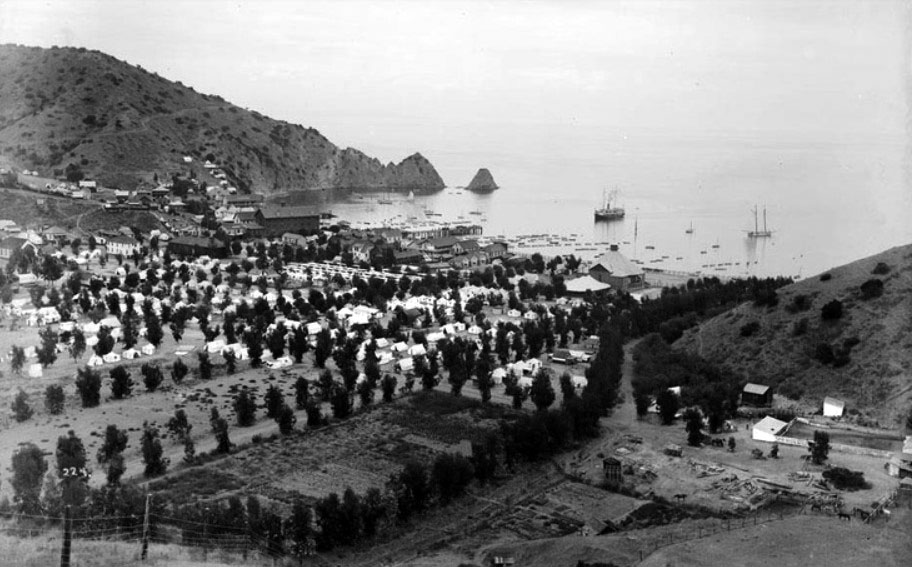 |
|
| (ca. 1897)^#* - View showing house-tents throughout Avalon, Catalina Island. The trees along the unpaved streets are beginning to grow. |
Historical Notes To induce tourists to visit Catalina, the Banning brothers would offer “Free Camp Grounds, with Water” as part of their steamboat fare. |
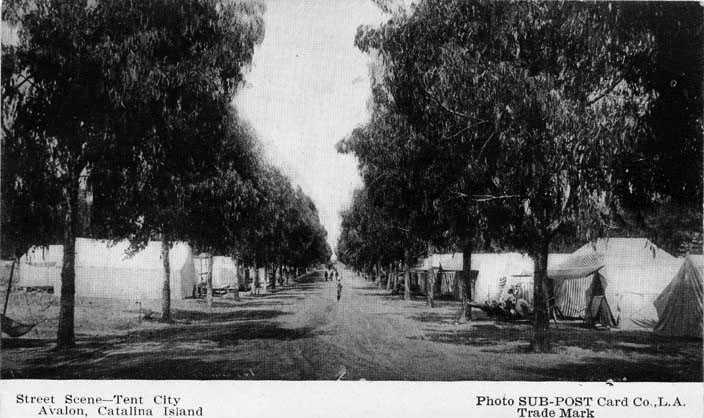 |
|
| (ca. 1898)^#* - Postcard view showing the area called “Tent City” in Avalon, Catalina Island. |
Historical Notes Avalon began to attract more and more visitors, especially during the summer months. Tents were appearing everywhere, and one part of Avalon was dubbed "Tent City". |
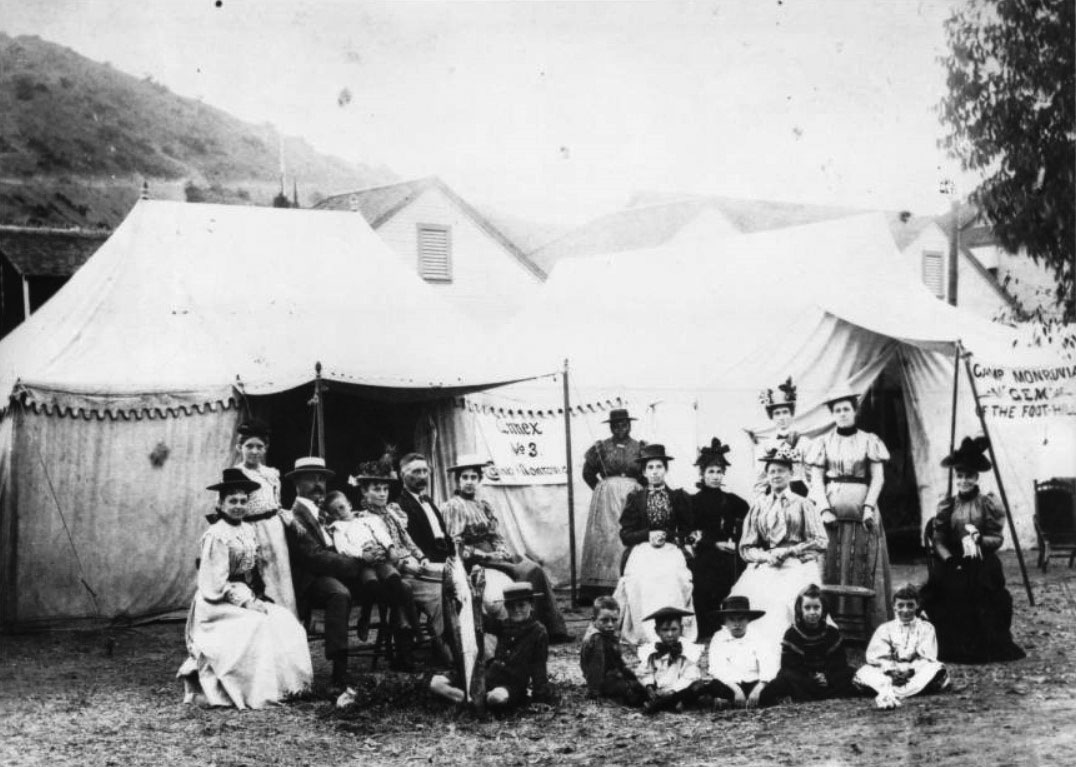 |
|
| (1890s)* - Photographic group portrait of an exposition group at Santa Catalina Island. A group of men, women, and children sit in front of two large, light-colored tents. Signs on the tents read "Annex no. 3. Camp Monrovia" and "Camp Monrovia. Gem of the Foothills". |
Historical Notes During the 1890s approximately 100 tents would be rented each summer, and this number grew steadily after the turn of the century. Renting for about $7.50 per week, life in “Tent City” included beds, bedding, basic furnishings and basic cooking facilities. Lively card games were common after dinner. |
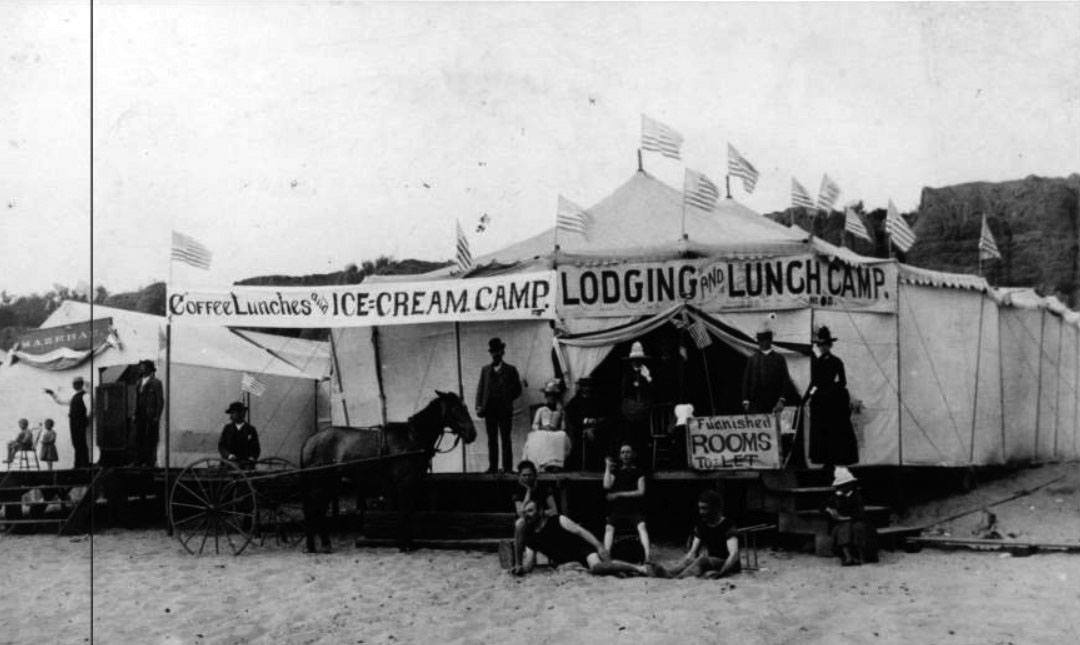 |
|
| (ca. 1890s)^^ - Photograph of a group of people posing in front of a large tent on Santa Catalina Island. Fifteen people can be seen standing on or in front of a wooden platform at center. There are men, women, and children visible. Erected on the platform is a large, light-colored tent with American flags on the roof. A horse-drawn wagon is parked in front on the left. Several large signs advertise services offered at the tent. Legible signs include: "Coffee Lunches and Ice-Cream Camp", "Lodging and Lunch Camp", and "Furnished Rooms to Let". |
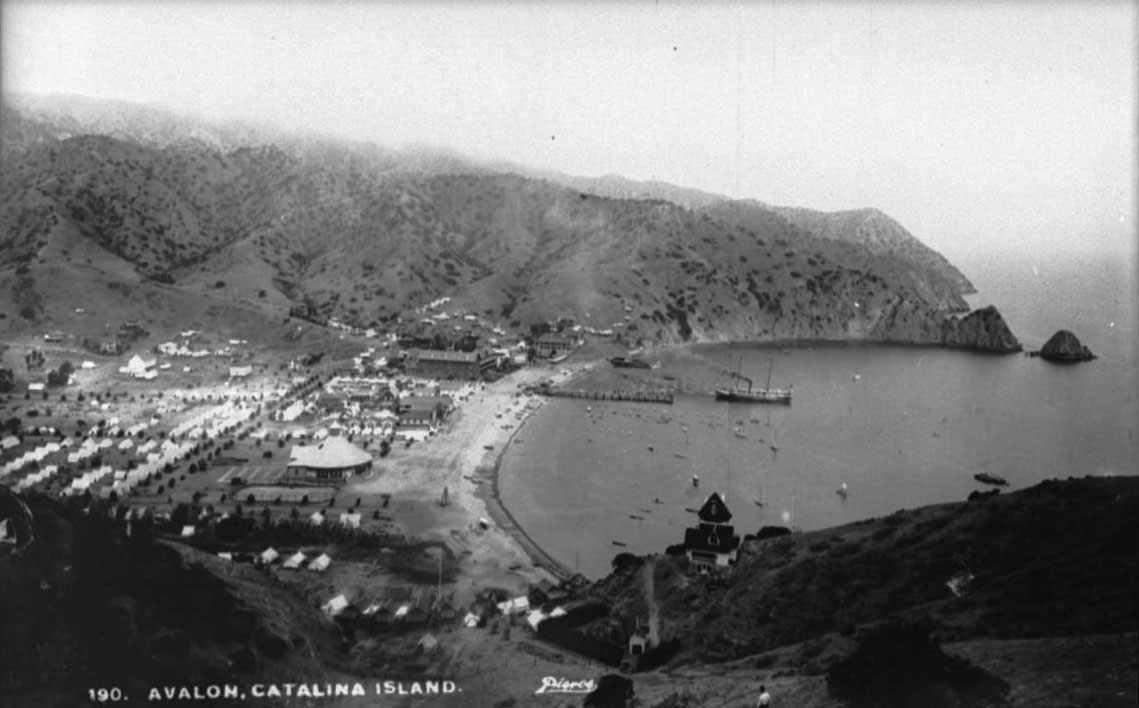 |
|
| (ca. 1900)^^ - View of Avalon Bay from the hillside above Lookout Cot (Holly Hill House). A steamer approaches the pier in the bay. The town of Avalon is nestled between the mountains. House-tents are seen everywhere. |
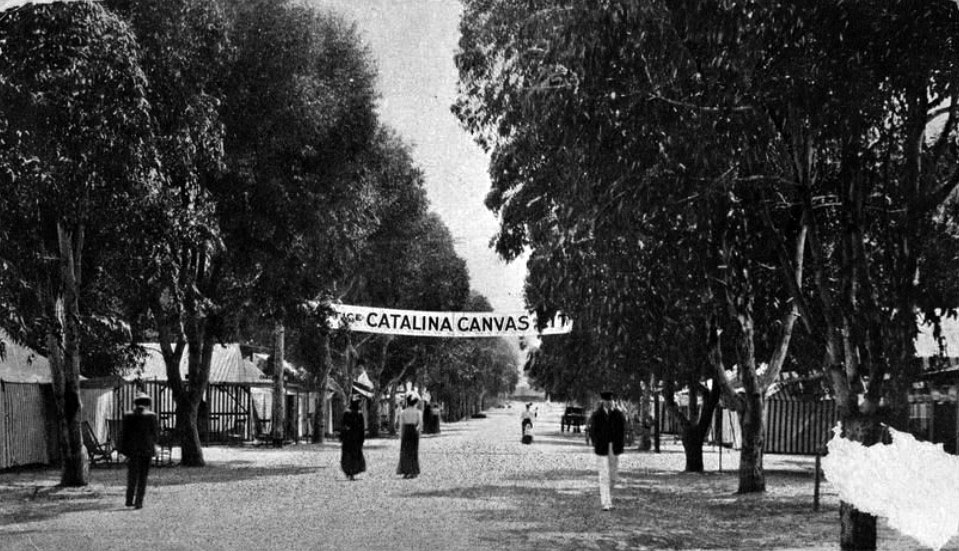 |
|
| (1906)*^*^ – Postcard view down the street through Tent City, now referred to as “Catalina Canvas City”. Postcard message reads: "This is where I spent Labor Day. Elmer." Postmark date: September 17, 1906 |
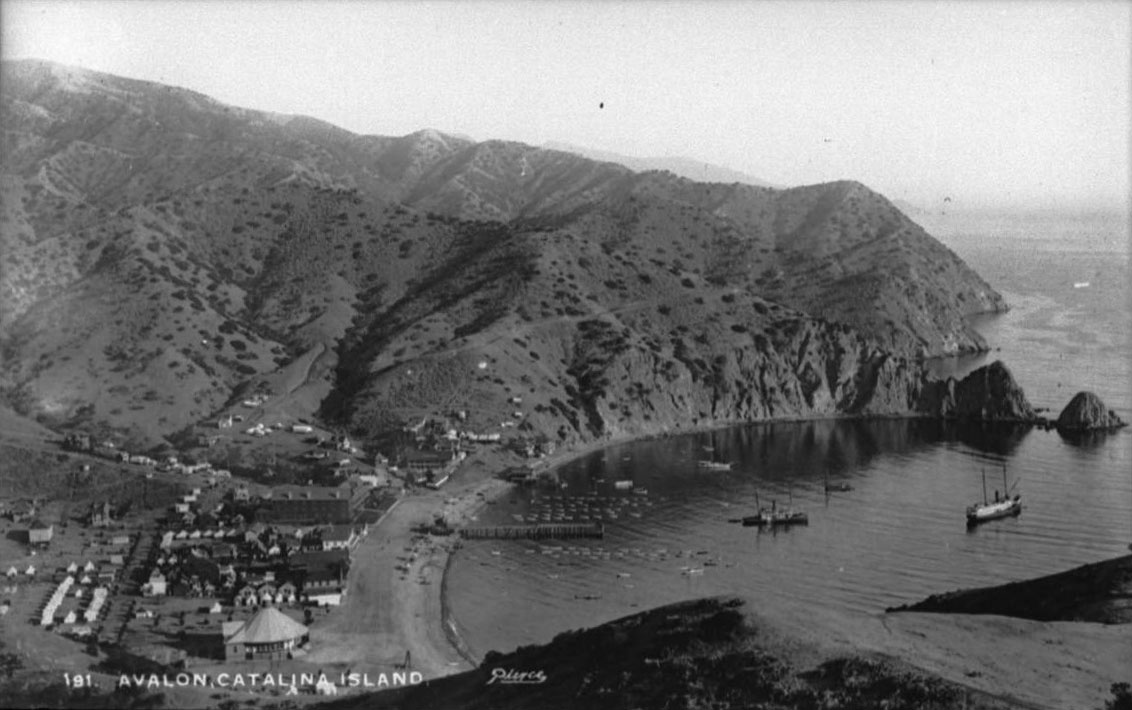 |
|
| (ca. 1900)^^ - Panoramic view of Avalon Harbor from a higher elevation in the south. Two steamers are in the bay. A pier extends out from the beach. The rock formation, "Sugarloaf", is visible at right. |
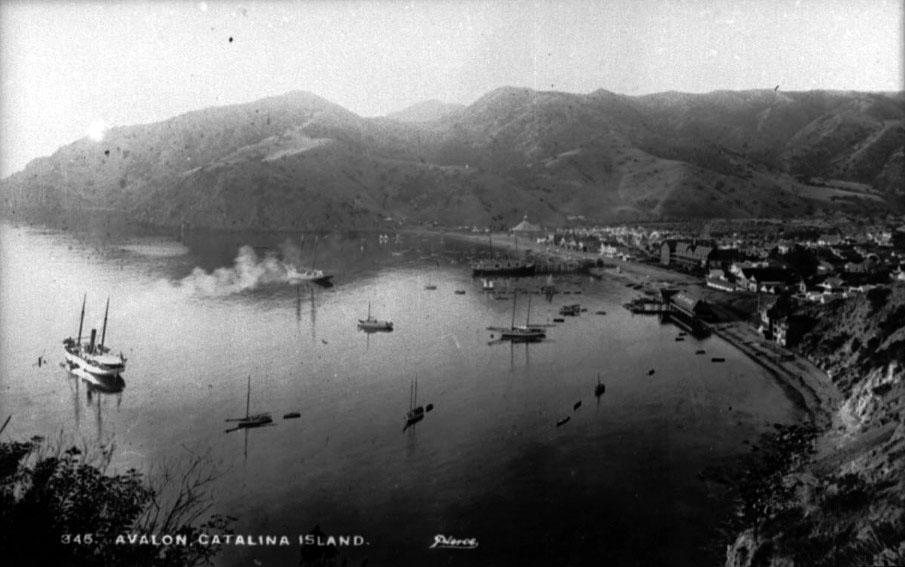 |
|
| (ca. 1900)^^ - Postcard view of Avalon harbor from a mountain top above Sugarloaf looking south. About twenty small boats and a ship are in the harbor. Part of the town of Avalon is visible at right with the rugged mountains also visible in the background. |
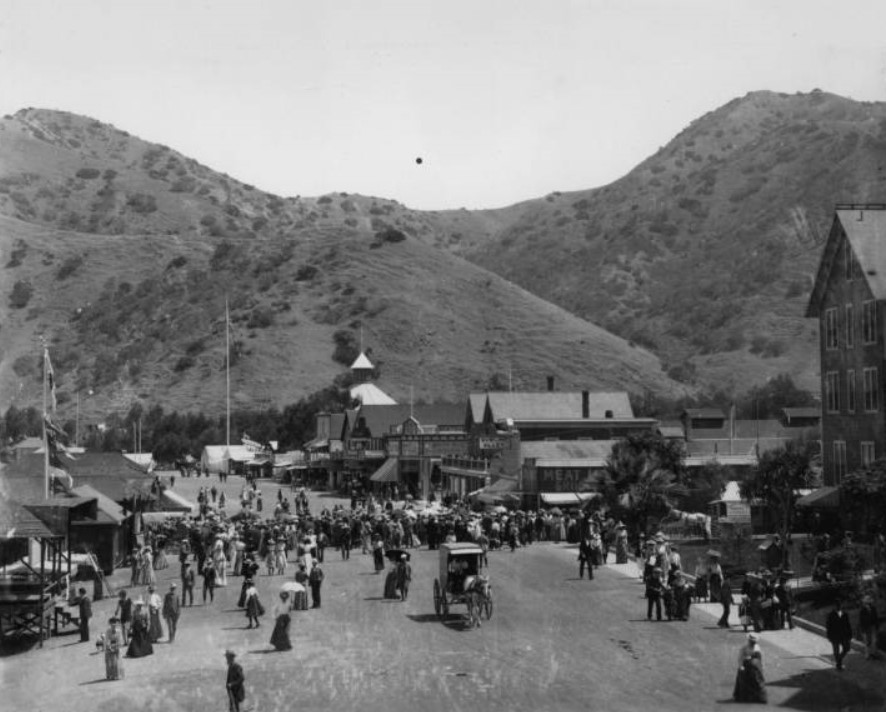 |
|
| (ca. 1900)^^ - Photograph of a view of a wide dirt street in Avalon. The broad road is at center and runs from the foreground to the background at left. Many pedestrians can be seen standing in the road, including a large group of people at center. A horse-drawn carriage can be seen in the foreground. Low wooden buildings line the street on both sides. A two-story building topped by a cupola can be seen in the distance at center. A line of tall hills runs across the image in the background. The Metropole Hotel can be seen at the right edge of the photo. |
Historical Notes The Banning brothers fulfilled Shatto's dream of making Avalon a resort community with the construction of numerous tourist facilities. Although the Bannings' main focus was in Avalon, they also showed great interest in the rest of the island and wanted to introduce other parts of Catalina to the general public. They did this by paving the first dirt roads into the island's interior, where they built hunting lodges and led stagecoach tours, and by making Avalon's surrounding areas (Lovers Cove, Sugarloaf Point and Descanso Beach) accessible to tourists. |
 |
|
| (ca. 1900)* - View of Avalon Harbor with Sugarloaf rock formation seen in the background. |
Historical Notes The point upon which the beautiful and historic Casino sits today has always been the defining landmark of Santa Catalina Island. Before the Casino was built, sailors arriving from the mainland would use Sugarloaf Point, as it was then called, to gain their bearings on approaching Avalon Bay. |
 |
|
| (ca. 1900)* - View of Avalon Harbor with Sugarloaf rock formation seen in the background. Image enhancement and colorization by Richard Holoff |
Historical Notes Sugarloaf Point was actually defined by a pair of solid granite outcroppings. Big Sugarloaf and Little Sugarloaf were connected by a narrow sawtooth ridge. |
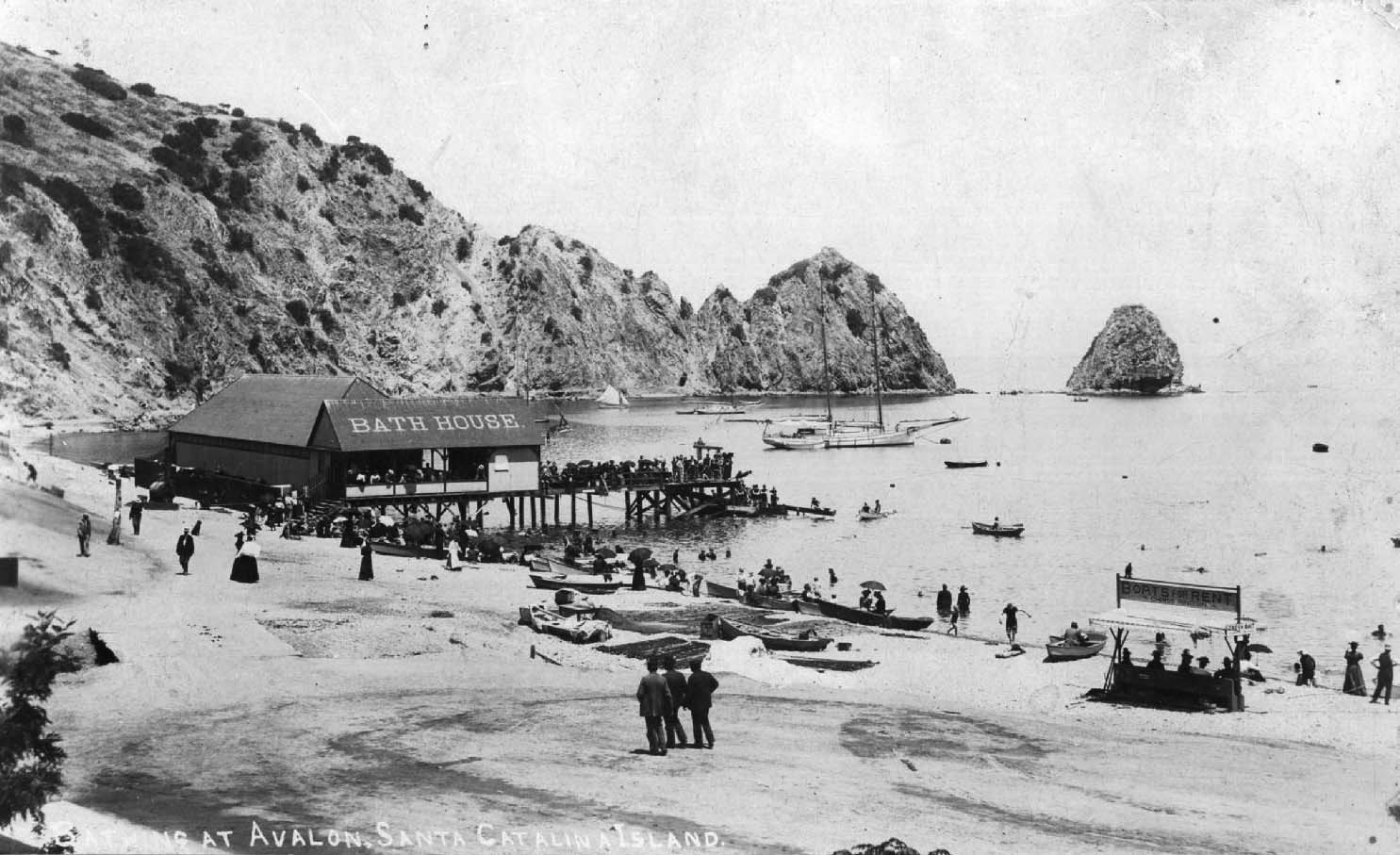 |
|
| (ca. 1900)^*# - View of Catalina Island Bath House with "Sugarloaf" visible in the background. People are enjoying a summer day on the beach, at the bath house, and on the short pier extending from the bath house. A couple of sail boats and a few smaller row boats are seen in the water. |
 |
|
| (1900)*#* – Closer view of the Santa Catalina Island Bath House and bathers. |
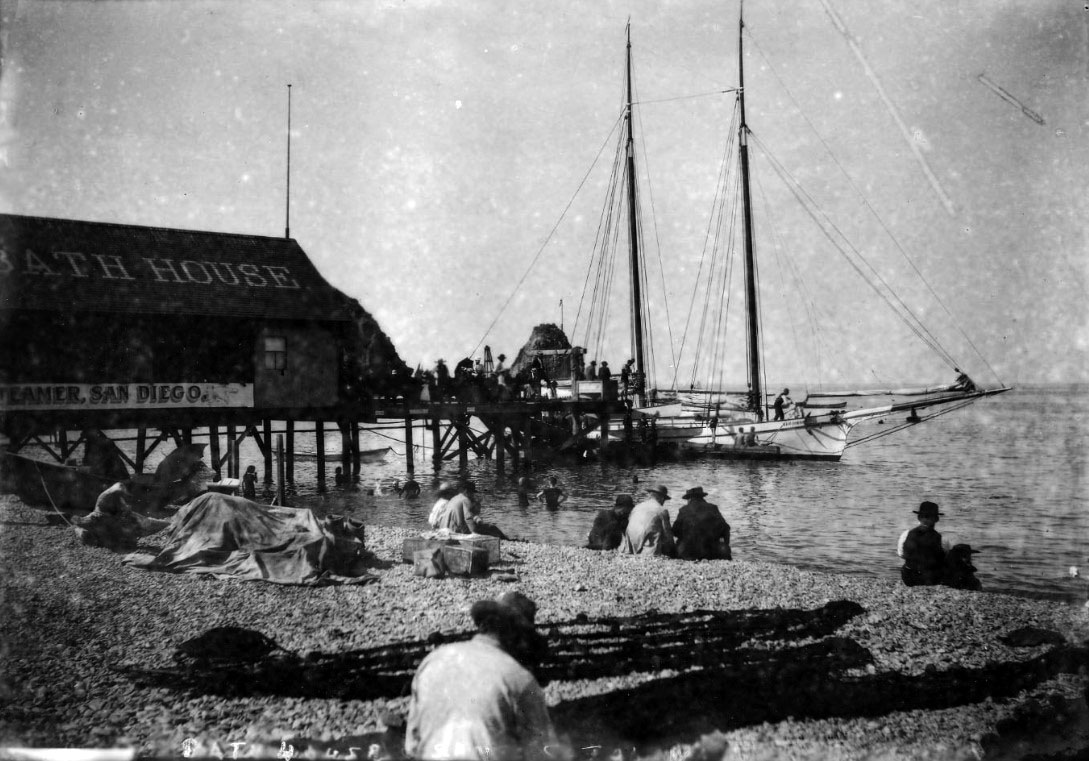 |
|
| (ca. 1900)#^^ - "Bathing at Avalon, Santa Catalina Island"- Close-up view of the Bath House on the shore of Avalon Bay. Some people are sitting on the beach enjoying the carefree day while others are swimming in the bay by the pier. A sail boat is docked at the end of the pier. A large sign on the side of the building reads: “……. Steamer, San Diego”. |
* * * * * |
Bathing - Sugarloaf Point
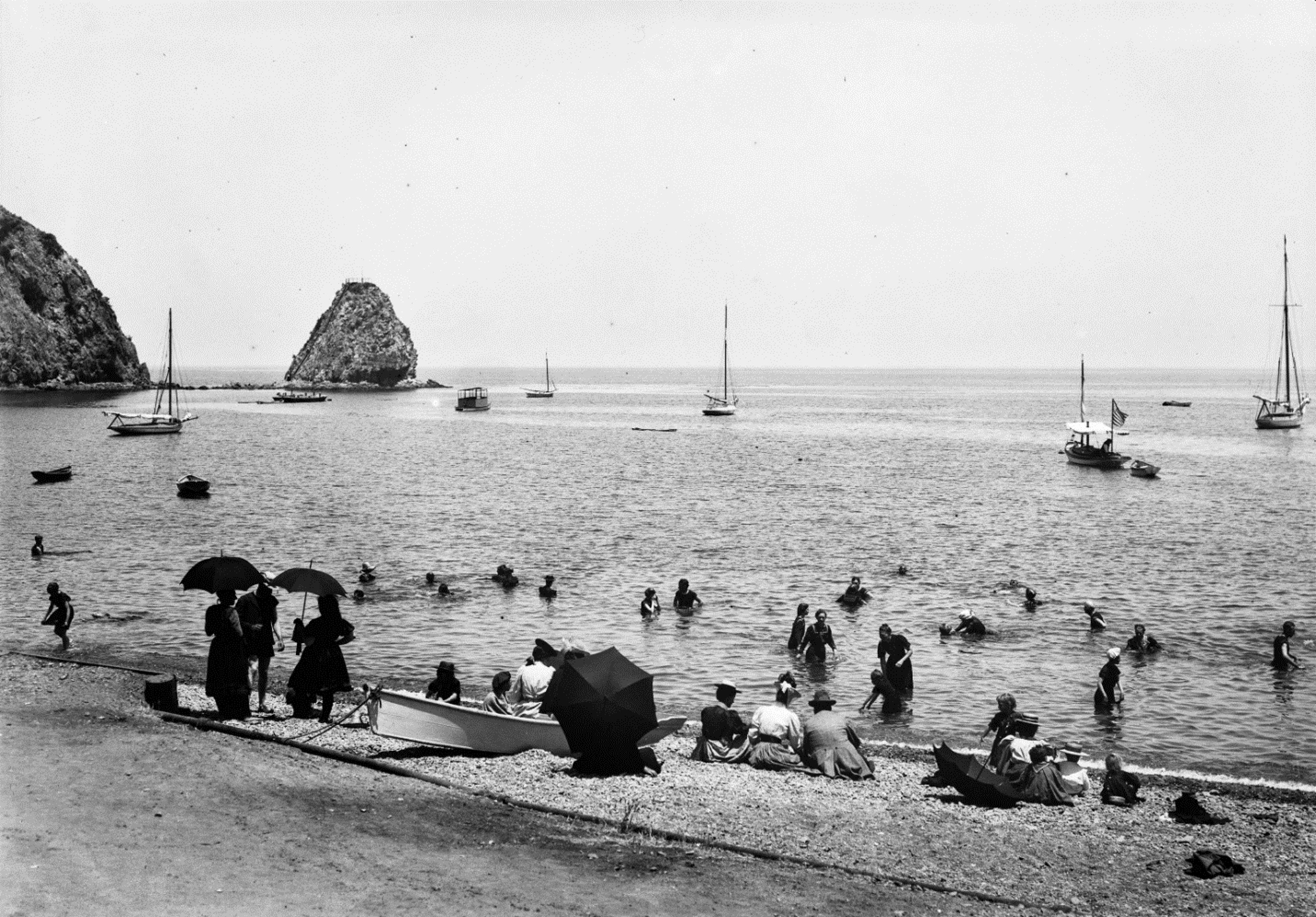 |
|
| (ca. 1895)* - Image of men, women, and children in swimsuits, sitting on the beach holding umbrellas and swimming in the water in Avalon Bay on Santa Catalina Island. Sailboats and the Sugarloaf Rock are seen in the distance. Ernest Marquez Collection |
 |
|
| (1890s)* - Boaters, sun bathers, swimmers on the beach along Avalon Bay with Sugarloaf Point in the background. |
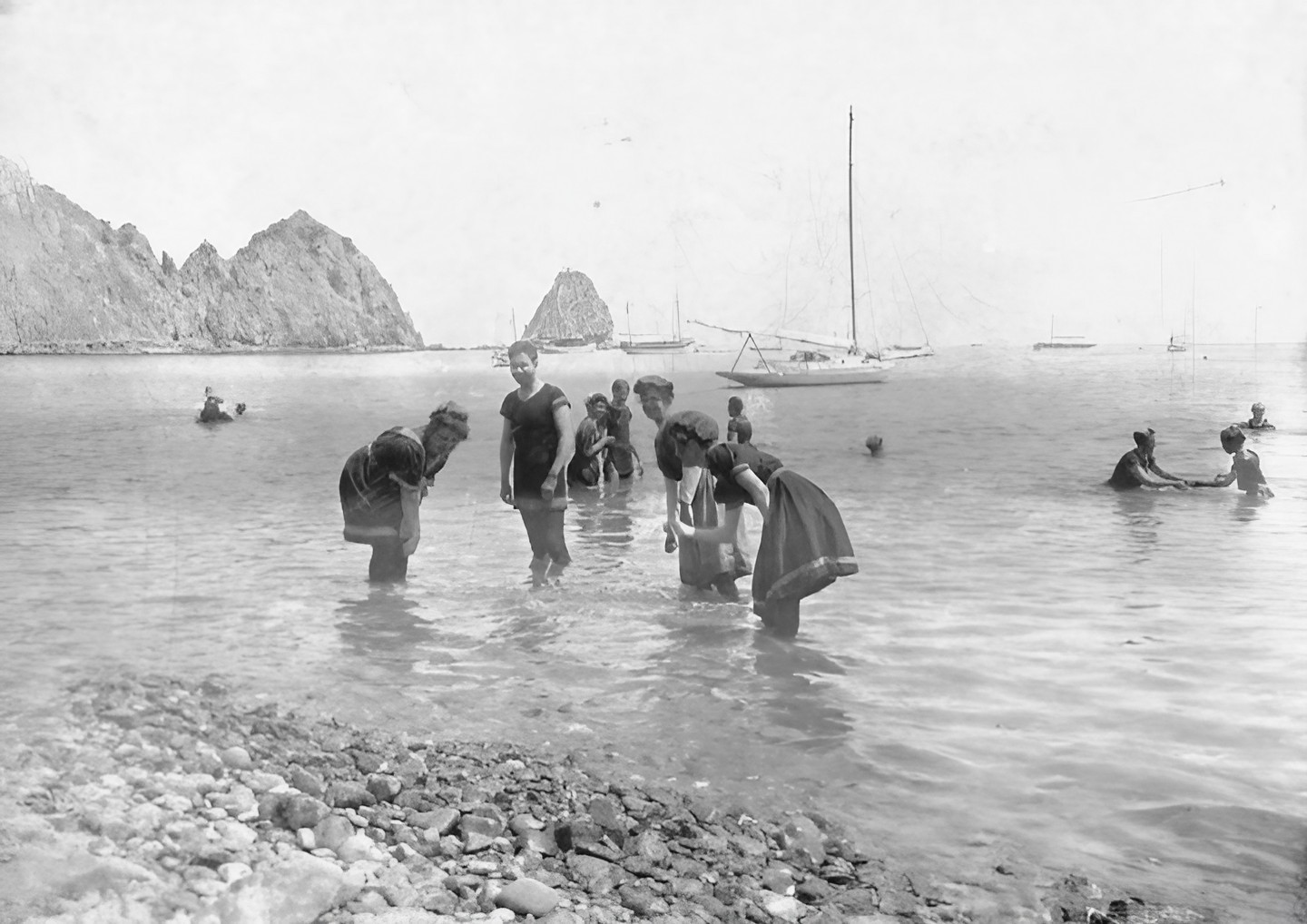 |
|
| (ca. 1900)* – Men and women swimming and wading in Avalon Bay near Avalon, Santa Catalina Island. They are wearing woolen bathing suits with white piping. The women are wearing bathing caps. Seen in the distance are anchored boats and Sugarloaf Point. |
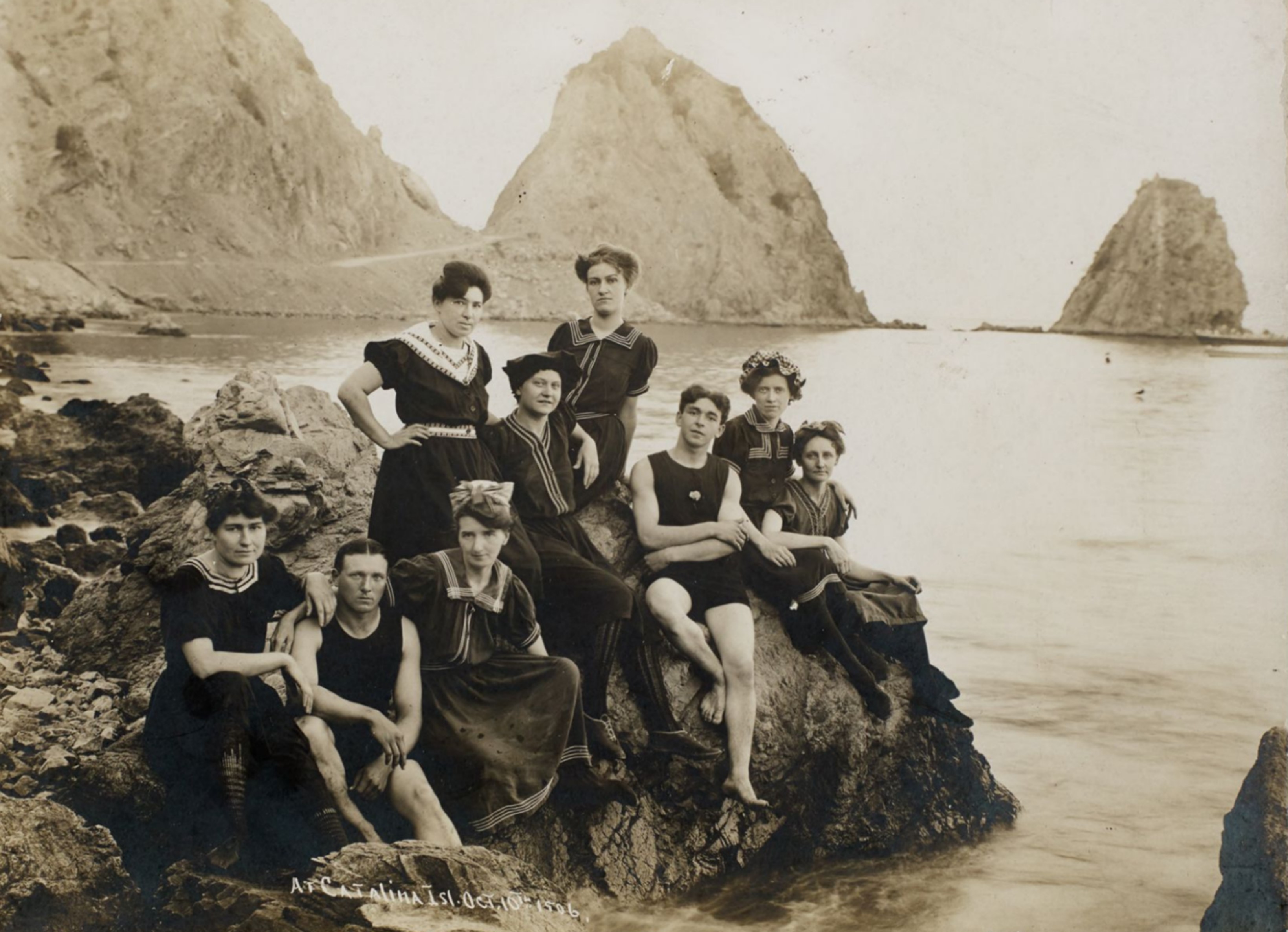 |
|
| (1906)* - Group portrait of men and women in bathing suits sitting on a rock by the water, with the Sugarloaf rock in the background on Santa Catalina Island, |
Historical Notes Note how much "Big Sugarloaf" is now more pronounced when compared to previous photos. It was chiseled away to make room for an access road that rounds the Point. |
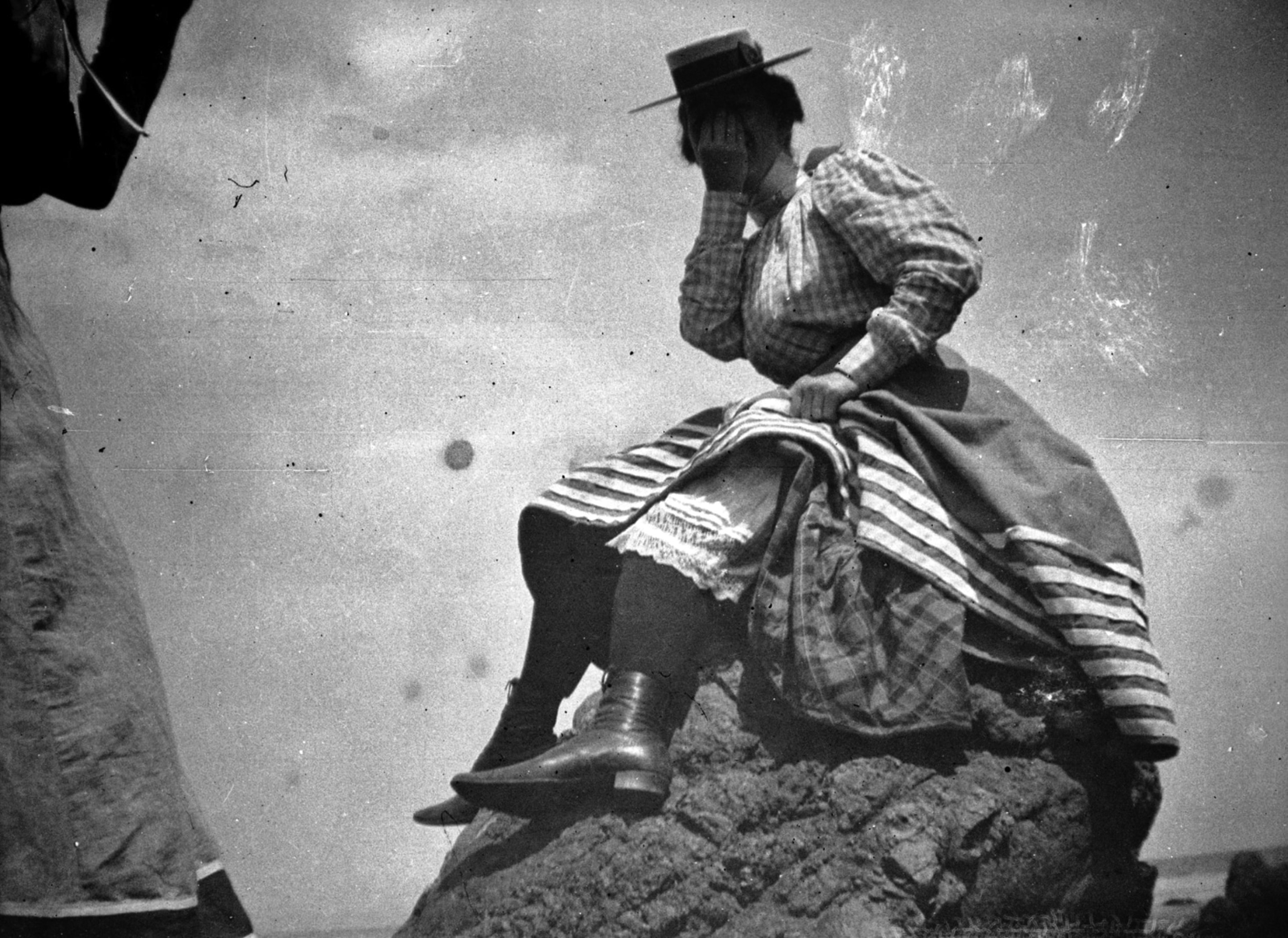 |
|
| (1897)^ - An intimate moment. Young woman raises her skirt exposing ankle and calf, Santa Catalina Island, CA, H.H. West Collection, UCLA Library. |
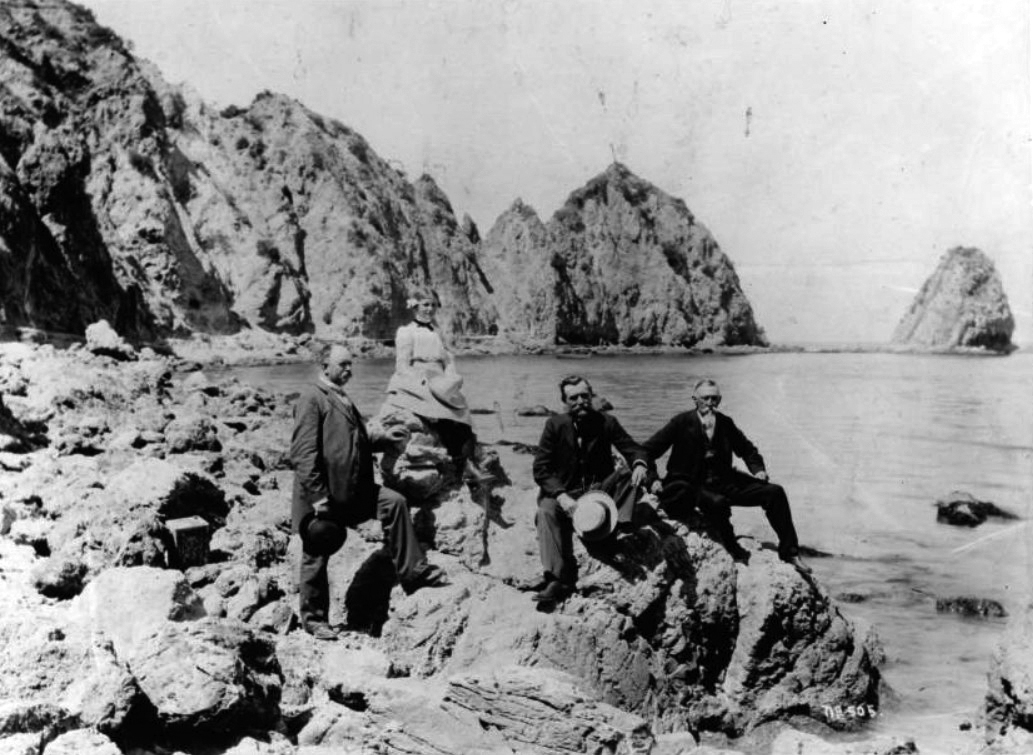 |
|
| (1900)^^ - Photographic portrait of four people posed near the Sugarloaf rock formation on Catalina Island, July 4, 1900. Three men and a woman are posed on a rock outcropping at center. The men are all wearing dark suits and the woman is wearing a light dress. From left to right, they are J.J. Bergin, Nora Forthmann, John A. Forthmann, Sr., and W. B. Bergin. |
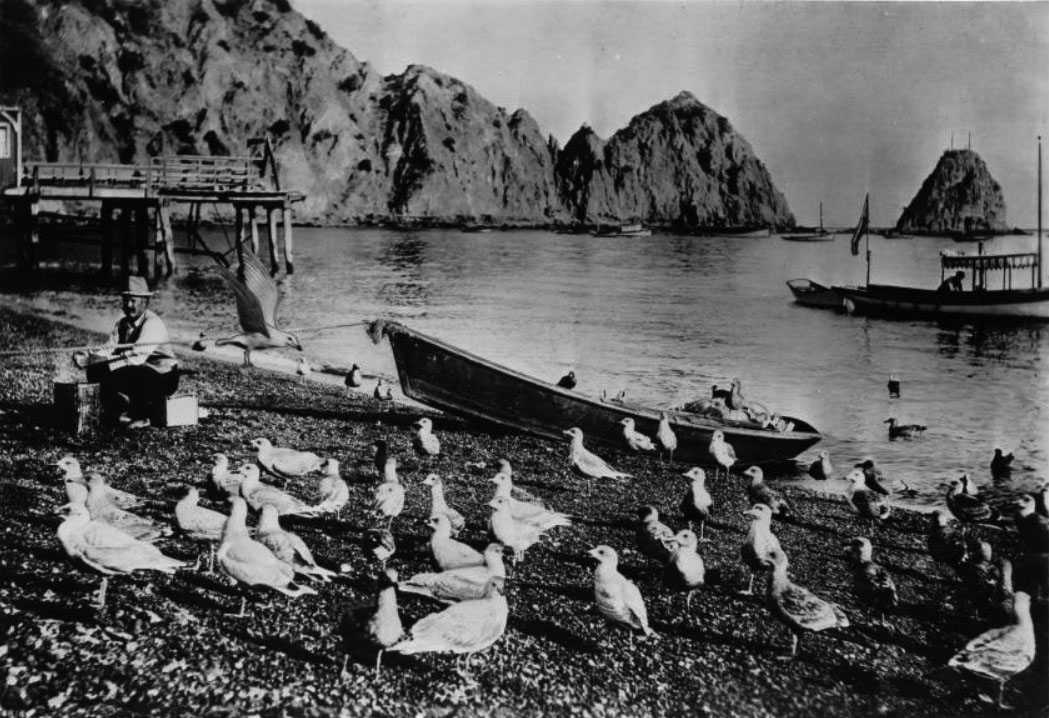 |
|
| (ca. 1900)* - Seagulls flock on the shore while a man sits on a crate behind them, cleaning abalone shells. A small dingy is also on the bank, tied to something outside of the frame. A dock is visible to the left, in the background, while a second boat is visible with a man inside, on the water to the right. Mountainous cliffs and other boats are visible in the distance. |
Historical Notes Picture file card reads: "In regard to this picture, there is a girl at the arcade post office who was born on the island and whose father at one time was postmaster over there. She says the man in this view is Joe Ardago. Joe was a waterfront character who made a living doing most anything. Here, he is cleaning abalone shells and throwing the meat to the gulls. He sold the shells. This girl knew Joe very well." |
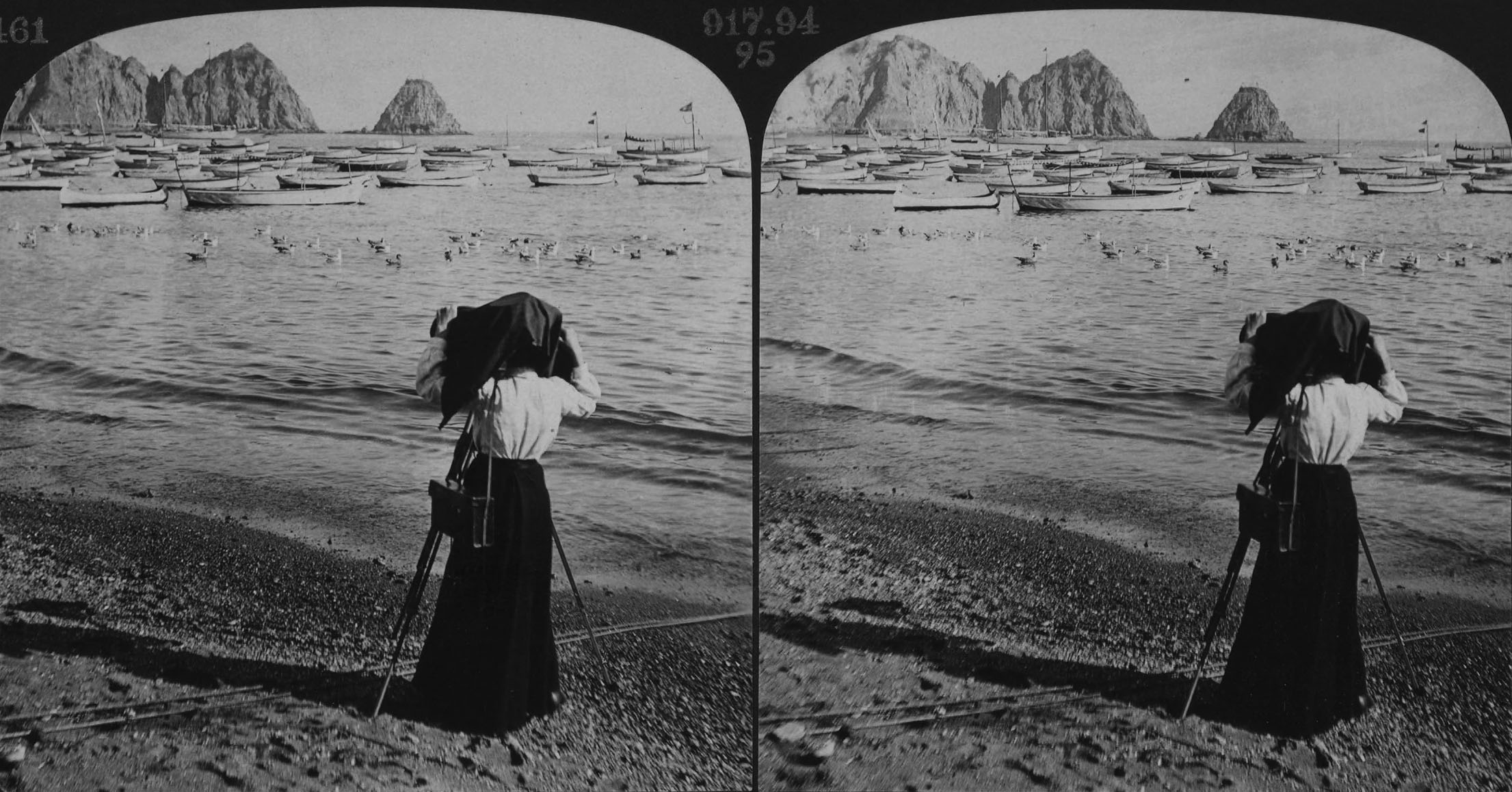 |
|
| (1903)*^ - Stereoscopic view of a woman taking a photograph of Sugarloaf Point at Avalon Bay. |
Historical Notes The point upon which the beautiful and historic Casino sits today has always been the defining landmark of Santa Catalina Island. Before the Casino was built, sailors arriving from the mainland would use Sugarloaf Point, as it was then called, to gain their bearings on approaching Avalon Bay. Sugarloaf Point was actually defined by a pair of solid granite outcroppings. Big Sugarloaf and Little Sugarloaf were connected by a narrow sawtooth ridge. |
* * * * * |
Climbing Sugar Loaf
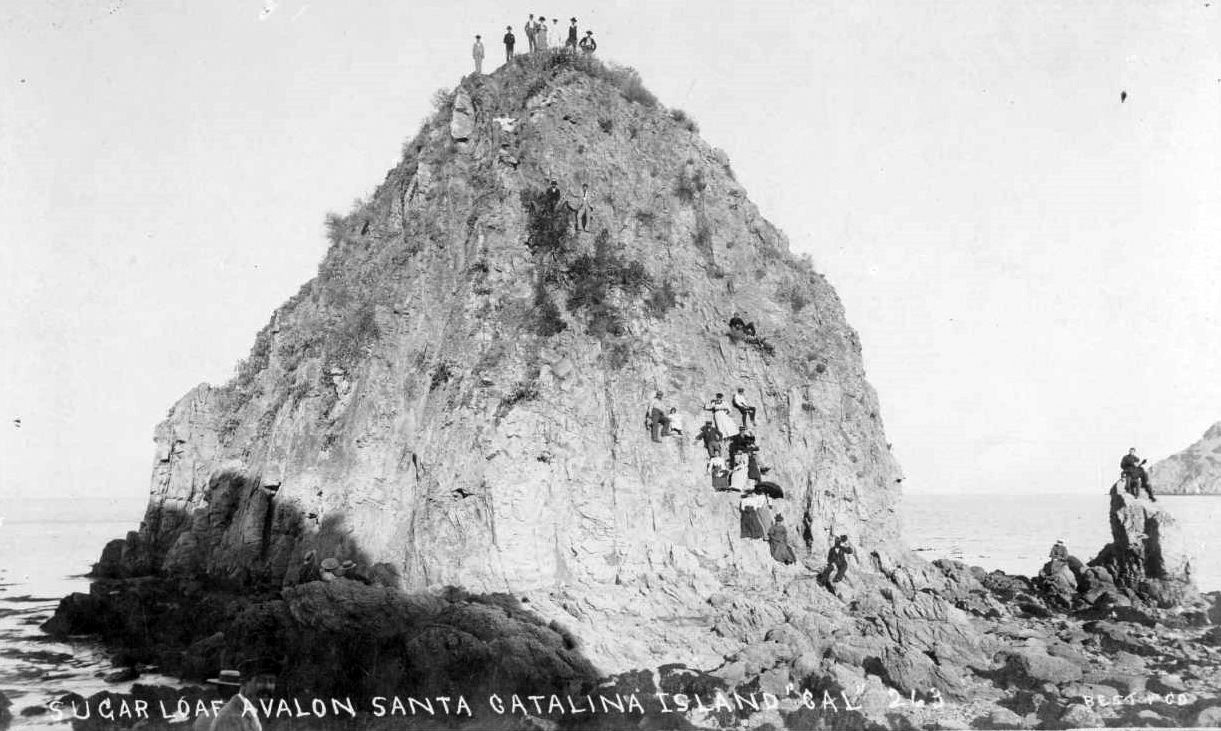 |
|
| (ca. 1890)^^ - Photograph of people posing on the Sugarloaf rock formation in Avalon Harbor. A group of people is standing on top of the rock, while another group is seen on the very, very steep face of the rock near the bottom-right. Two more people are seated on a smaller rock at right. |
Historical Notes Like its namesake in Rio de Janeiro, Brazil, Sugarloaf Mountain was the site of numerous festivities. Fireworks were exploded from its summit on Fourth of July. Climbing Sugarloaf was no easy task. In 1896, a stairway was built to accommodate the less adventurous. |
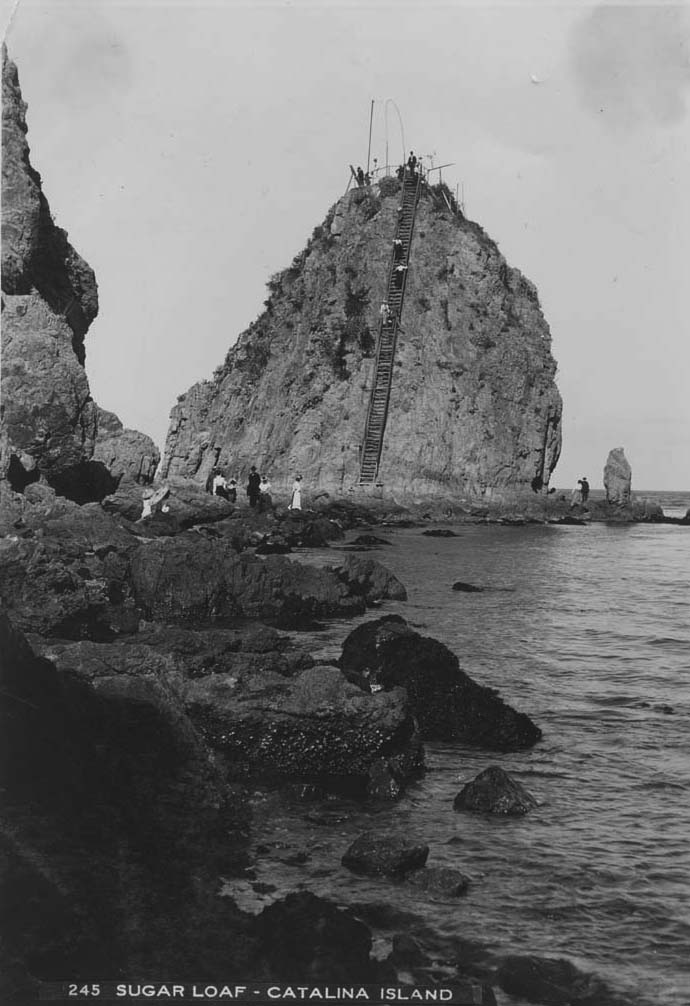 |
|
| (ca. 1900)^*# - View showing three women and a man climbing a very steep stairway on Sugarloaf. Three other people are seen standing on the platform at the top. |
Historical Notes Sugar Loaf Rock was a well-known landmark in Avalon Harbor, used by sailors for navigation. It was a popular site for various activities, including climbing, which was considered a challenging endeavor due to the rock's steep and rugged nature. In 1896, to make the rock more accessible to visitors, a stairway was constructed. This development allowed even those who were less adventurous to reach the summit of the rock. The stairway facilitated climbing and made Sugar Loaf Rock a more popular tourist attraction. |
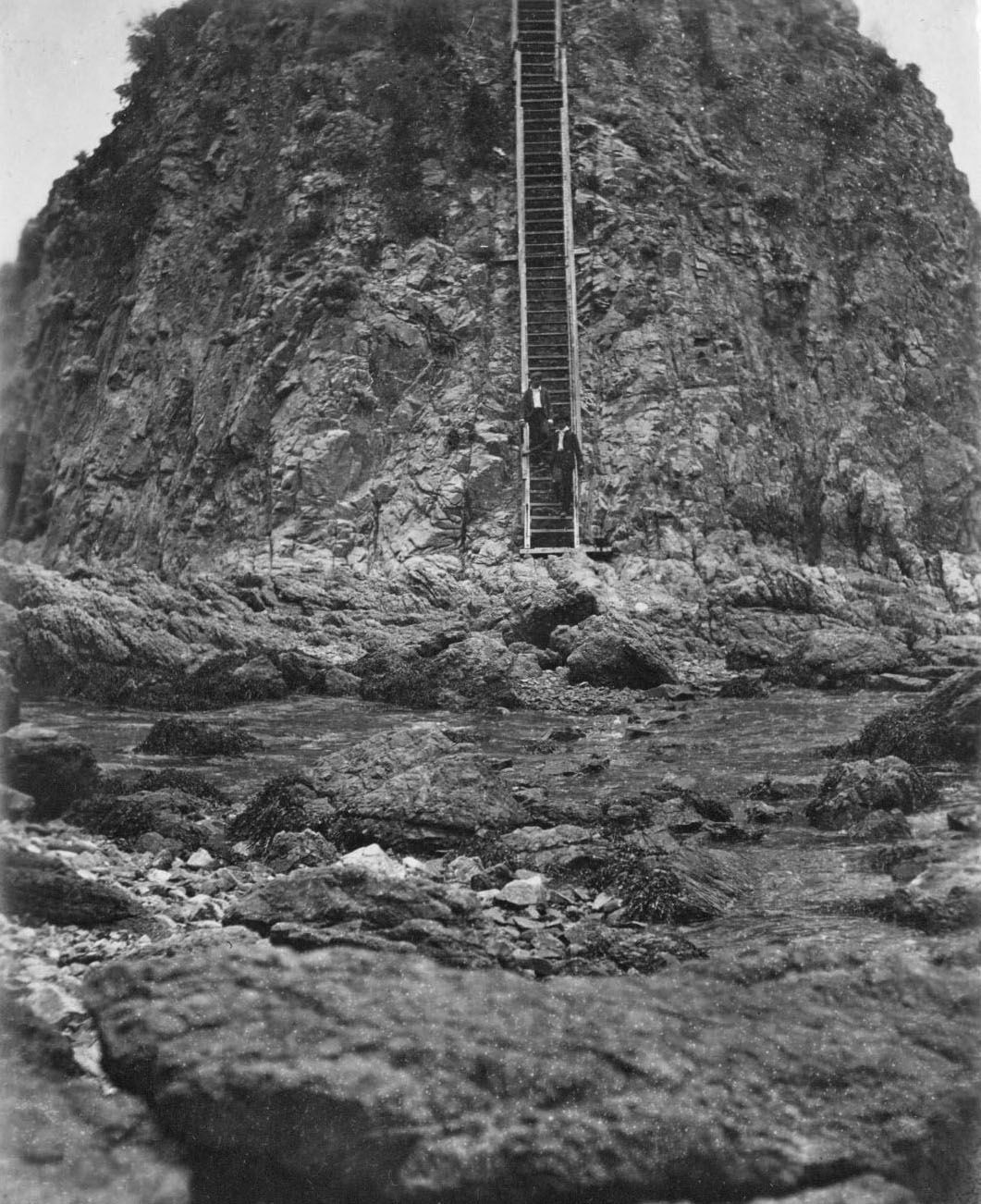 |
|
| (1903)* - Close-up view showing the base of Sugarloaf where two men (brothers G.P. and Russel Raymond Jennett) are seen descending the wooden stairway. Jennett Family Collection - Courtesy of Gilbert C. Jennett |
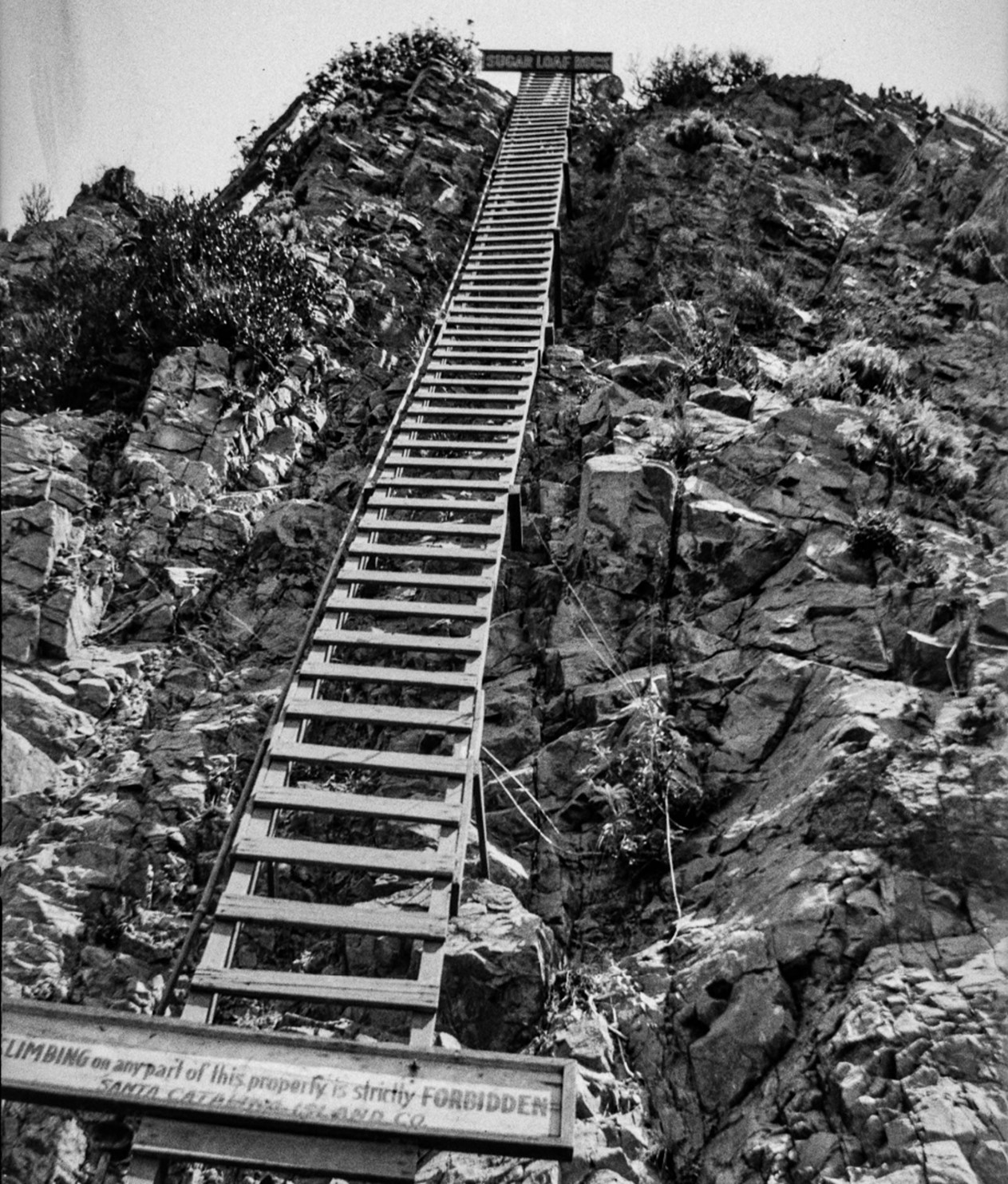 |
|
| (1917)* - Image of a step ladder installed on Sugar Loaf Rock at Avalon Bay on Santa Catalina Island. Signs on the rock read "Climbing on any part of this property is strictly forbidden Santa Catalina Island Co." |
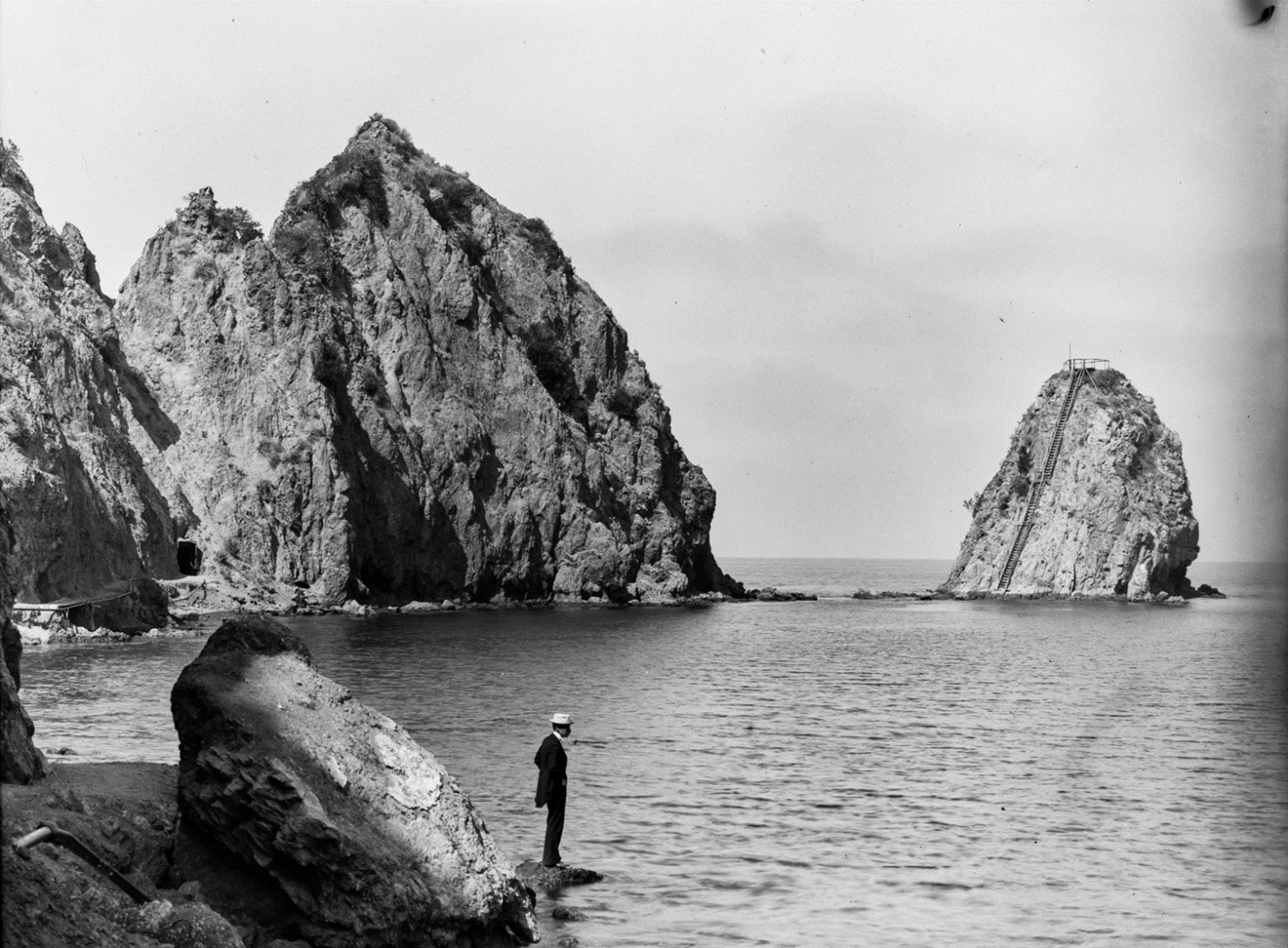 |
|
| (ca. 1905)* – A man stands on a rock near the shore of Avalon Bay, enjoying the picturesque scenery with the beautiful Sugar Loaf Rock formation in the background. From the Ernest Marquez Collection. |
Historical Notes Between 1917 and 1929, Sugar Loaf Point was dynamited and removed to clear the site for the Catalina Casino that stands there today. |
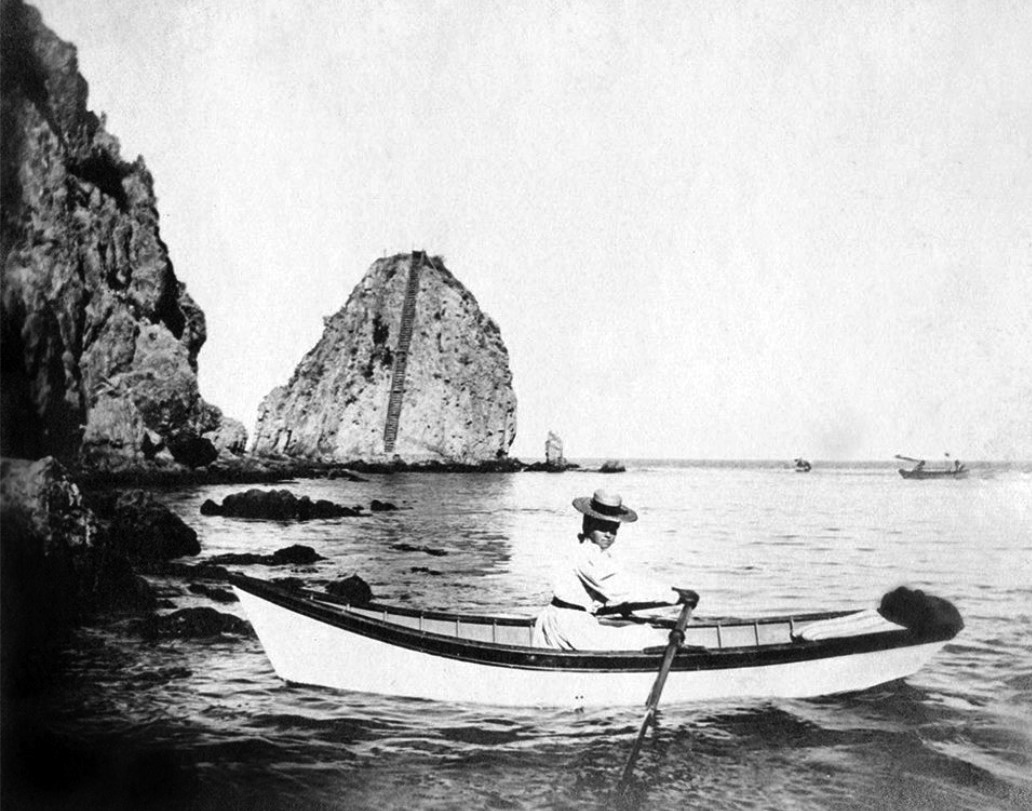 |
|
| (ca. 1900)* - View showing a woman wearing a wide brim hat rowing a boat in Avalon Bay with Sugarloaf Point seen in the background. |
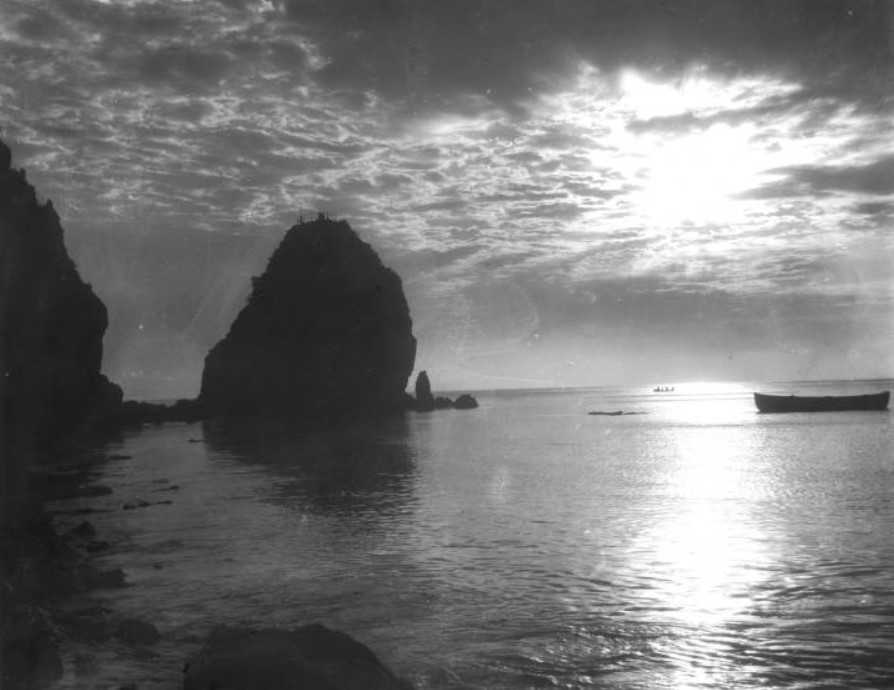 |
|
| (ca. 1900)^^ - Photograph of Sugarloaf Point (later Casino Point) in Avalon Bay at sunset. The large rock formation is at left, near the steep slope of the island. A small row boat is moored in the calm water at right. The sun is breaking through wispy clouds in the sky at right and is reflecting off of the smooth surface of the water. Another boat full of people is visible in the distance at right. |
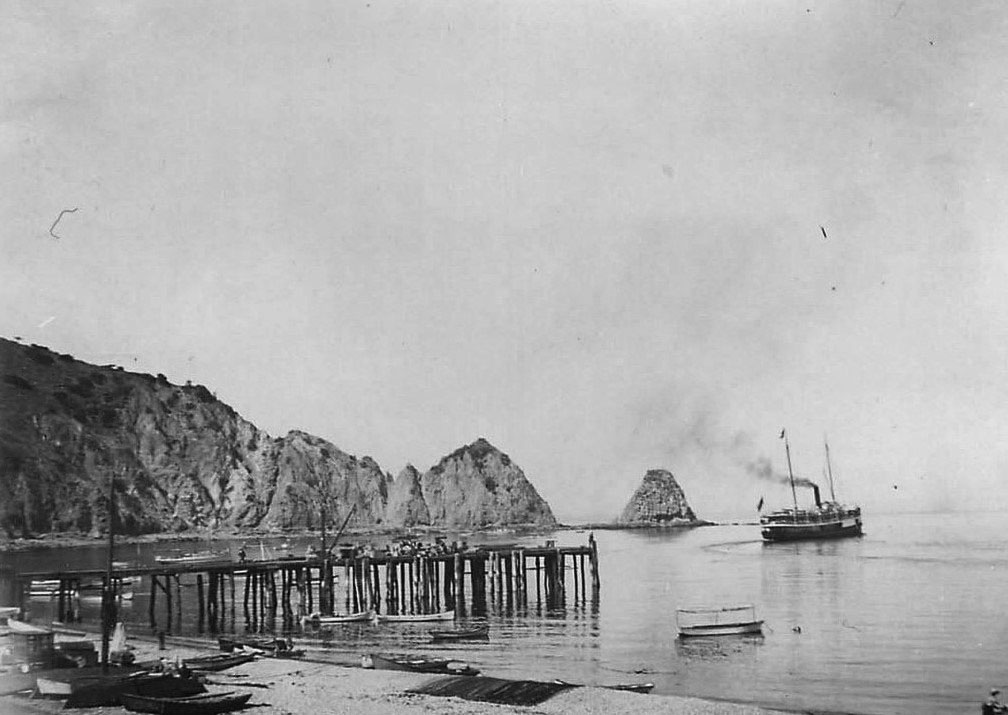 |
|
| (1901)^#^ - The steamer S. S. Hermosa leaving Catalina Island and making its way past Sugarloaf Point. |
 |
|
| (ca. 1900)^*# - Close-up view of Sugarloaf Point showing a steep stairway on the side of the rock formation and a viewing platform at the top. The steamship Hermosa is seen on the other side of the Point. |
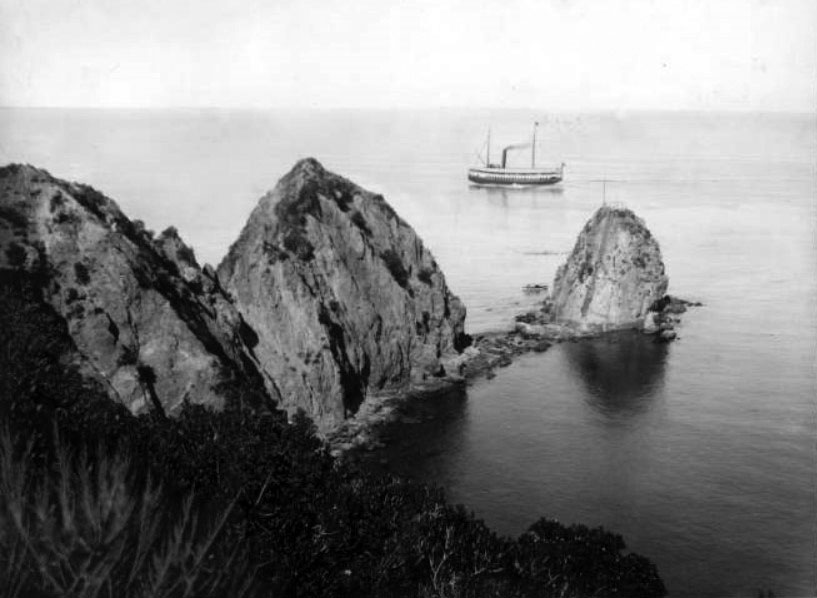 |
|
| (ca. 1910)^^ - Birdseye view of Sugarloaf in Avalon Harbor, with the S.S. Cabrillo in the background. The large rock formation can be seen at right. It is light colored and connected to the main island by a narrow strip of rock. Large rocky hills are visible in the foreground at left. In the background at center, the large steamer is visible, headed away from the harbor to the left. |
_ca1900.jpg) |
|
| (ca. 1900)^^ - View showing Avalon, Catalina as seen from Sugarloaf. About nine people are standing or sitting on one of the rock formations at Sugarloaf Point during low tide. A small rowboat with a man in it is at right. Avalon harbor and several other boats are visible in the background. |
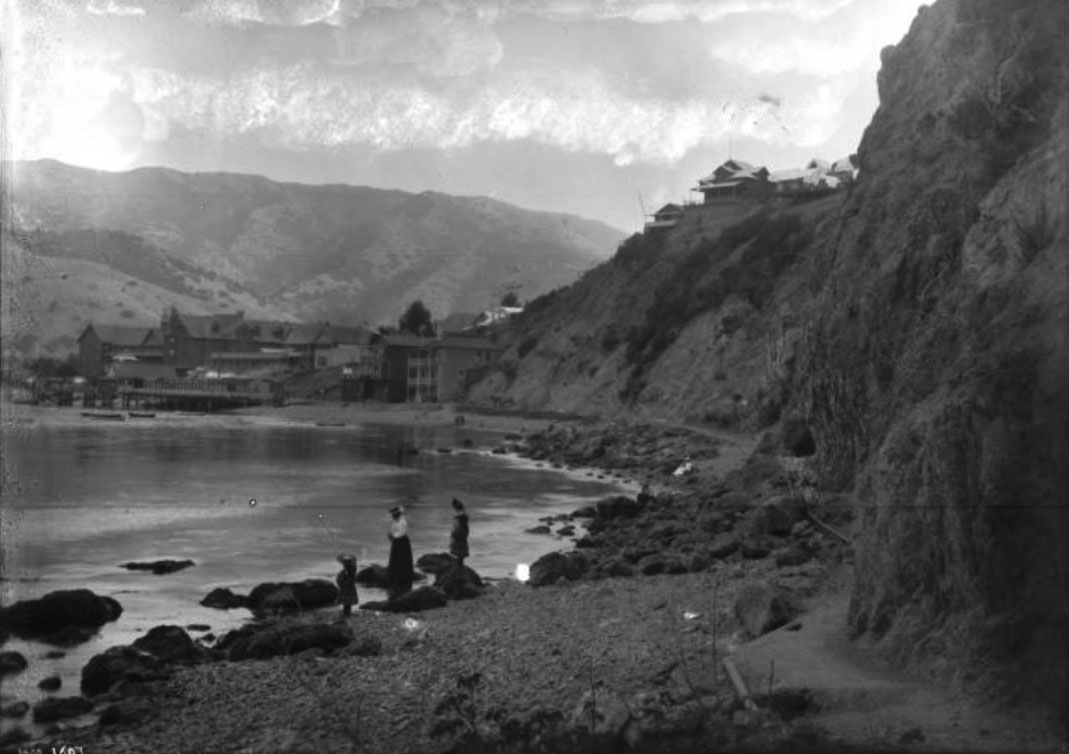 |
|
| (ca. 1905)* - View of a woman and two girls standing on rocks near Sugarloaf Point with the Metropole Hotel and Avalon Bay in the background. |
.jpg) |
|
| (1904)*#* - Panoramic view of the harbor at Avalon. The photograph was taken from somewhere along the northwestern shore of the bay, with the city of Avalon on the far right. There is a boat with a striped canopy and seven or eight people on it being rowed across the center of the image. There are also a few people standing or sitting on the shore. There are several unoccupied small boats on the water, as well as a three mast sailing ship, and few sailboats with their sails up. |
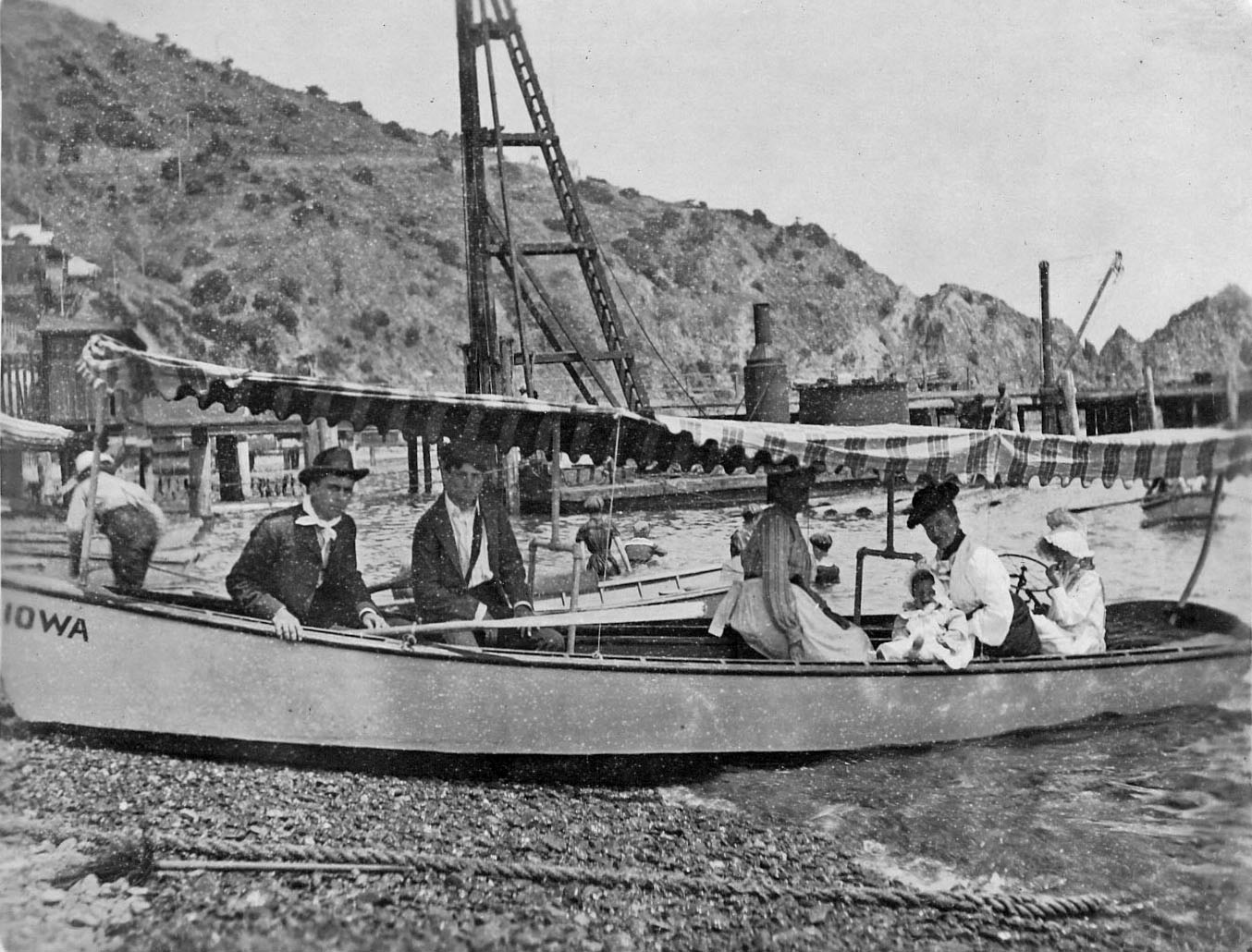 |
|
| (1903)* - View showing a family posing for the camera in a canopy-covered row boat on the beach in Avalon Bay. Russel Raymond Jennett is second from the left; the infant is Russel Raymond Jr., while others are unidentified. The jagged rocks of Sugarloaf are seen in upper-right. Jennett Family Collection - Courtesy of Gilbert C. Jennett |
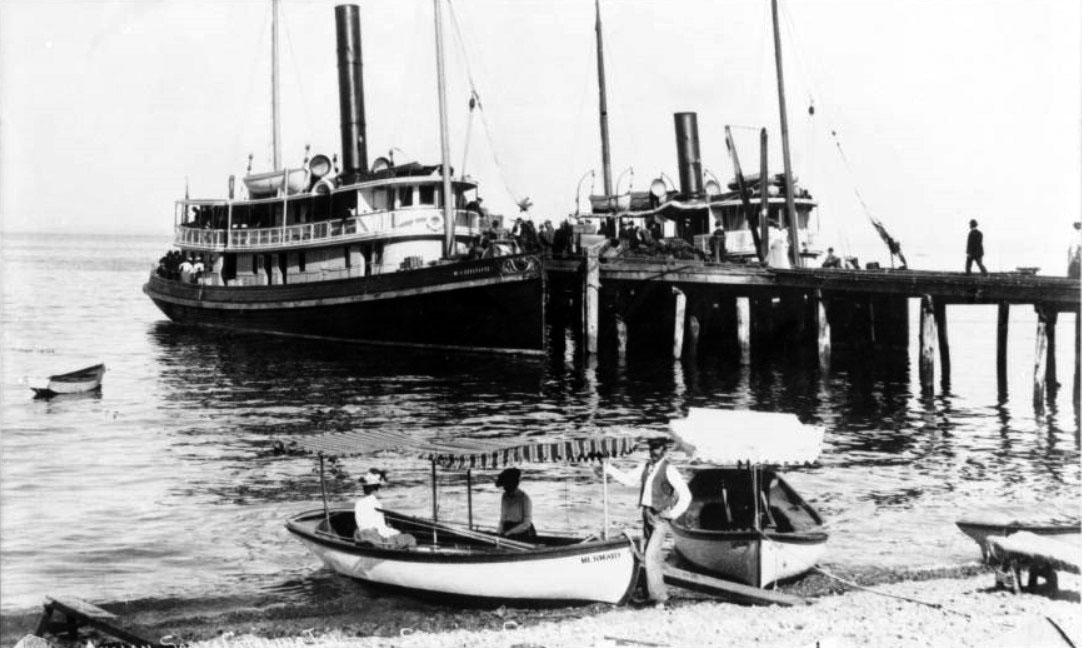 |
|
| (ca. 1900)^^ - View showing the steamer "Warrior II" docked at the center of the image, its upper and lower decks crowded with passengers at the stern. A similar steamer with a shorter stack, the "Falcon", sits behind the pier, to the right of the "Warrior II". A small dinghy floats to the left of the steamers, while two canoe-like boats, topped by awnings, are beached in the foreground. |
Historical Notes According to Hancock Banning, Jr., on April 3, 1979, the "Warrior II" had its after deckhouse removed and was used as a tug in San Pedro after 1908. The ship was also used by the Los Angeles Harbor department as a fireboat. The after cabin was used as temporary office quarters for Hancock Banning, Sr.; Hancock Banning Jr. also lived in it for two summers. |
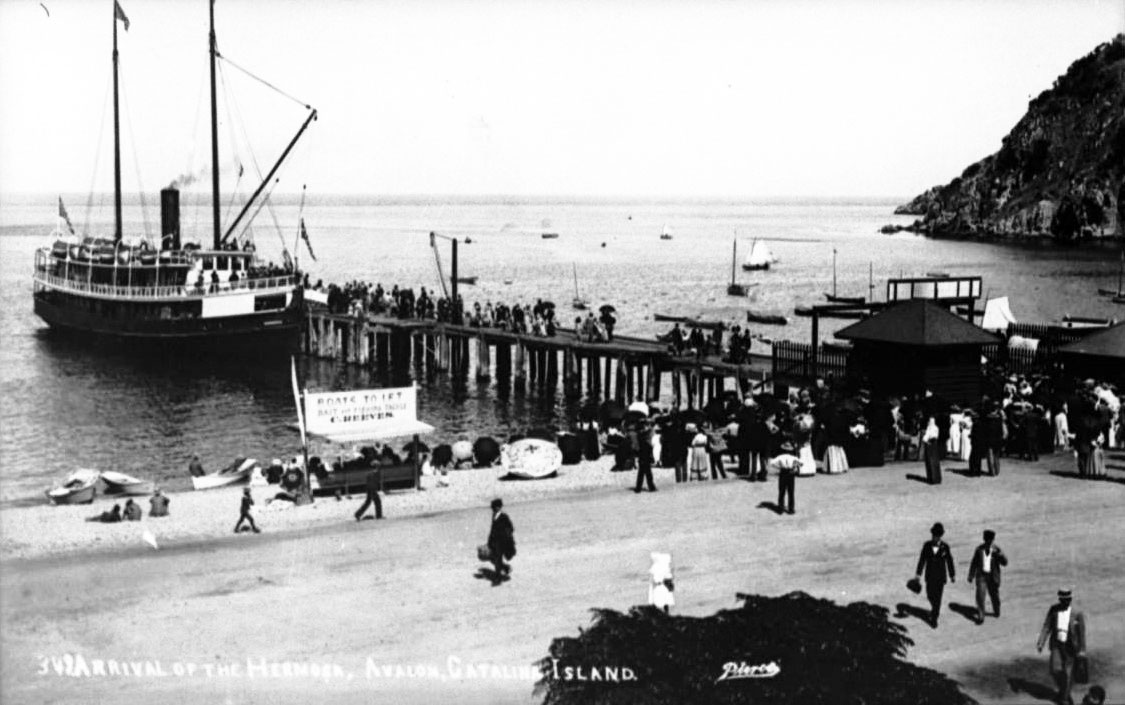 |
|
| (ca. 1900)^^ - View showing the arrival of the Banning Company's S.S. Hermosa at Avalon. The steamship is docked at the pier and many people are disembarking. Two small buildings are visible on the shore at the near end of the pier. A sign on the beach reads "Boats to let, bait and fishing tackle, C. Reeves". |
Historical Notes The wooden steamship S.S. Hermosa was built in San Francisco in 1888 by the Wilmington Transportation Company, owned by the Banning family, for transportation to the Island during the summer season. Off-season, the ship had been leased to other operators for use in Puget Sound and Alaska. By June of 1892, the Hermosa had returned to service on the Santa Catalina Island run, the Island then being owned by the Banning brothers. |
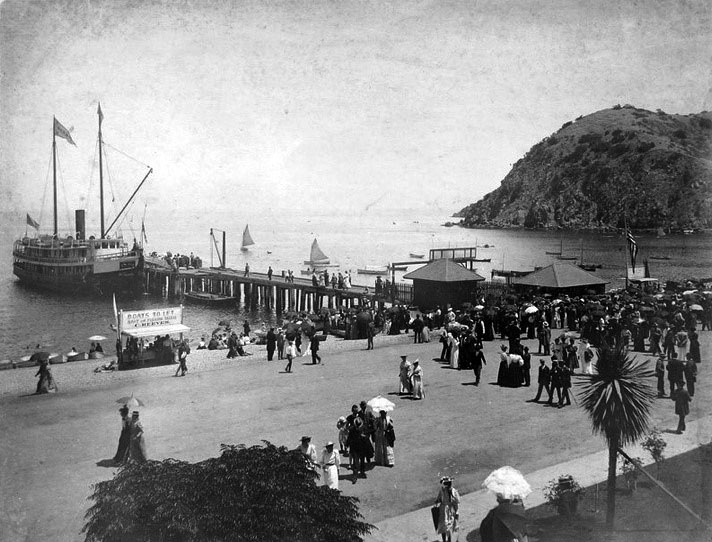 |
|
| (ca.1900)***# - View of the Wilmington Transportation Company's Steamer "Hermosa 1," docked at the Green Peer as seen from the front of the Metropole Hotel. Men and women with umbrellas are walking leisurely along the beach while another group of people are waiting to embark on the journey back to San Pedro Harbor. |
Historical Notes The S.S. Hermosa carried up to 150 passengers and was elegantly decorated. It carried passengers to the island for fourteen years until it was replaced by the larger Hermosa II. In 1900, besides the S.S. Hermosa No. 1, the vessels operated by the Banning Company were the Falcon, Hattie, La Paloma, and Oleander. |
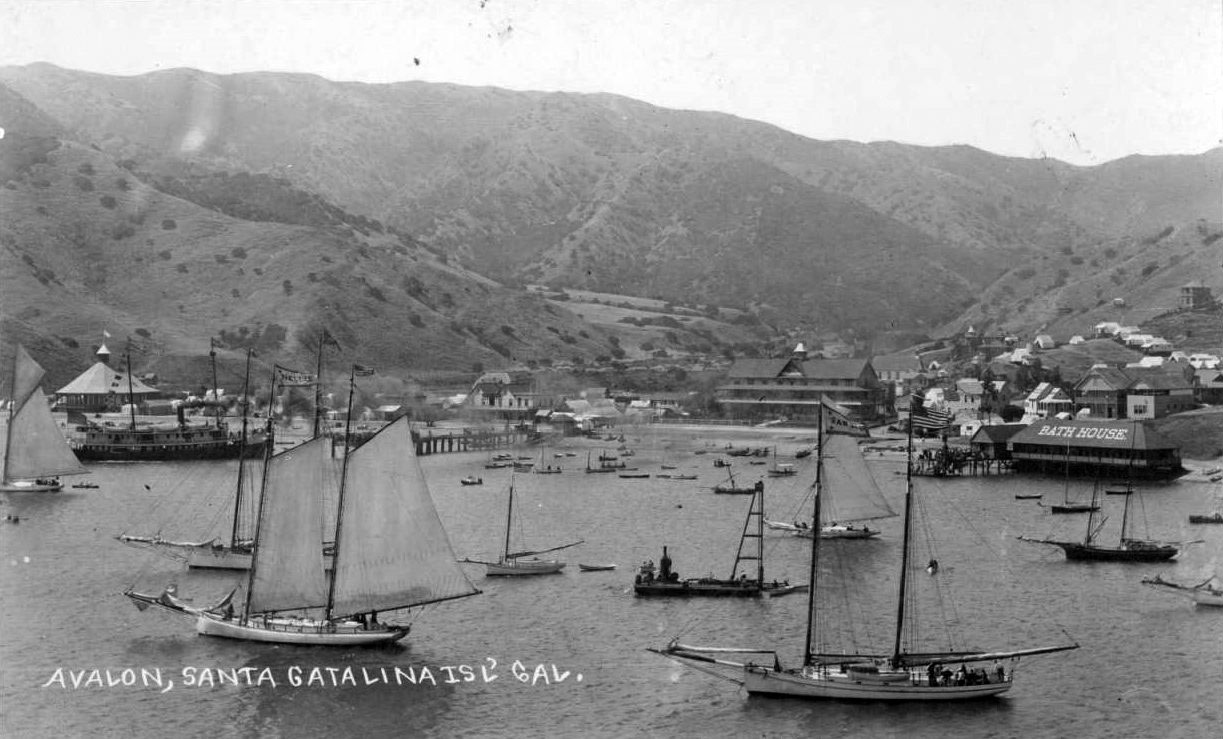 |
|
| (ca. 1892)^^ - View of Avalon Harbor, showing a crowded harbor with sailing vessels of all sizes. The steamer Hermosa I is visible in the background at left. Several large buildings can be seen on the shore, including the Bath House at right and a large building with a conical at left. The Hotel Metopole stand at center-right. |
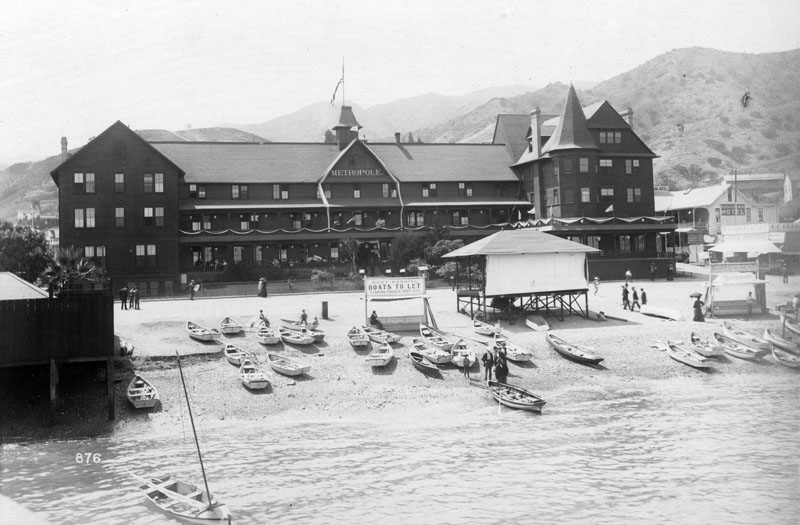 |
|
| (ca. 1900)* - View of the historic Hotel Metropole located at 205 Crescent Avenue on Santa Catalina Island. Several people take a leisurely stroll through the streets, and at least two dozen boats are 'docked' on the beach. A sign next to a small structure reads: "Bert Harding - Boats to let - Fishing, tackle, Bait, etc." |
Historical Notes The Hotel Metropole was such a success that additions to it were made in 1893 and 1897. The 1897 addition gave the hotel 58 more rooms as well as a large reception area and a ballroom. |
.jpg) |
|
| (ca. 1900)* - View of the Hotel Metropole on Santa Catalina Island. The E.E. Beeson & Co. building, selling general merchandise, bakery and delicacies, is to the right of the hotel, and Troy Laundry Co. is to the right of that. Several people can be seen taking a leisurely stroll through the street, as others sit at the base of the beach, watching swimmers. A horse-drawn wagon is seen "parked" in the background.* |
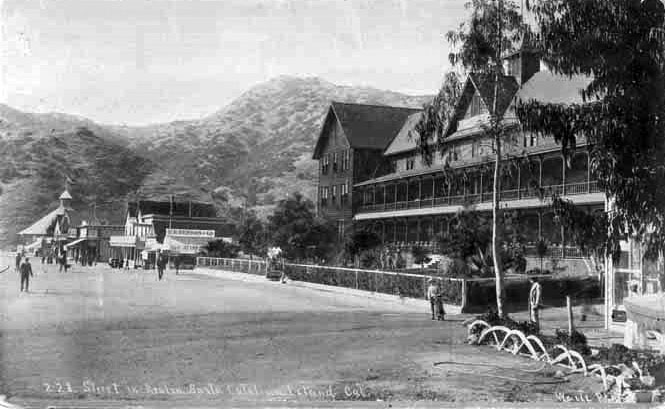 |
|
| (ca. 1900)* - Postcard view showing the historic Hotel Metropole on Santa Catalina Island. Several smaller buildings are seen in the distance with the rugged Avalon mountainscape standing in the far background. |
* * * * * |
Catalina Fishing
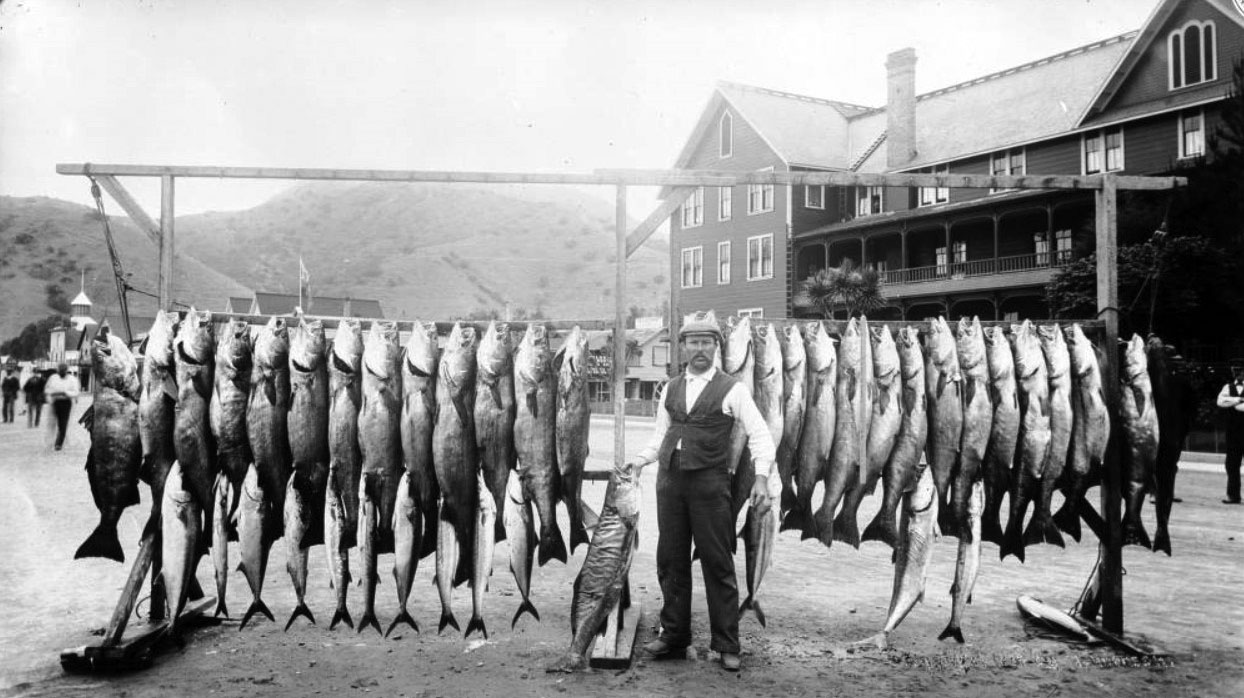 |
|
| (ca. 1901)* – View of a man standing in front of the Hotel Metropole with the day's catch of fish. Photo title reads: "Santa Catalina. White sea bass, yellowtail & barracuda caught with rod & reel." |
Historical Notes Avalon flourished as both a tourist resort and fisherman’s paradise. By 1906, the beach was crowded with boat stands, launches, rowboats, people, racks of drying fish, and sea lions waiting for a handout! In order to relieve the congestion, a pier was built running parallel to the beach, but a storm destroyed it in 1908. |
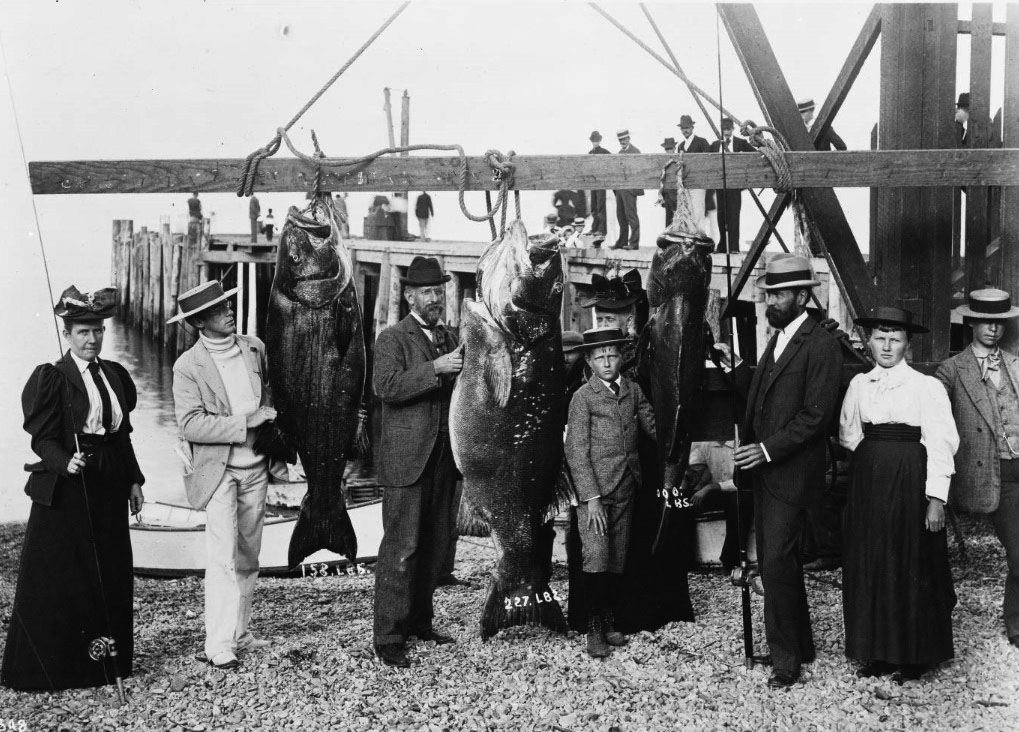 |
|
| (ca. 1905)* - Photographic portrait of eight people including Professor Holder displaying their catch of large fish (Black Sea Bass) on Catalina Island. Three large fish are hung from a support beam at center, Dr. Holder just lightly touching the largest fish which is pictured in the middle. The weight of each fish is written-in beneath them. From left to right: "158 lbs, 227 lbs, 100 lbs". |
Historical Notes In the early 1900s large numbers of Giant Black Sea Bass could be found in the waters of Southern California, but as the population of the State increased and became more aware of the waters around them, most of these monster fish were fished out for their value as photographic trophies, since their meat is less than a delicacy. When California finally passed legislation to provide full and total protection to the species from any take whatsoever by either commercial or sport fishers, they started to slowly make a comeback. |
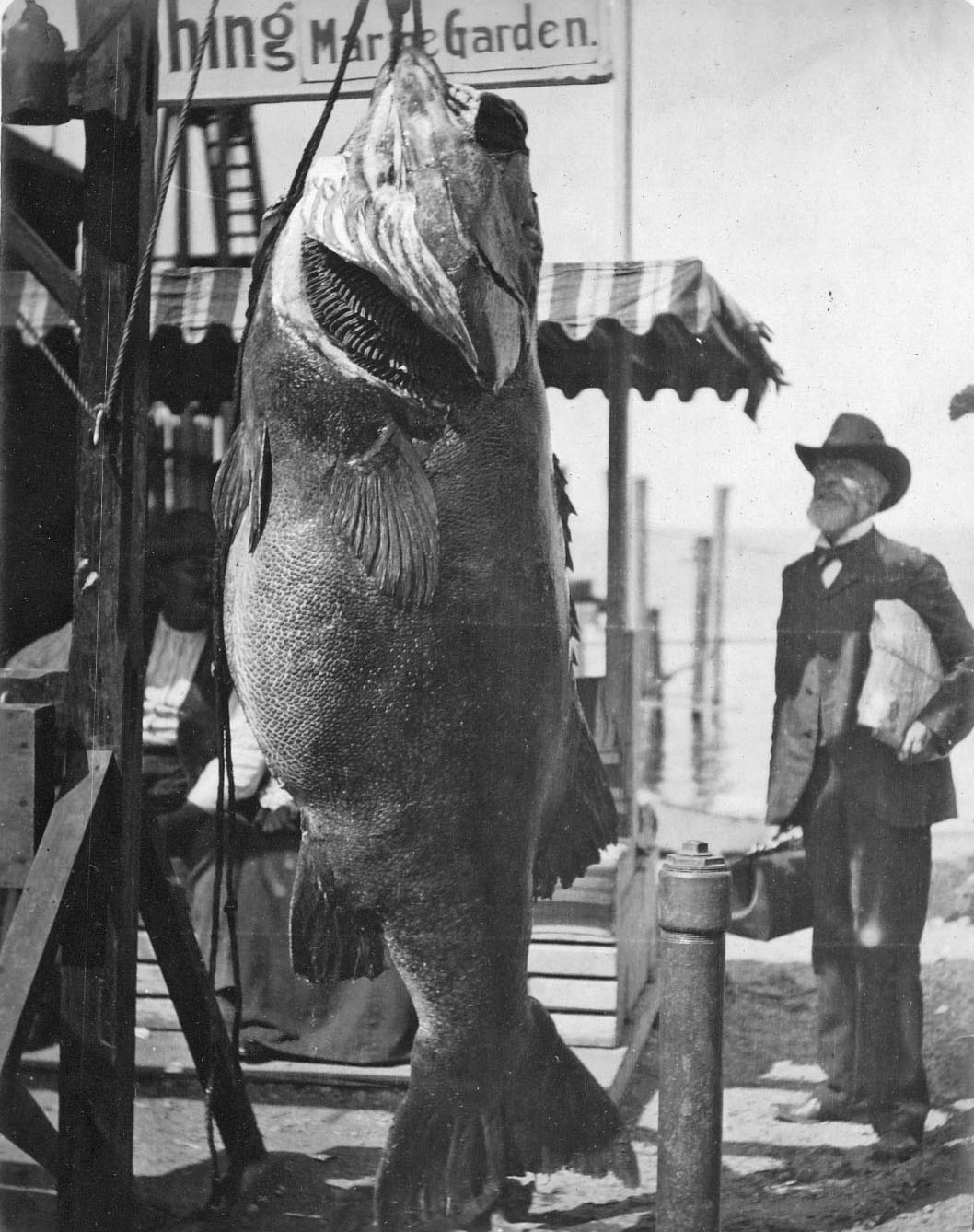 |
|
| (1903)* - View showing Captain Russel Jennet posing with a very large black sea bass at Avalon Bay. Jennett Family Collection - Courtesy of Gilbert C. Jennett |
Historical Notes The Black Sea Bass can grow to enormous size, some in excess of 600 pounds. These fish are reported from Cedros Island, Mexico and north along the California coast. The International Game Fish Association world-record giant sea bass was taken at Anacapa Island on August 20, 1968. It weighed 563 pounds 8 ounces. |
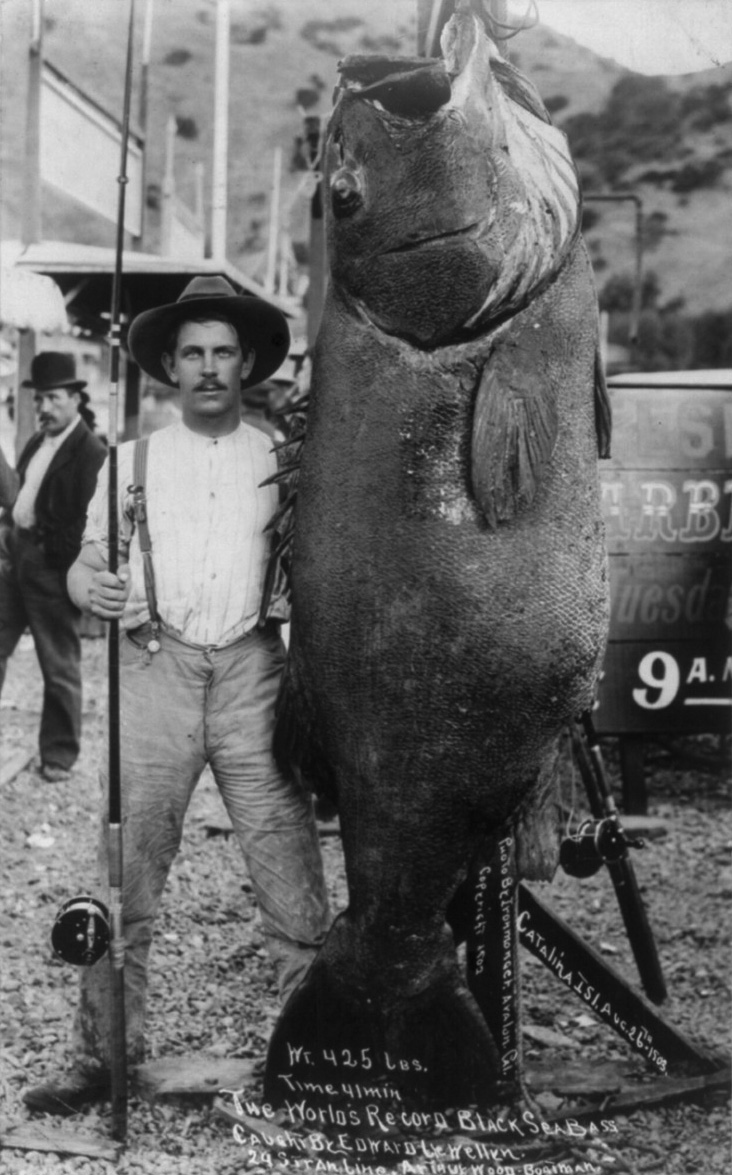 |
|
| (1903)* – View showing a 425 pounds Black Sea Bass taken by Edward Beach Llewellyn (time: 41 minutes) on August 26, 1903. It became the World’s Record Black Sea Bass caught. Off Catalina Island. Photo: Library of Congress. |
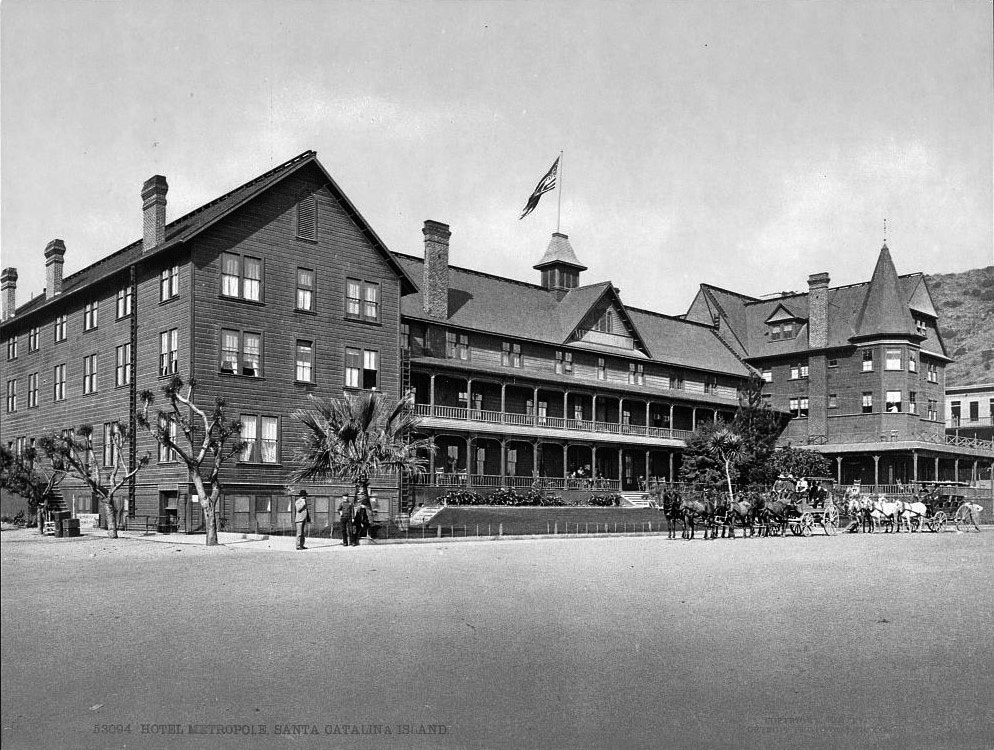 |
|
| (1901)** – View of the Hotel Metropole in Avalon, Catalina Island. Two horse-drawn wagons are seen parked in front of the hotel. |
Historical Notes The Metropole continued to thrive during the early years of the 20th century, right up until the disastrous early morning hours of Nov. 29, 1915. Between 3:30 and 4:00 a.m., a fire started mysteriously near the rear of the hotel. Avalon’s small fire department quickly was overwhelmed by the blaze, which spread until it had destroyed fully half of the town’s hotels and buildings. Many residents were left homeless. A few years later, the hotel was rebuilt on the same site but was significantly downsized, this time consisting of only 48 rooms and a luxurious 2-bedroom Beach house. A 52-room Hotel Metropole now stands on the site of the original structure in Avalon at the center of the Metropole Market Place development. |
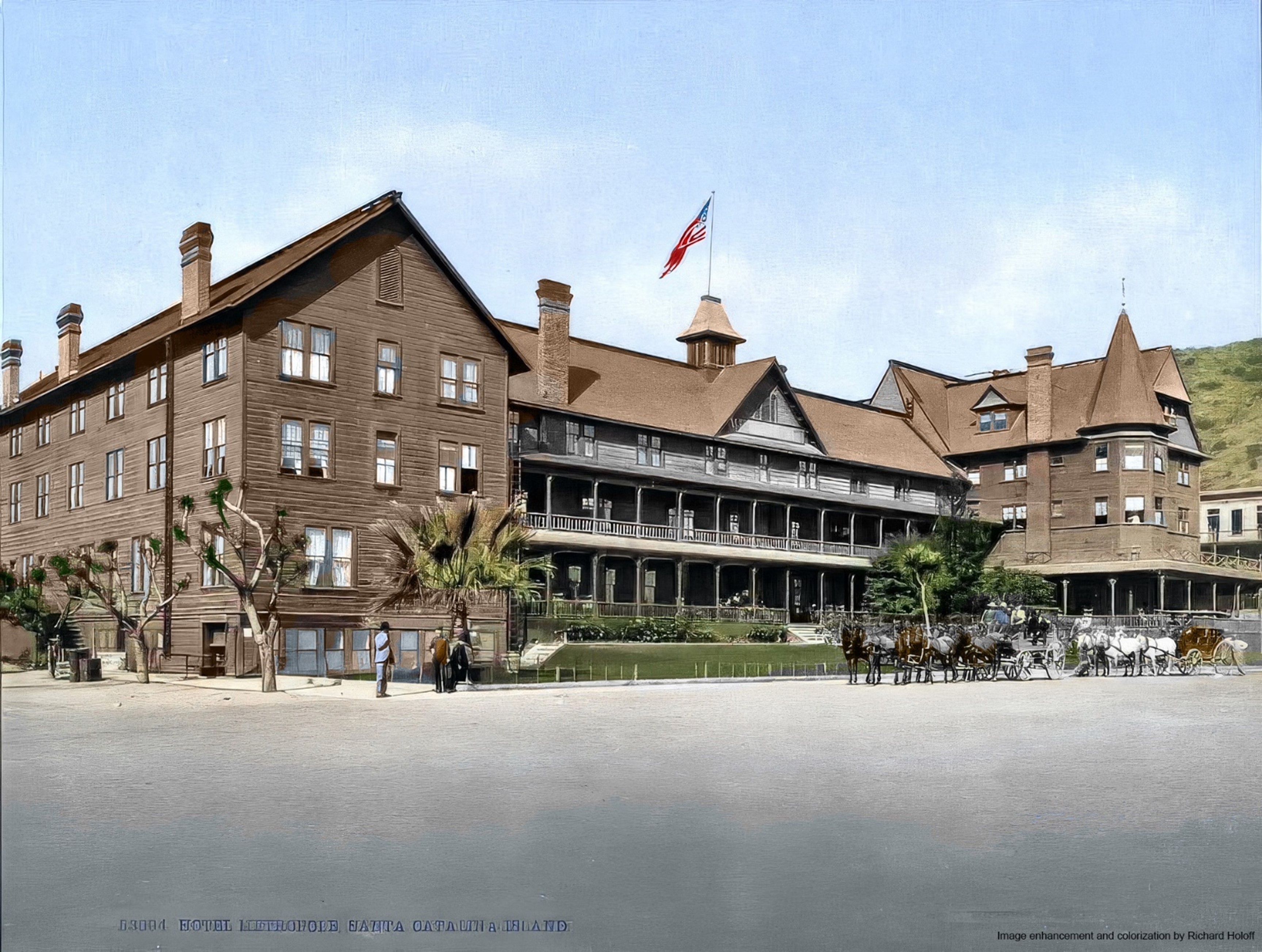 |
|
| (1901)** – View of the Hotel Metropole in Avalon, Catalina Island. Two horse-drawn wagons are seen parked in front of the hotel. Image enhancement and colorization by Richard Holoff |
Historical Notes The Metropole continued to thrive during the early years of the 20th century, right up until the disastrous early morning hours of Nov. 29, 1915. Between 3:30 and 4:00 a.m., a fire started mysteriously near the rear of the hotel. Avalon’s small fire department quickly was overwhelmed by the blaze, which spread until it had destroyed fully half of the town’s hotels and buildings. Many residents were left homeless. A few years later, the hotel was rebuilt on the same site but was significantly downsized, this time consisting of only 48 rooms and a luxurious 2-bedroom Beach house. A 52-room Hotel Metropole now stands on the site of the original structure in Avalon at the center of the Metropole Market Place development. |
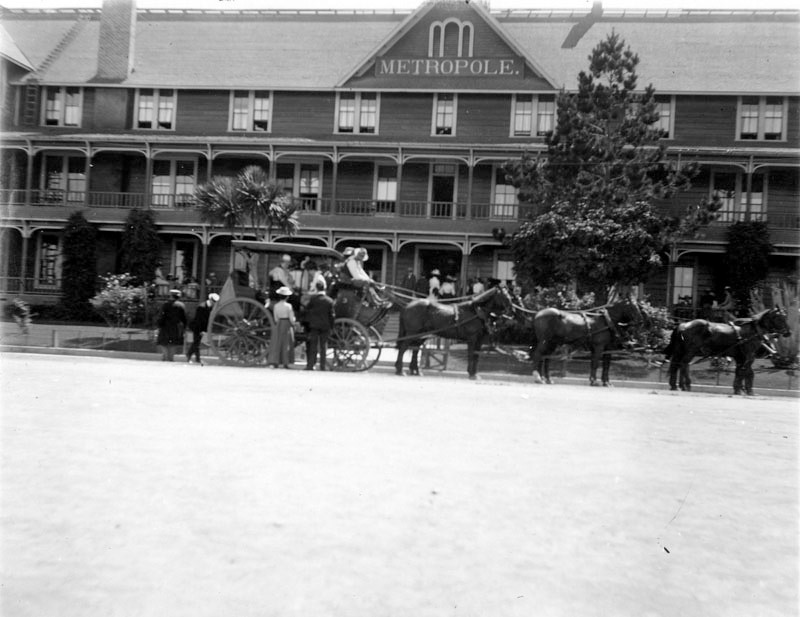 |
|
| (ca. 1900)* - Front view of the historic Hotel Metropole. Several men and women gather in and around a horse-drawn carriage, which is 'parked' at the front of the hotel, while a few more people are visible at the hotel's entrance. The stage coaches would take hotel guests to various spots around the island such as Lover's Cove and Descanso Beach. |
Historical Notes After the Banning brothers bought Catalina in 1891, they had better luck in developing the island to accomodate tourism. They developed Avalon into a proper resort community, made roads into the island’s interior for stagecoach tours and access to hunting lodges. The new roads also enabled tourists to get to Descanso Beach, Lover’s Cove, and other locations, from the town of Avalon. |
* * * * * |
Stage Road
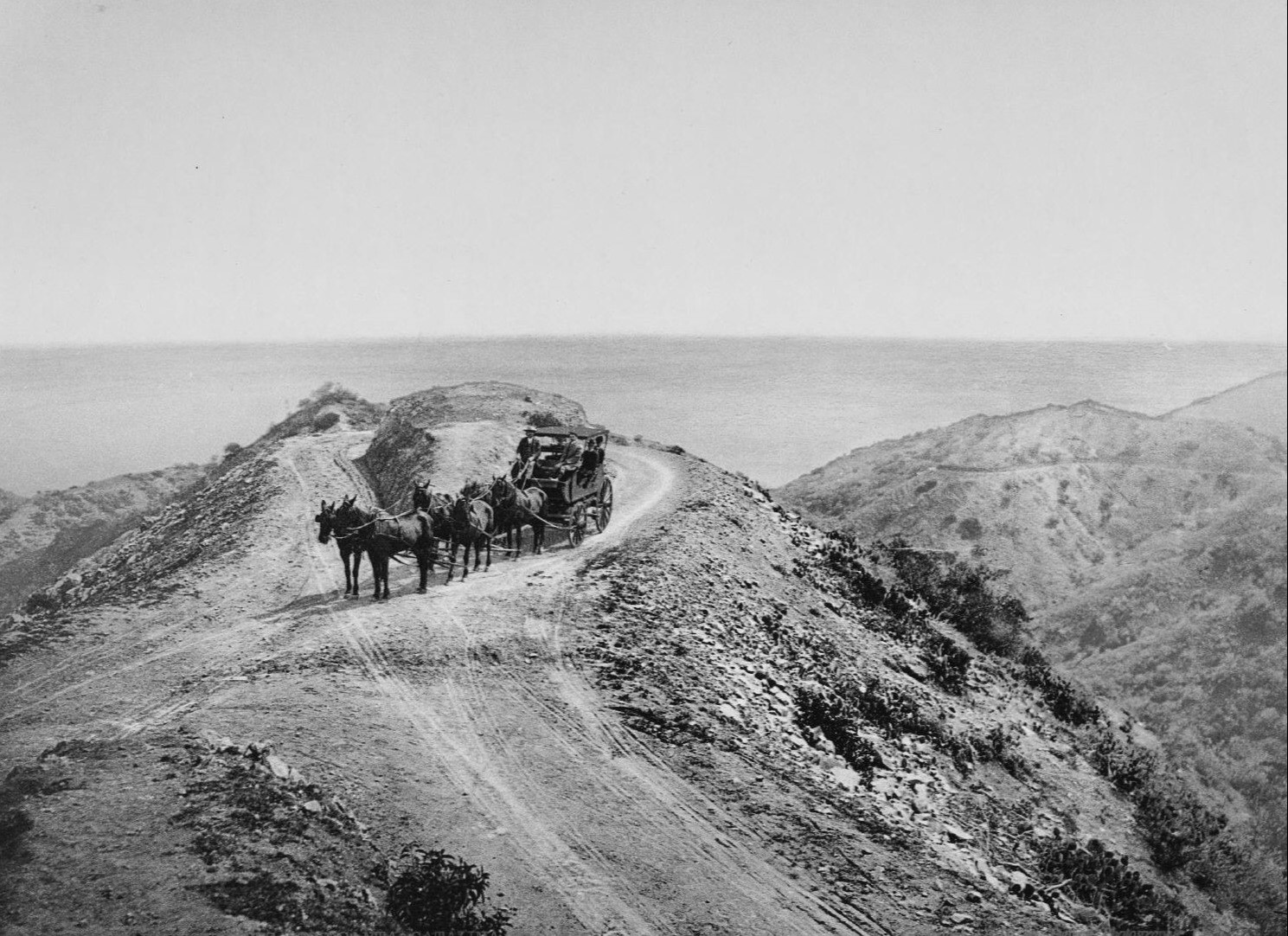 |
|
| (ca. 1897)* – View of Farnsworth Loop (named for Samuel Farnsworth) on Stage Road, Santa Catalina Island. Seen is a stage coach which is drawn by six horses, having just completed going around the loop. |
Historical Notes Stagecoach tours became a popular attraction on Santa Catalina Island, largely due to the efforts of the Banning brothers, who acquired the island in 1891. In 1894, they established the Santa Catalina Island Company and began constructing roads and infrastructure to develop the island as a tourist destination. In 1895, the company introduced the first stagecoach tours, allowing visitors to explore the island's rugged interior, which was previously difficult to access. The Banning brothers built the island's first major roads, including the essential "Stage Road," which provided access to scenic spots and hunting lodges. These stagecoach tours offered tourists panoramic views of Avalon and the island's mountainous terrain, as depicted in historical photographs from around 1900 that show stagecoaches navigating narrow mountain roads and descending towards Avalon, creating a thrilling experience for passengers. |
 |
|
| (ca. 1900)^^ - View showing a horse-drawn stagecoach at the elbow of a narrow mountain road on Catalina Island as it descends to the next tier. In the left background, the mountains open up to the Pacific Ocean. |
Historical Notes The Banning brothers built Catalina's first major roads such as the "Stage Road" as seen above. Stagecoaches would take tourist on island tours and to hunting lodges. |
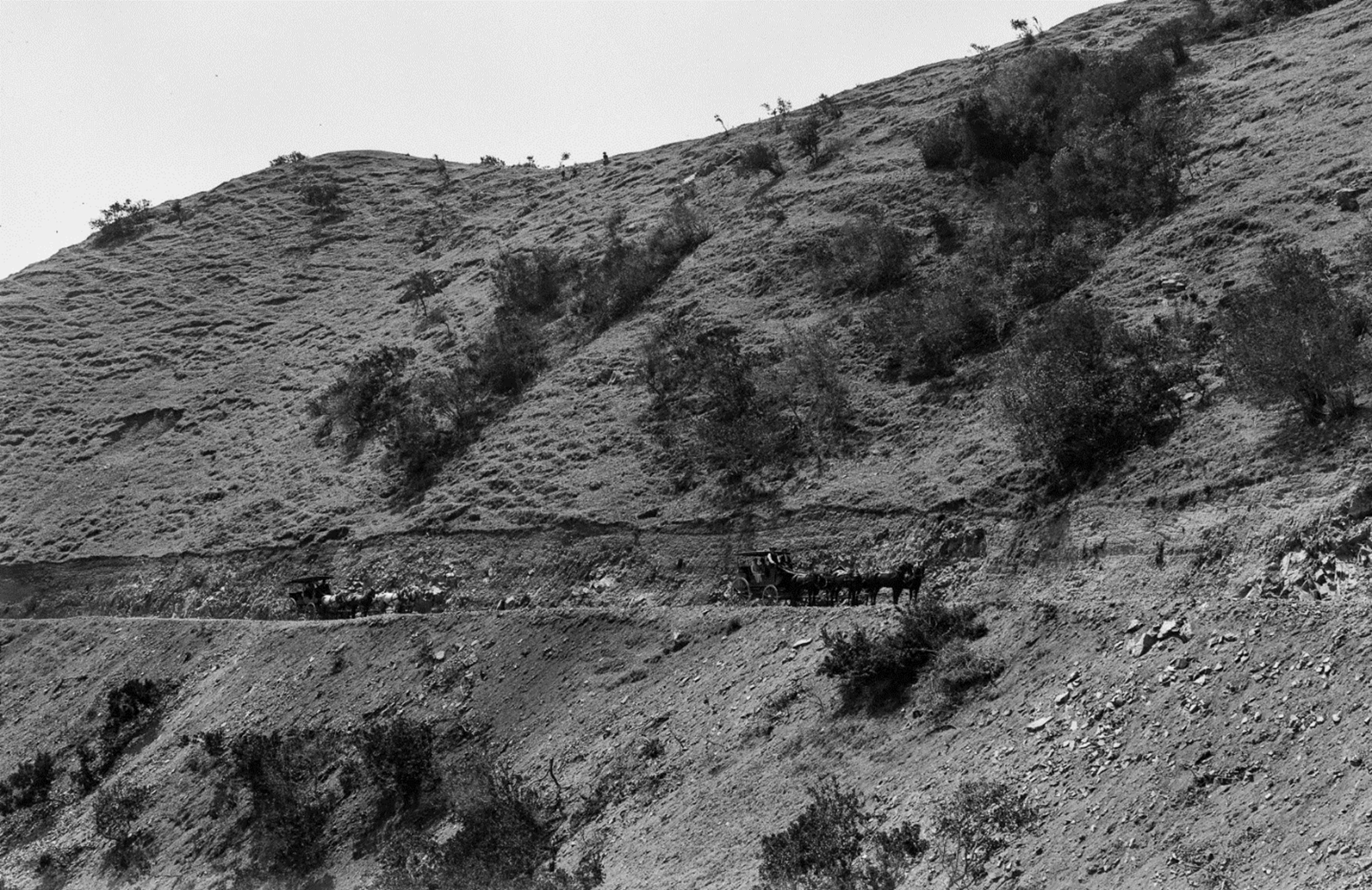 |
|
| (ca. 1900)* - Image of horse-drawn stagecoaches on Stage Road, carved into the rugged hillside. From the Ernest Marquez Collection. |
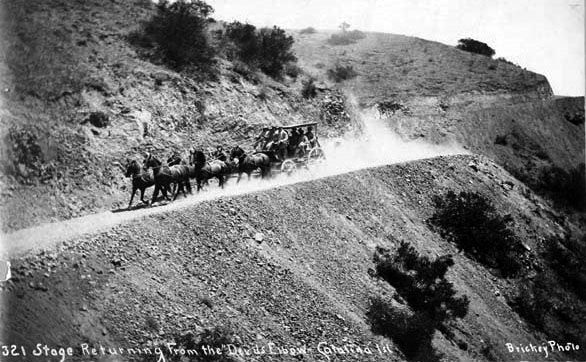 |
|
| (ca. 1903)^*# – View showing a stagecoach racing down a steep mountain road on its return journey to the Hotel Metropole from “Devils Elbow” on Catalina Island. |
Historical Notes Stagecoaches navigating narrow mountain roads and hairpin turns while descending towards Avalon created a thrilling experience for passengers. |
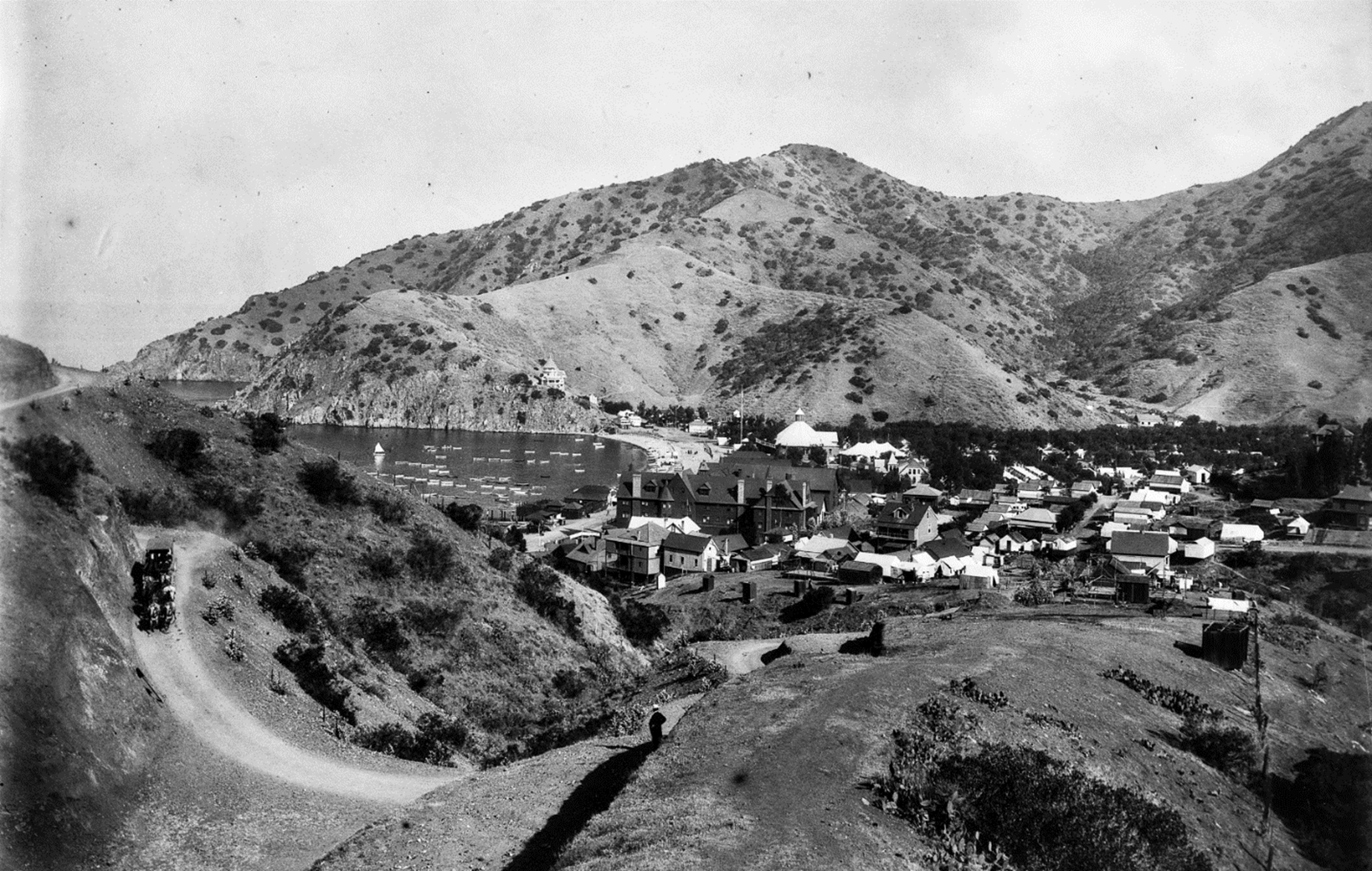 |
|
| (ca. 1900)* - Panoramic view of Avalon from above Stage Road. A stage coach is seen coming down the road toward a curve (at left) where a man stands beside an embankment (lower-center) observes the action. From the Ernest Marquez Collection. |
Historical Notes Stagecoach Road on Catalina Island around 1900 was a crucial part of the early tourism infrastructure developed by the Banning brothers. It facilitated popular stagecoach tours that allowed visitors to explore the island's beautiful and rugged interior, contributing significantly to Catalina's early appeal as a resort destination. |
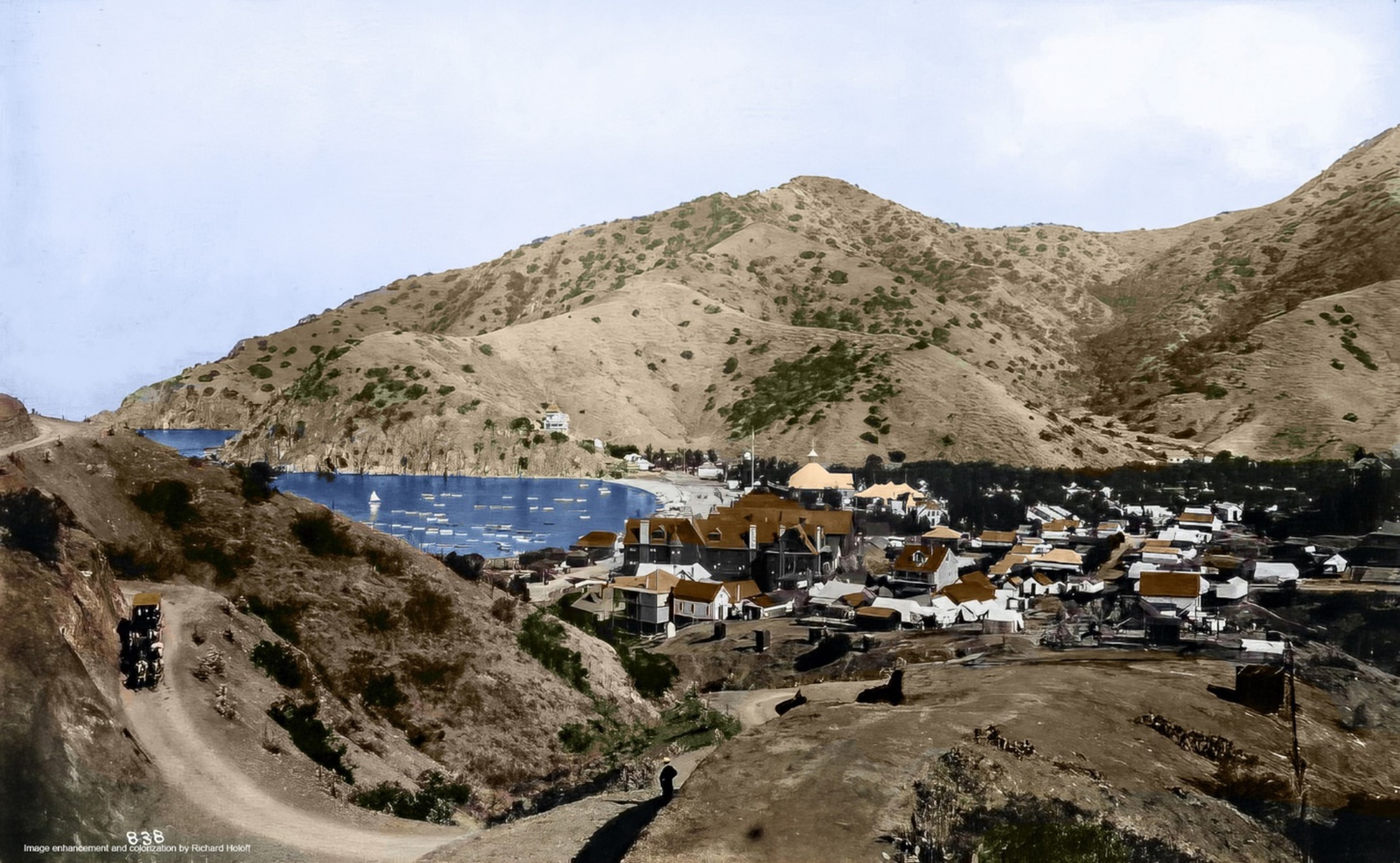 |
|
| (ca. 1900)* - Panoramic view of Avalon from above Stage Road. A stage coach is seen coming down the road toward a curve (at left) where a man stands beside an embankment (lower-center) observes the action. Image enhancement and colorization by Richard Holoff |
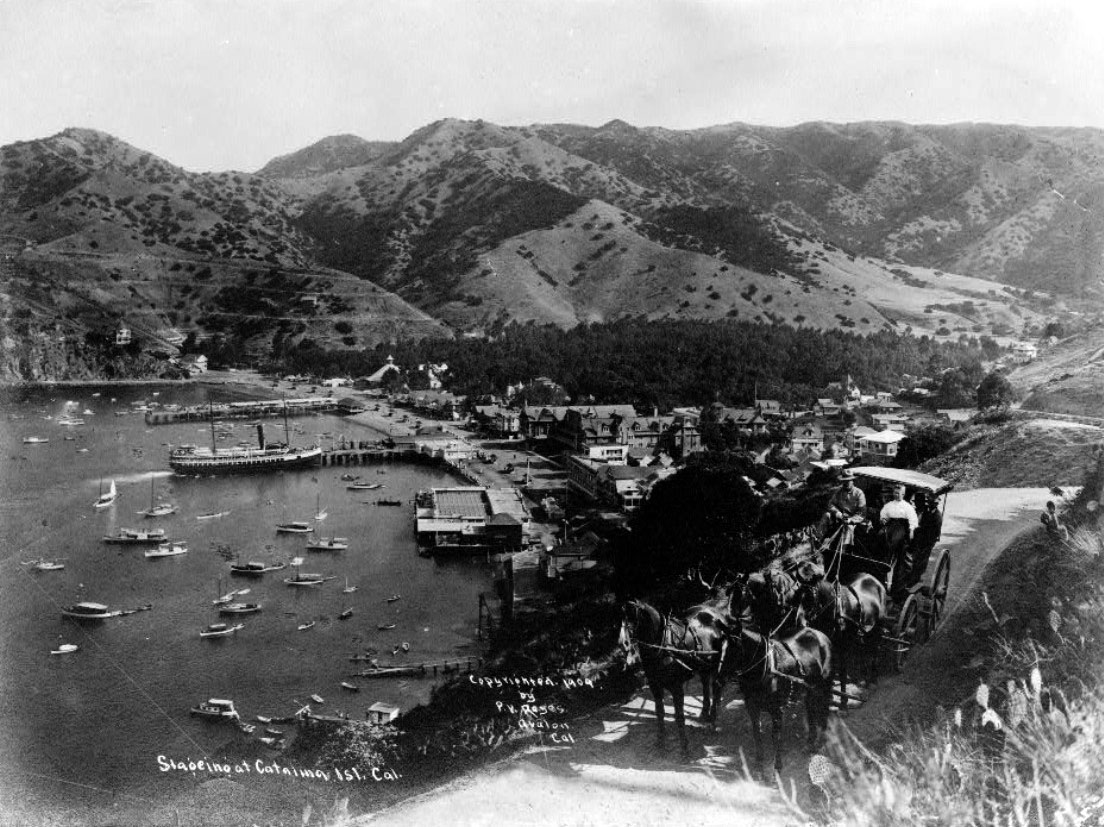 |
|
| (ca. 1909)** - ‘Stageing’ at Catalina Island with a great view of Avalon Bay. The steamboat S.S. Cabrillo, which began transporting visitors from San Pedro to Catalina Island in 1904, is seen docked below. |
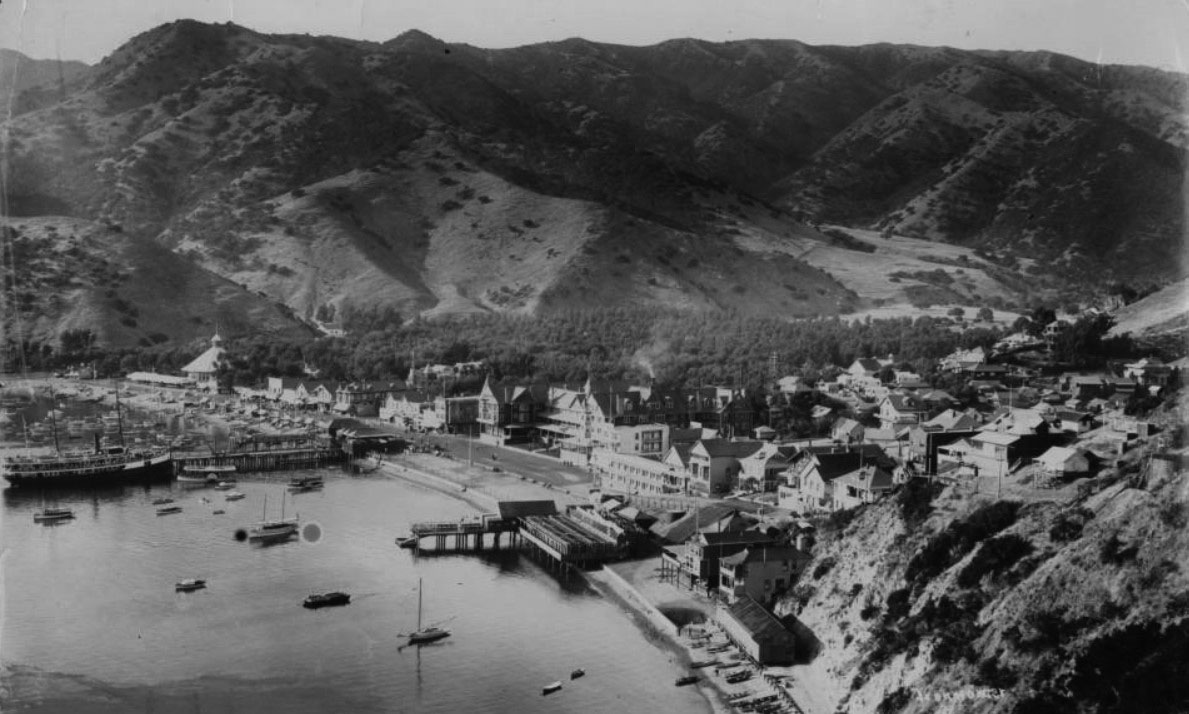 |
|
| (1903)^^ - Birdseye view of Avalon Harbor showing the steamer Hermosa II at the dock. The harbor is at left and is full of small sailing vessels. The large steam ship is moored at a wooden dock at left. The glass bottom boat Cleopatra is visible as well. The city of Avalon can be seen at right, nestled at the foot of several tall hills. A large forest can be seen at the base of the hills at center. In the foreground, a rocky hillside can be seen. The Hermosa II was commissioned in 1902. |
* * * * * |
Crescent Avenue
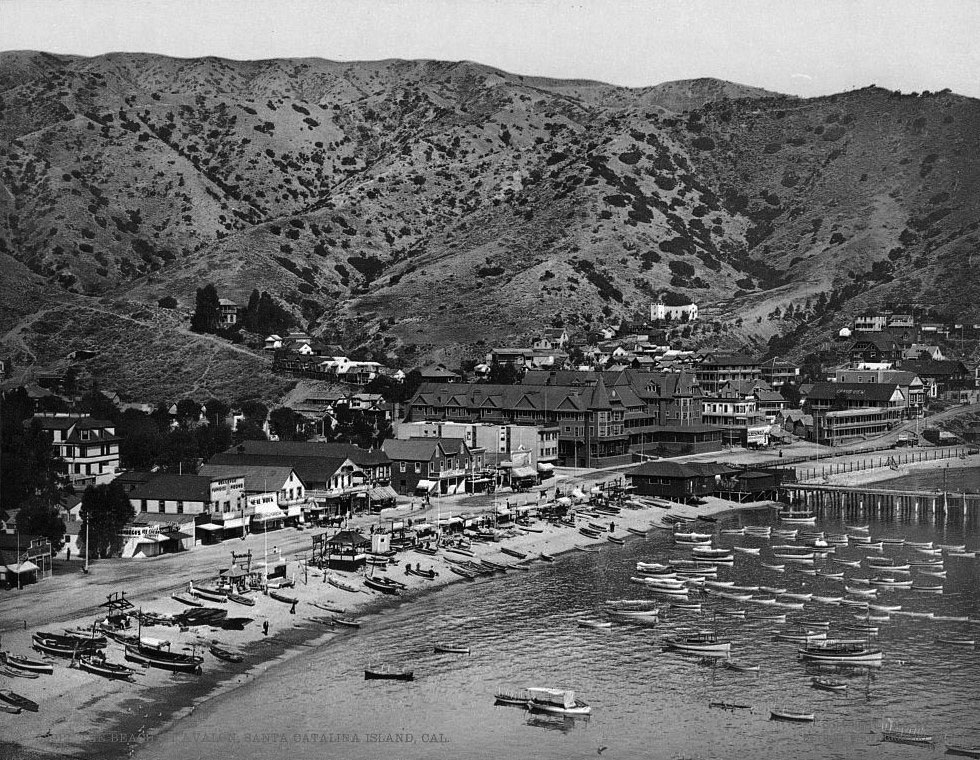 |
|
| (1903)** – View of Avalon Harbor filled with small boats docked along the pier and on the sand along the shoreline. The large picturesque Hotel Metropole is seen at center facing the bay with Crescent Avenue seen in front of it. |
Historical Notes The Bannings built the island's first substantial infrastructure, providing water, electricity, waste disposal, and communications services, building good roads, and installing law enforcement and fire protection services. During the period they owned the island, from 1892 to 1919, visitor attractions on the Island also expanded exponentially to include a dance pavilion, golf course, tennis courts, an incline railway, Greek amphitheater, and aquarium. Tourists could enjoy the music of the Porters Catalina Island Marine Band, hunt and fish, watch fireworks, take stagecoach rides, and view the wonders of the sea through the floors of glass-bottomed boats. Crescent Avenue, also known locally as The Strand or Front Street, is the main thoroughfare running along the curve of Avalon Bay on Santa Catalina Island. Its evolution mirrors the broader history of Avalon as a resort destination and cultural landmark. |
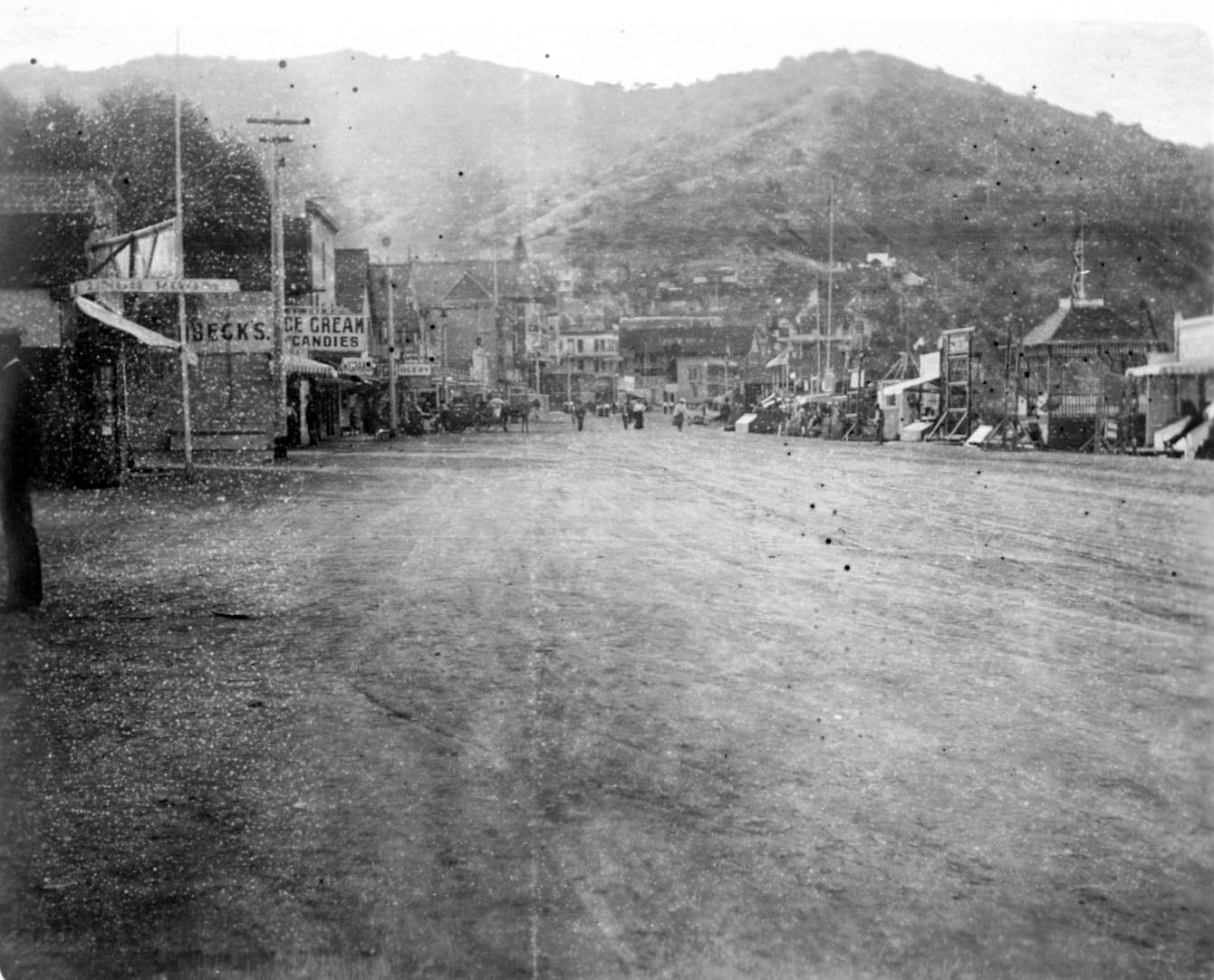 |
|
| (1903)* - View looking north down the main road of Avalon Bay (Crescent Avenue). The Metropole Hotel is at upper center-left. Store sign on the left reads: ICE CREAM & CANDIES. Jennett Family Collection - Courtesy of Gilbert C. Jennett |
Historical Notes Crescent Avenue, also known as The Strand or Front Street, is the main street curving along Avalon Bay on Catalina Island, serving as the heart of Avalon's social and commercial life. Its origins trace back to the late 19th century when George Shatto purchased the island in 1887 and laid out the first plans for the resort town of Avalon, inspired by Tennyson’s poetry. The Banning brothers, who acquired the island in 1891, further developed Avalon as a resort destination, building hotels, attractions, and the Pleasure Pier, which established Crescent Avenue as the focal point for visitors arriving by steamship. |
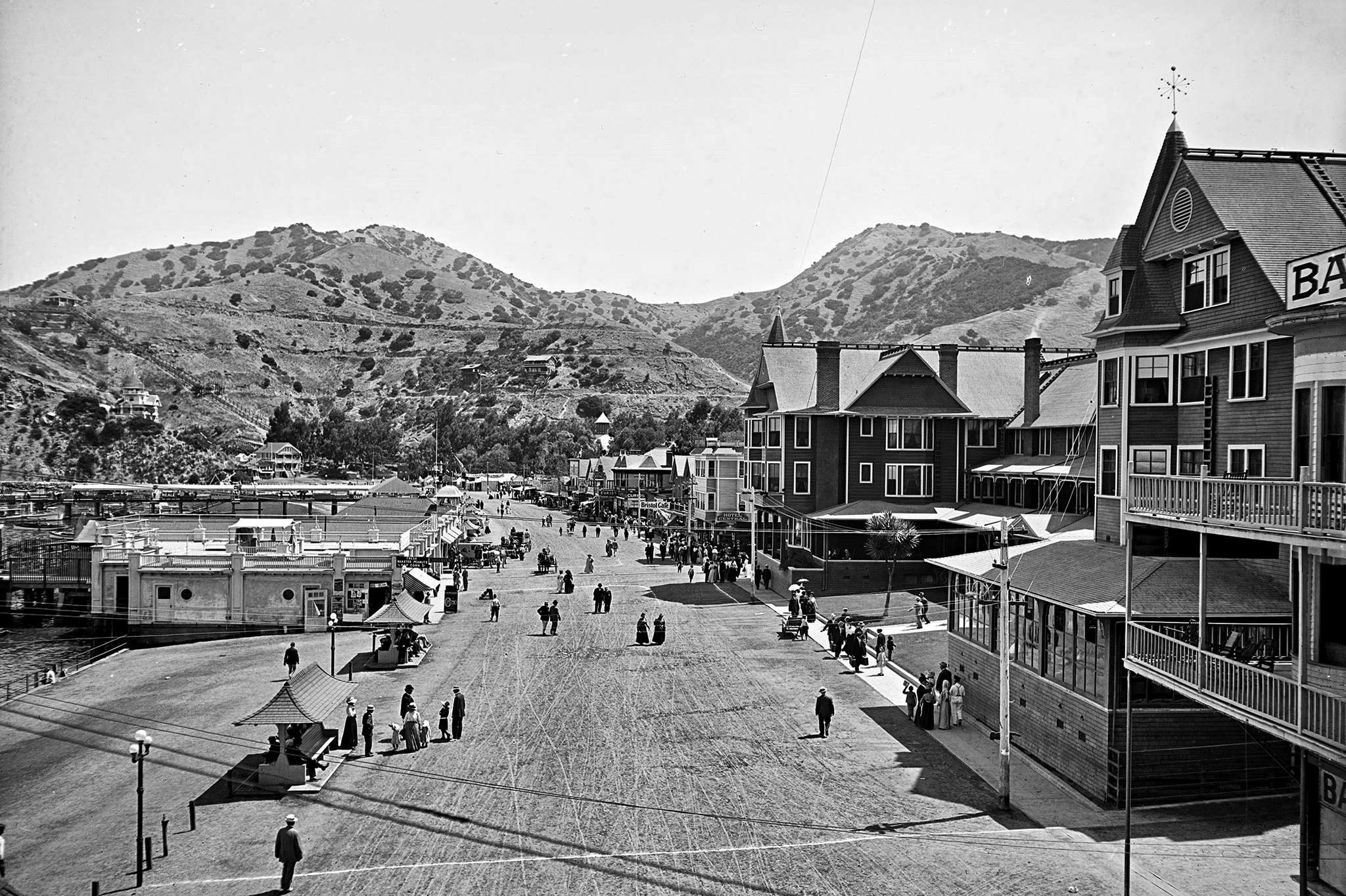 |
|
| (ca. 1905)* – View showing Crescent Avenue with the Metropole and Bay View hotels on the right. |
Historical Notes By the early 1900s, Crescent Avenue was bustling with tourists, especially during the summer months when "Tent City" sprang up nearby. The street was the focal point for visitors arriving by steamship, with the pier and waterfront hotels drawing crowds. |
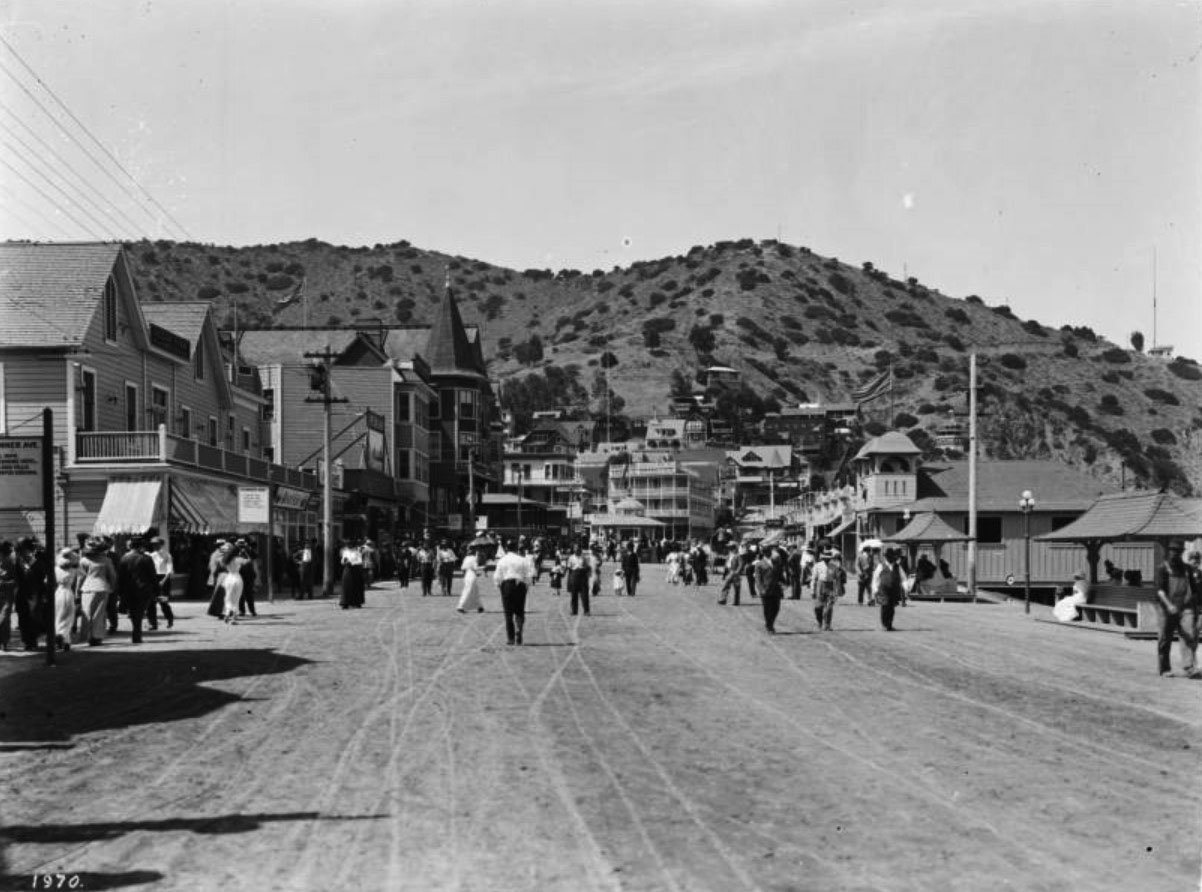 |
|
| (ca. 1905)* - Street scene looking north showing the Strand (Crescent Avenue) on Santa Catalina Island. Hundreds of pedestrians are in the street and on the sidewalk. Mostly wooden buildings line the street, including the Grand View Hotel at left. Several shaded seats are occupied by people at right. Legible signs include: "Sumner Ave., Del Mar, Glenmore Hotel, Island Villa, Campus Virginia", "Ocean View Metropole Annex no. 26", "Sumner Ave., Ocean View, Avalon Inn, Camp Albert, Golf links, Tennis courts", "McCall patterns, 10¢, 15¢", "Bristol Cafe", "Darlington", "Island Buffet, bar & restaurant", "Cigars, tobacco", "Ladies entrance", "Hotel, Bay View", "Hotel Grand View", "Billy's", "Optimo aquarium". |
Historical Notes The area that would become Crescent Avenue began its transformation in 1887 when real estate developer George Shatto purchased Catalina Island with the vision of creating a resort town. He named the new settlement Avalon, inspired by Tennyson’s poetry, and laid out the first plans for the town’s streets, including what would become Crescent Avenue. |
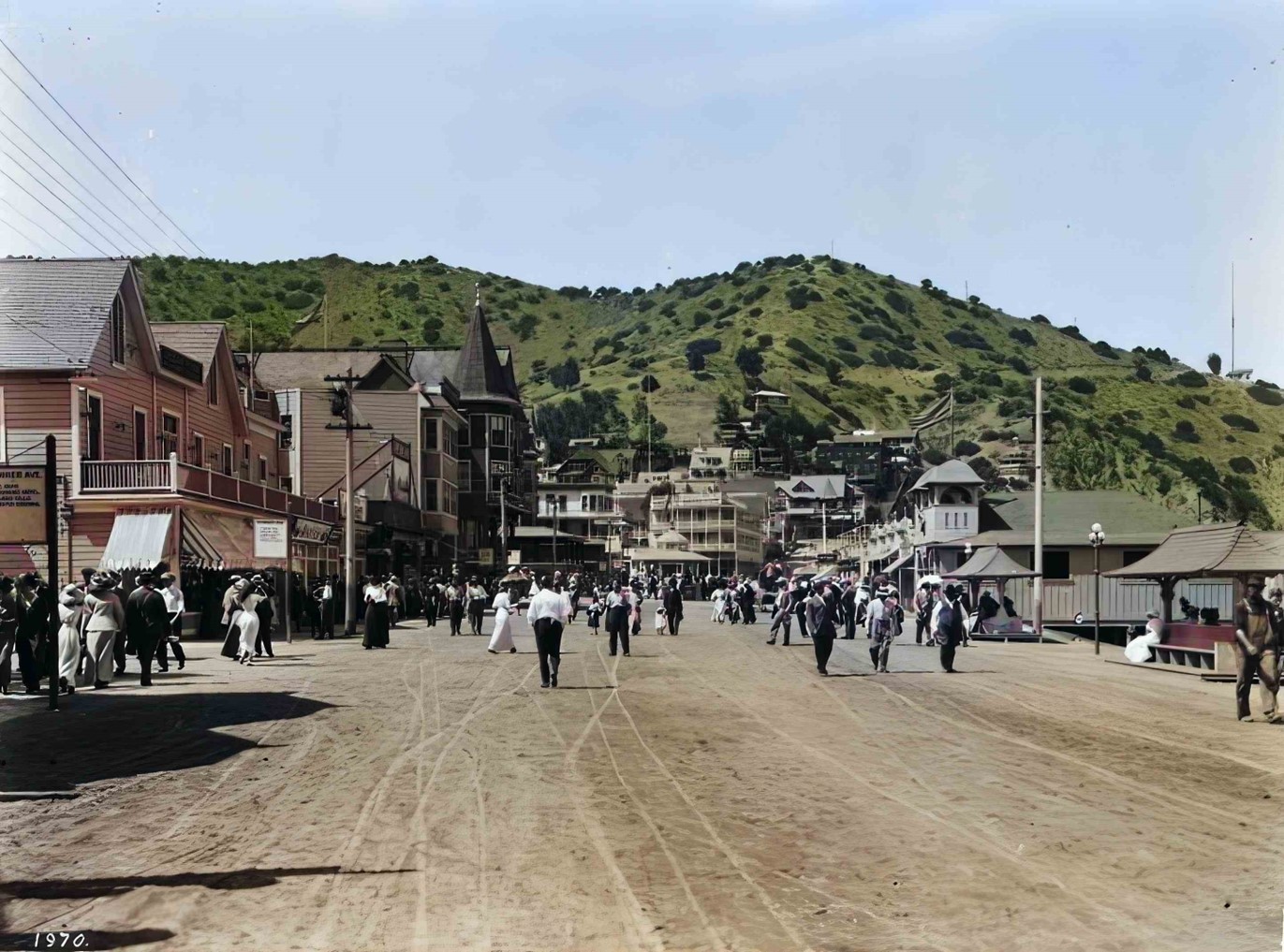 |
|
| (ca. 1905)* - View looking north down the main road of Avalon Bay (Crescent Avenue) with the Metropole Hotel seen at upper center-left. AI enhancement and colorization by Richard Holoff |
Historical Notes A devastating fire in 1915 destroyed much of Avalon, including many buildings along Crescent Avenue, forcing the Banning family to sell the island in 1919. That year, William Wrigley Jr. took control, investing heavily in infrastructure and tourism, including the construction of the iconic Catalina Casino at the avenue’s northern end. Wrigley’s efforts transformed Crescent Avenue into a vibrant promenade, attracting Hollywood stars and making Avalon a nationally recognized resort town. |
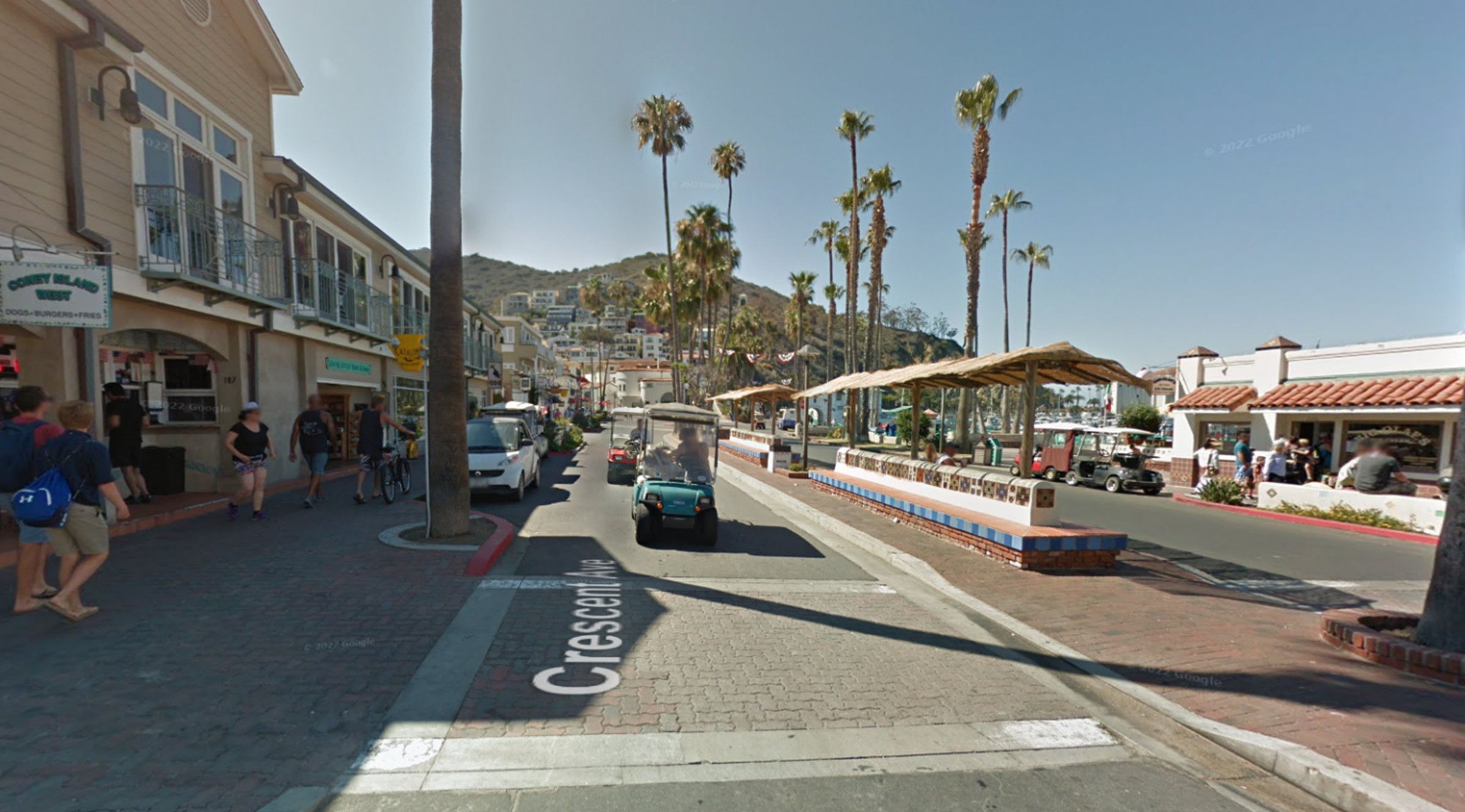 |
|
| (2016)* - Contemporary view looking north on Crescent Avenue, also known as The Strand or Front Street, along Avalon Bay on Catalina Island. |
Historical Notes Today, Crescent Avenue remains Avalon's main promenade, lined with shops, restaurants, and historic hotels, and continues to host community events and welcome tourists. Its crescent shape mirrors the bay it borders, and its enduring role as the island’s social hub reflects the layered history of Avalon, from its early resort days to its status as a cultural landmark. |
Then and Now
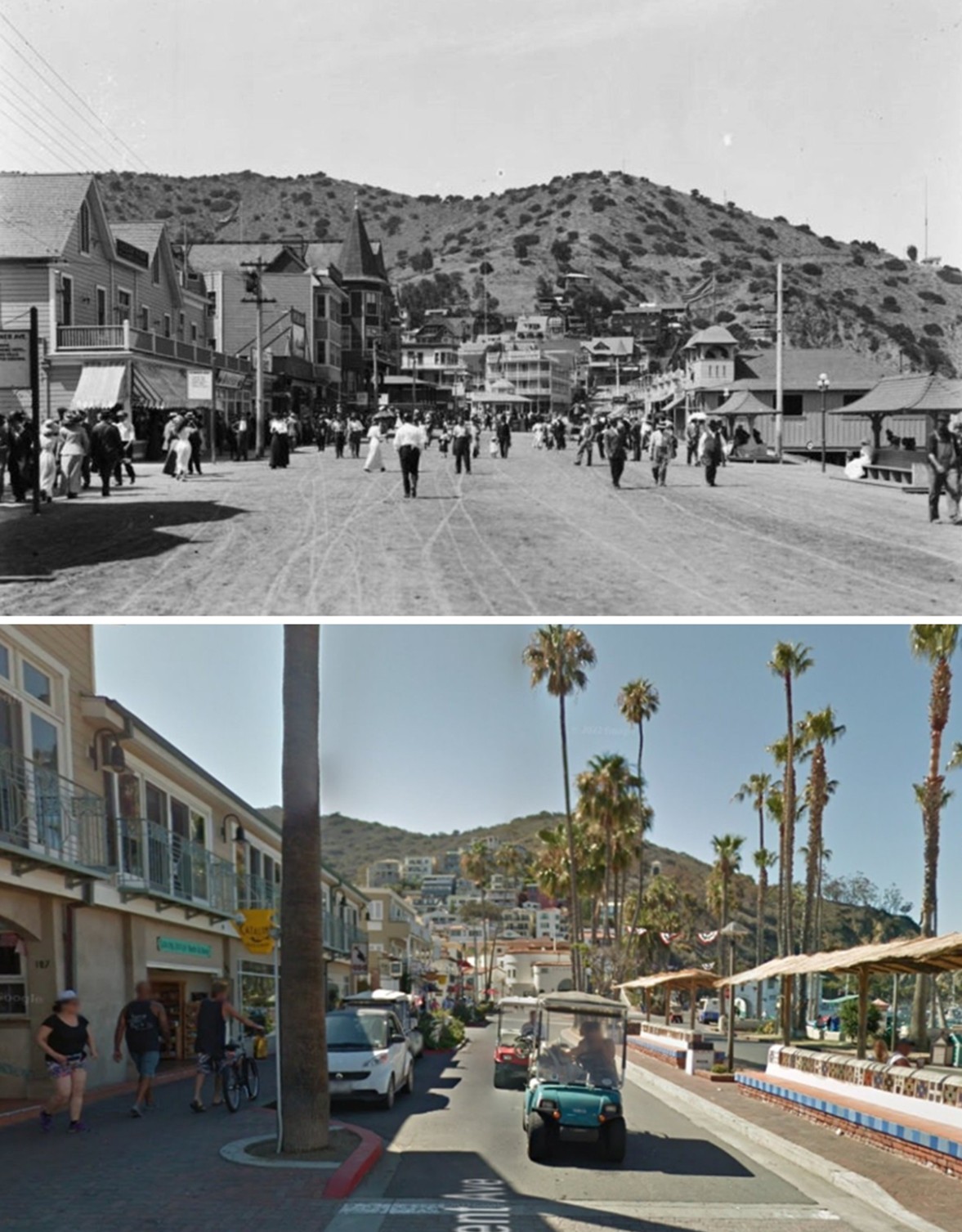 |
|
| (1905 vs 2016)* - A ‘Then and Now’ view looking north on Crescent Avenue, also known as The Strand or Front Street, along Avalon Bay on Catalina Island. Photo comparison by Jack Feldman. |
Historical Notes While officially named Crescent Avenue, the street is commonly called "The Strand" or "Front Street" by residents, reflecting its longstanding role as the main gathering place in Avalon. |
* * * * * |
Arch Rock
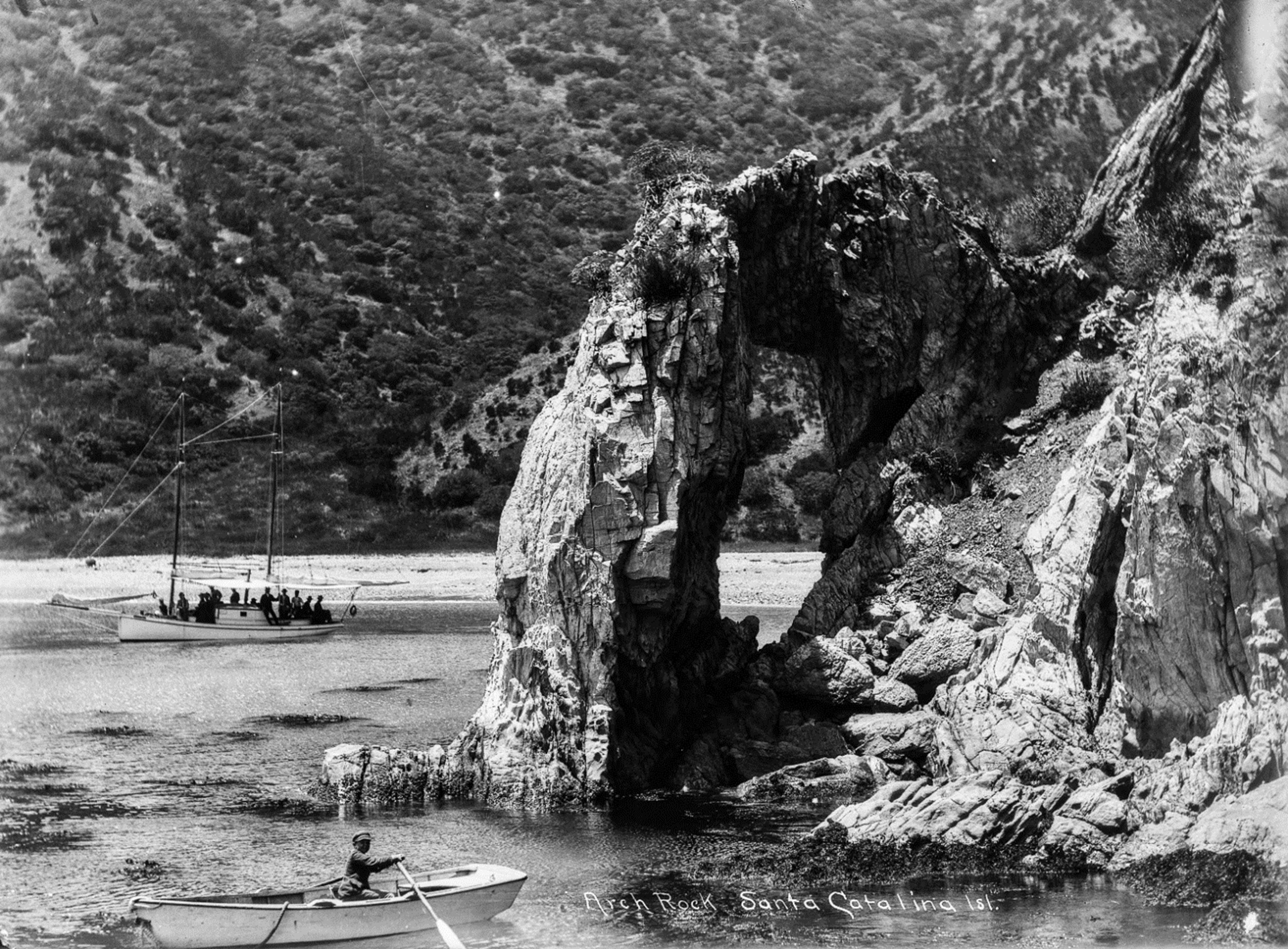 |
|
| (ca. 1905)* – A boy is seen rowing a boat next to a rock formation called Arch Rock on Santa Catalina Island, with a sailboat in the distance. Arch Rock was located 8 miles north of Avalon. Ernest Marquez Collection. |
Historical Notes Arch Rock was once a prominent natural landmark on Santa Catalina Island, located at Long Point, the widest part of the island. It was a popular attraction for tourists in the early 20th century, known for its unique formation and scenic beauty. Unfortunately, the arch collapsed sometime in the first quarter of the 20th century when the keystone fell out, leading to its eventual disappearance. |
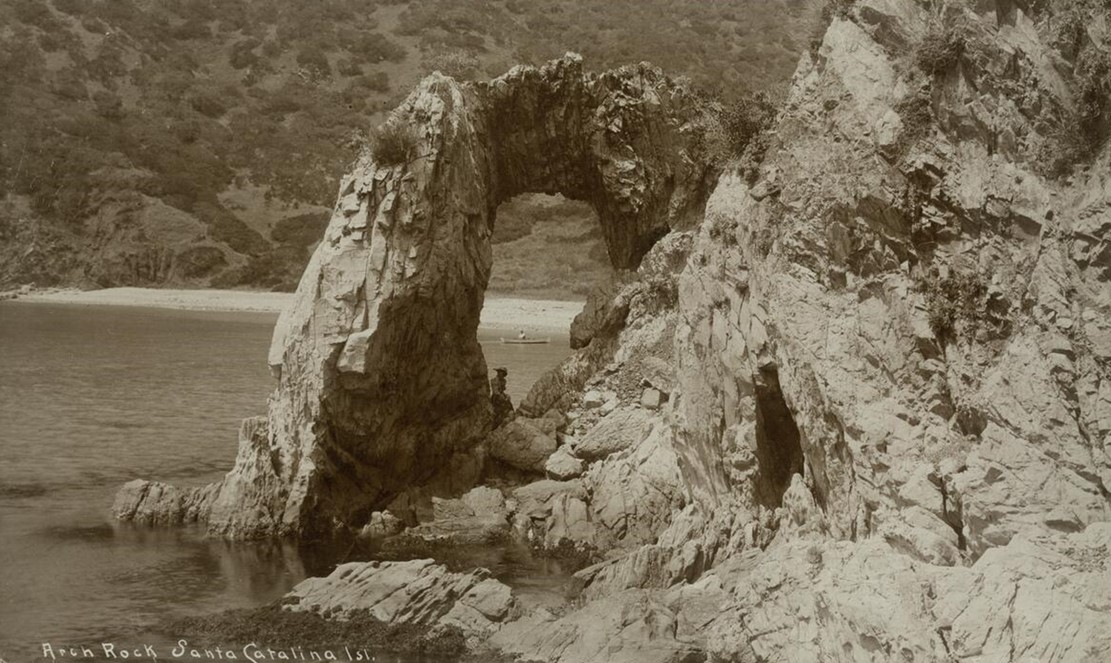 |
|
| (ca. 1906)* – A woman poses under Arch Rock on Santa Catalina Island. The arch-shaped rock formation is at the center, connecting to a large rocky hill on the right. Button-shell Beach is visible in the background, with a person in a small dinghy near the shore. Photo by C. C. Pierce. |
Historical Notes Arch Rock was broken up by vandals prior to 1910.* Another source states that the arch collapsed sometime in the first quarter of the 20th century.* |
* * * * * |
Ning-Po Smuggling Ship
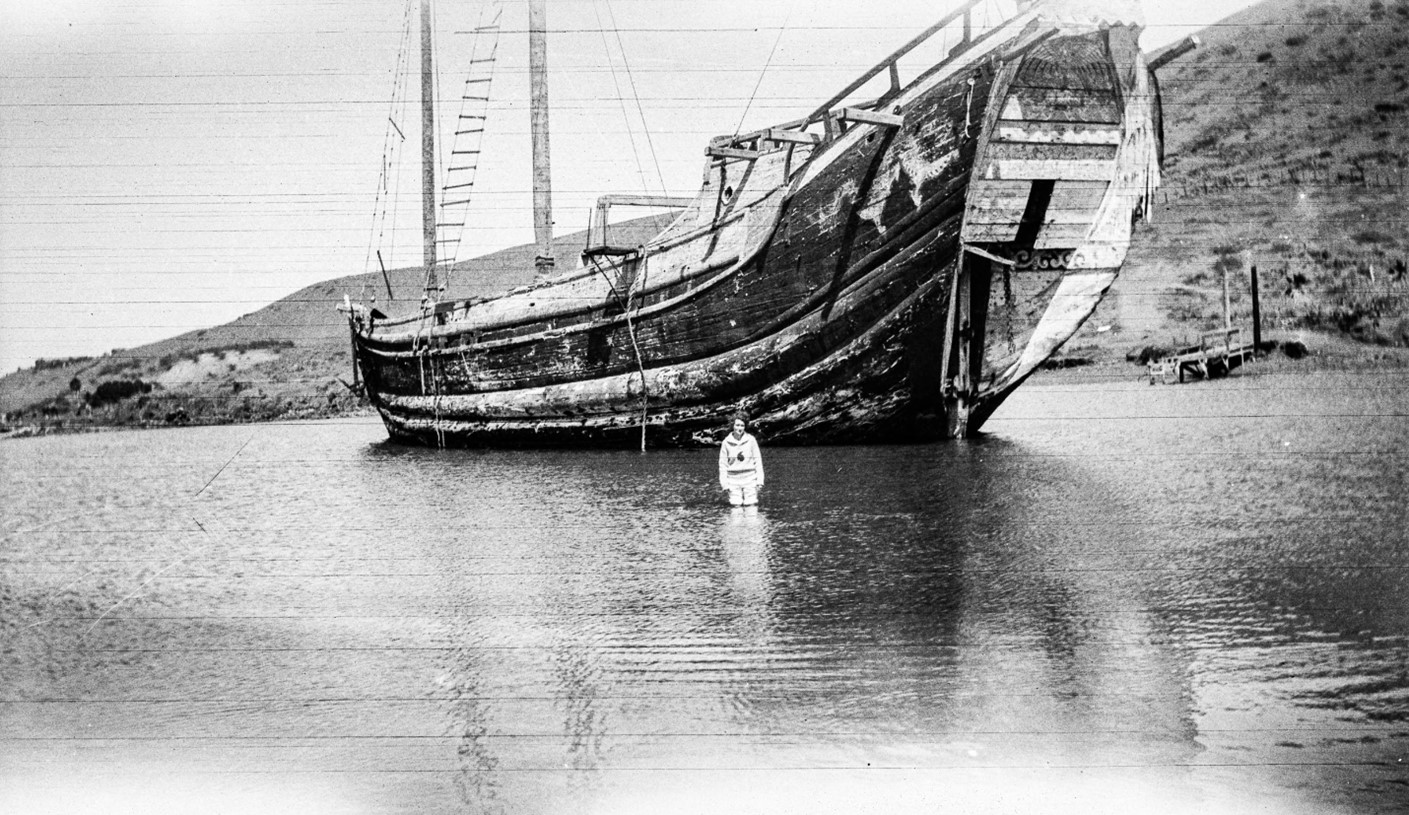 |
|
| (ca. 1917)* - Image of a woman standing in the ocean next to the "Ning-Po" smuggling ship in Catalina Harbor at the Isthmus on Catalina Island. |
Historical Notes The "Ning-Po" was a historic Chinese junk ship that gained notoriety in the early 20th century. Originally built around 1753, the ship had a long and colorful history, including being used for piracy, slave trading, and smuggling. By the early 1900s, the "Ning-Po" had become a floating museum and tourist attraction in the United States, particularly in Southern California. In 1913, the "Ning-Po" was brought to the United States and eventually found a home in Catalina Island. The ship was moored in Catalina Harbor at the Isthmus on Catalina Island, where it served as a unique attraction for visitors to the island. Tourists could explore the ship and learn about its storied past, which included tales of piracy and adventure on the high seas. |
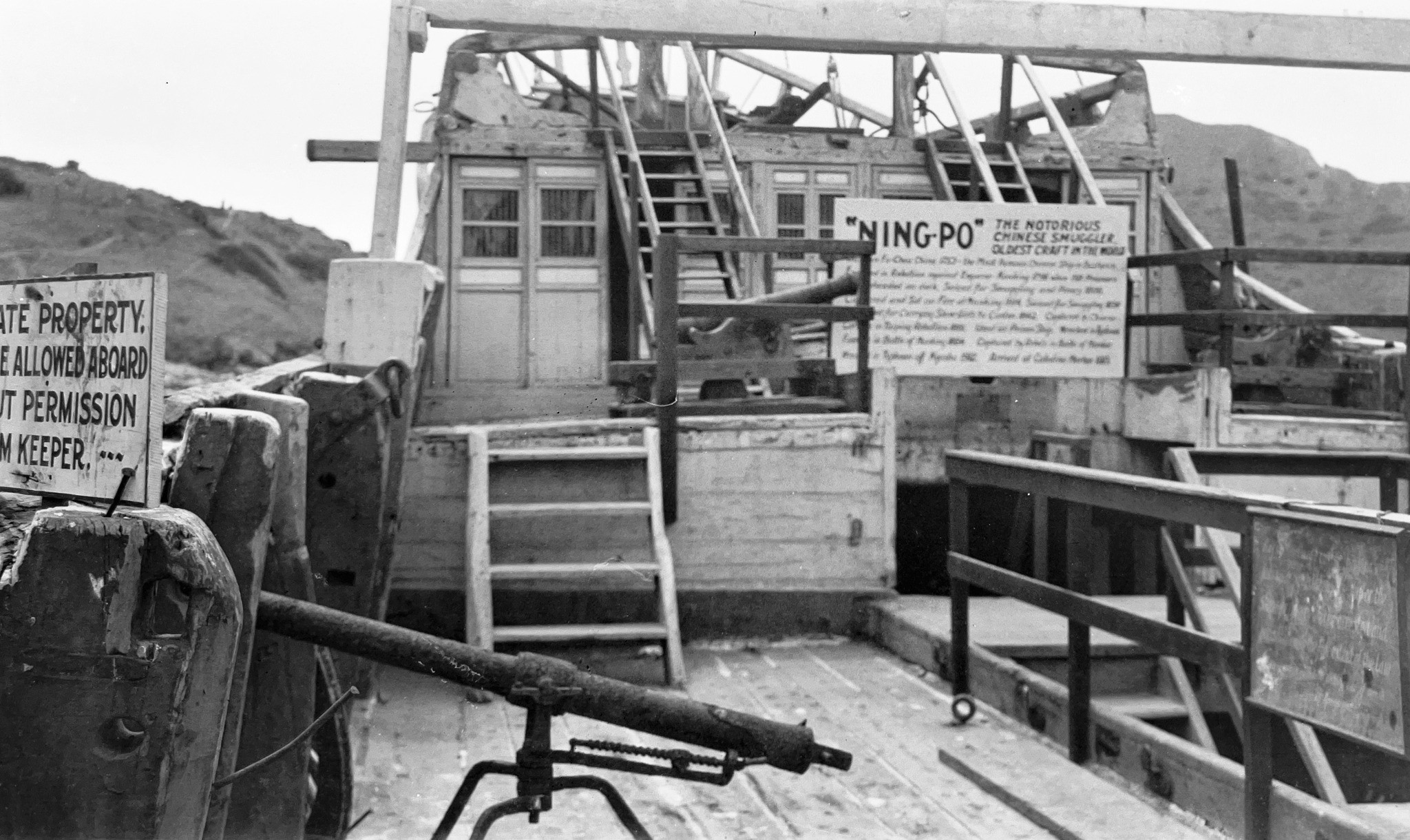 |
|
| (1920s)* - All hands on deck! – View of the deck of the ‘Ning-Po,’ which was claimed to be the oldest craft in the world at the time, according to the large sign at top center-right. Photo courtesy of Paul Ayers. |
Historical Notes The "Ning-Po" remained a fixture on Catalina Island for several years, drawing the curiosity of many who visited. However, over time, the ship fell into disrepair. |
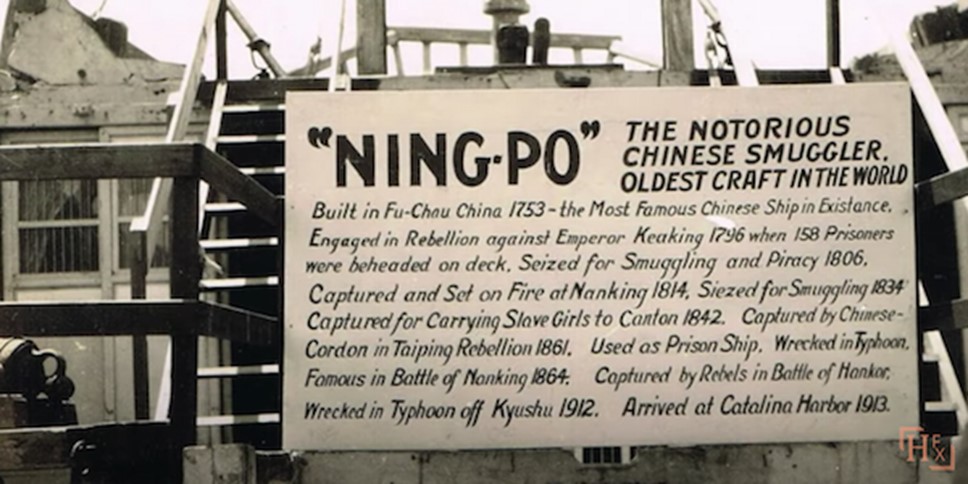 |
|
| (1920s)* - Sign on deck highlighting the vessel's historical chronology since its construction in 1753. |
Historical Notes There are two versions of how the vessel met its demise: Deterioration and Dismantling: By the 1930s, the Ning-Po had deteriorated significantly due to age and condition, leading to its eventual dismantling. Intentional Destruction for Film: According to this version, the Ning-Po was deliberately burned as part of a movie shoot. The vessel was used as a prop or set piece, and its destruction was planned for cinematic purposes. |
* * * * * |
S. S. Hermosa II
 |
|
| (1903)* - An oarsman tends his boat as the steamer S. S. Hermosa II approaches the pier. Jennett Family Collection - Courtesy of Gilbert C. Jennett |
Historical Notes In 1902, the S.S. Hermosa No. II, then considered the most palatial vessel in Southern California, was launched. To celebrate the occasion of the launching of Hermosa II, Hermosa I was brought to Avalon, anchored in Avalon Harbor, and on July 4, 1902, was made the center of a huge bonfire and fireworks display. |
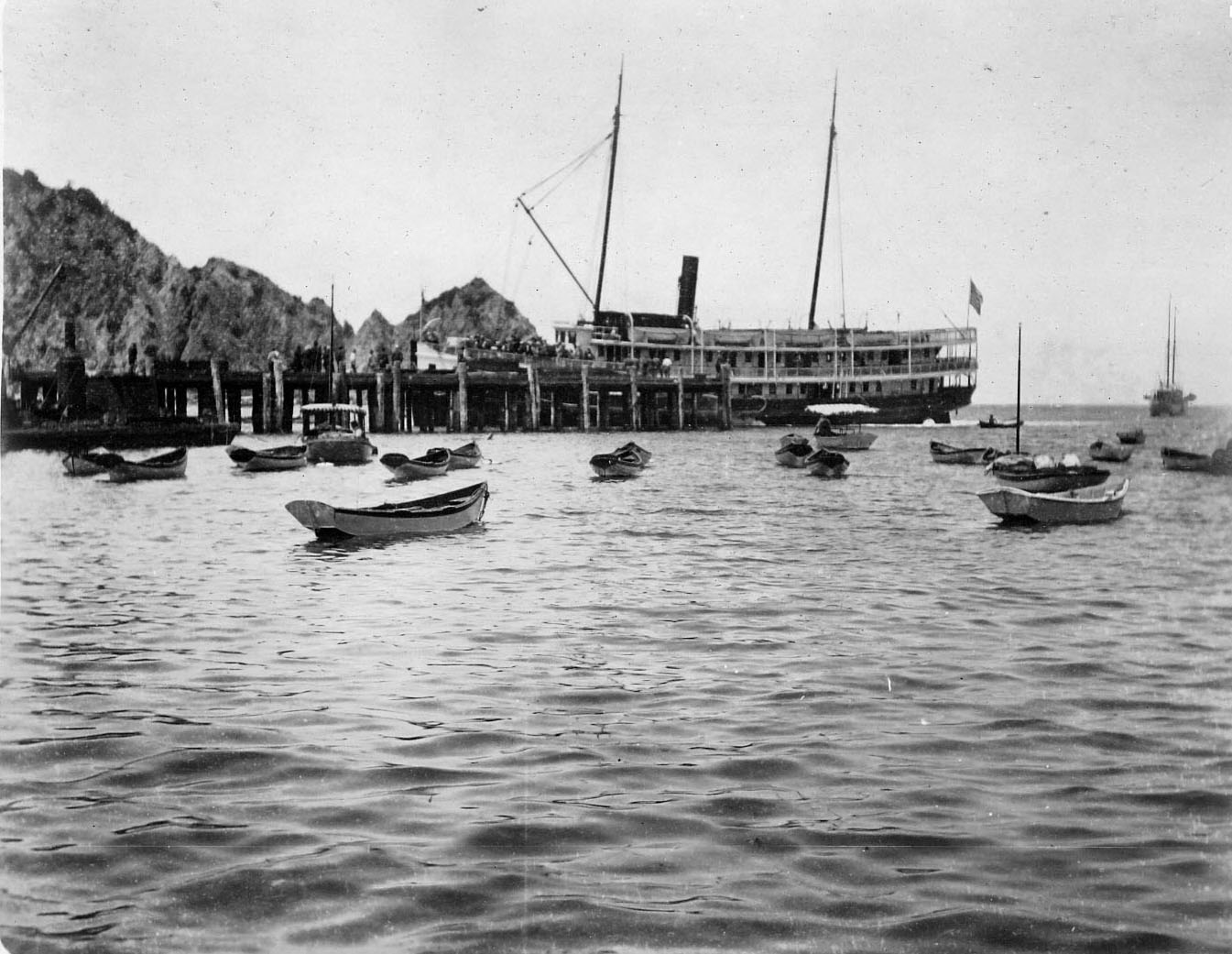 |
|
| (1903)* - Closer view showing the S. S. Hermosa II docked at the wharf with Sugarloaf Point in the background. Jennett Family Collection - Courtesy of Gilbert C. Jennett |
 |
|
| (ca. 1905)* - Close-up view of the Town of Avalon showing the Metropole Hotel and Grand View Hotel, as well as the pier and many small boats in the water, with the steamer Warrior II docked at the wharf. |
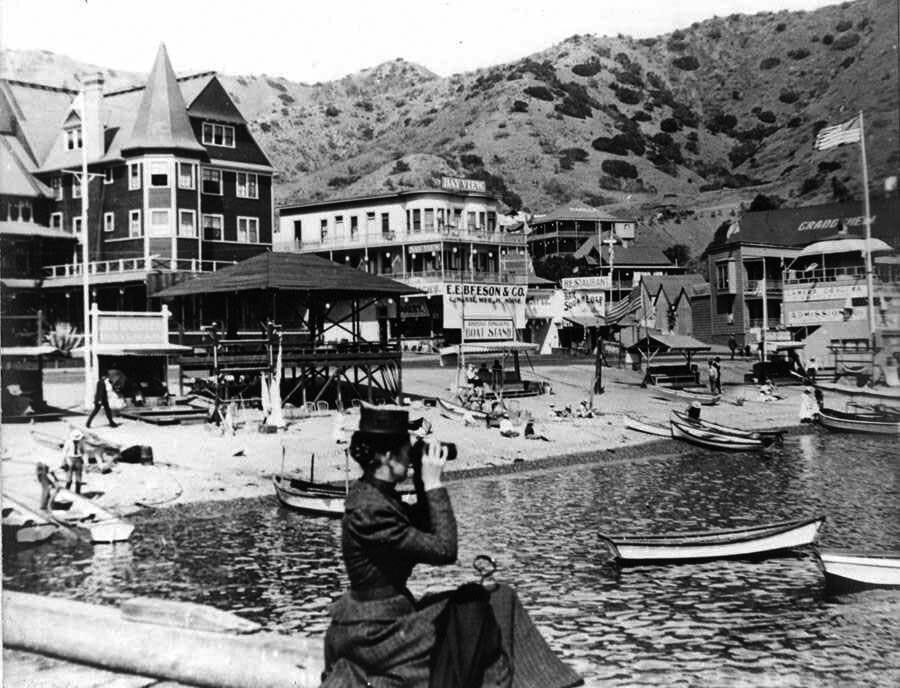 |
|
| (ca. 1902)^ – A woman sitting on the pier looks through a pair binoculars in the direction of Sugarloaf Point with the Metropole Hotel seen in the background. |
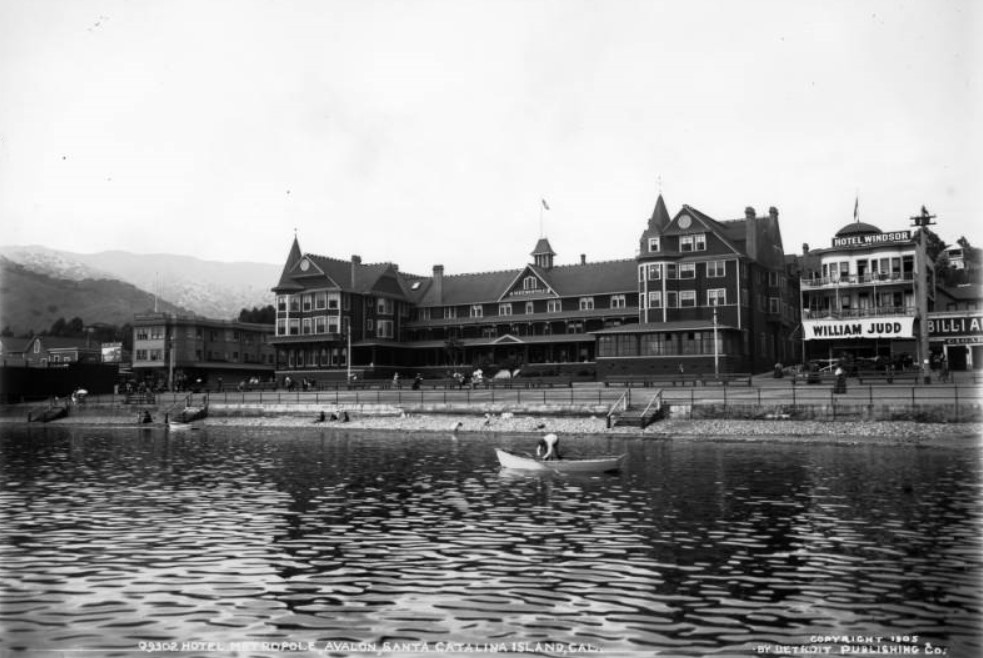 |
|
| (1905)* - People walk and sit on the beach in front of the Metropole Hotel. A man is in a rowboat on Avalon Bay. Signs read: "Metropole" "Hotel Windsor" "Hotel Central" "Island Buffet" "William Judd" "Billiards" and "Cigars." |
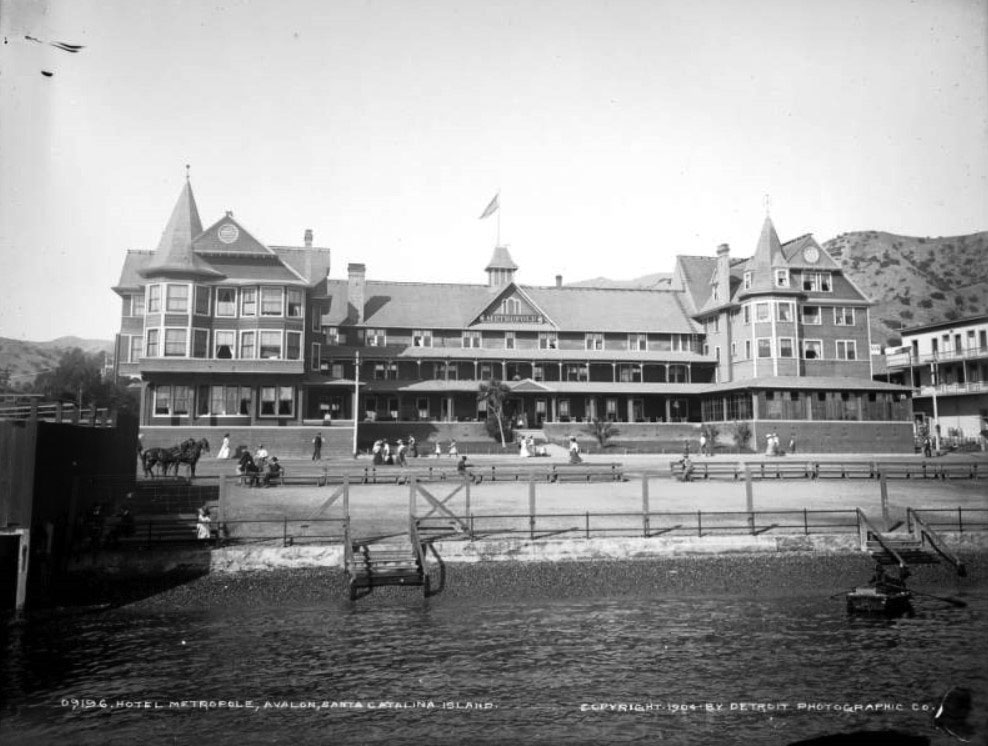 |
|
| (1904)*#* – View of the Hotel Metropole from the bay. People are seen sitting on benches while others walk on the road in front of the hotel. The Victorian structure has gables, a columned balcony, and front porch. A sign reads, "Metropole." Stairs lead down to the bay in front of the hotel. |
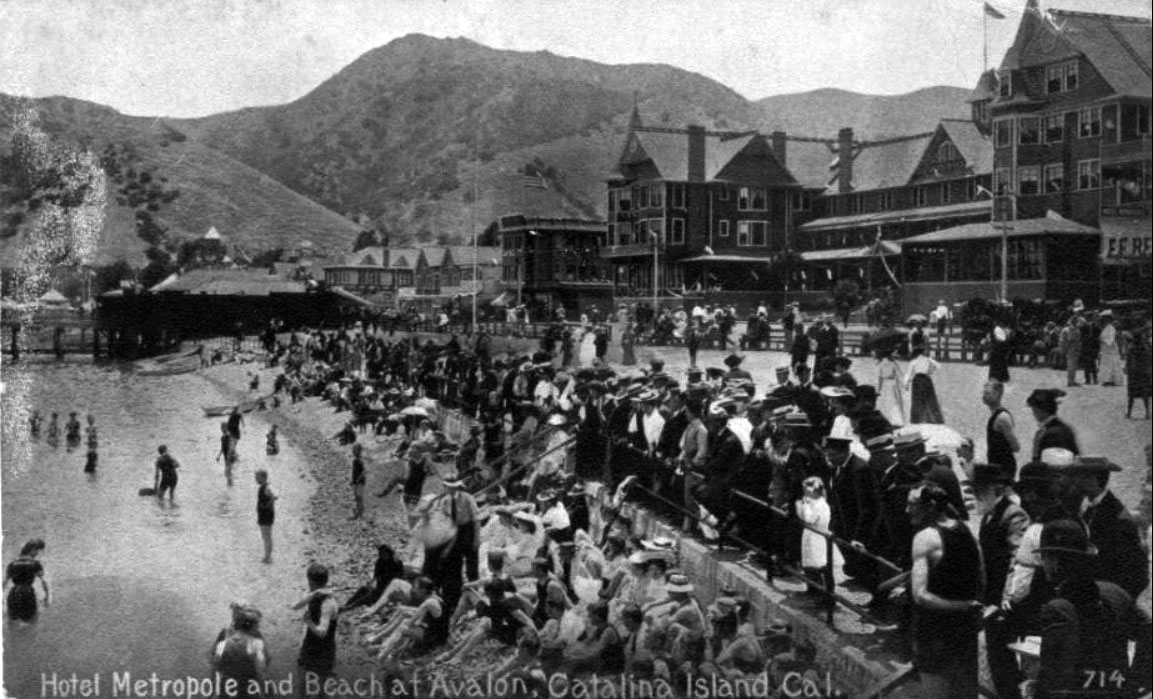 |
|
| (ca. 1907)* - View showing a large group of people looking out toward the bay at possibly some type of water event. The Hotel Metropole is seen in the background. |
* * * * * |
Arriving at Catalina
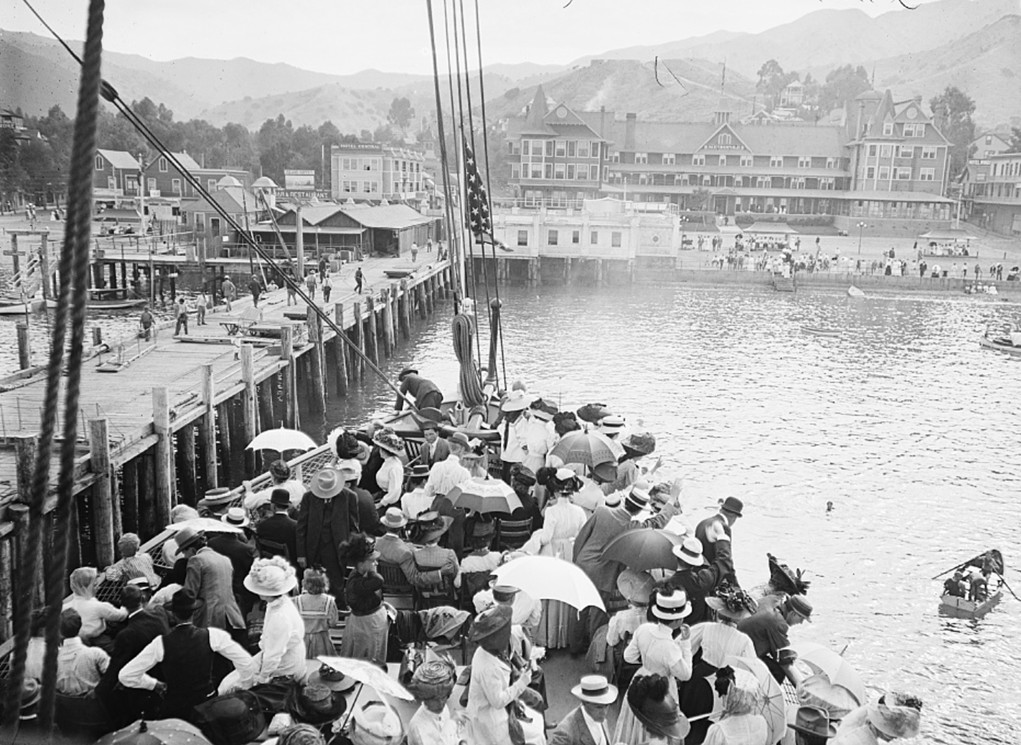 |
|
| (ca. 1904)* - Passengers arriving at pier in Avalon with the Hotel Metropole in the background. |
Historical Notes In 1904, Catalina Island was transitioning into a sought-after Southern California vacation spot, drawing thousands of visitors each summer by steamship. The journey to Avalon was an adventure in itself, with passengers enjoying sweeping ocean views and the anticipation of spotting the island's dramatic cliffs and rugged terrain as they approached by boat. Upon arrival, tourists found a rustic but lively atmosphere: Avalon was growing, with new hotels and amenities, but much of the island remained wild and undeveloped, dotted with tents and campsites along the beaches and hills. |
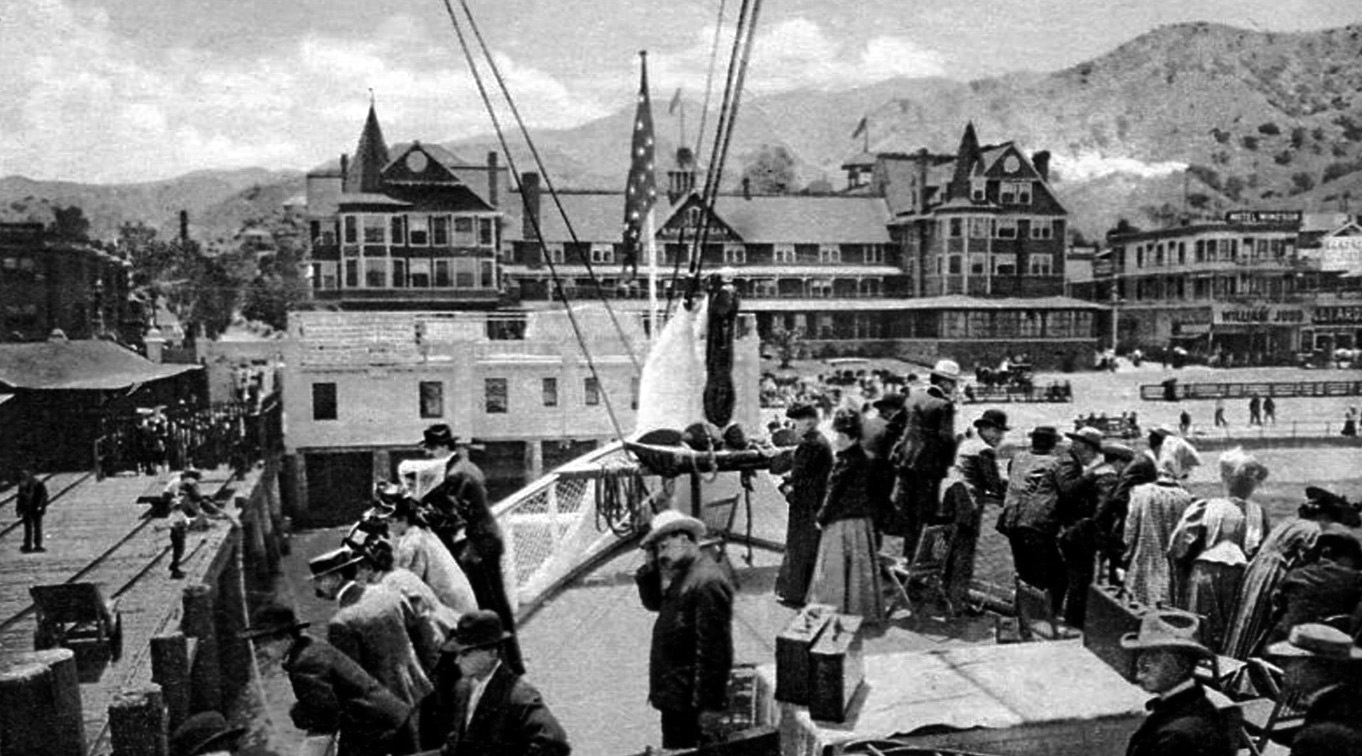 |
|
| (1904)* – Postcard view of Avalon as seen from the S.S. Cabrillo, which began transporting visitors from San Pedro to Catalina Island in 1904. Ahead is the Hotel Metropole, which was destroyed by fire in 1915. |
Historical Notes Visitors spent their days fishing for abundant barracuda and yellowtail, hiking the mountainous interior, and taking stagecoach tours for panoramic vistas of the island. The island teemed with wildlife, including sheep, wild goats, and quail, and the natural beauty was a major part of the appeal. Social life centered around the beach and the growing number of hotels, but the experience retained a sense of adventure and discovery, as Catalina balanced its rugged past with its emerging identity as a fashionable resort destination. |
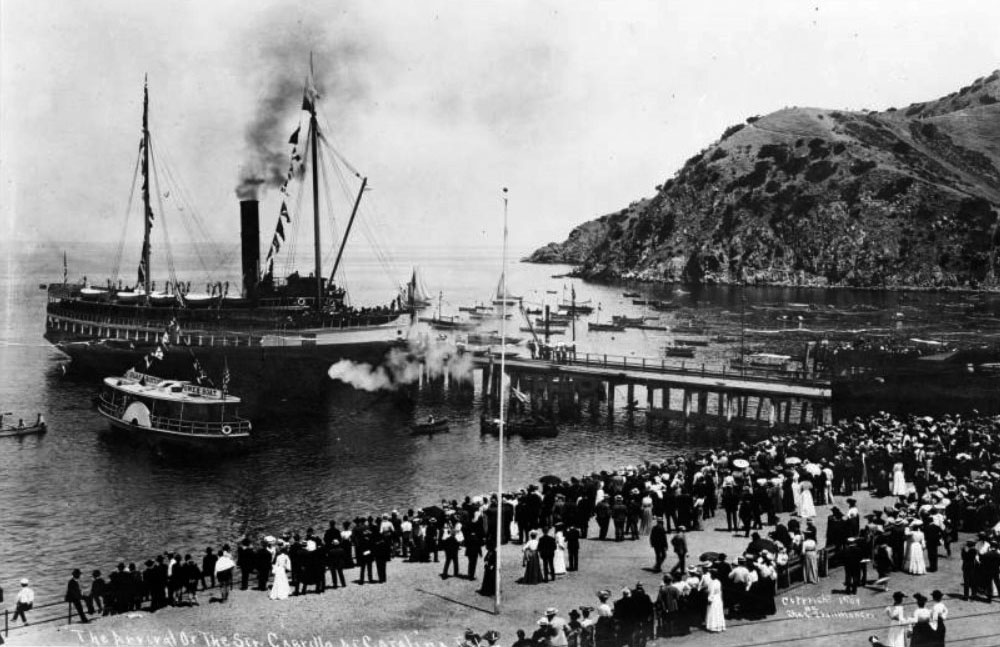 |
|
| (1904)* – A crowd of people gathers on Avalon Beach to welcome the steamship S.S. Cabrillo on its maiden voyage from the Port of Los Angeles. The steamboat is belching smoke from a large smokestack at center, and two large masts display an array of signal flags. In addition, there is a small glass bottom side wheeler boat in the foreground at left. |
Historical Notes The S.S. Cabrillo, built at the Banning Company's shipyards at Port Los Angeles, was launched in 1904. Other vessels operated by the Banning Company were the gasoline screw Cricket, the gasoline screw Catalina, and the steam yacht Companero. |
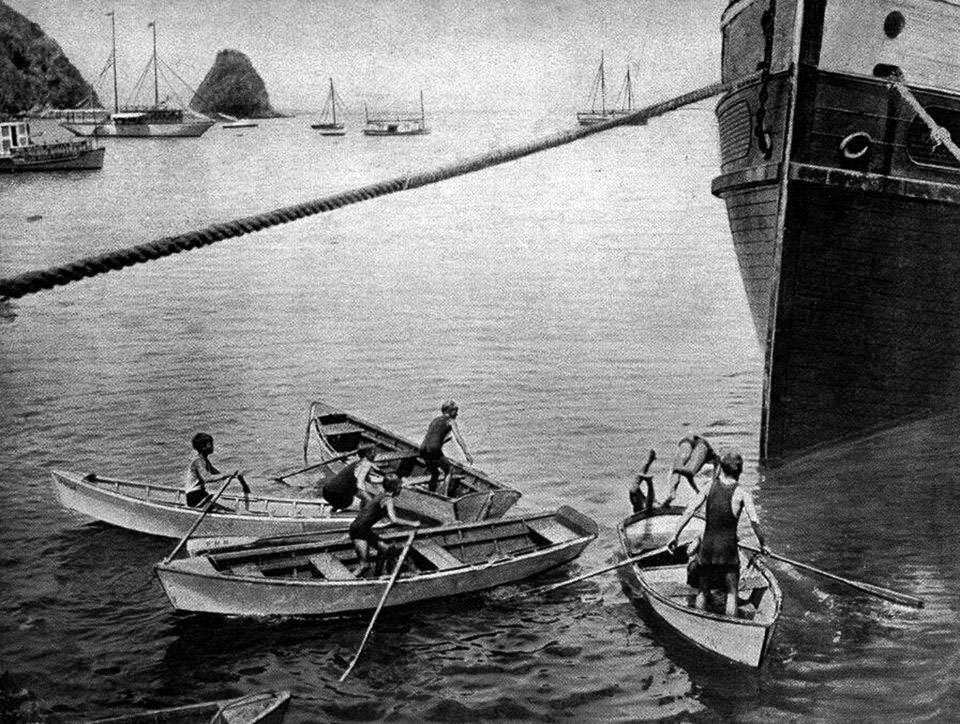 |
|
| (ca. 1909)* - Postcard view showing boys diving off row boats for coins alongside a docked steamship with Sugarloaf in the background. |
Historical Notes Diving for pennies was a popular tradition in Avalon, Catalina Island, from the 1890s through the 1960s. Local children would swim out to arriving steamships and entertain passengers by diving for coins tossed into the water, a spectacle that became a memorable part of the island’s tourism culture. The practice showcased the children’s swimming skills and delighted visitors, but it gradually faded away in the latter half of the 20th century and is no longer seen today. While the coin diving tradition has ended, Catalina Island remains a destination for recreational diving and snorkeling, and visitors can still find elongated penny machines as a nod to the island’s history. |
* * * * * |
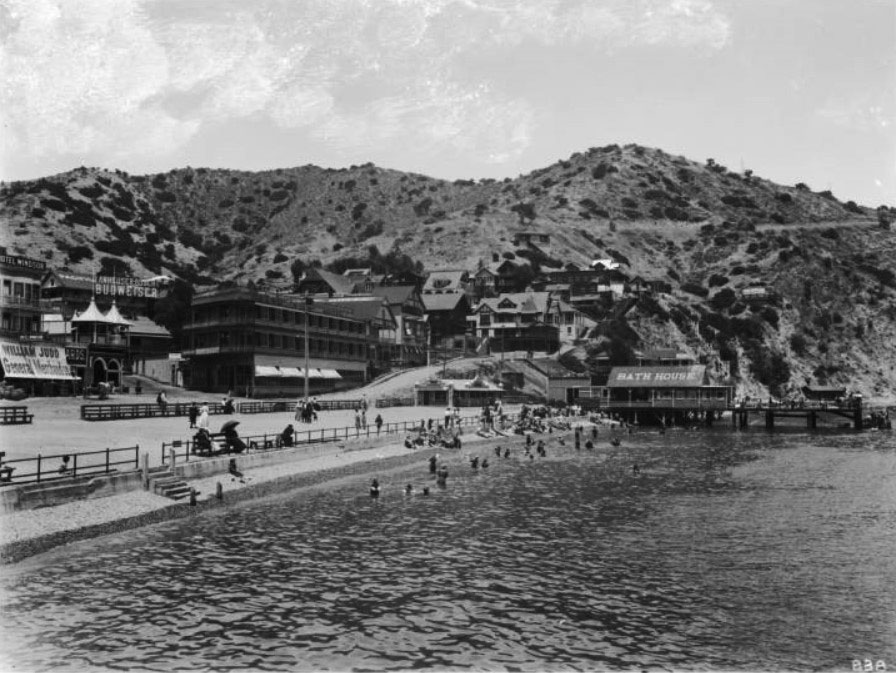 |
|
| (ca. 1908)* - View showing sunbathers and swimmers on the beach near the Bath House as seen from the pier in front of the Hotel Metropole. Also seen in the background are the Hotel Windsor, the Grand View Hotel, and William Judd General Merchandise. |
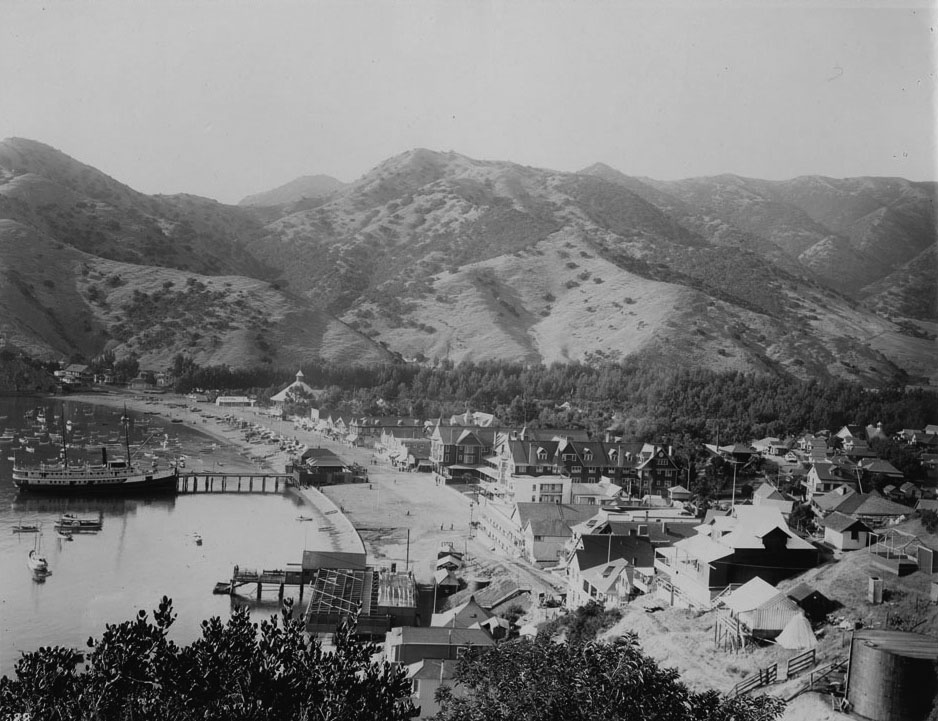 |
|
| (1908)^^ - View showing Avalon Harbor with a large ship (S. S. Cabrillo) is docked at a wooden pier at left, while many small sailing vessels can be seen moored near the shore. The city of Avalon is at right and is composed of many small wooden buildings. A dense forest can be seen at the base of a steep hill in the background. |
 |
|
| (1904)*#* - Panoramic view of the harbor at Avalon. There are dozens of unoccupied small boats in the harbor, as well as three small boats with their sails up. There are two tall sailing ships in the harbor, neither of which has their sails up. Avalon stretches back from the shore, with mostly larger buildings closer to the harbor, and smaller residences farther away. Much of the area is wooded, and there are high hills on the far side of Avalon sloping down until they meet the ocean at “Sugarloaf Point”. |
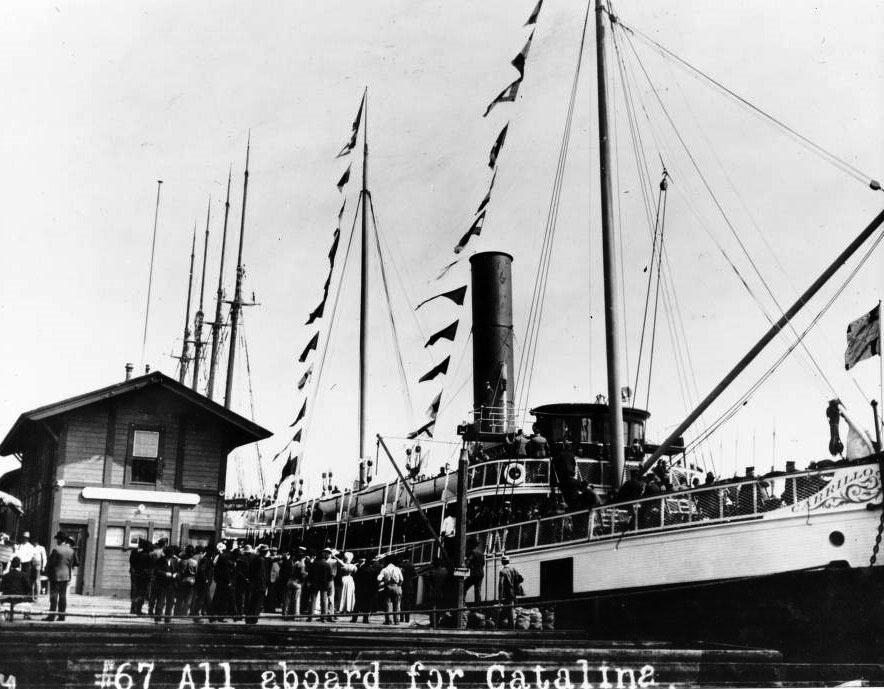 |
|
| (1907)^^ - View of Shriners boarding the S.S. Cabrillo steamboat ferry to Santa Catalina Island at the LA Harbor. |
 |
|
| (ca. 1905)^^ - Birdseye view of Avalon Harbor, showing the steamer Hermosa II at the dock. The harbor is at left, and in addition to the large steam ship, many small sailing vessels are visible. The city of Avalon is at right and the large Hotel Metropole is seen, surrounded by smaller buildings. A dense forest can be seen behind the city. |
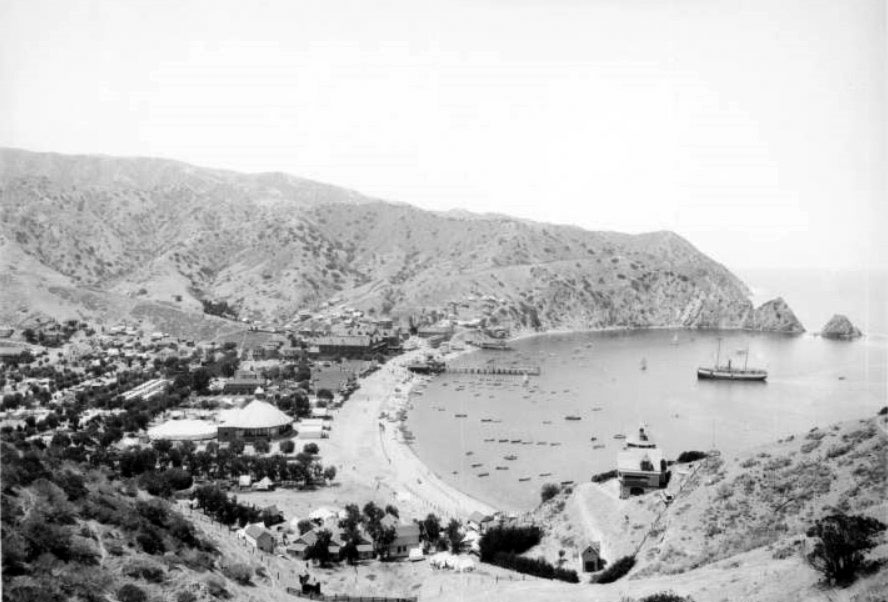 |
|
| (1905)^^ - Panoramic view of Avalon Bay as seen from the hillside. The steamer "Hermosa" is approaching the pier. Close to the pier can be seen the Hotel Metropole. Beyond the pier is the Avalon Bath House and rounding the bay you get to Sugarloaf Point. |
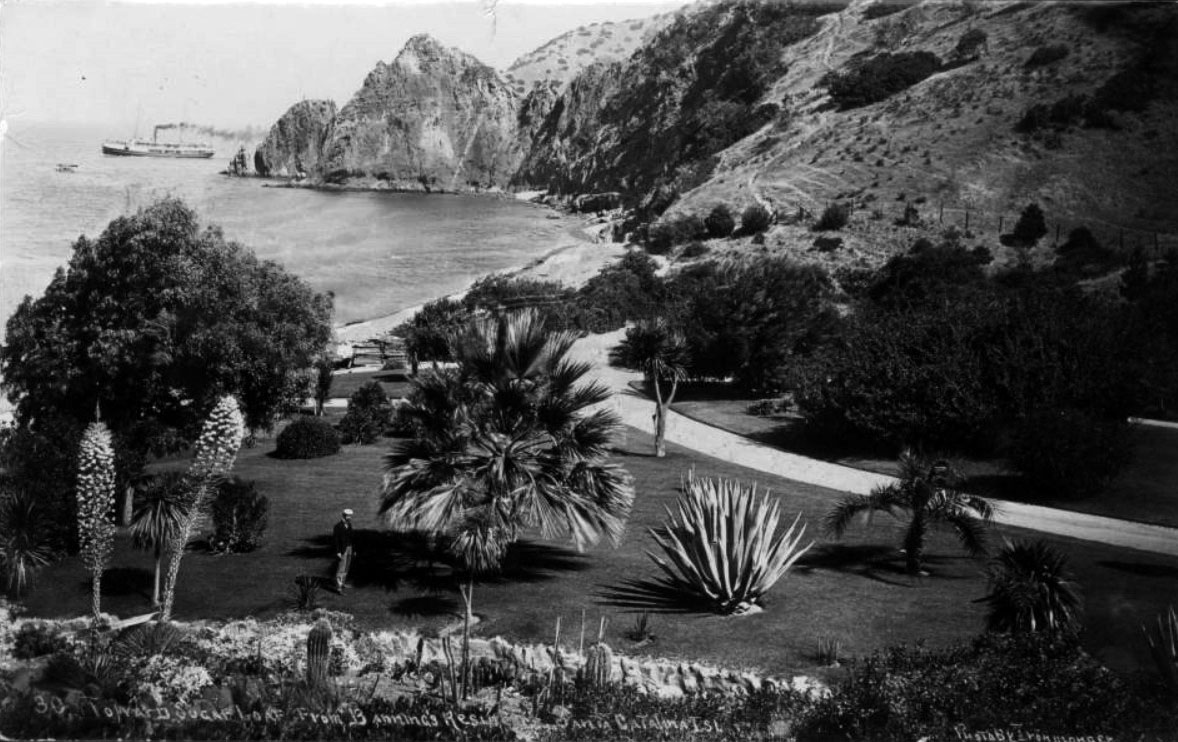 |
|
| (ca. 1906)^^ - View of Sugarloaf from the other side of the Point as seen from the garden in front of the Banning residence. A man is standing in the neatly landscaped garden while a steam ship can be seen rounding Sugarloaf Point in the background. |
Historical Notes The residence, El Descanso, was for a few years the residence of the J. B. Banning family. From about 1898 it was the residence of Hancock Banning until the St. Catherine Hotel was built about 1917 after the Avalon fire of November 1915. |
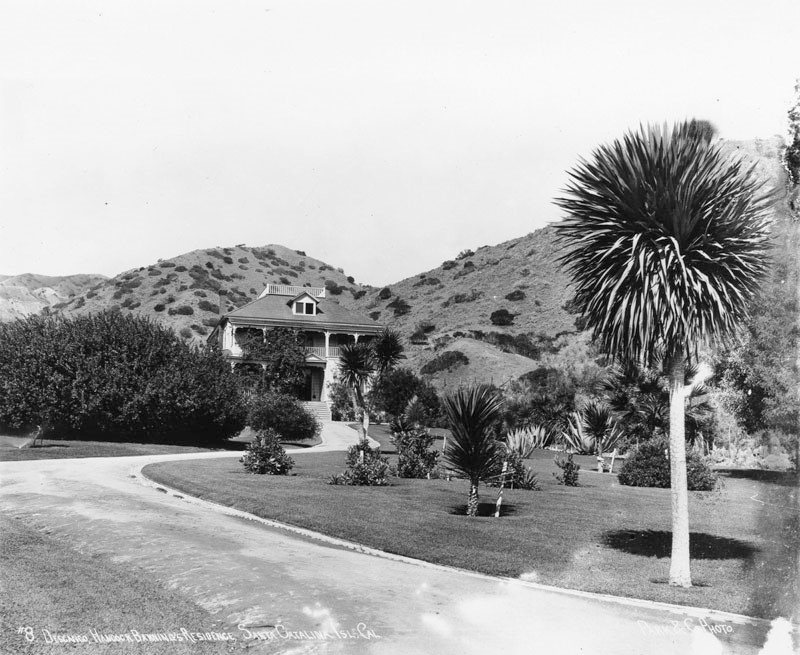 |
|
| (ca. 1906)* - View of Hancock Banning's beautiful two-story home, known as "Descanso", resting on grassy land, nestled next to the Avalon mountain range. The sprawling residence boasts of numerous windows, a wrap-around second floor balcony, and lush landscape. |
Historical Notes In 1917, the beautiful Hotel St. Chaterine would be built at the above location, exactly where the Hancock Banning residence stood. |
 |
|
| (1903)* - View showing two women and a man standing on the lawn of the Banning residence. The woman on the left is Leontine Jennet and her husband, G.P. Jennet, is on the right. Woman in the middle is unidentified. Jennett Family Collection - Courtesy of Gilbert C. Jennett |
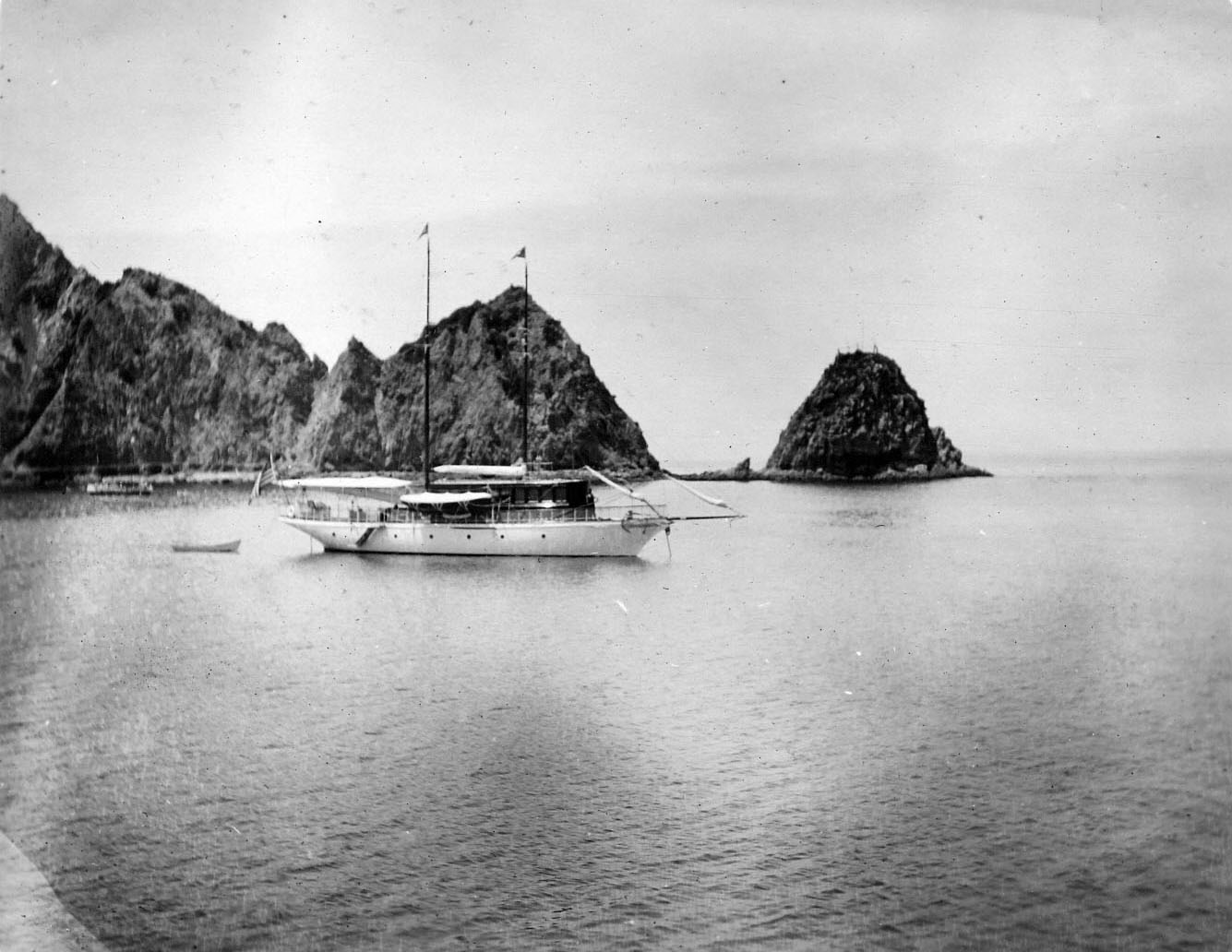 |
|
| (1903)*# - View showing a large two-mast schooner docked near Sugarloaf Point. |
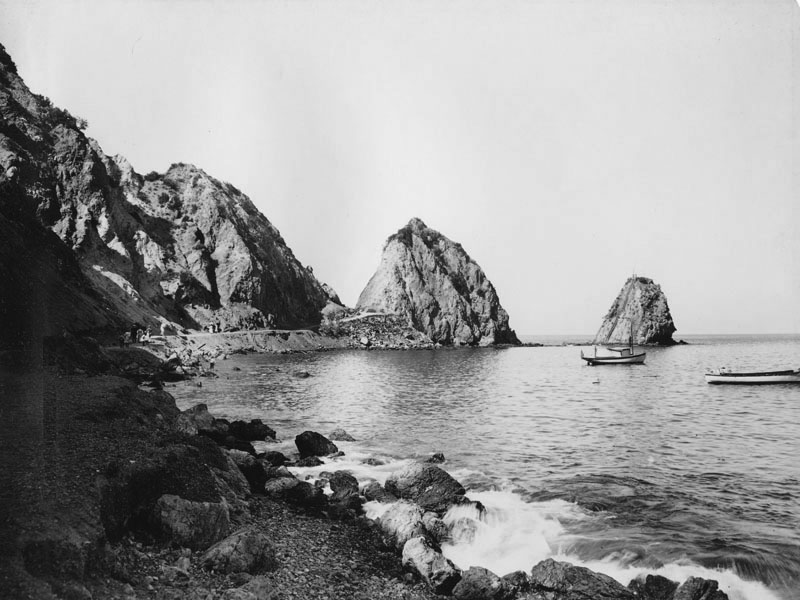 |
|
| (1908)^*# - Smaller boats docked near Sugarloaf Point in Avalon Bay. Several people can be seen on the Point's access road. |
Historical Notes Note how much "Big Sugarloaf" is now more pronounced when compared to previous photos. It was chiseled away to make room for an access road that rounds the Point. |
 |
|
| (ca. 1911)** - Panoramic view of Avalon Bay from near Sugarloaf Point. The access road that rounds the Point can clearly be seen. |
Avalon Bowl
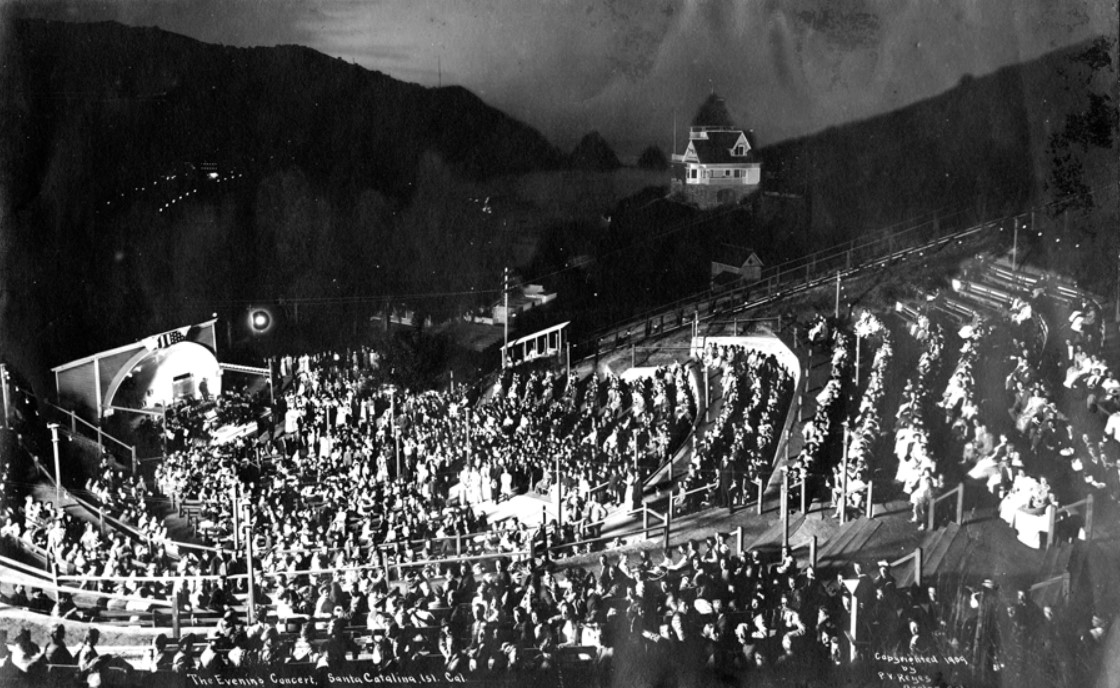 |
|
| (ca. 1905)#^* – View showing a band concert performance at Avalon’s new amphiteater, Avalon Bowl. Holly Hill House is perched on the hillside in the background and Sugarloaf Point is seen in the distance. |
Historical Notes Catalina’s growth in tourism called for new entertainment venues. In 1904, a large outdoor amphitheater, often referred to as the Avalon Bowl, was constructed on the south end of Avalon that could seat several hundred people. #^* |
 |
|
| (1909)** - Los Angeles Herald Advertisement dated June 22, 1909 - Daily service to Santa Catalina Island. BANNING LINE -- S.S. Cabrillo. Island Villa and Canvas City, now open for business. |
Historical Notes To induce tourists to visit Catalina on their steamboats, the Banning brothers would offer “Free Camp Grounds, with Water” as well as showcase the performance of Porter’s Catalina Island Band at the Avalon Bowl.** |
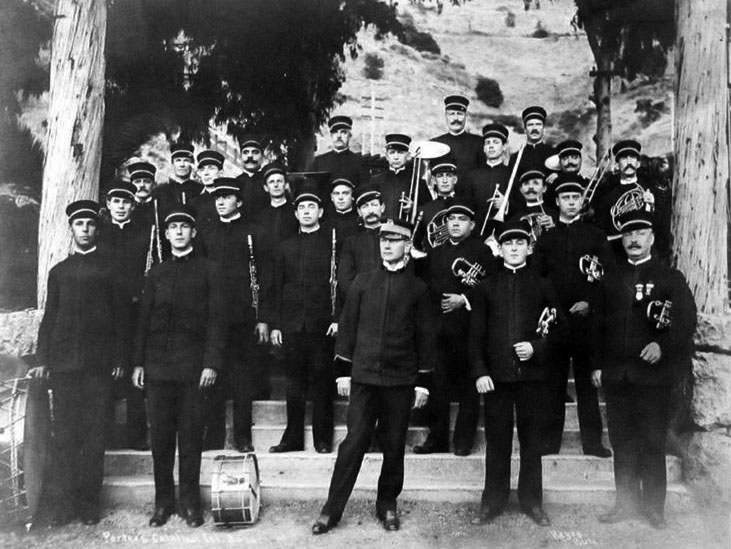 |
|
| (ca. 1909)^#* – View of Charles H. Porter’s Catalina Band who would perform at the “Avalon Bowl”. |
Historical Notes Charles Porter was the manager, who often read a poem or told a joke during summer concert nights (don't know that he was actually part of the band). The band's conductor for many years was George Mulford.^#* |
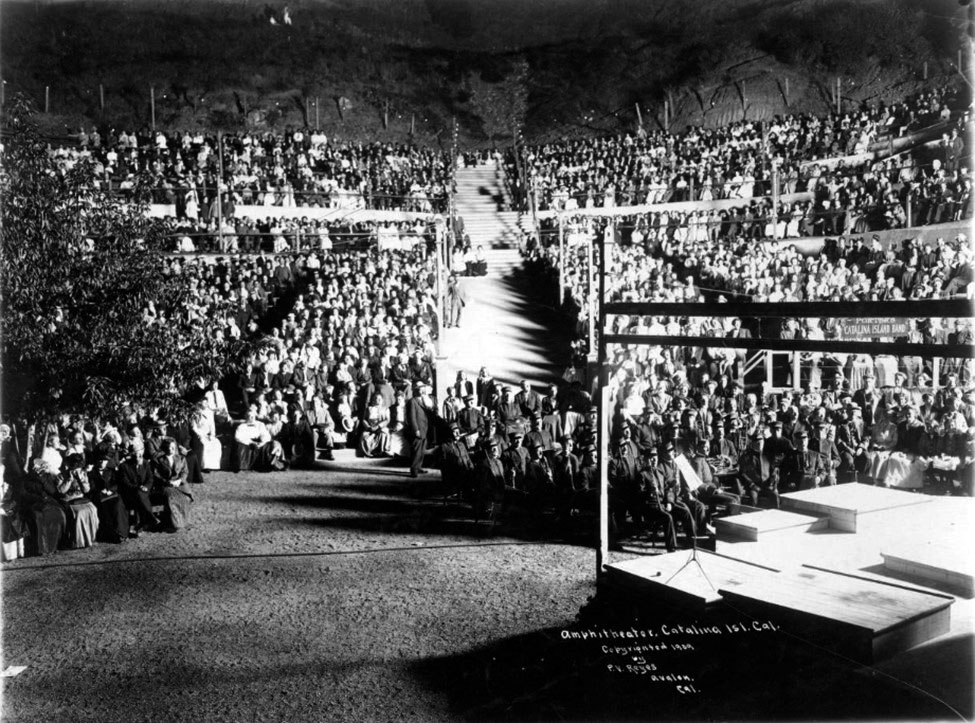 |
|
| (1909)^^ - Photograph of Porter's Catalina Island Band posing with the audience at the amphitheatre in Avalon. The band is seated in chairs in the foreground at right, near the base of the stage. Behind them, the amphitheatre can be seen on the side of a hill. Hundreds of people are seated on long benches. Above the top row of seats, the bare hillside is visible. |
Santa Catalina Incline Railway (aka Island Mountain Railway)
 |
|
| (1905)* – Looking across Avalon Harbor toward Holly Hill House. A furnicular can be seen to the right and above the Holly Hill House. It was called the Santa Catalina Island Incline Railway (built in 1905). |
Historical Notes In 1905, funicular travel arrived in Catalina with the opening of the Santa Catalina Island Incline Railway. The incline railway was the latest tourist attraction along the shores of Avalon Bay. |
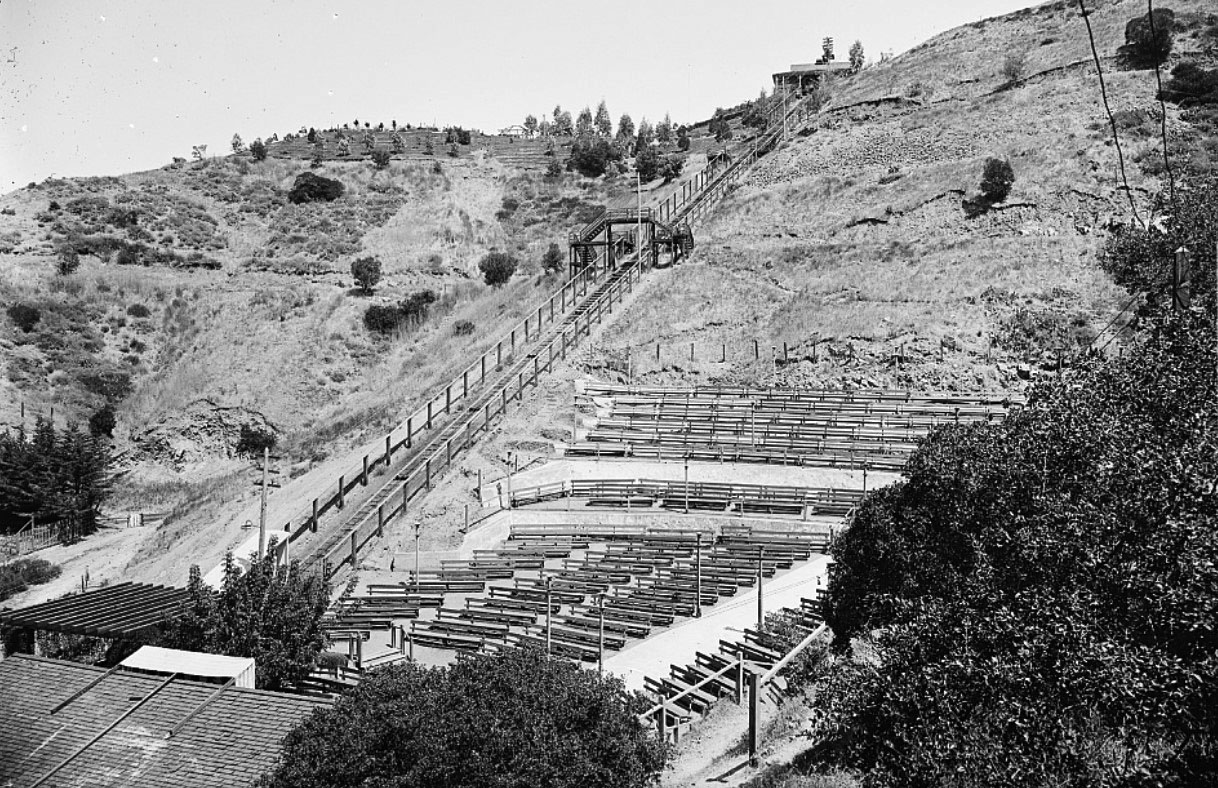 |
|
| (ca. 1905)** – View looking up the hill from behind the Avalon Bowl showing the Santa Catalina Incline Railway on the left. |
Historical Notes The Santa Catalina Incline Railway consisted of two separate funiculars. One began at the base of the now-abandoned Avalon Amphitheater and ascended the hill on the southwestern side of Avalon Bay to a point known as Buena Vista Point. The other descended the opposite side of the hill to Pebbly Beach on Lovers Cove. Passengers could disembark at the summit for refreshments in a small tea house or continue on to Lovers Cove for a ride in a glass-bottomed boat.**# |
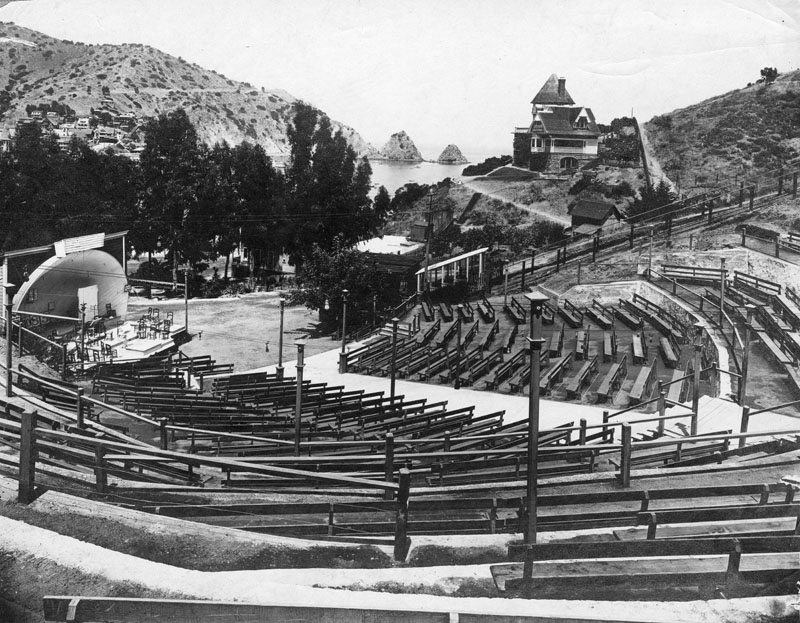 |
|
| (ca 1910)* - View of the Avalon Amphitheater on Santa Catalina Island. Wooden rows of seats line the hillside, and the large Victorian-style Holly Hill House is farther back on the hill with Sugarloaf Point in the distant background. In the center of the photo can be seen one of the two furniculars of the Santa Catalina Island Incline Railway. |
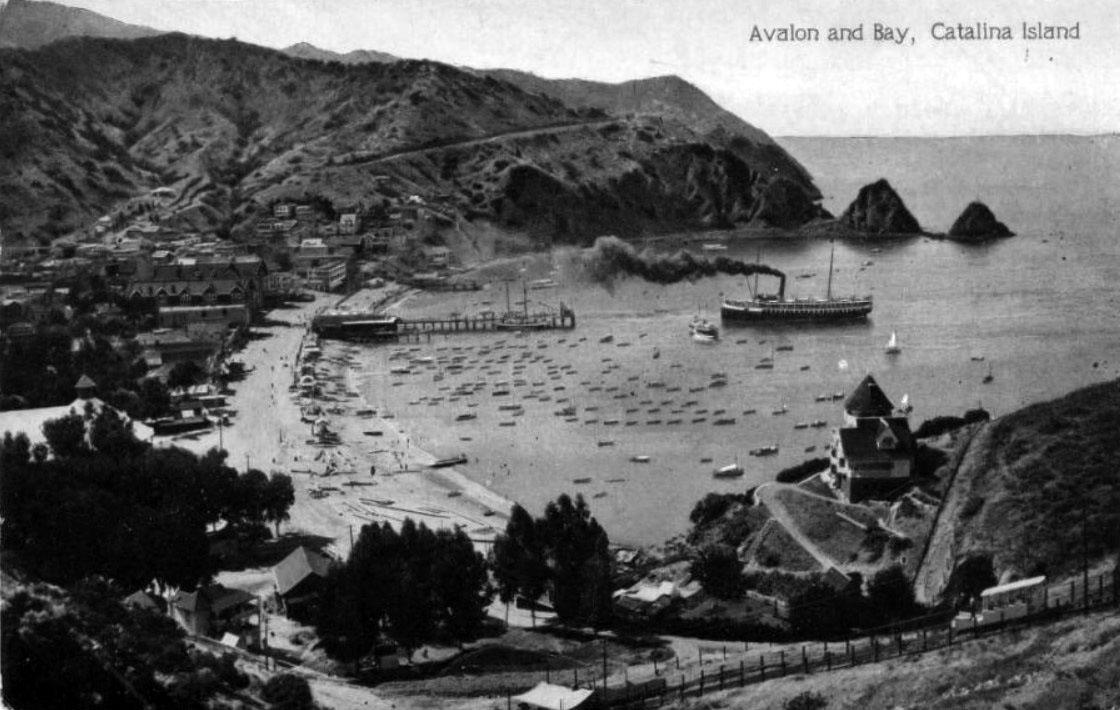 |
|
| (ca. 1911)#^^ - Postcard view showing a furnicular of the Santa Catalina Incline Railway ascending up the steep slope at lower-right. Avalon Bay is in the backgroud. |
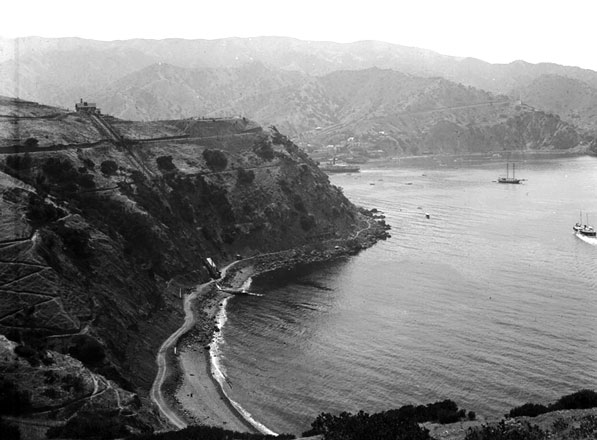 |
|
| (ca. 1905)^^ - View of the funicular descending from a tea house at the summit down to Pebbly Beach on Lovers Cove, Catalina Island. |
Historical Notes Variably known as the Santa Catalina Incline Railway, the Island Mountain Railway, and--confusingly--Angel's Flight, the railway closed in 1918, several years after a fire devastated Avalon and depressed the tourist business. The railway briefly reopened in the 1920s but closed finally in 1923. Its ruins are still visible along the old right-of-way to this day.**# |
 |
|
| (1910)^^ - View of the Island Mountain Railway on Santa Catalina Island, an incline cable railway on the side of a hill. It runs between the summit and Lover's Cove (Pebbly Beach), near Avalon. This view from the lower landing shows a rail car at the foot of the incline. A canvas provides shade over the raised wooden platform which is decorated with plants in planters. |
Historical Notes A sign at the coastal landing reads "Island Mountain Railway, fare Avalon to Summit and return 25¢, fare Avalon to Lover's Cove and return 25¢, fare Lover's Cove to Summit and return 25¢, fare Lover's Cove to Avalon and return 25¢, fare Summit to Avalon and return 25¢, fare Summit to Lover's Cove and return 25¢, fare for above trips children 15¢, apply land dep't commutation tickets 100 rides $5.00", "Persons wishing to ride on this incline please push button". |
* * * * * |
Glass Bottom Boats
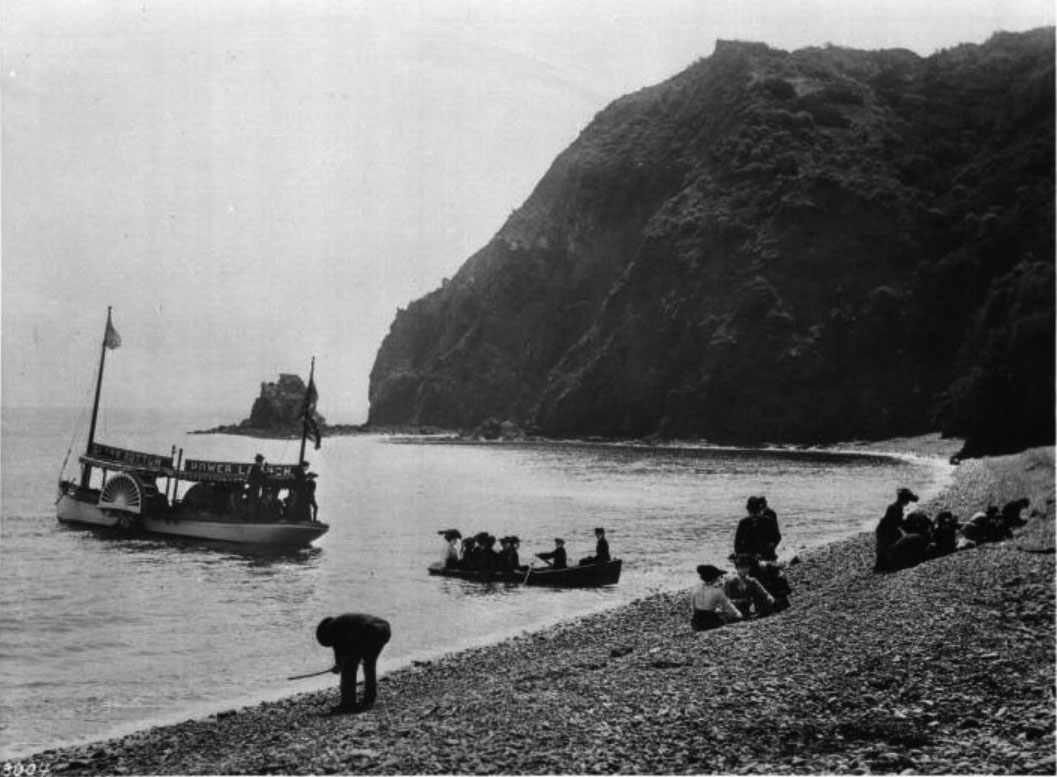 |
|
| (ca. 1905)^^ - View showing about a dozen people on Pebbly Beach. A rowboat bearing about 8 more people rows toward shore from a glass-bottom boat moored in the cove. Several other people in the glass-bottom boat look on. Lover's Cove, with Abalone Point is in the background. Sign on glass-bottom boat reads: "Glass Bottom Power Launch". |
Historical Notes Glass-bottom boats became a defining attraction of Catalina Island in the early 20th century, evolving from simple abalone fishermen’s rowboats with glass panels into increasingly sophisticated motorized vessels. Introduced around 1905, these early wooden boats featured glass panels set into their hulls, allowing visitors to peer into the clear waters of Avalon Bay and nearby coves. Tourists, guided by local captains, marveled at kelp forests, bright orange Garibaldi fish, swaying sea anemones, and other marine wonders while hearing a blend of natural history and local lore. |
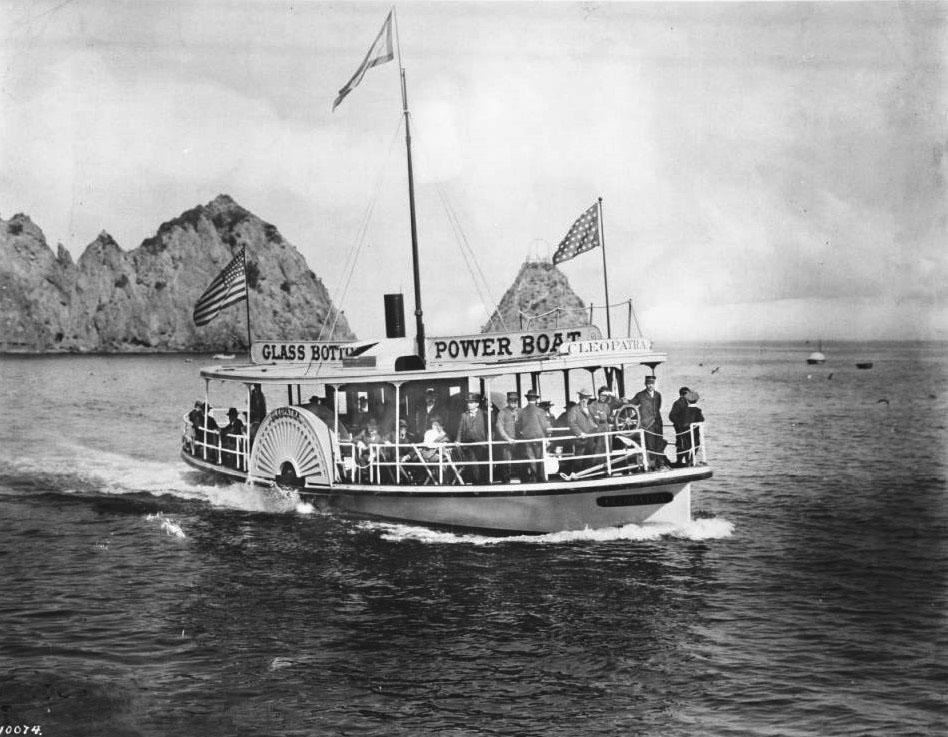 |
|
| (ca. 1905)* - View showing a glass bottom boat ride at Catalina Island near Sugarloaf Point. |
Historical Notes Fishermen had to get creative to find large fish or large schools of fish under the sea. They would do this by placing a plate of glass in the bottom of their small row boats – as they were fishing, they could look directly beneath them to search out their catch. One fisherman found he could make more money showing people what the underwater world looked like than hauling up fish to sell. And so, the first glass bottom boat tour was unofficially started. These early tours date back to the late 1800s. By the early 1900s, boats were being constructed to carry as many as a couple dozen visitors at a time. |
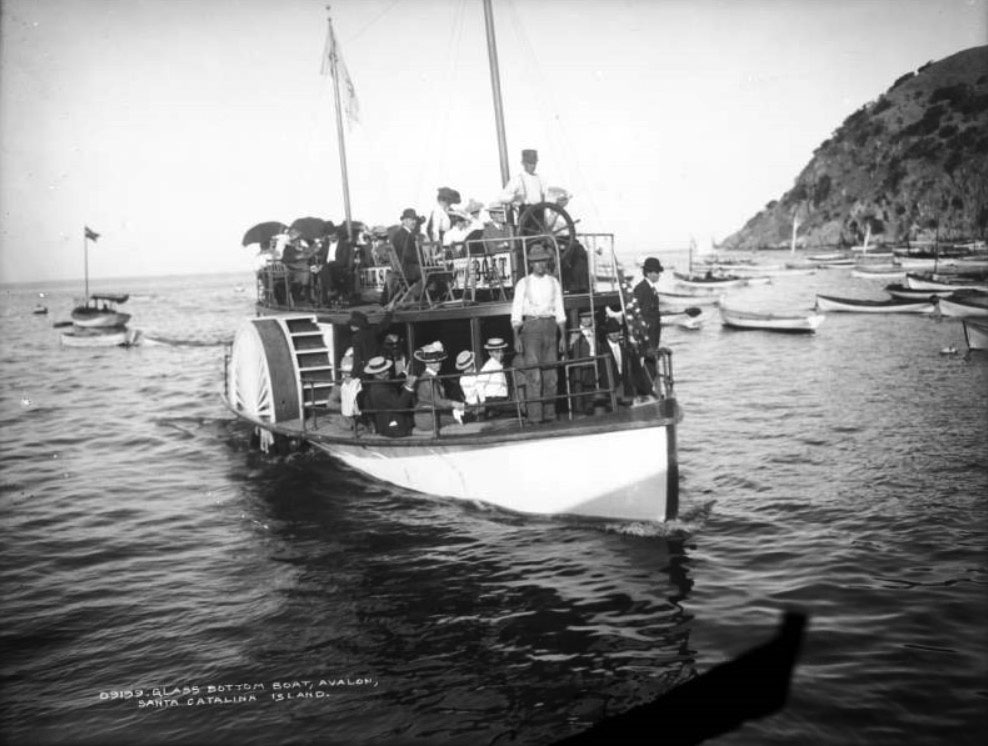 |
|
| (ca. 1904)* - Passengers stand and sit on a crowded side-wheel, glass bottom boat while the captain steers through Avalon Bay near Avalon on Santa Catalina Island. Shows a buoy and boats in the distance. A sign on the boat reads, "Glas[s] ? Boat." |
Historical Notes The industry took off in the 1900s when pioneers like Captain J.E. "Pard" Mathewson launched purpose-built boats such as Mon Ami (1902), Lady Lou (1905), and Cleopatra (1906), each designed to cater to a growing tourist crowd. The novelty of seeing the ocean floor without getting wet made the tours wildly popular, and Catalina soon became one of the first places in the U.S. to offer such an immersive marine experience. The glass-bottom boats quickly became a staple in promotional materials, from postcards to travel brochures. |
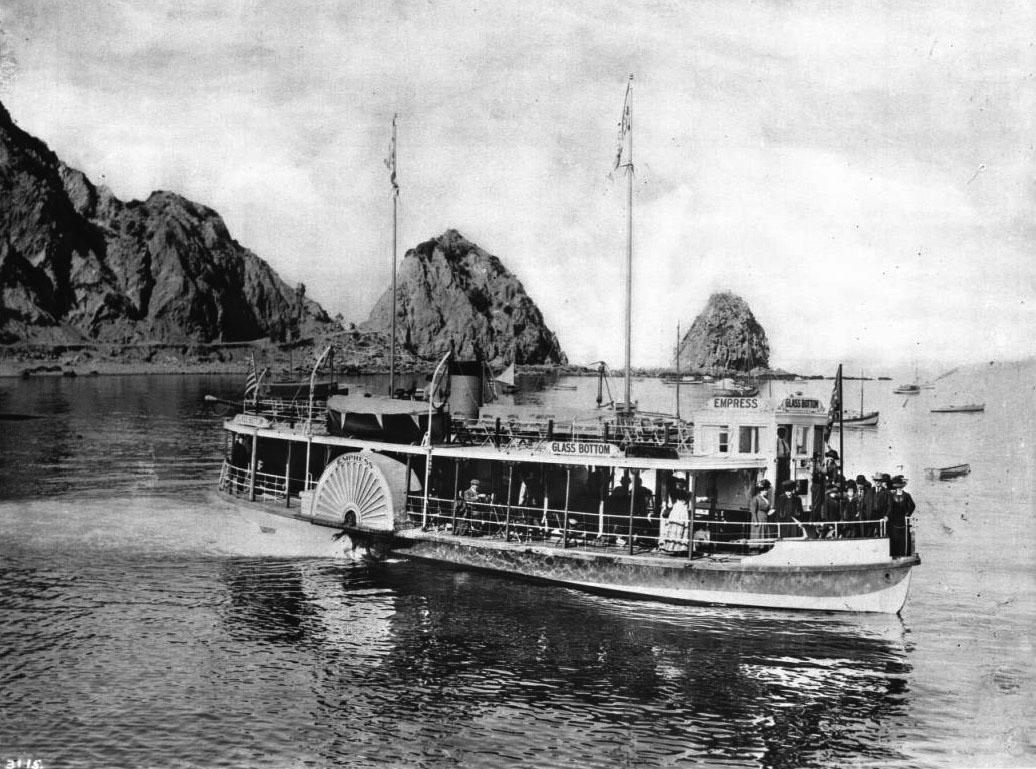 |
|
| (ca. 1917)^^ - View showing the glass-bottom boat, the Empress, in Avalon Harbor, with Sugarloaf Point in the background. The 20 or so passengers are spread about the lower deck of the two-deck vessel. Three passengers are on the upper deck. The pilot stands in the cabin which is located at the bow. The boat is propelled by a steam driven paddle at the side. And, an American flag flies from the stern. |
Historical Notes By the 1920s and 1930s, the fleet expanded to include larger and more luxurious vessels like the Empress (1917), Emperor (1920), Princess (1926), and Phoenix (1931), which dominated Avalon Harbor. Despite occasional setbacks from storms or accidents, the glass-bottom boat industry flourished. The boats not only helped sustain the island’s tourism economy but also became icons in their own right, symbolizing Catalina’s blend of natural beauty and innovation. |
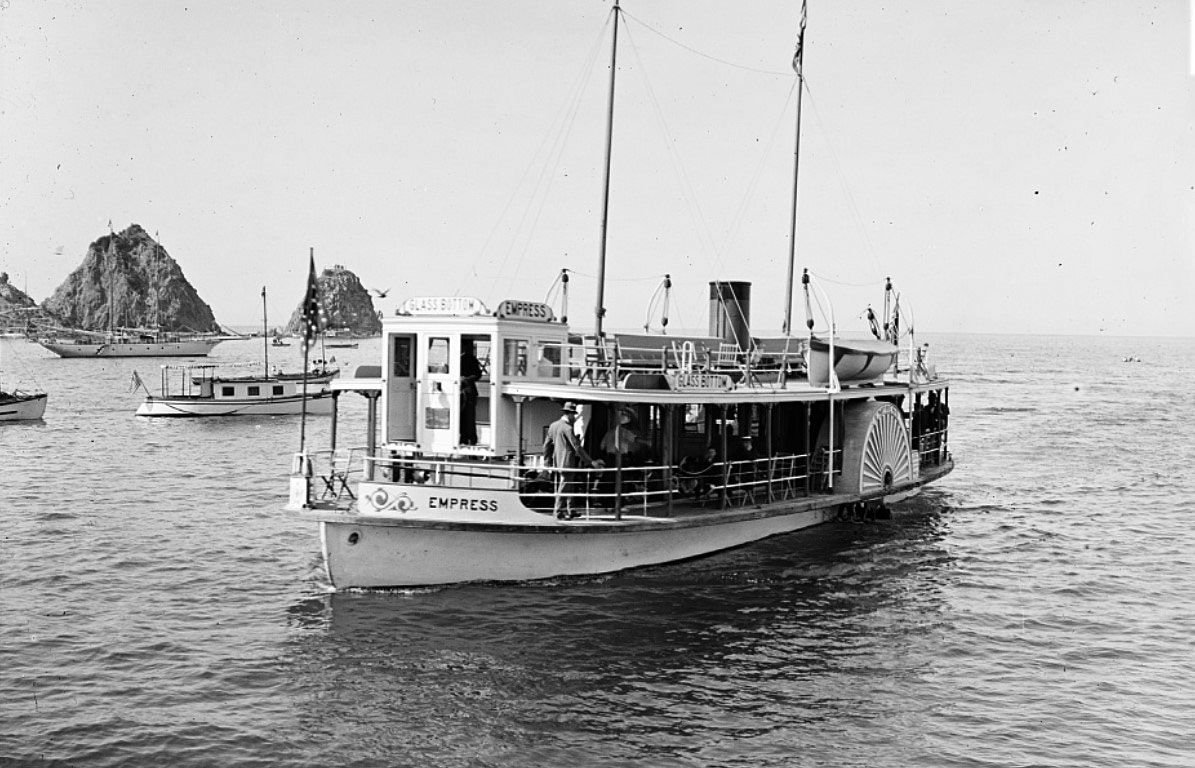 |
|
| (ca. 1917)** - Side wheeler glass-bottom Empress returns back to port after harbor cruise with Sugarloaf Point seen in background. |
Historical Notes The cultural legacy of these boats extended well beyond Avalon, even reaching Hollywood and inspiring films like The Glass Bottom Boat (1966). More than a century after their introduction, glass-bottom boat tours remain a beloved part of the Catalina experience. Modern vessels still follow many of the same routes charted by early captains, continuing a tradition that helped shape the island’s identity and allure. |
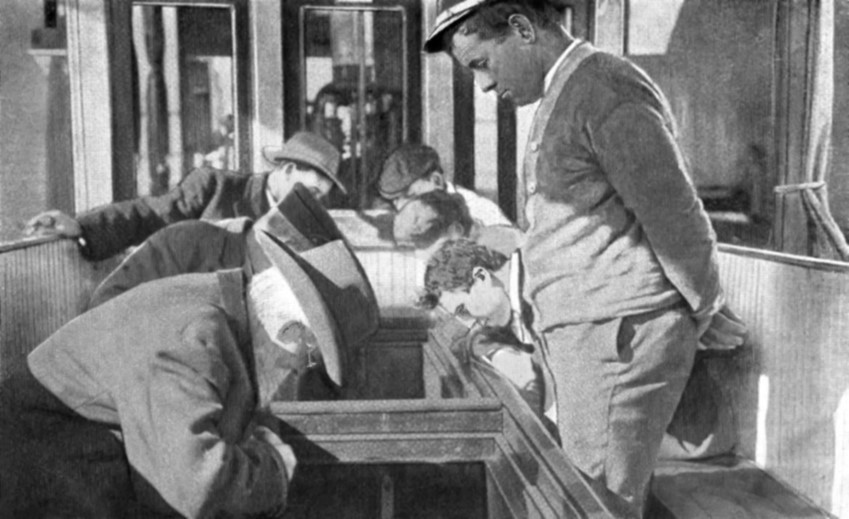 |
|
| (ca. 1930)* – Watching Catalina Island's Marine Gardens from a glass bottom boat. |
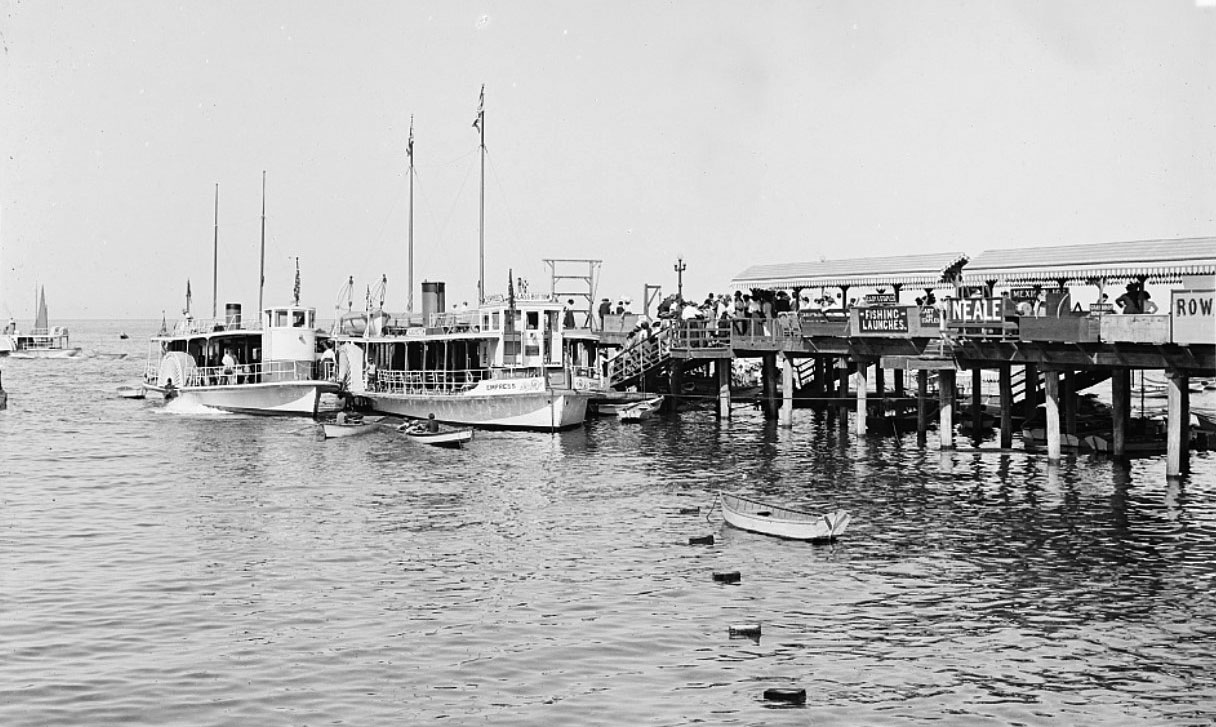 |
|
| (ca. 1910)** - Side wheelers Cleopatra and Empress docked at pier. |
* * * * * |
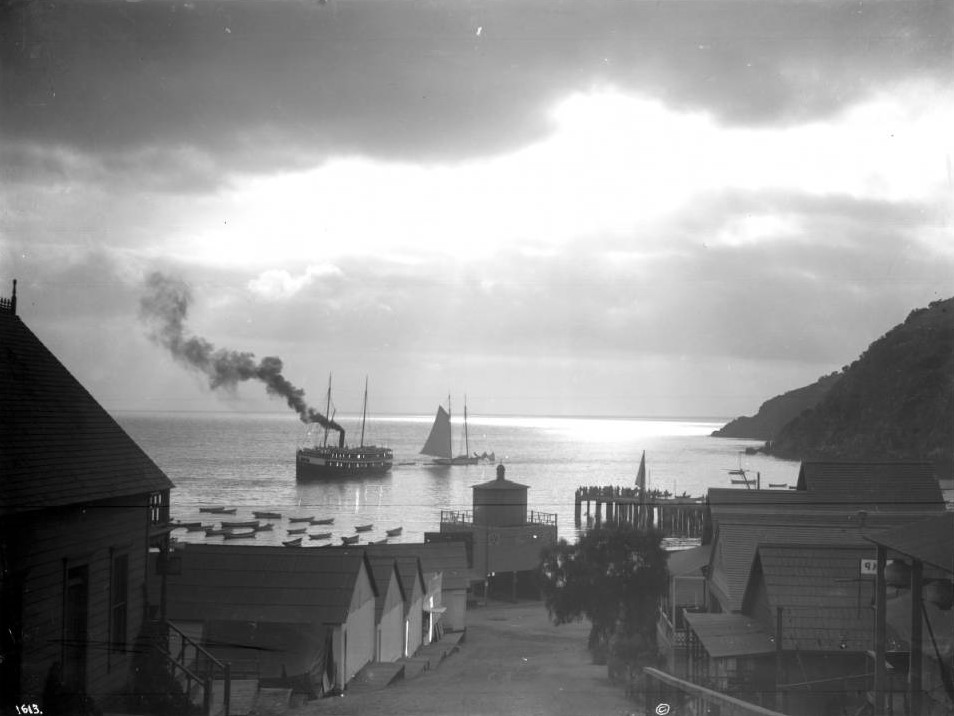 |
|
| (ca. 1910)^^ - Photograph of moonlight excursion on Avalon Harbor. At center, a small street slopes down to the harbor. Small homes and buildings line the street on both sides. To the right, a small wooden pier can be seen extending over the water. To the left, around twenty small boats are anchored in the marina. At center moving along the water, a large steamboat and sailboat can be seen. A trail of smoke extends from the steamboat. The ocean can be seen extending to the left and right into the extreme background. To the far right, large cliff walls are visible. |
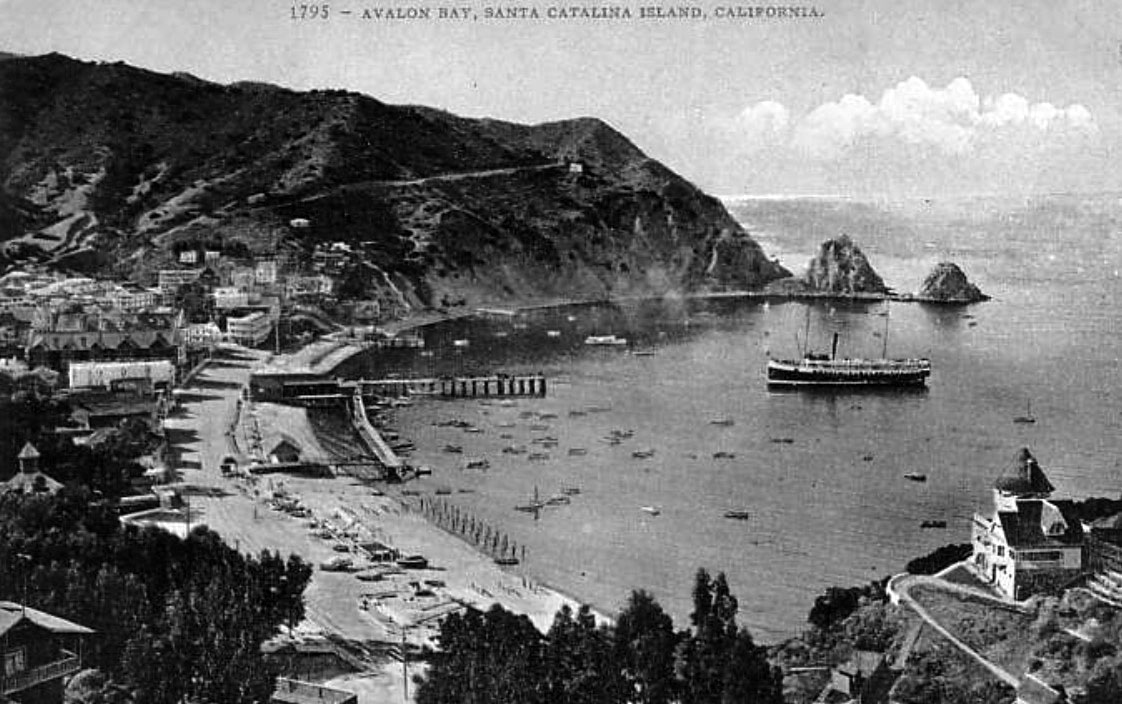 |
|
| (ca. 1910)*^ - Postcard view of Avalon Bay, Catalina Island. A steamship is approaching the pier. Sugarloaf Point (later Casino Point) is seen behind the ship. |
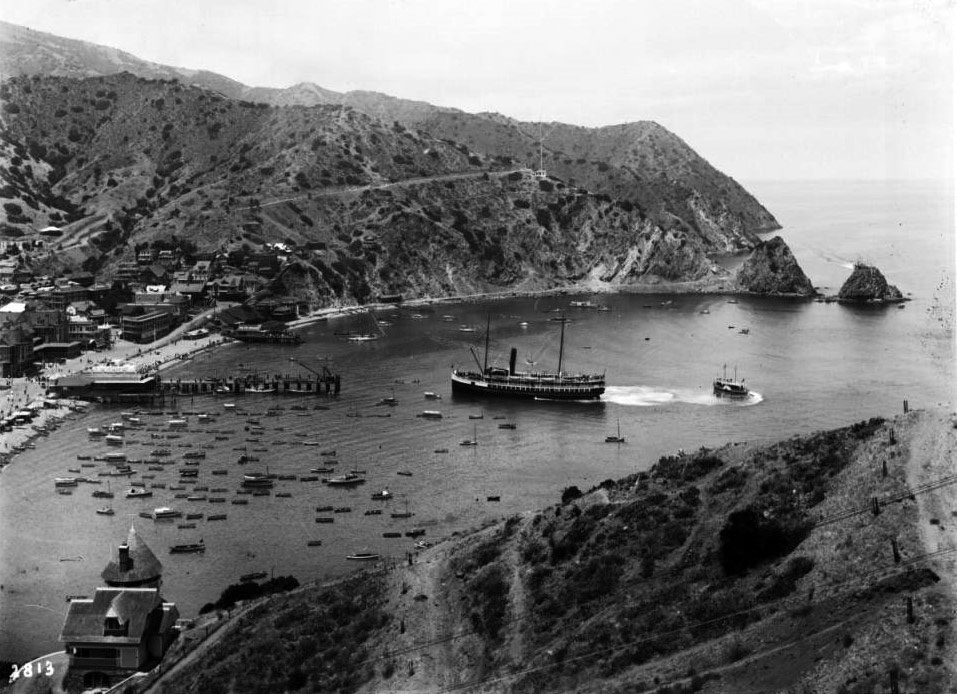 |
|
| (ca. 1910)^^ - Panoramic view of Avalon Harbor showing a steamboat approaching the pier. A smaller boat is seen crossing the wake of the steamer. Dozens of other smaller boats dot the harbor. To the left of the harbor, a cluster of large buildings are visible near the base of the mountain. In the extreme foreground, a large mountain slope can be seen descending to the left. Along the slope at left, a large house (Holly Hills House) is visible. In the extreme background, additional mountain ranges can be seen extending from Sugarloaf Point to the far left. |
 |
|
| (ca. 1910)** - Wharf, aquarium, and ticket office, Avalon. A group of people await in line as steamer is docking. |
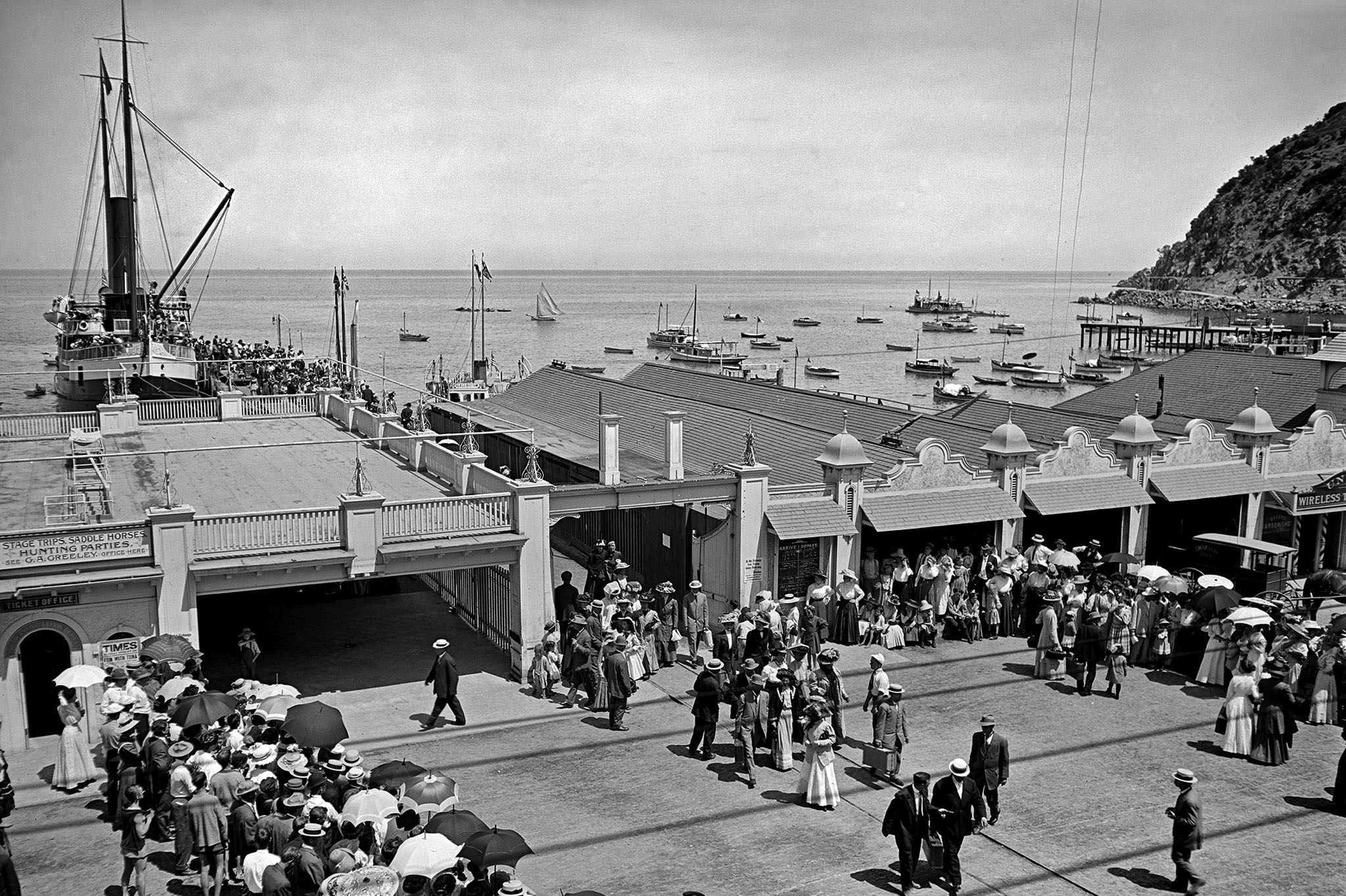 |
|
| (ca. 1910)** - People are cued in line by the ticket office as passengers disembark the docked steamship. |
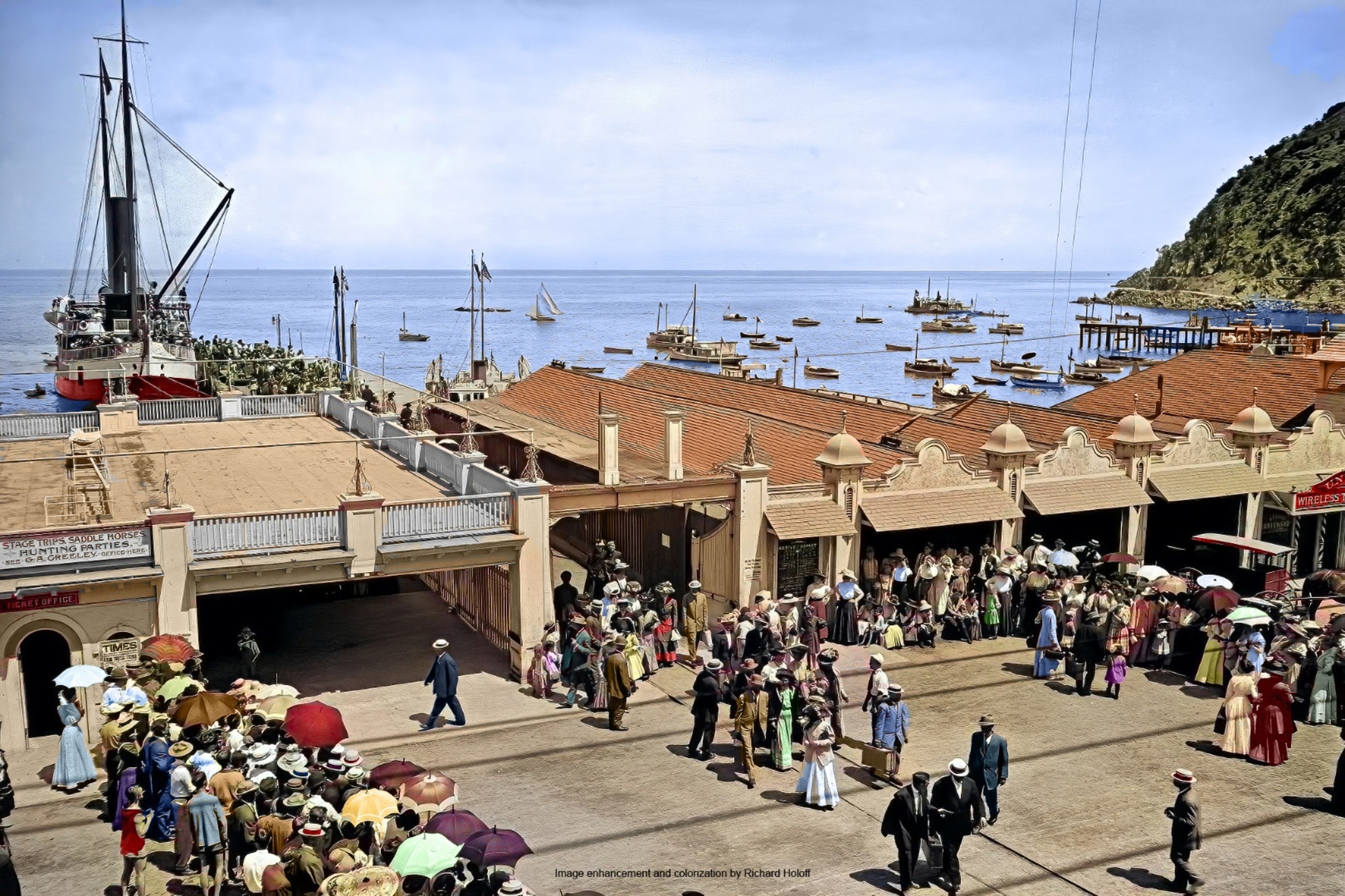 |
|
| (ca. 1910)** - People are cued in line by the ticket office as passengers disembark the docked steamship. Image enhancement and colorization by Richard Holoff |
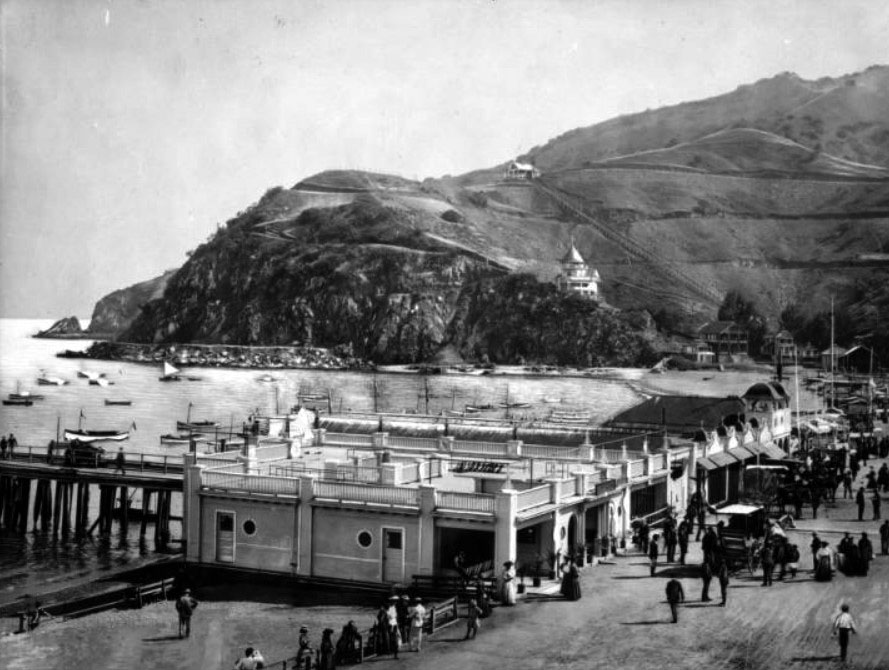 |
|
| (ca. 1910)^^ – View looking north showing the aquarium and other buildings around the harbor in Avalon. The aquarium is housed in a low, rectangular building in the foreground at center. Several more buildings are attached at right. The street is filled with tourists. In the background, two large houses can be seen perched on the side of a steep hill, one of which is the 1890-built Holly Hill House. |
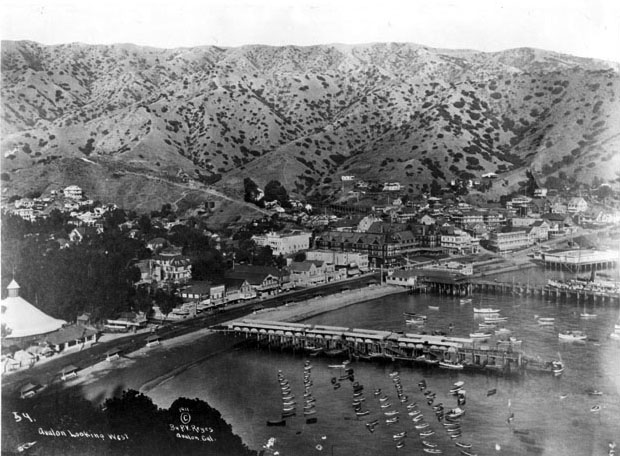 |
|
| (1911)* - Panoramic view of Avalon Bay and the town of Avalon. A second pier (foreground) has been constructed to accomodate for the growth in tourism. |
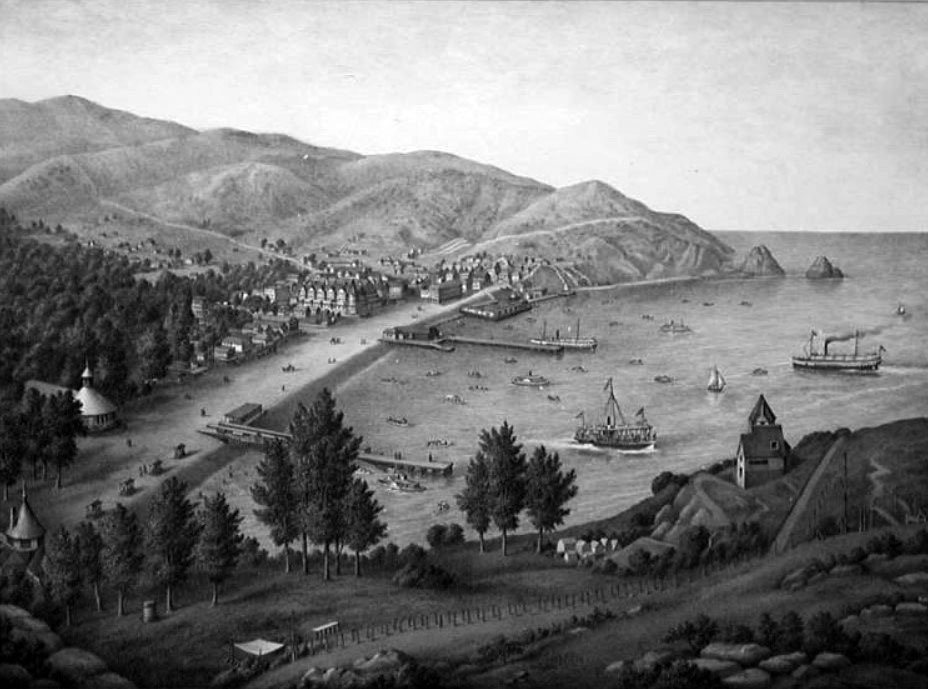 |
|
| (ca. 1911)*#* – Photo of a lithograph drawing showing an elevated landscape view of Santa Catalina Island, from a hillside looking north. Below is the bay, piers, boats, people walking and on horseback on the beach, and the city of Avalon, extending from the coast into the mountains. |
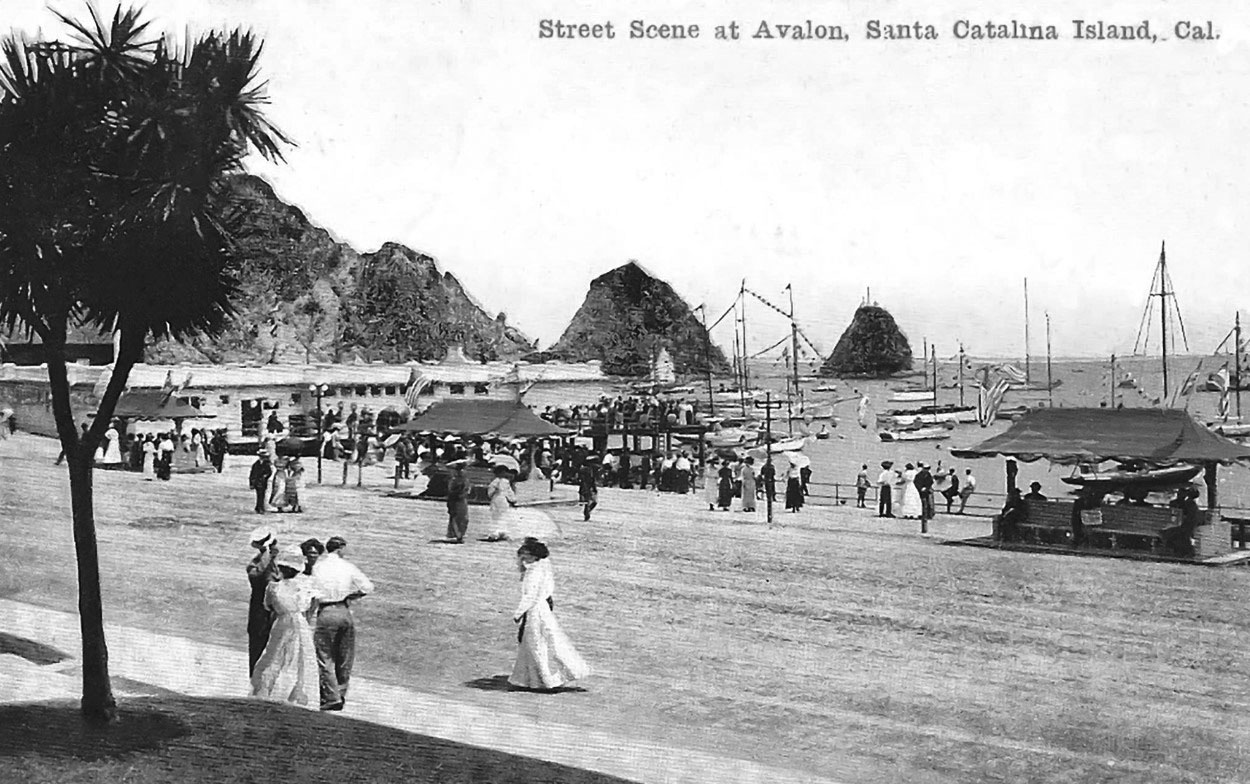 |
|
| (1912)^*^# - Street Scene at Avalon - Postcard view showing tourists enjoying a sunny day on the shore of Avalon Bay with Sugarloaf in the background. |
 |
|
| (ca. 1914)* – Panoramic view showing Avalon Bay with Sugarloaf Point in the distance. To the right can be seen the Holly Hills House, the Santa Catalina Incline Railway, and the bleachers of Avalon Bowl. |
Historical Notes William Wrigley, Jr. (1861-1932), chewing gum industrialist and founder of the William Wrigley Jr. Company, played an instrumental role in the history of Catalina Island. He bought the island from Joseph and Hancock Banning in 1919, and improved it with public utilities, new steamships, a hotel, the Casino building, and extensive planting of trees, shrubs, and flowers. Wrigley was also the owner of the Chicago Cubs baseball team, which held its annual spring training on the island. Before his purchase, Wrigley traveled to Catalina with his wife, Ada, and son, Philip, and immediately fell in love with the island. He would go on and devote himself to preserving and promoting Catalina, investing millions in needed infrastructure and attractions. In 1919, Wrigley built a vacation home overlooking Avalon on Mount Ada, named after his wife, so he could enjoy the beautiful scenery as well as oversee his work. |
* * * * * |
Wrigley Home (Mt. Ada Mansion)
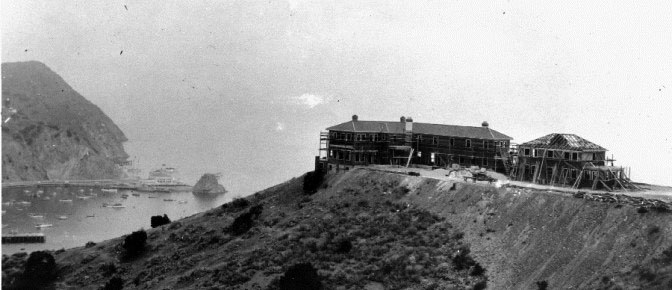 |
|
| (1919)* – View of the Wrigley residence under construction on top of Mt. Ada, overlooking Avalon Bay. In the distance is Sugarloaf Point and a new casino located on the spot where “Big" Sugarloaf once stood. |
Historical Notes First built as the vacation home of William Wrigley Jr., Mt. Ada was constructed in 1919 and finished in 1922. Wrigley reportedly chose this particular location for its unsurpassed views of Avalon Bay with magnificent surroundings and because it received the first sunlight of the morning and the last sunlight of the late evening. |
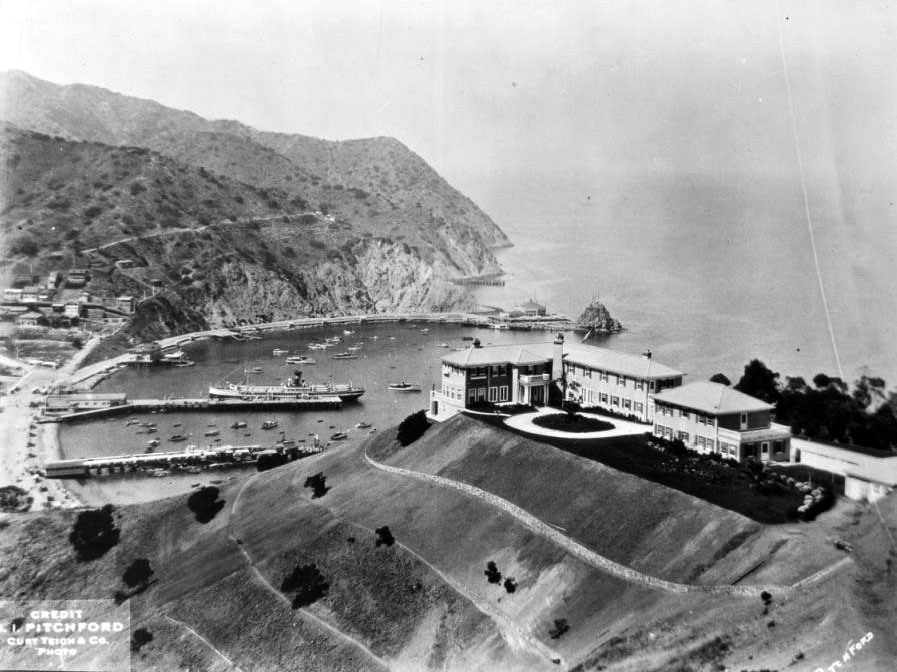 |
|
| (ca. 1922)^^ - Birdseye view of Avalon Bay with the William Wrigley house in the foreground. The house can be seen on a steep hill in the foreground at right and is a large, two-story building with dark grass all around. The hillside at left is sparsely covered with small, thick trees. The harbor can be seen in the background at left. A large steamship can be seen at a dock, while many smaller vessels are moored in the harbor. “Little” Sugarloaf rock can be seen in the background at center next to Avalon’s first Casino, right where “Big” Sugarloaf rock once stood. |
Historical Notes The Wrigley home was designed and built by David M. Renton, general manager of the Santa Catalina Island Company at the time. Renton, who was influential in the early development of Catalina Island, also managed construction of the Catalina Casino Ballroom and was known for the development of Craftsman-style homes in Pasadena, among many other local projects. |
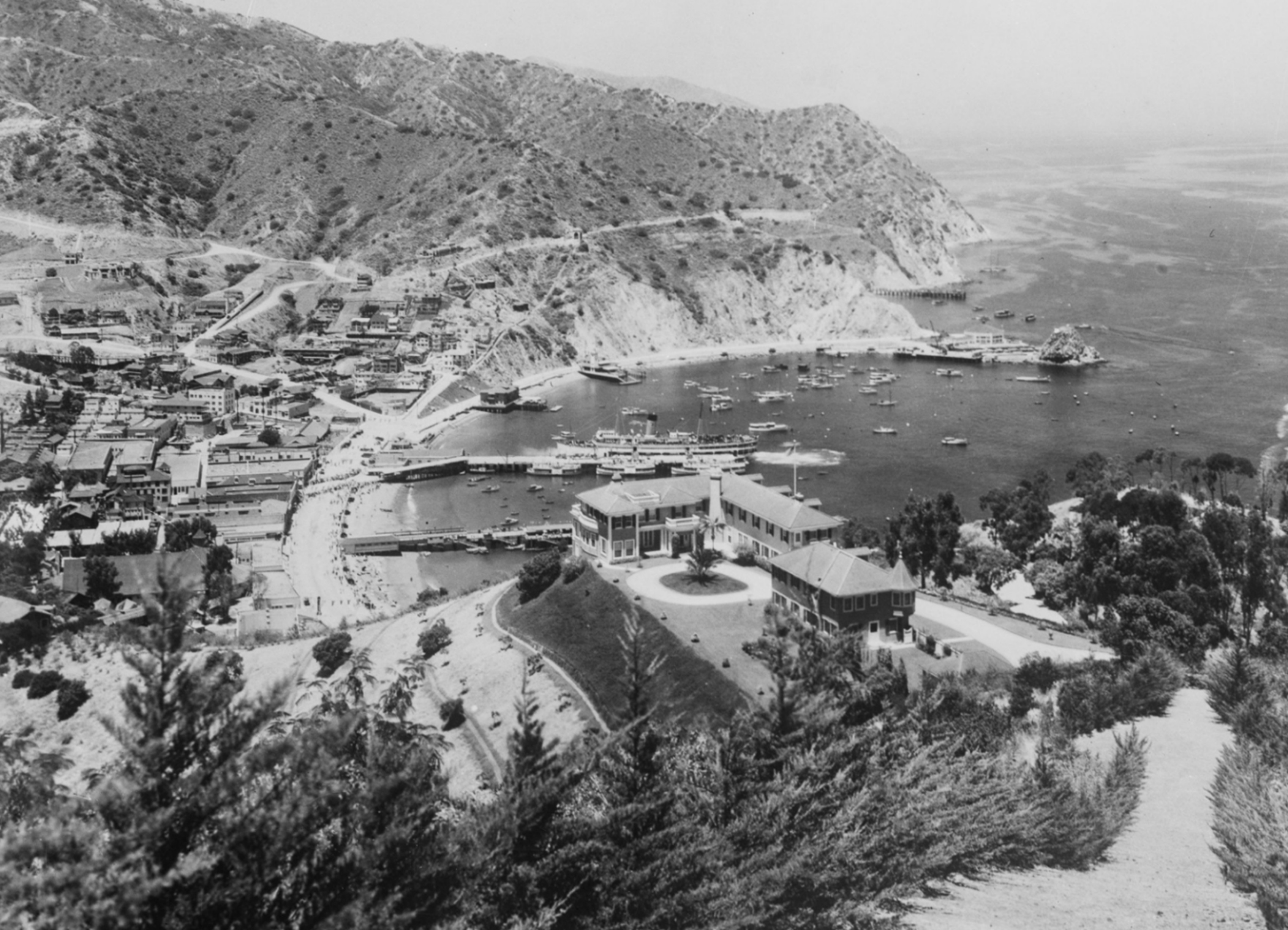 |
|
| (1920s)* – A panoramic view of Avalon Bay on Santa Catalina Island, California. In the foreground sits Mount Ada, the hilltop estate of chewing gum magnate William Wrigley Jr., with its circular driveway and commanding view of the harbor. Below, the bustling waterfront is lined with piers, steamships, and pleasure boats serving the thriving resort town of Avalon. On the far right, Sugarloaf Rock juts into the bay near the original Sugarloaf Casino, a prominent entertainment venue before it was demolished in 1929 to make way for the larger Catalina Casino. |
Historical Notes The mansion was designed in the Georgian Colonial Revival style by architect Zachary Taylor Davis, who also designed Chicago’s Wrigley Field. The original plans, influenced by Ada Wrigley’s preferences, included features such as dark green shutters, a Turkish bath, billiard room, organ chamber, sunroom, and a wraparound veranda. The house was built in an “L” shape, wrapping around a formal motor court on the mountain side and featuring a grand staircase from the ocean side. |
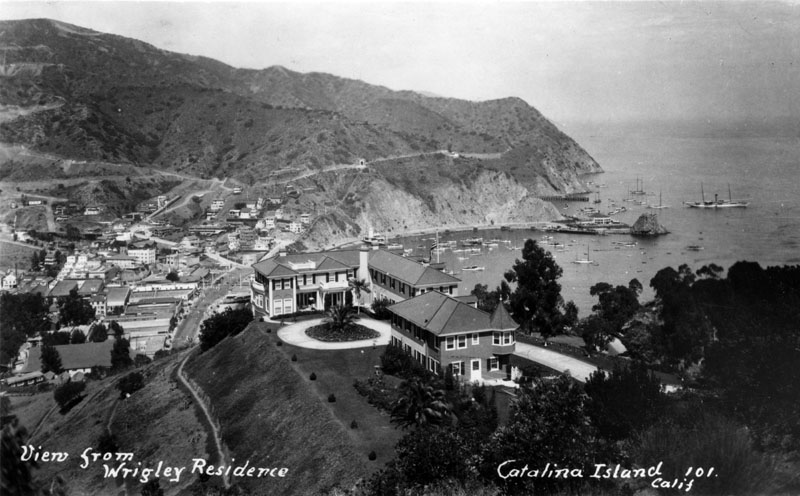 |
|
| (1920s)* - View of William Wrigley's beautiful two-story, L-shaped home resting atop a grassy hill, overlooking Avalon and beyond. Small houses as well as various tourist-oriented businesses, office buildings and several larger apartment complexes are nestled in the hills. The first Catalina Casino, Sugarloaf Casino, and numerous small boats are visible at the edge of the bay on the right, surrounded by the sea on three sides. |
Historical Notes The home stood 350 feet above the ocean and provided expansive views of Avalon Bay, the town of Avalon itself, and the mainland off in the distance. The Wrigleys reportedly made two annual visits to Catalina Island in the summer and winter, with each visit lasting between four and ten weeks. Many distinguished guests of that time period enjoying visiting with the Wrigley family, including Herbert Hoover, Calvin Coolidge, and the Prince of Wales. |
.jpg) |
|
| (n.d.)* - View showing the stairway leadig to William Wrigley's house on top of Mt. Ada (named after Mrs. Wrigley). The sprawling residence boasts numerous windows, each facing magnificent views of the island, several dormers, a number of balconies, and lush landscape. |
Historical Notes After Mr. Wrigley’s death in 1932, Mrs. Wrigley continued to visit their treasured home regularly until 1947 when she suffered a stroke. She died in 1958 and the property was then managed by the Santa Catalina Island Company and occasionally used for meetings and events by local organizations. In 1978, the property was donated to the University of Southern California and was used by the University as a conference center for the next several years. |
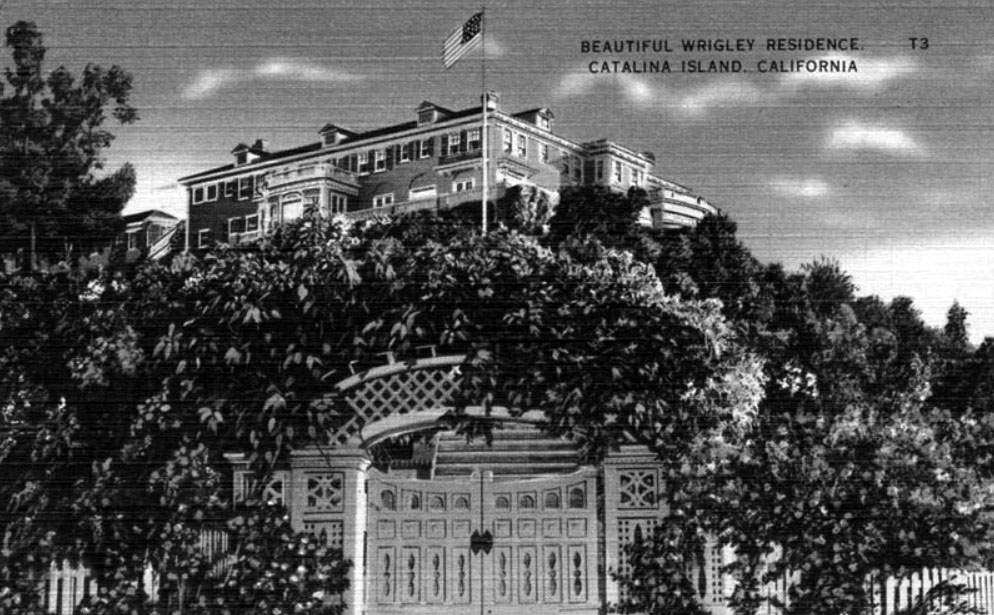 |
|
| (n.d.)* - Postcard view of the Wrigley Residence on Mt. Ada, Catalina. Built between 1922-24 and designed by David M. Renton. |
Historical Notes In 1985, the home was leased to its present operators and became The Inn on Mt. Ada. The residence was carefully restored in an effort to bring the property up to current building standards and to provide the amenities of a luxurious inn. Many celebrities have stayed at the Inn including Barbara Streisand, Molly Ringwald, and Billy Zane. The most requested suite is the two-room Grand Suite which includes a private terrace. Mt. Ada is open to the public every December for the Catalina Island Museum’s Annual Open House. The home was placed on the National Register of Historic Places in 1985. |
* * * * * |
Chicago Cubs Arrive at Catalina Island
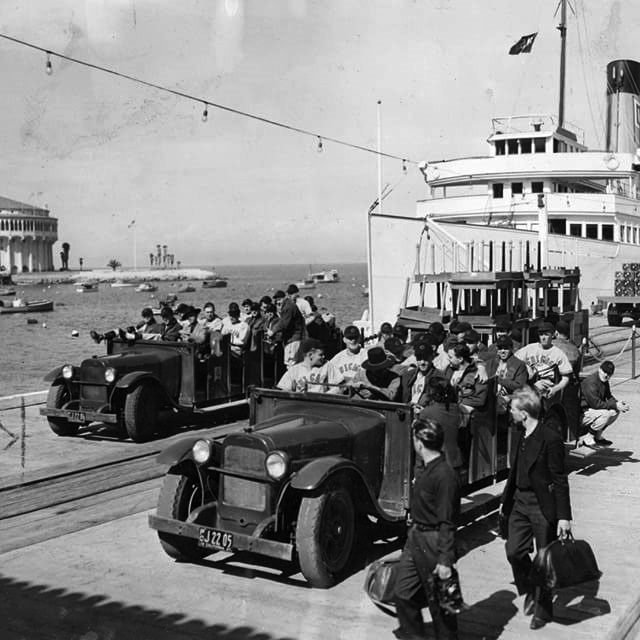 |
|
| (1937)++ – Chicago Cubs arrive at Catalina Island for spring training. Two large open-air buses transported the players to the practice field. |
Historical Notes In 1919, William Wrigley, Jr. gained a controlling interest in the Chicago Cubs and in 1921 he made the decision to have the Cubs train on Catalinia. In doing so, he became the first baseball owner to bring a major league club out West for spring training, building a facility for the Cubs on Catalina that he humbly called “Wrigley Field.” (Regular-season major league baseball wouldn’t arrive on the West Coast until the Dodgers and the Giants made their moves west in the 1950s.) |
Catalina Wrigley Field (originally Avalon Ball Park)
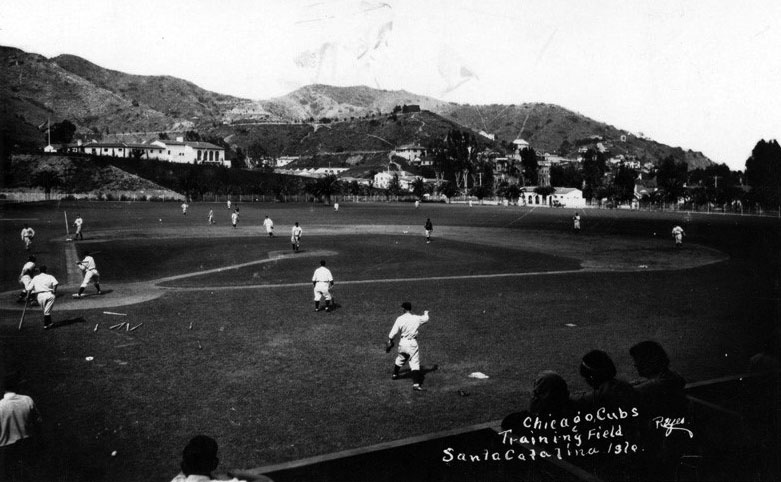 |
|
| (1920s)^*# - Spring training baseball action at the Chicago Cubs’ Wrigley Field facility on Catalina Island. |
Historical Notes When the Chicago Cubs began spring training on Catalina Island in 1921, they practiced at Avalon Ball Park. This field served as their training site until Wrigley Field on Catalina Island was established in the late 1920s. The field on Catalina Island was colloquially called Wrigley Field by the Chicago Cubs players and fans before it was officially named Wrigley Field. The Catalina Island Wrigley Field was named after the Los Angeles Wrigley Field, which had been named in 1925. This naming occurred before the Chicago Wrigley Field received its current name in 1927. The field's association with the Wrigley family, who owned both the Cubs and significant property on Catalina Island, led to the informal use of the name prior to its official designation in the late 1920s. The Cubs were treated like royalty on the island, greeted with a parade each spring, fed at the ornate Hotel St. Catherine, and able to cavort with actresses like Betty Grable, Grace Bradley and Rochelle Hudson. They stayed at the Hotel St. Catherine in Descanso Bay and played on a ballfield built in Avalon Canyon that was named Wrigley Field. |
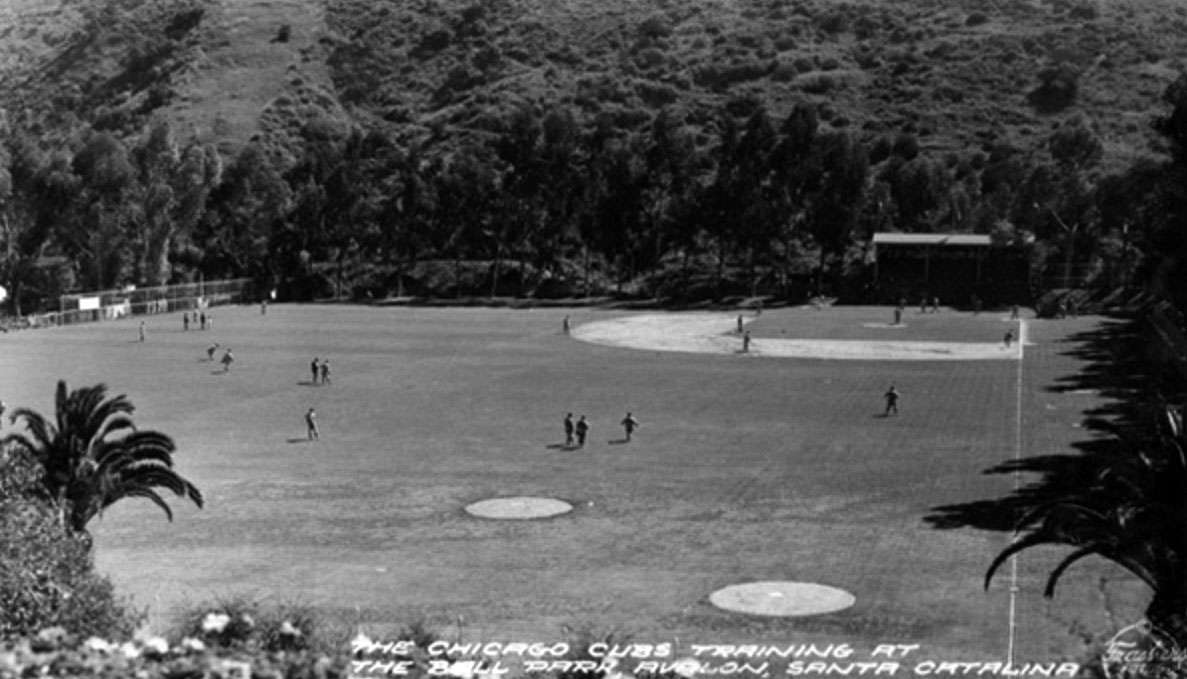 |
|
| (1940)**** - Postcard view showing the Chicago Cubs baseball team training at the Ball Park also called Wrigley Field in Avalon, Santa Catalina. |
Historical Notes The Cubs continued to use the island for spring training until 1951, except during the war years of 1942–45. |
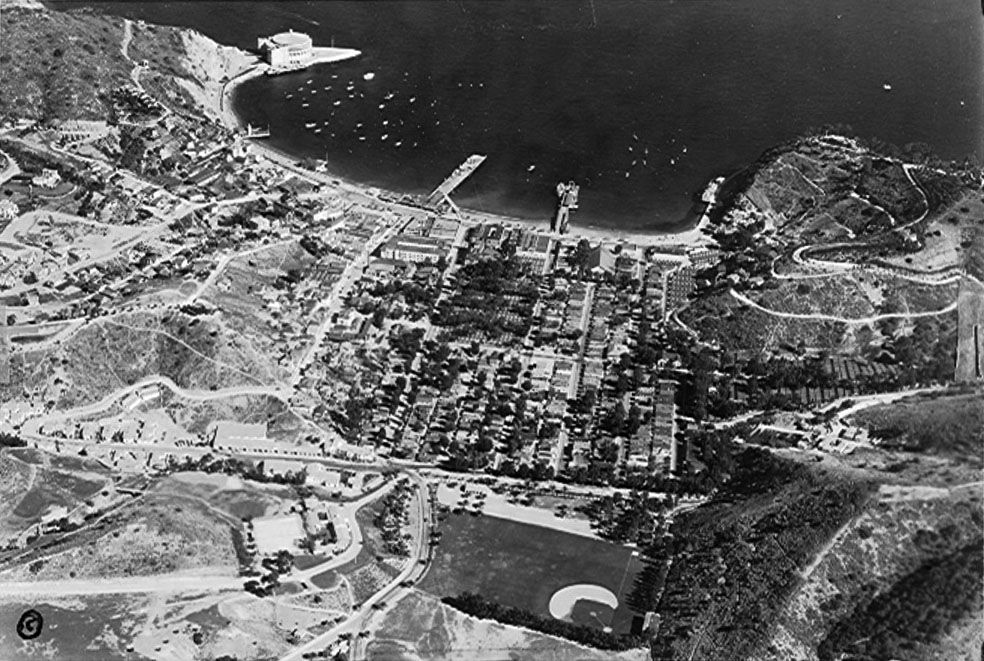 |
|
| (1930s)* – Aerial view showing the town of Avalon. Wrigley’s Chicago Cubs spring training field (Wrigley Field) is seen in the foreground. |
Historical Notes Today, only a plaque noting the location of "Wrigley Field" remains on the grounds of what is currently the Catalina Island Country Club, though its clubhouse is the same structure that Wrigley built for the Cubs.* Coincidentally, the first Wrigley Field, built by Wrigley in 1925 for the Los Angeles Angels of the Pacific Coast League, was located on Avalon Boulevard in South Los Angeles. Click HERE to see more in Baseball in Early L.A. |
Avalon Bird Park
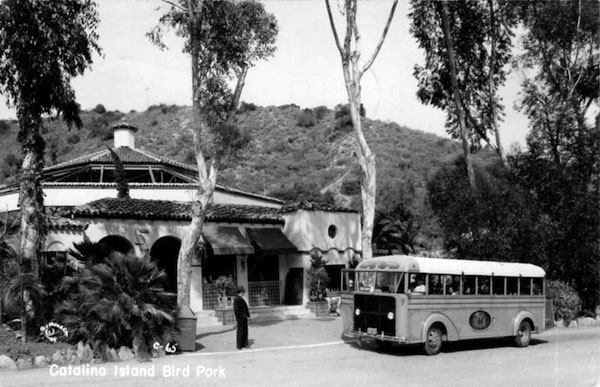 |
|
| (ca. 1930s)* - Postcard view showing a bus full of tourists stopped in front of the Catalina Island Bird Park in Avalon Canyon. |
Historical Notes Bird Park was built by William Wrigley, Jr. in the late 1920s, and it covered about eight acres in Avalon Canyon. The large aviary iron superstructure once had been a dance pavilion at Casino Point. It was moved in about 1927 to make way for the construction of the new Casino, and readapted as an aviary for the Bird Park. Eventually, more than 500 cages housed up to 8000 birds, many of them rare and exotic species. Admission was free to what was thought to be the world’s largest bird park at the time. The Bird Park was scaled back during World War II when visitation to the island was limited. In 1966 the park closed, and its remaining birds were purchased by the Los Angeles Zoo Association and transferred to the newly created Los Angeles Zoo. Today the Bird Park site is home to an Avalon preschool. |
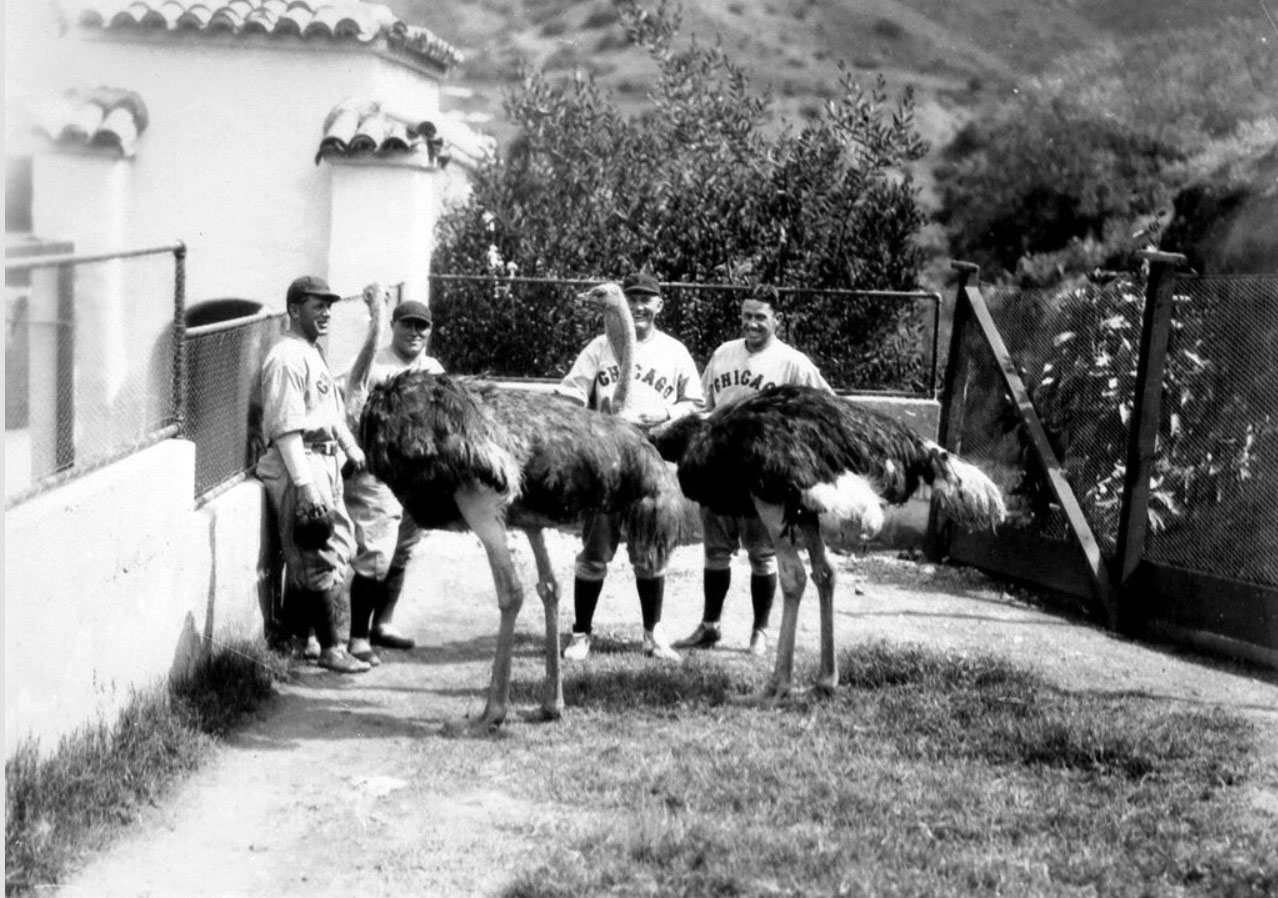 |
|
| (ca. 1930s)^#^ - Cubs players with ostriches at the Avalon Bird Park on Catalina Island. |
Historical Notes Wrigley would use his baseball team for the promotion of Catalina Island. When the Cubs trained on Catalina, the players were photographed taking part in the same activities a vacationer might — fishing, golfing, horseback riding, visiting the bird park or pottery factory — except that they were in uniform. The photos promoted what was a new concept at the time, the all-inclusive vacation. ## |
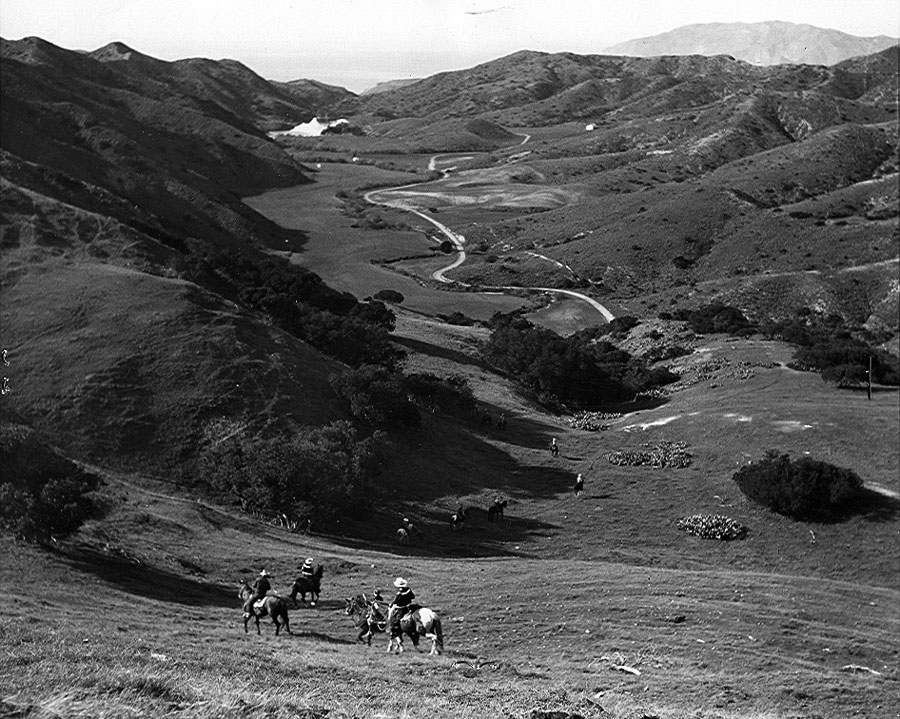 |
|
| (1930s)* – View showing a group of people on horseback enjoying a ride through Catalina’s inland terrain. |
 |
|
| (n.d.)^^# – View showing a Catalina Bison standing on a hilltop overlooking the Pacific Ocean. The animal that most Americans call a buffalo is actually a bison. Buffaloes are found in Africa and South Asia, while bison roam in North and South America. |
Historical Notes A herd of American Bison was supposedly first imported to California's Catalina Island in 1924 for the silent film version of Zane Grey's Western tale, The Vanishing American. However, the 1925 version of "The Vanishing American" does not contain any bison whatsoever and shows no terrain that even remotely resembles Catalina, according to Jim Watson, columnist for the Catalina Islander newspaper. Over the decades, the bison herd grew to as many as 600 individuals. The population currently numbers approximately 150. Biologists found that the American Bison of Santa Catalina Island are not pure bred; 45 percent have a domesticated cow as an ancestor.*^ |
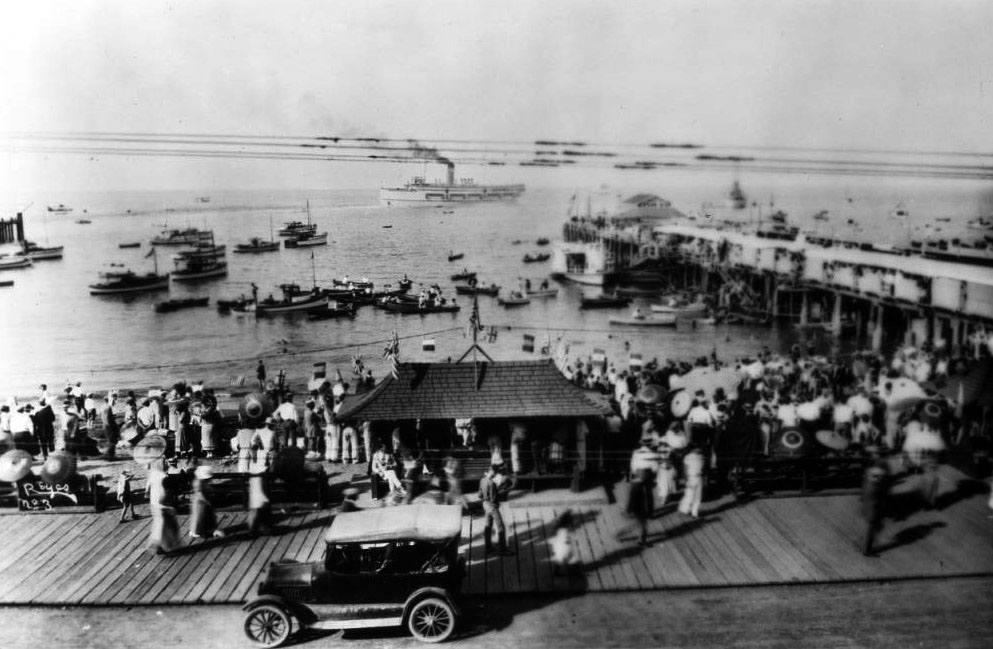 |
|
| (ca. 1927)^^ - View showing the boardwalk, beach and pier in Avalon Harbor. The beach is crowded with people looking out toward the bay as the S.S. Catalina is seen sailing away in the direction of Sugarloaf Point. An early model automobile is parked along the boardwalk. |
 |
|
| (1927)^^ - View of Avalon Bay from distant treetops. In the foreground, four trees with loosely-packed branches and foliage can be seen. In the distance below, the ships and docks of the bay are visible. To the left, the city of Avalon can be seen huddled along the shoreline. To the center-right stands Sugarloaf Casino and “Little” Sugarloaf Rock. |
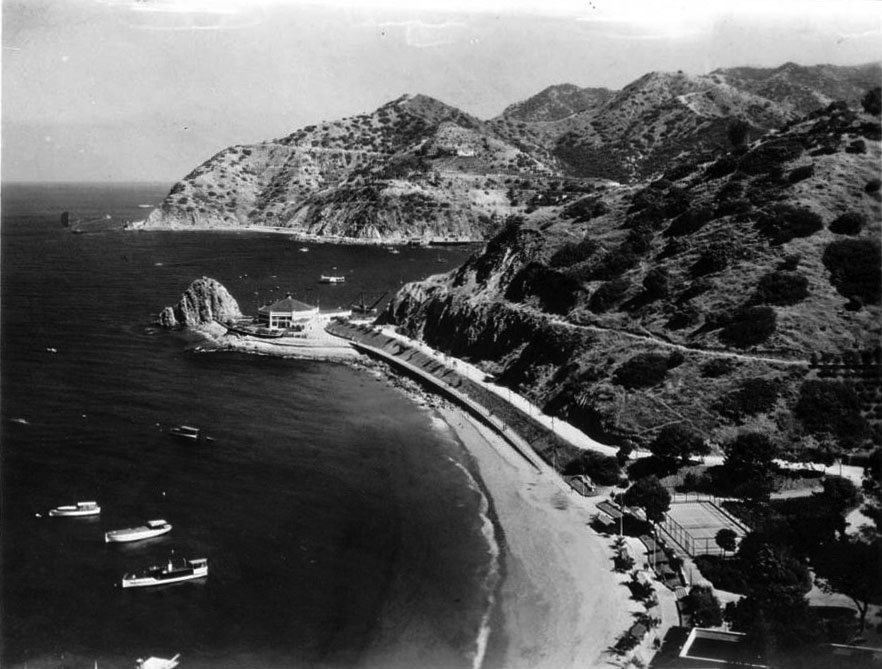 |
|
| (1927)#^^ - View from the St. Catherine Hotel in Descanso Canyon looking south towards Avalon’s first casino building, “Sugarloaf Casino”. The casino sits on the footprint of where once stood "Big Sugarloaf" and adjacent to "Little Sugarloaf". |
Historical Notes In 1917, “Big” Sugarloaf was leveled for a new hotel to replace the Metropole. However, plans changed and a new site for the hotel (Hotel St. Catherine) was chosen: Descanso Canyon. When chewing gum magnate William Wrigley Jr. bought the controlling stake in Catalina Island, he used the cleared spot (originally meant for Hotel St. Catherine) to build a dance hall. He named the new dance hall Sugarloaf Casino. It served as a ballroom and Avalon's first high school.* |
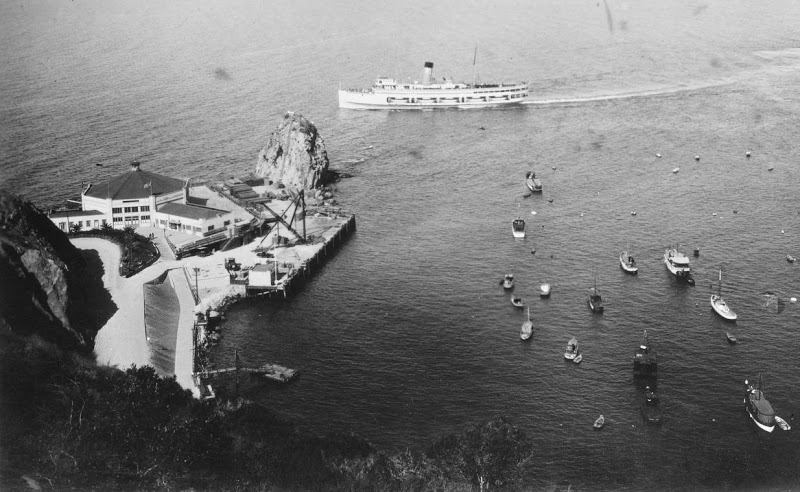 |
|
| (1927)^^ - View of Catalina Harbor looking seaward from behind Little Sugarloaf. Sugarloaf Casino can be seen as well as several boats including the S.S. Catalina, "The Great White Steamer". |
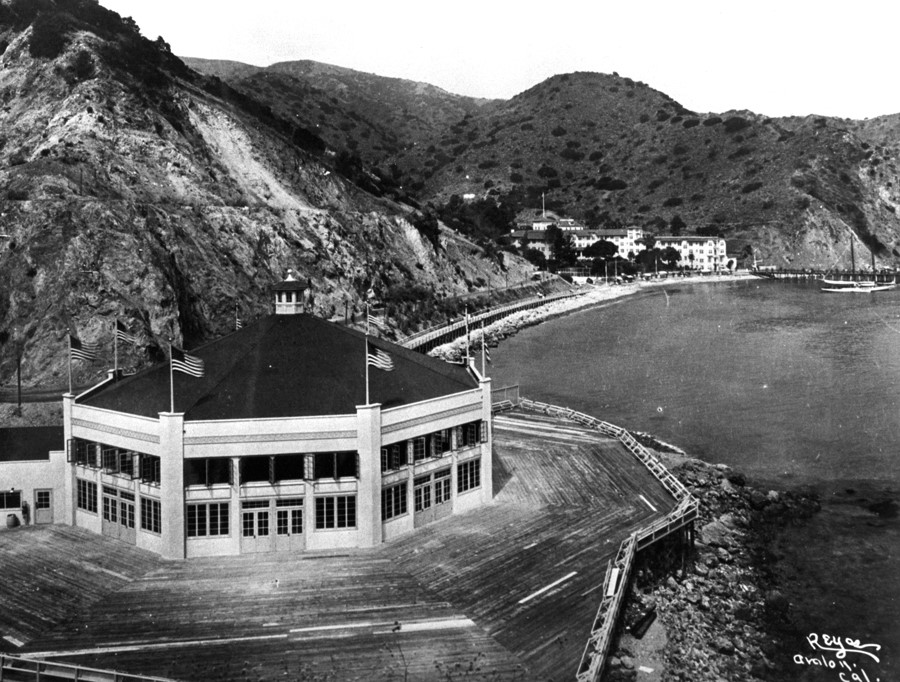 |
|
| (1920s)#^* – View looking north showing the short-lived Sugarloaf Casino, built in 1917 and demolished in 1928. Hotel Saint Catherine is seen in the distance on the shoreline of Descanso Canyon. |
Historical Notes In a short period of time Sugarloaf Casino proved to be too small to accommodate the growing number of guests. In February 1928, the building was moved to Avolon Canyon and used for the Avalon Bird Park to make room for a much larger building. The Catalina Casino Ballroom, also known as Avalon Ballroom, was built on the same spot - adjacent to Little Sugarloaf Rock by architects Sumner A. Spaulding and William Webber.* |
Construction of the new Catalina Casino
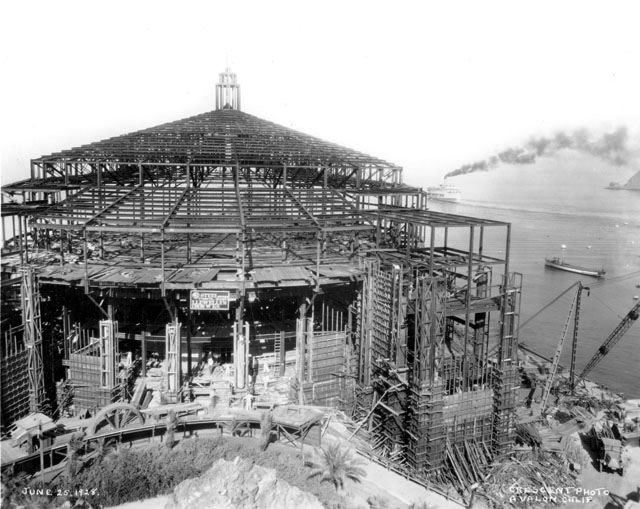 |
|
| (1928)* - View showing the construction of the second, much larger, Catalina Casino at Sugarloaf Point. The steamship S.S. Catalina is seen in the background. |
Historical Notes In 1928, when the new, markedly taller casino building was completed, authorities changed their way of looking at Little Sugarloaf. What once had been a popular landmark was suddenly thought of as a view killer. Concern began to grow that climbers would injure themselves on Little Sugarloaf. The stairs were condemned and removed. In March, 1929, Little Sugarloaf was blasted away to give what is now called Casino Point, the look that it offers today. Wrigley's budget for the design and construction of the Catalina Casino was $600,000, but when all was said and done, he ended up spending $2 million. |
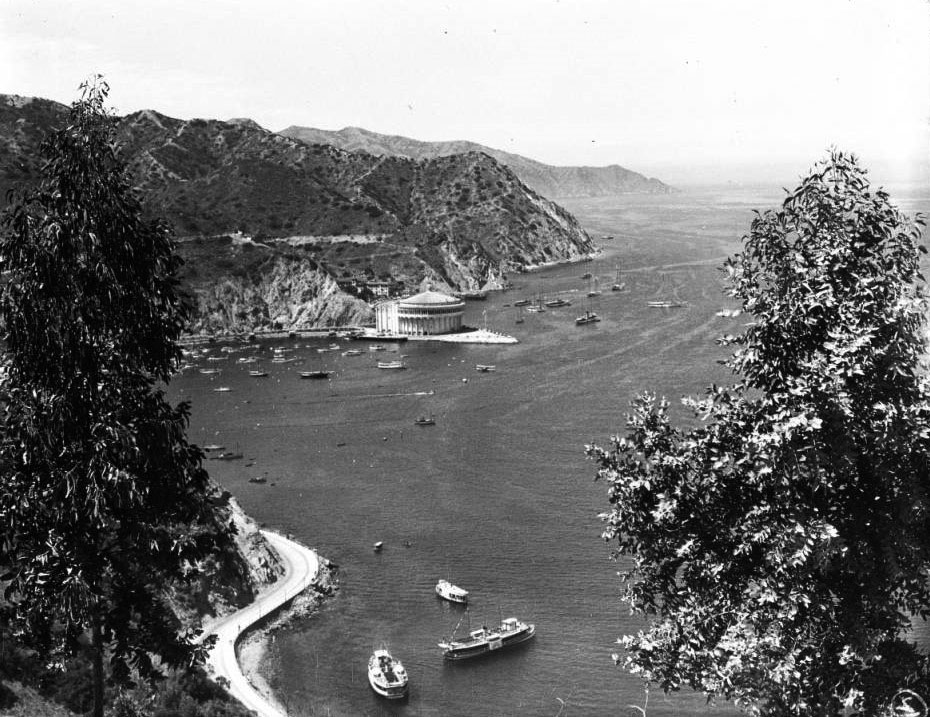 |
|
| (ca. 1929)^^ - View of Avalon Harbor through trees standing in the foreground. Boats of various sizes float in the rippling waters while the lightly-colored, cylindrical Catalina Casino stands at the water's edge at the point where the Sugarloaf Outcroppings once stood. |
Historical Notes Wrigley's most prized accomplishment was the construction of the famed Casino in 1929, which Wrigley figured would improve his revenues by attracting more tourists. Though the Casino was never used for gambling, it was a place for people to gather and enjoy some camaraderie and entertainment. It held a variety of functions following its grand opening, but the Casino's earmark during this era was ballroom dancing to the live music of a big band. |
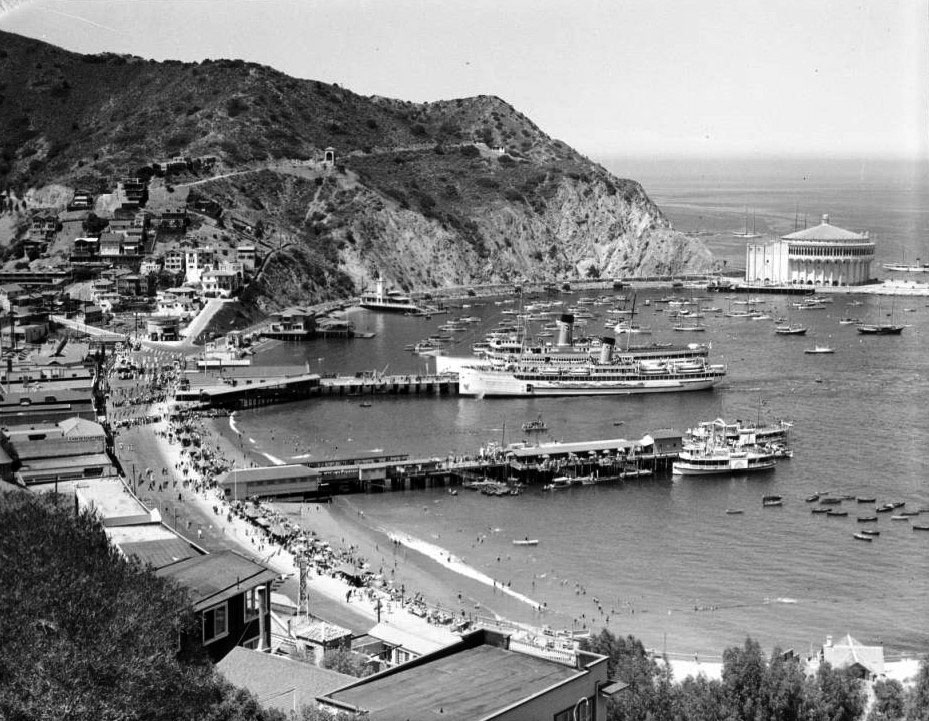 |
|
| (ca. 1929)^^ - Panoramic view of the harbor and Avalon City, Santa Catalina Island. Two large steamships (S.S. Avalon and S.S. Catalina) are docked at the pier. People play on the sandy beach and in the shallow water nearby just in front of the houses. The Avalon Casino stands in the distance at what was once Sugarloaf Point, now called Casino Point. |
Historical Notes When Wrigley bought the island, the Hermosa II and the S.S. Cabrillo were the only steamships that provided access to the island. In order to encourage growth, Wrigley purchased an additional steamship, the S.S. Virginia. With some adjustments, it was renamed the S.S. Avalon. He also foresaw the design of another steamship, the S.S. Catalina which was launched on the morning of May 3, 1924. These steamships would deliver passengers to Catalina for many years. Wrigley also brought attention to the town of Avalon by having his Chicago Cubs use the island for the team's spring training from 1921 to 1951, absent the war years of 1942–45. |
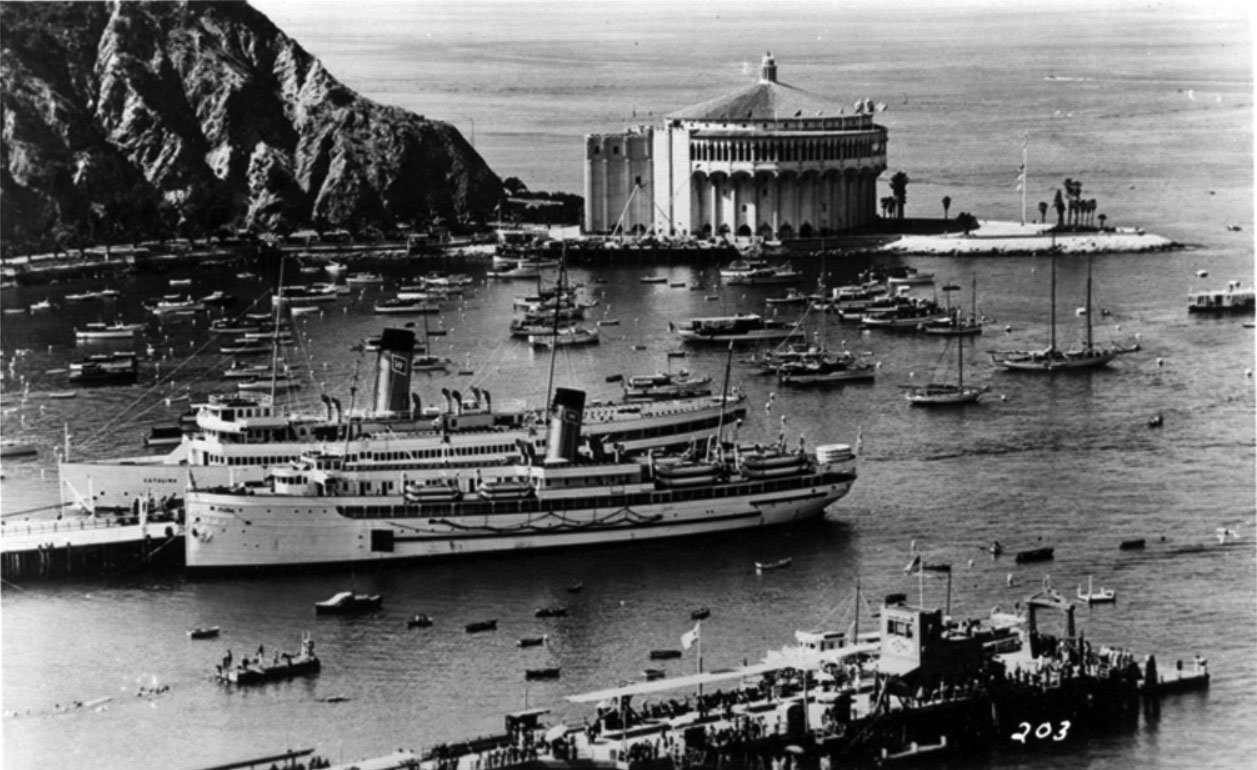 |
|
| (ca. 1929)^** – Close-up view of Avalon Bay showing the S.S. Catalina and the S.S. Avalon docked at the same pier. The Catalino Casino stands tall in the background. |
S.S. Avalon
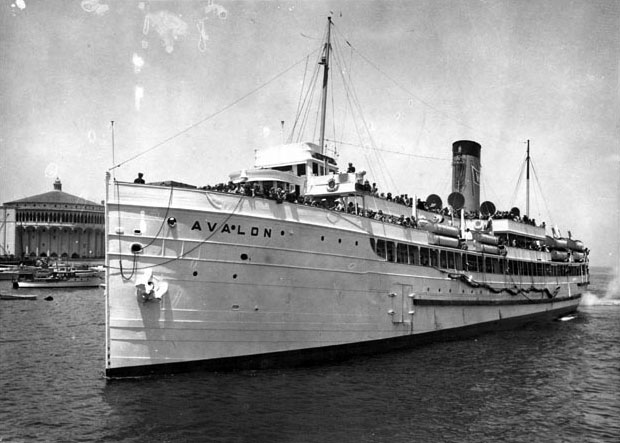 |
|
| (ca. 1929) - View of the S.S. Avalon arriving at Catalina Island with thousands of passengers. The Catalina Casino is in the background. |
Historical Notes Launched as the S.S. Virginia, the passenger ship carried passengers between Chicago and Milwaukee. In 1918, she was requisition by the Navy for use in the first world war and renamed the U.S.S. Blueridge. However, to get her through the St. Lawrence River locks, her bow and 6 feet of her stern had to be cut off and later reassembled. While waiting for orders in Boston harbor, the Navy finally decided she was no longer needed and she was sold as surplus to William Wrigley, owner of the famous chewing gum company and Catalina Island. The ship was renamed Avalon and was sent from New York via the Panama Canal, arriving April 5, 1920 and moored at the Catalina Terminal. However, her debut would not take place until the arrival of William Wrigley Jr. On April 15, 1920, the Avalon left on her first trip to Catalina, taking her full capacity of 3,000 people.*^# |
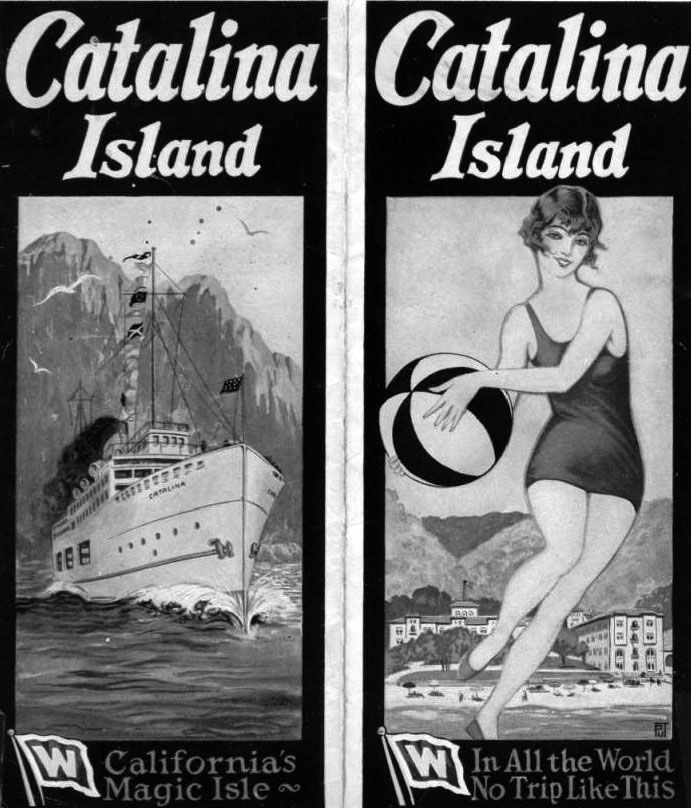 |
|
| (1920s)^^ - Brochures advertising Catalina Island: "California's Magic Isle" - "In All the World No Trip Like This" |
S.S. Catalina
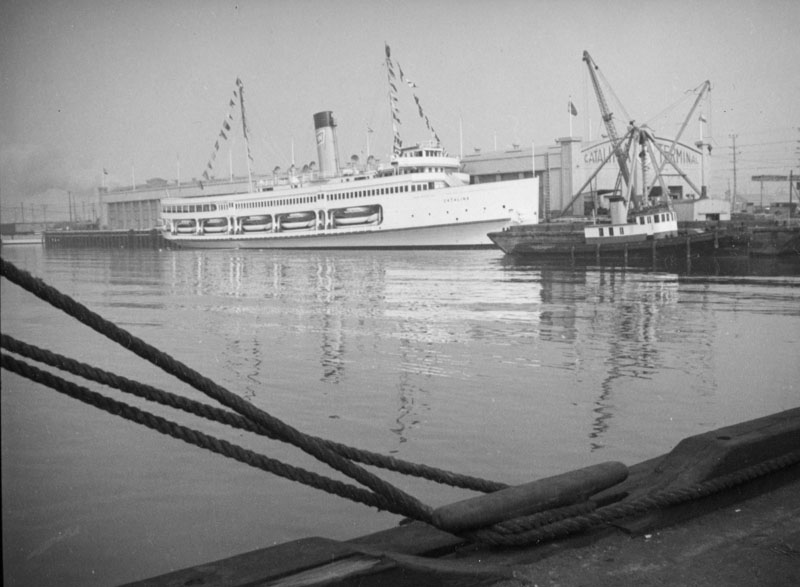 |
|
| (ca. 1924)* - View of the S.S. Catalina docked at the Los Angeles Harbor. |
Historical Notes Commonly referred to as the Great White Steamer, the ship was specially built by William Wrigley to serve his Catalina Island as a passenger ferry. She was christened on May 23, 1924. During World War II, she was requisitioned for use as a troop carrier, but in 1946 she resumed her voyages to Avalon.*^^ |
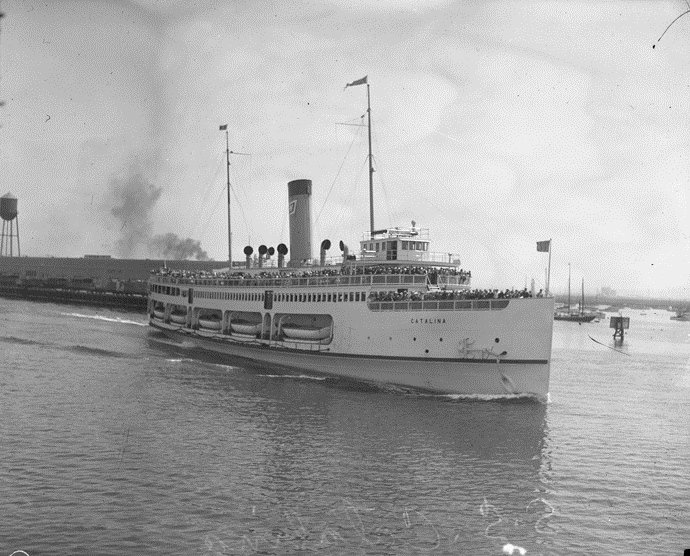 |
|
| (1924)^# - Side view of William Wrigley's steamship S. S. Catalina pulling off of pier with crowd of people on the decks. |
Historical Notes In the late 1920's tourist traffic to the Catalina Island was increasing at the rate of 20% annually. In July, August and September of 1929, the S.S. CABRILLO, S. S. AVALON and S. S. CATALINA carried a combined total of 500,000 passengers. The 3 ships offered a total of 5 sailings daily each way.^^* |
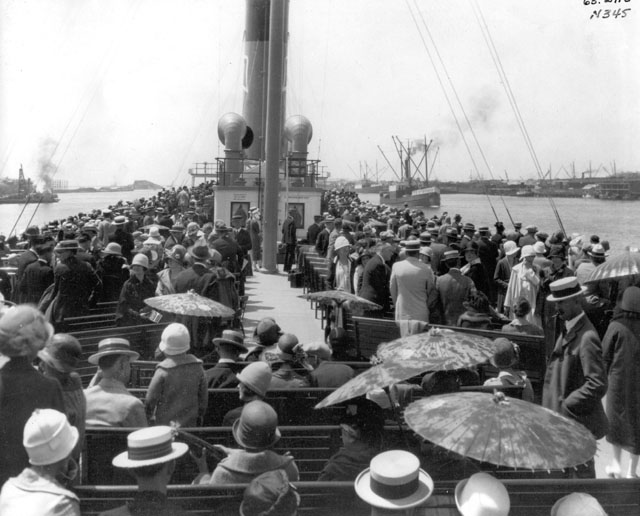 |
|
| (1920s)* - Top deck of the S.S. Catalina filled with passengers as the steamer leaves the LA Harbor for its 23 mile juorney to Catalina Island. |
Historical Notes Among the passengers were movie stars and famous athletes who laughed, danced and drank their way to the island "26 miles across the sea." The S.S. Catalina even hosted 2 United States Presidents at different times. In those days, passengers dressed for the crossing. Gentlemen wore jackets and ties and the ladies dresses and coats, with some carrying umbrellas to protect them from the sun.^^* |
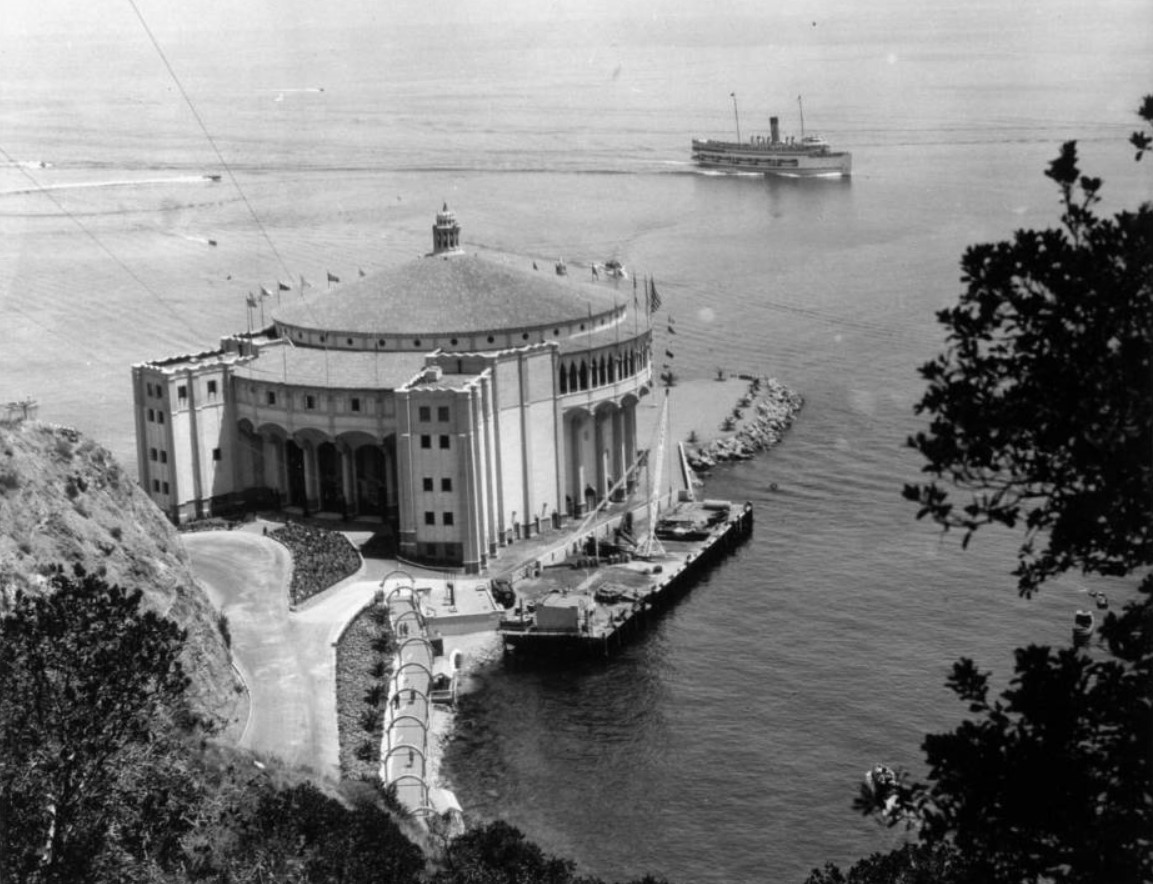 |
|
| (ca. 1920s)* – View showing the S.S Catalina as it passes the Catalina Casino on its approach into Avalon Harbor. |
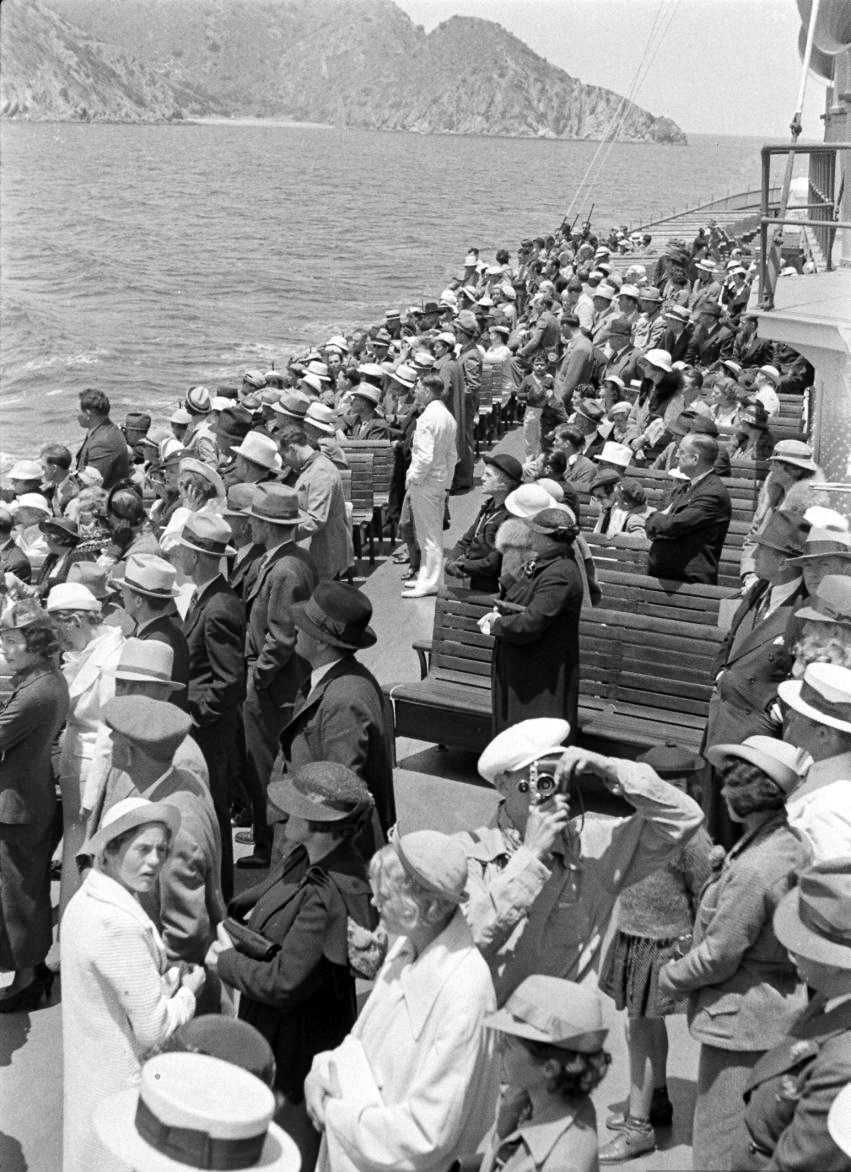 |
|
| (ca. 1930s)^#^ – Passengers take in the views in Avalon Harbor. Photo Credit: Life Magazine |
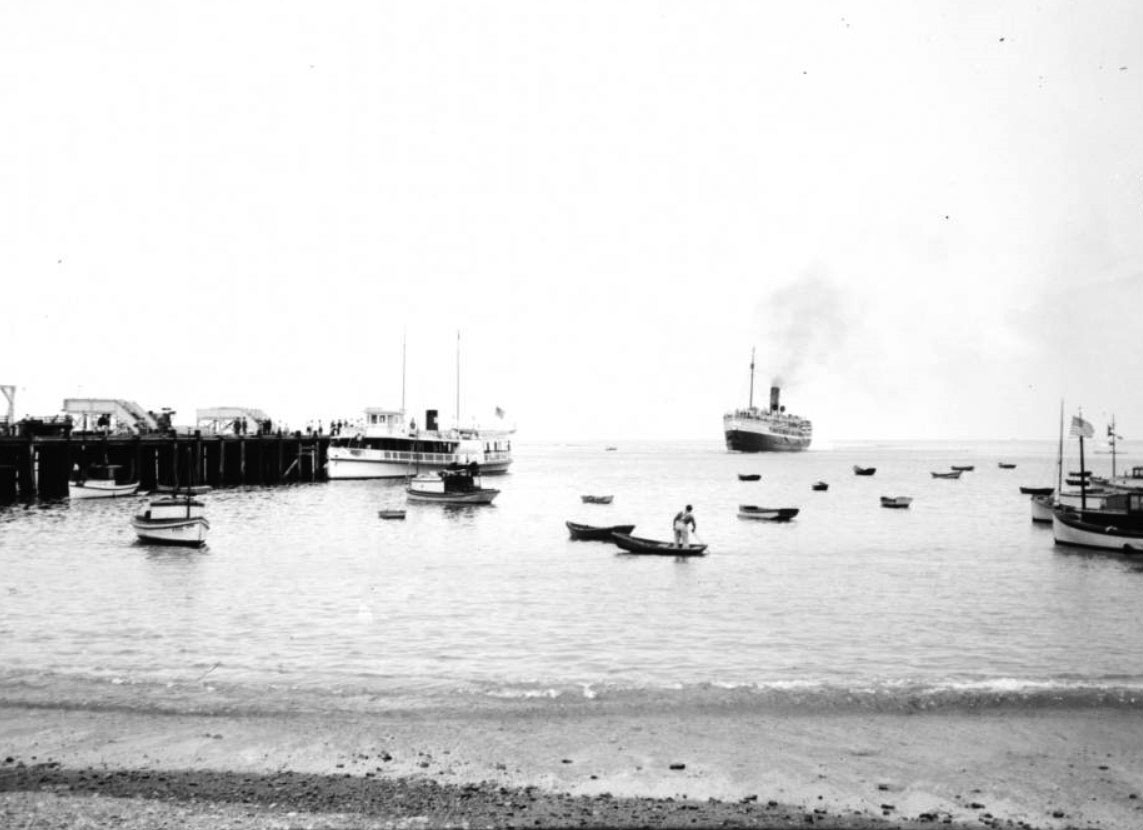 |
|
| (ca. 1920s)* – View showing the S.S. Catalina approaching the pier at Avalon Harbor. Several smaller boats can be seen moored in the water around the dock, and a man can be seen in a boat at center. |
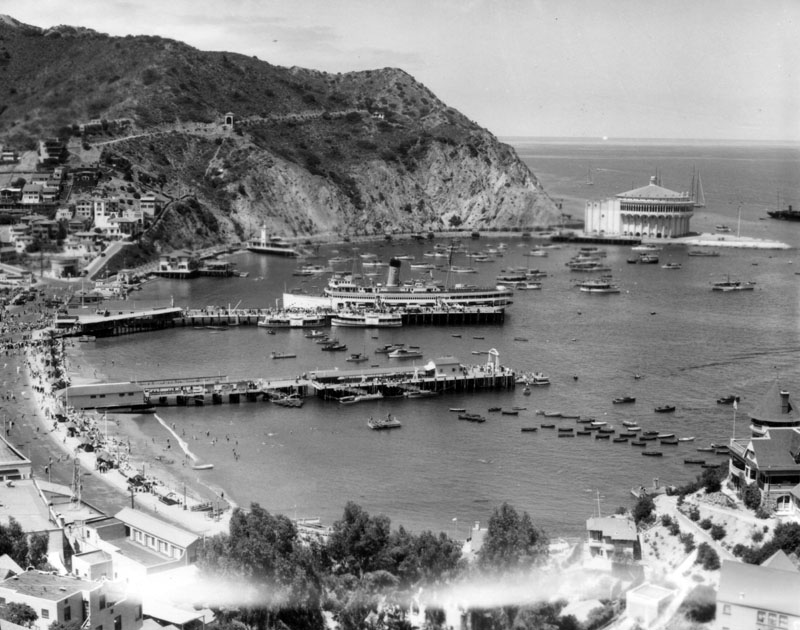 |
|
| (ca. 1929)* - View from a distance showing the just arrived S.S. Catalina docked at the wharf with passengers disembarking. The Catalina Casino, surrounded by the sea on three sides, is visible at the edge of the bay. There are no signs that Sugarloaf Point, the once picturesque, cliff bound peninsula, had ever existed. |
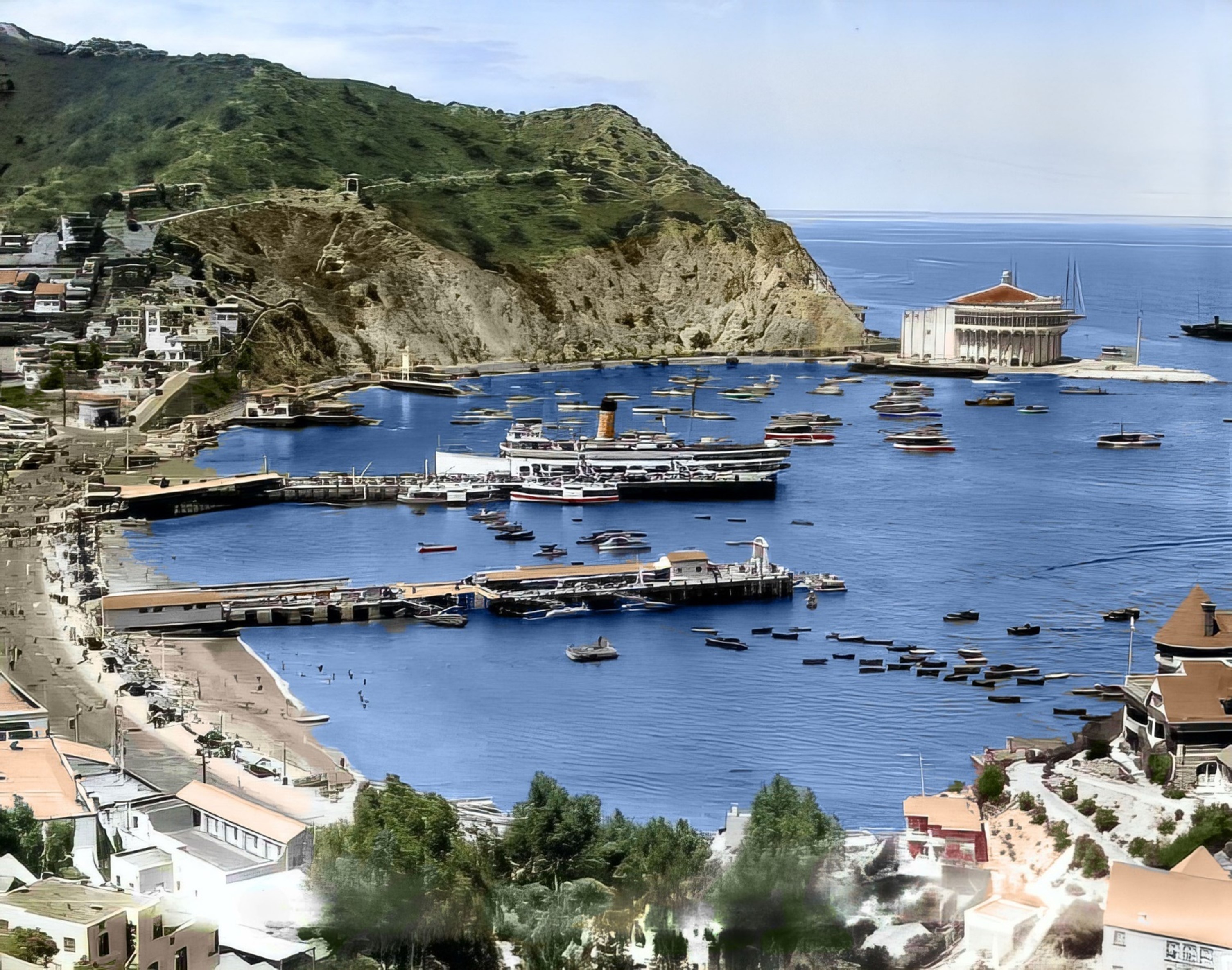 |
|
| (ca. 1929)* - View from a distance showing the just arrived S.S. Catalina docked at the wharf with passengers disembarking. The Catalina Casino, surrounded by the sea on three sides, is visible at the edge of the bay. There are no signs that Sugarloaf Point, the once picturesque, cliff bound peninsula, had ever existed. Image enhancement and colorization by Richard Holoff |
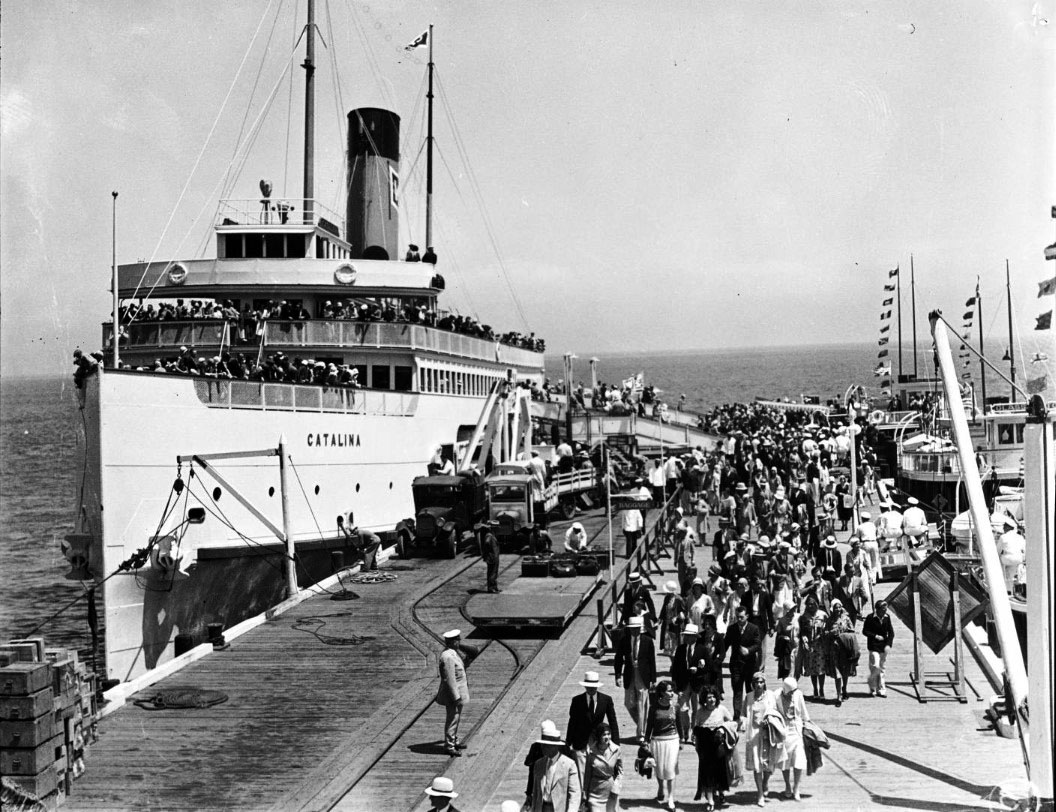 |
|
| (1920s)^^ - View showing hundreds of finely-dressed people disembarking the S.S. Catalina at Avalon Bay wharf, Catalina Island. |
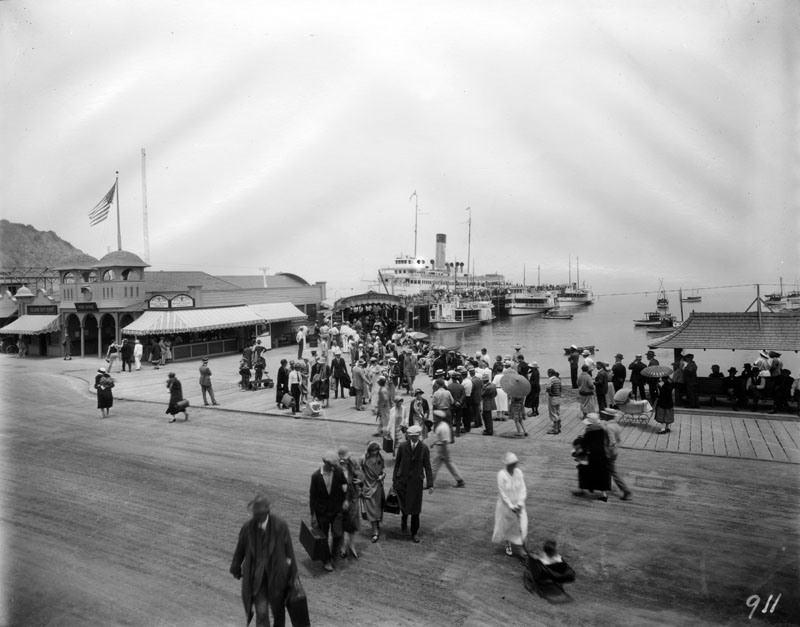 |
|
| (1920s)* - View of the dock, or ferry slip, which is full of passengers that are unloading out of the S.S. Catalina, nicknamed "The Great White Steamer". Dozens of people wait for these travelers, making a pathway for them to walk through. The Post Office and Island Gift Shop can be seen on the left, and several small boats are visible to the right of the wharf. |
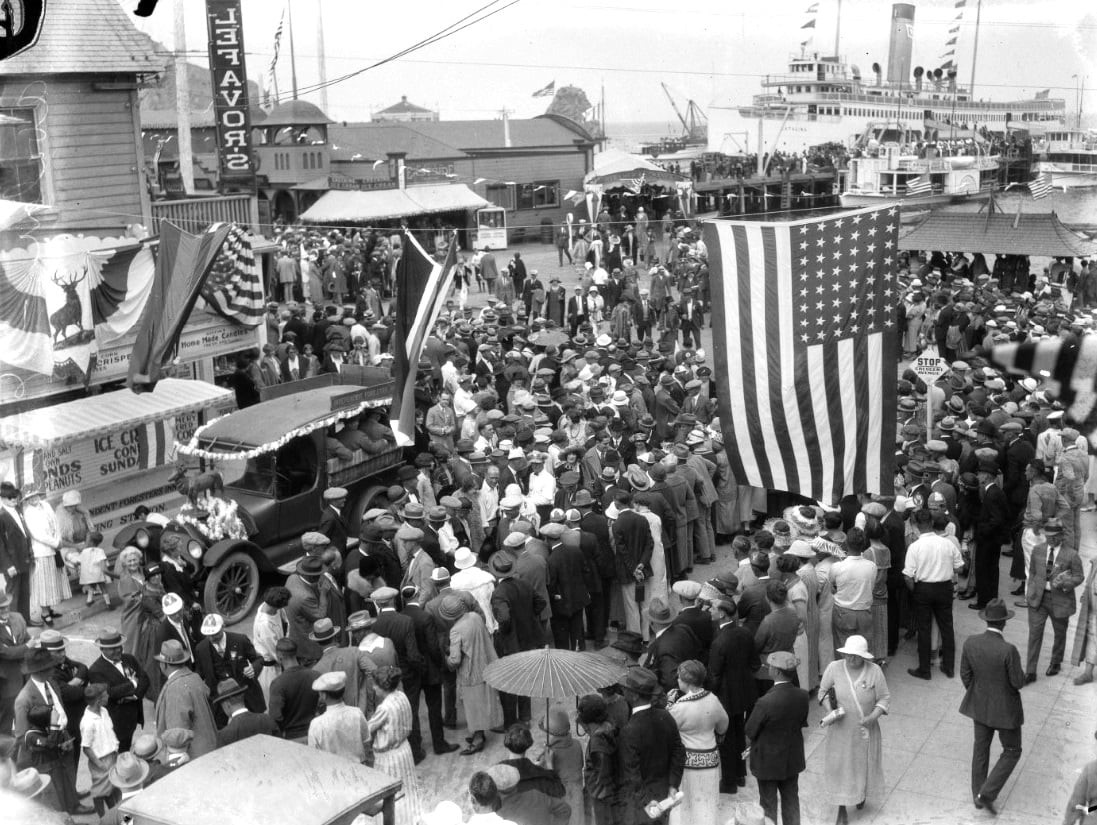 |
|
| (1921)* - Conventioneers arrive at Avalon, Santa Catalina Island, CA, 1921, LAT photo, UCLA Library. |
Historical Notes The S.S. Catalina has been recognized as a Historic-Cultural Monument, No. 213 (Click HERE to see the LA Historic-Cultural Monuments List). It is also listed as California State Historic Landmark No. 894 (Click HERE to see more California Historic Landmarks in LA). She was listed on the National Register of Historic Places in 1976. |
* * * * * |
Catalina Seaplanes
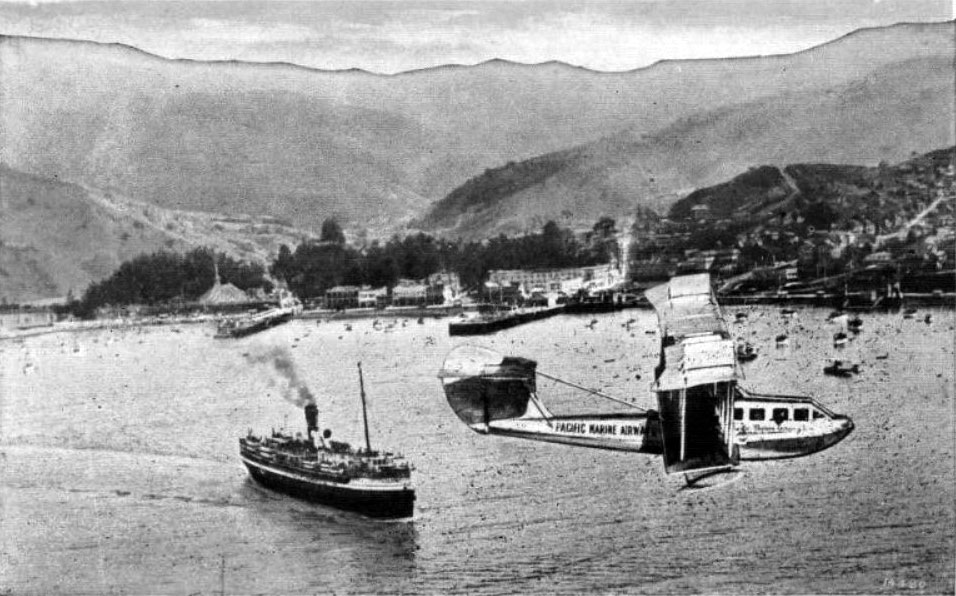 |
|
| (1920s)#^^ - Up-to-date transportation between Catalina Island and the Mainland. The postcard view shows a seaplane flying over Avalon Bay with a steamship seen below. |
Historical Notes Seaplanes were another popular option of tansportation to Catalina Island. Charlie Chaplin’s half-brother Syd began the first seaplane service to Catalina in 1919. It operated only for a couple of summers, but other firms moved in to operate the service until 1931.^*^ |
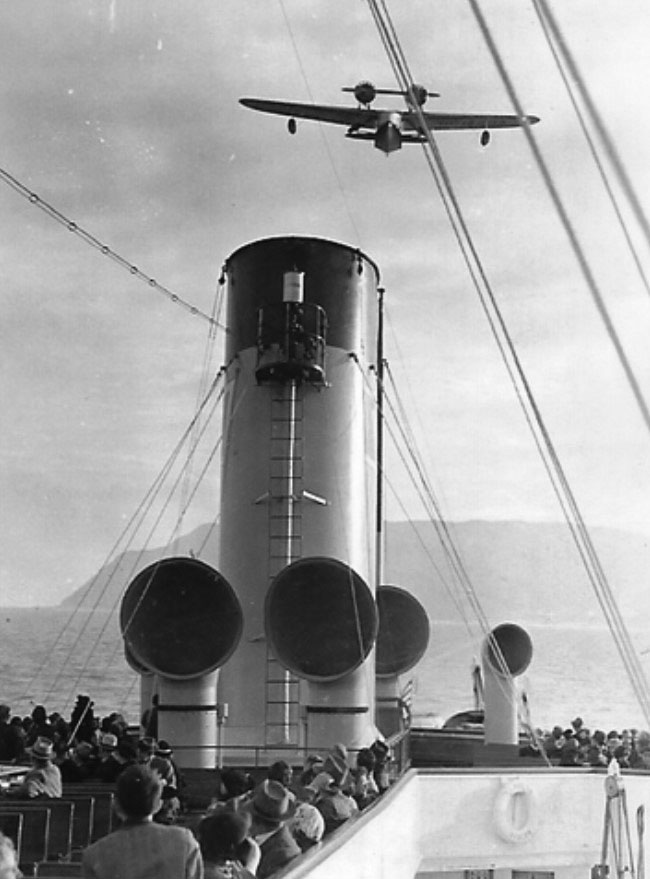 |
|
| (ca. 1930s)*^* – View showing a Douglas Dolphin seaplane seen from the deck of the S.S. Avalon with Catalina Island in the background. |
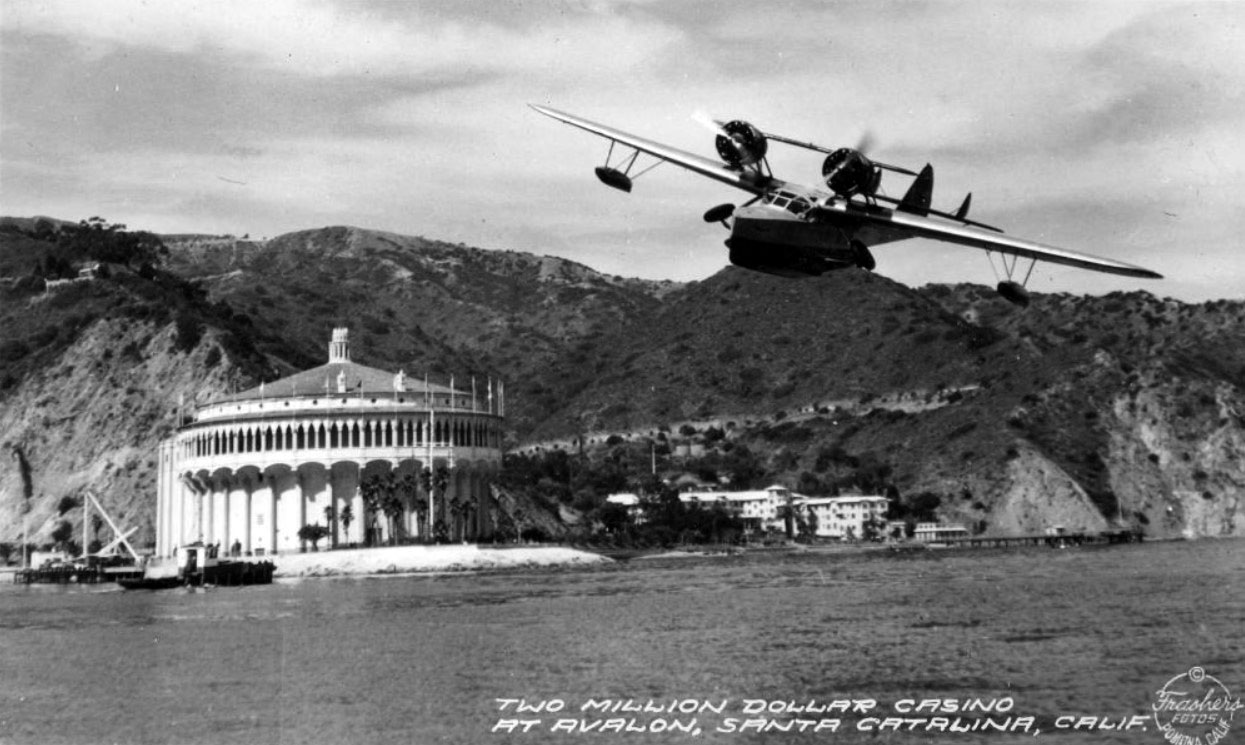 |
|
| (1930s)#^^ - Postcard view showing a seaplane arriving with tourists at Avalon Bay in front of the Catalina Casino. |
Historical Notes In 1931 the island’s owner, Phillip K. Wrigley, began the Wilmington-Catalina Airline, Ltd. through his Santa Catalina Island Company. The airline provided air transportation between the Mainland and Catalina.^*^ |
Hamilton Cove
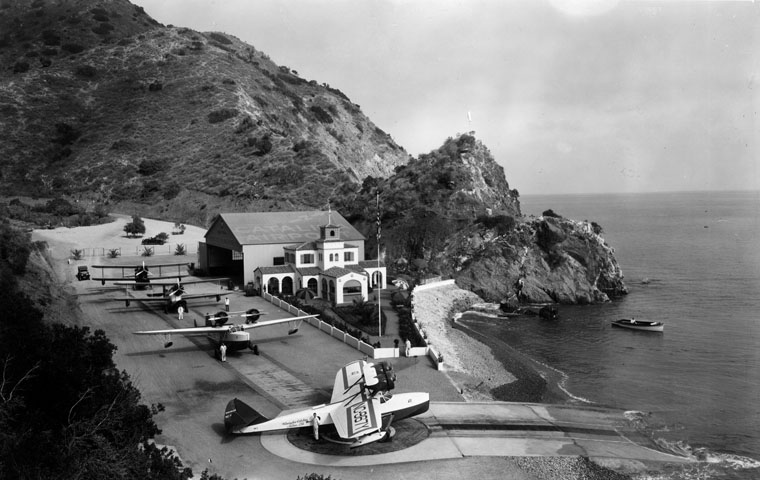 |
|
| (ca. 1931)* - Scenic view of Catalina Airport on Santa Catalina Island. Four planes are parked on a small runway, with three men, each standing by a plane. One man points to writing on the plane which reads, "Wilmington-Catalina Airline, Ltd." |
Historical Notes Philip Wrigley (son of William Wrigley, Jr.) helped design a unique airport at Hamilton Cove, the second cove north of Avalon. This airport was designed to accommodate the Douglas Dolphin amphibian planes of the Wilmington-Catalina Air Line, Ltd., a Wrigley-operated firm. The twin engine Dolphins landed just offshore and would taxi up a ramp to a large turntable mechanism. The airplane would then be rotated until it was facing the water and ready for a trip back to the mainland. A small Spanish-style terminal building welcomed residents, business people and tourists to Catalina.*^* Catalina Airport was soon described as “the smallest airport with the longest landing field (the Pacific) in the world.”^*^ |
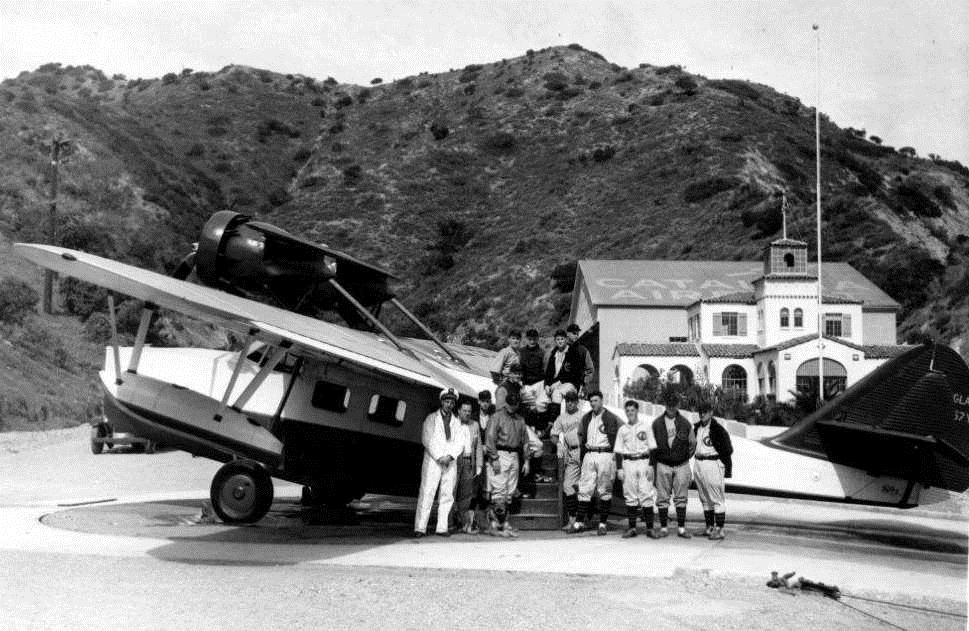 |
|
| (ca. 1931)*^* - William Wrigley's Chicago Cubs at the Hamilton Cove Airport. |
Historical Notes In 1921 Wrigley moved the Spring Training site of his professional ball club, the Chicago Cubs, to Catalina. That same year, he also purchased the Los Angeles Angels who he would build another Wrigley Field for in South Los Angeles (1925).*^ Click HERE to see more in Baseball in Early L.A. |
 |
|
| (1931)^#^ - Seaplane landing near the new "Two Million Dollar Casino" in Avalon. |
Historical Notes Aircraft desinger Donald Douglas designed the main seaplane used by Wilmington-Catalina Airline, the Douglas Dolphin. The twin-engined seaplane was the first of his planes to be used as a commercial passenger airliner. Its interior was well-appointed and could comfortably seat 10 passengers for the princely fee of $5.00 for a one-way trip to Catalina in 1938.^*^ |
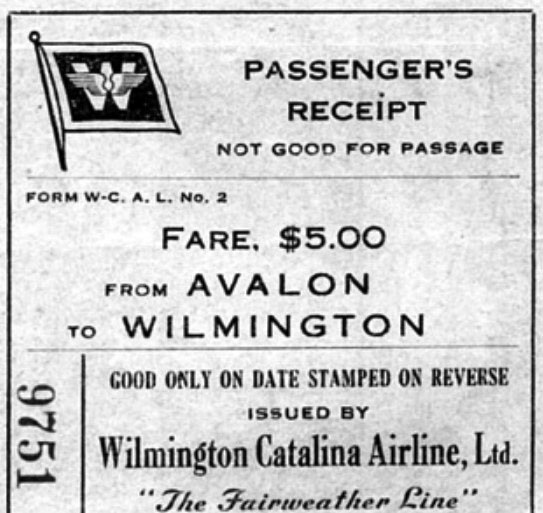 |
(ca. 1938)^*^^ - Passenger receipt for a one way seaplane trip from Avalon to Wilmington on Wilmington Calalina Airline, Ltd. "The Fairweather Line". Fare - $5.00
|
|
Historical Notes In August 1940, plans that had been made to expand aviation operations on the island to include land-based airplanes started to become a reality when construction began for an airport located on the island’s interior. The Airport in the Sky was completed in 1941, the airline operation was renamed Catalina Air Transport and the future looked bright. Until December 7, 1941, when everything changed. Within a couple of weeks after the Pearl Harbor attack, the steamships were stopped from transporting passengers, and by September 1942, no civilian planes were allowed to land, effectively shutting down the entire island. It had become a closely patrolled federal military zone. Eventually, several military outposts were established there to conduct training for the duration of the war. The Airport in the Sky was shuttered, though it would reopen as a full-service general aviation facility in 1946. |
Click HERE to see more in Aviation in Early L.A. |
Tuna Club
 |
|
| (ca. 1908)^^ – View showing the newly constructed Tuna Club (center of photo) with Sugarloaf Point in the background. |
Historical Notes The Tuna Club of Avalon marks the birthplace of modern big game sportfishing in 1898. Led by Dr. Charles Frederick Holder, the club's founding members adopted the rules of conduct stressing conservationist ethics and sporting behavior. Today, their work remains the basis for the sport's internationally accepted principles.*^^ |
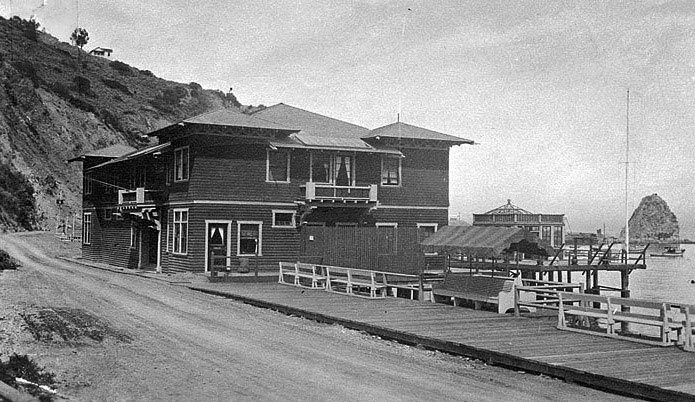 |
|
| (1928)^#^ - Ground view showing the Tuna Club. In the background can be seen the 2nd Catalina Casino under construction adjacent to ‘Little Sugarloaf’. |
Historical Notes The Tuna Club was founded by Charles Frederick Holder in 1898. Early members of the Avalon Tuna Club included Zane Grey, Bing Crosby, Charlie Chaplin, Stan Laurel, Hal Roach, Cecil B. De Mille, Theodore Roosevelt, Herbert Hoover, George S. Patton and Winston Churchill.*^ |
 |
|
| (1938)#^^ – Postcard view of the Catalina Island Tuna Club, also known as the Avalon Tuna Club. |
Historical Notes The clubhouse is located at 100 St. Catherine Way in Avalon. It is listed on the National Register of Historic Places listings in Los Angeles County, since April 2, 1991. It is also listed as California Historical Landmark No. 997 (Click HERE to see more California Historical Landmarks in Los Angeles County).*^ |
* * * * * |
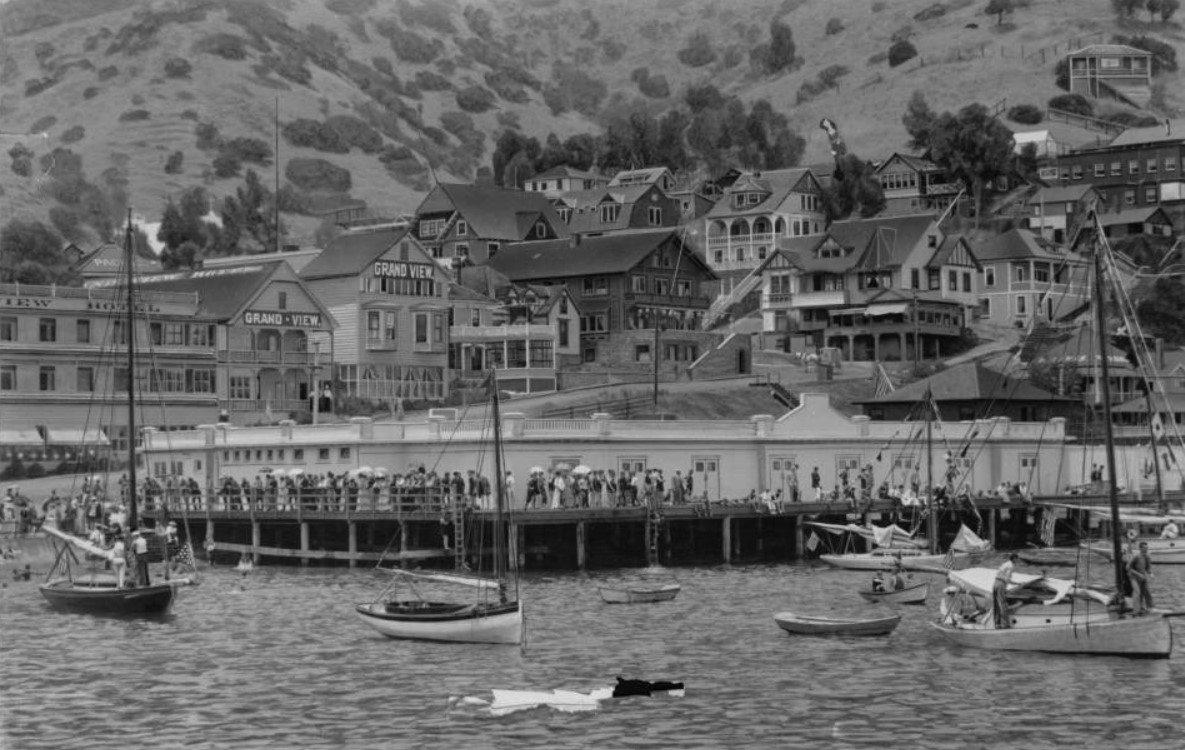 |
|
| (Early 1900s)^^ - Photograph of a view of the shore of Avalon bay with buildings in the background. The calm water of the bay can be seen in the foreground, with several small sailing vessels visible. A large crowd of people is gathered near a railing around a large, low building on the water at center. In the background, man small houses and shops can be seen on the side of a hill. The Grand View Hotel can be seen at left. In the distance, the buildings thin out and several a hillside covered sparsely with bushes and trees. |
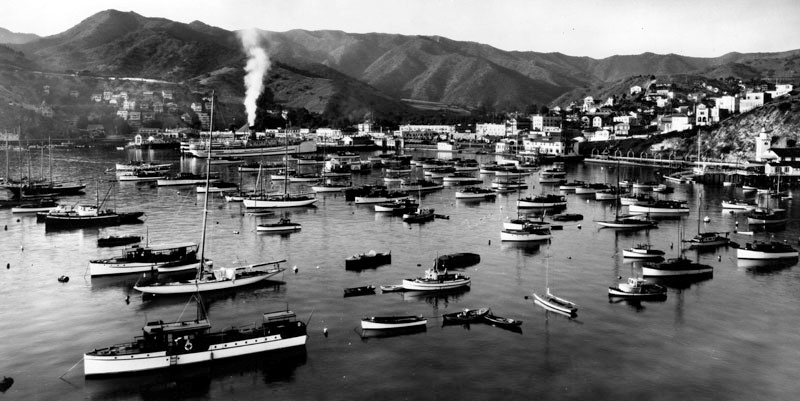 |
|
| (1933)* – Panoramic view showing a multitude of boats in Avalon Bay, including a steamship docked at the pier. Small houses as well as various tourist-oriented businesses and office buildings appear close to the shoreline, with several larger apartment complexes nestled in the hills farther away. |
 |
|
| (ca. 1929)*## – Postcard view showng Zane Grey’s adobe house in the hills above Avalon Bay, Catalina Island. |
Historical Notes Pearl Zane Grey was an American author best known for his popular adventure novels and stories that were a basis for the Western genre in literature and the arts; he idealized the American frontier. Riders of the Purple Sage (1912) was his best-selling book. In addition to the commercial success of his printed works, they had second lives and continuing influence when adapted as films and television productions. As of 2012, 112 films, two television episodes, and a television series, Dick Powell's Zane Grey Theater, had been made that were based loosely on Grey's novels and short stories. Grey had built a getaway home in Santa Catalina Island, which now serves as the Zane Grey Pueblo Hotel. He served as president of Catalina's exclusive fishing club, the Tuna Club of Avalon.*^ |
Chime Tower
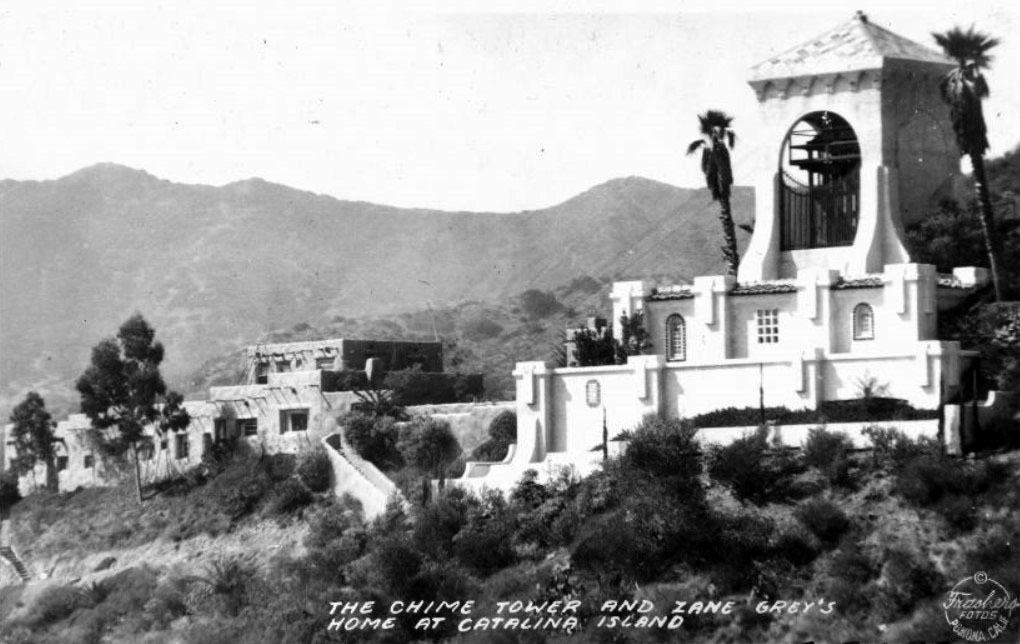 |
|
| (1939)#^^ – View showing the Chime Tower and Zane Grey’s home at Catalina Island. |
Historical Notes Built in 1925, the Chime Tower was presented as a gift to the town of Avalon by Mrs. Ada Wrigley. Located up and across from the Zane Grey Pueblo Hotel, the chimes have been tolling on the quarter of the hour between 8:00am and 8:00pm since 1925. |
* * * * * |
Boos Bros. Cafeteria
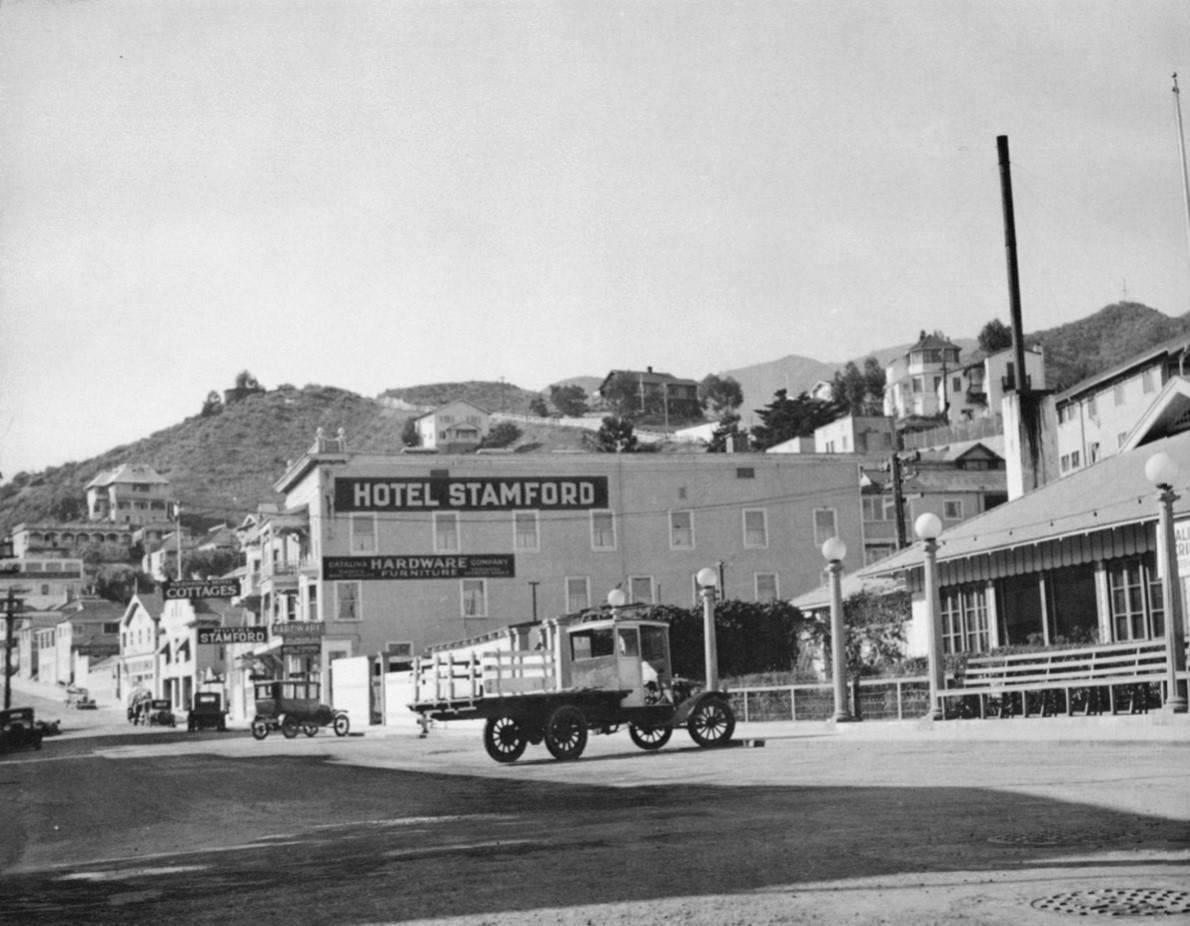 |
|
| (1920s)* – View showing the west side of the 100 block of Metropole Avenue in Avalon. Pictured are the Hotel Stamford, Catalina Hardware Company, the Hermosa Hotel and Cottages, and the Boos Bros Cafeteria on the right with the multiple streetlamps in front. |
Historical Notes In 1906, Horace Boos and three siblings opened one of Los Angeles' first cafeterias. Their idea of a fast food, self-service restaurant consisted of unheard-of impositions for that time: patrons would wait on themselves and return their trays and dishes to the kitchen. The brothers' downtown cafeteria was the first link, in a chain of seven that ultimately stretched from Los Angeles to San Francisco. They opened four more in the downtown area one in Santa Catalina Island, and two in San Francisco. By the 1920s, the chain of cafeterias had become widely known. When Horace Boos died in 1926, the surviving brothers sold the seven cafeterias for a record $7 million to the Childs Corp. In turn, Childs sold two of the cafeterias to Clifford E. Clinton, who launched the Clifton's Cafeteria Chain. Eventually, Henry Boos bought back two, one on Hill Street and the other in Avalon on Catalina Island (seen above). |
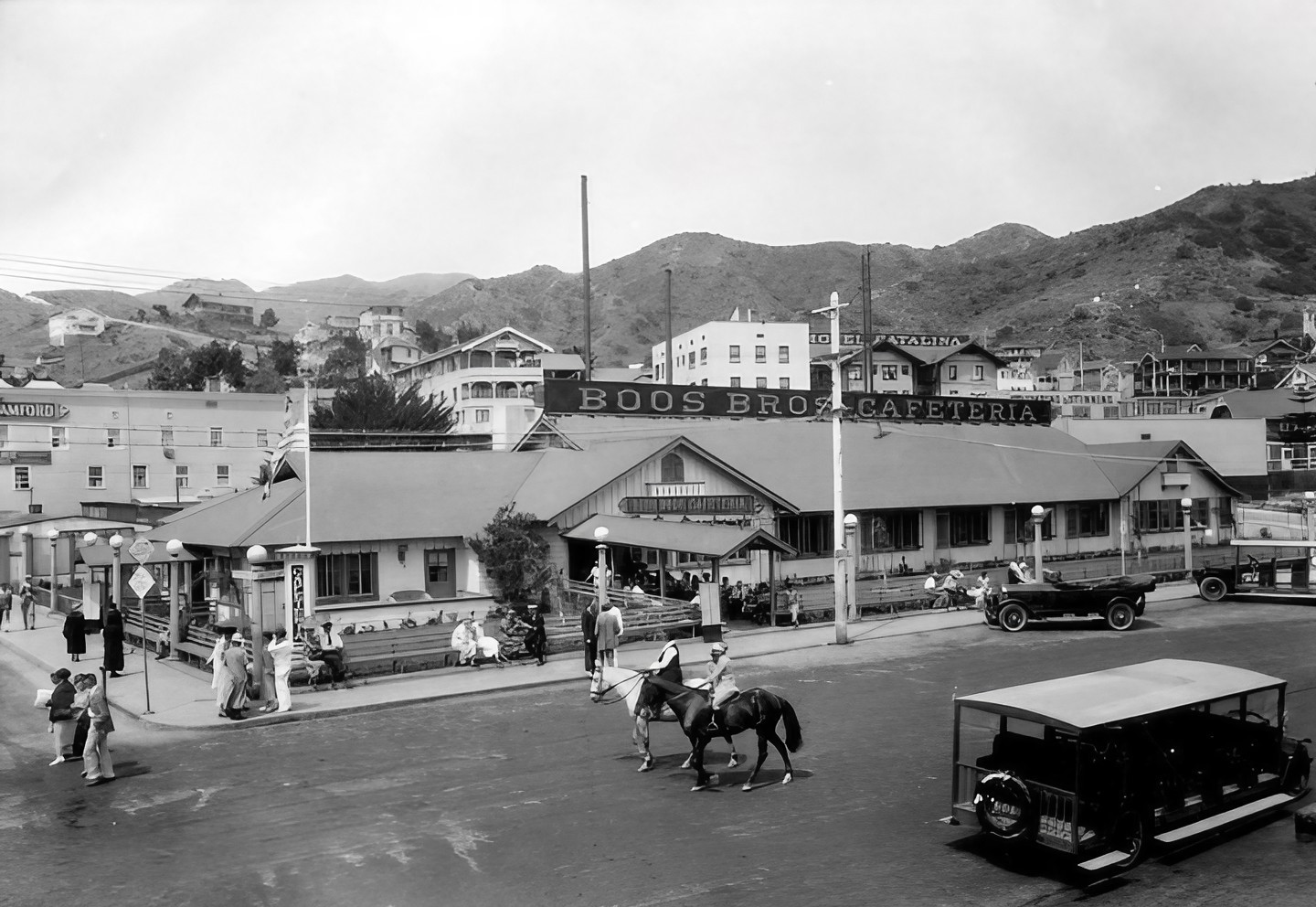 |
|
| (ca. 1930)* - View showing the Boos Bros. Cafeteria, located on the corner of Crescent Ave. and Metropole Ave. in Avalon. Several people can be seen sitting on the long wooden benches, possibly waiting to enter the cafeteria, while others walk along the sidewalk. Two women riding horses share the street with cars and buses. |
Historical Notes The Boos Brothers offered inexpensive fare of a "40-cent dinner", but would call it quits in the late 1940s, before cafeterias began losing popularity due to the arrival of luncheonettes, soda fountains, and fast-food restaurants. |
* * * * * |
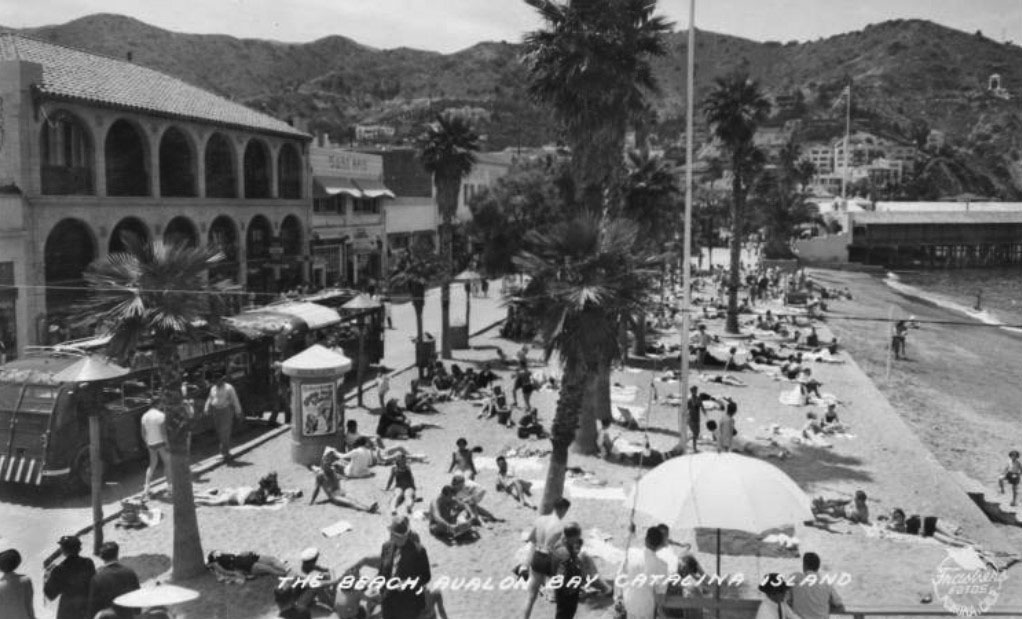 |
|
| (1931)* – Postcard view showing a crowded beach at Avalon Bay. |
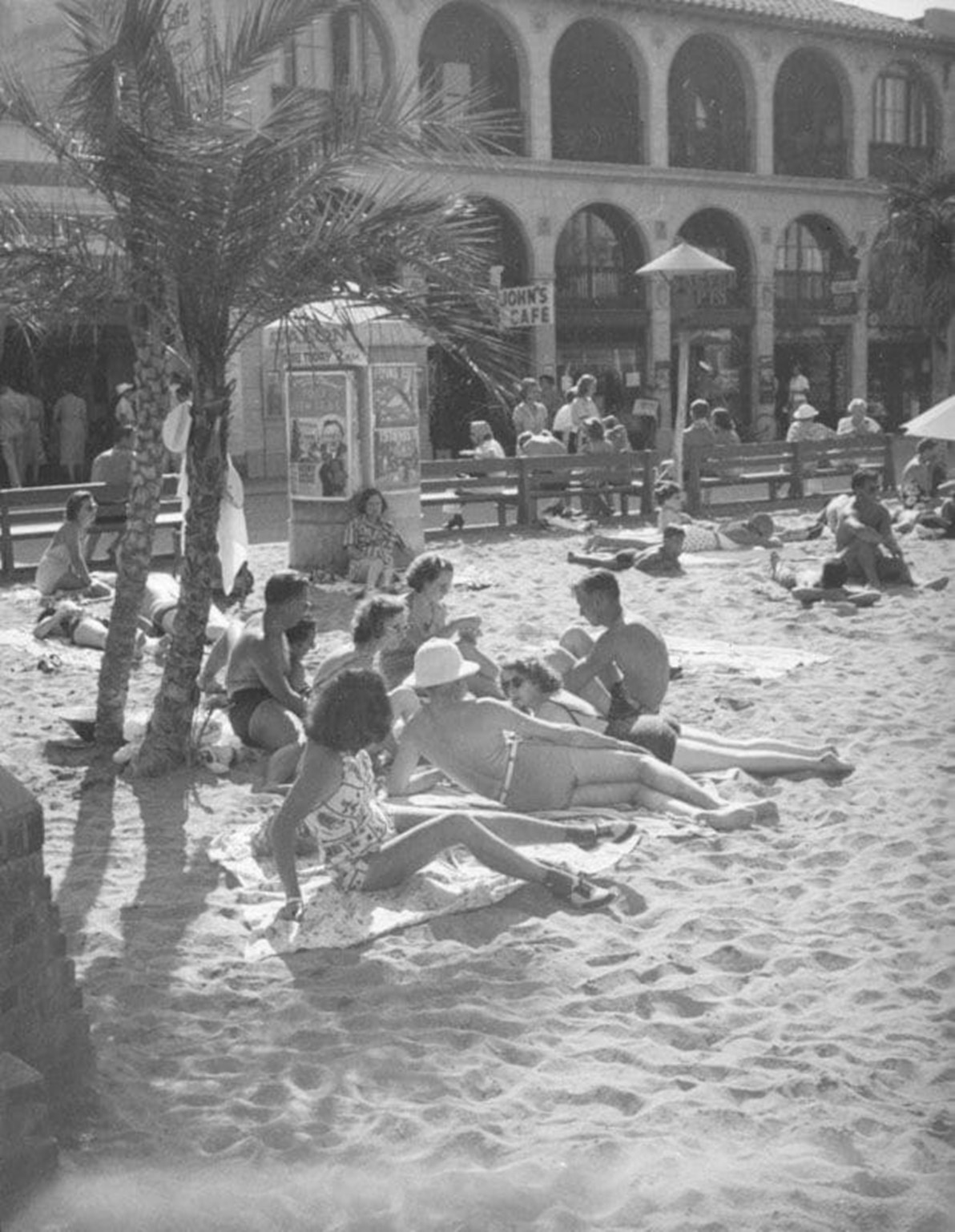 |
|
| (1930s)* - The beach area near John's Cafe in Avalon Bay on Catalina Island. |
* * * * * |
El Elcanto Cafe and Shops (aka El Encanto International Marketplace)
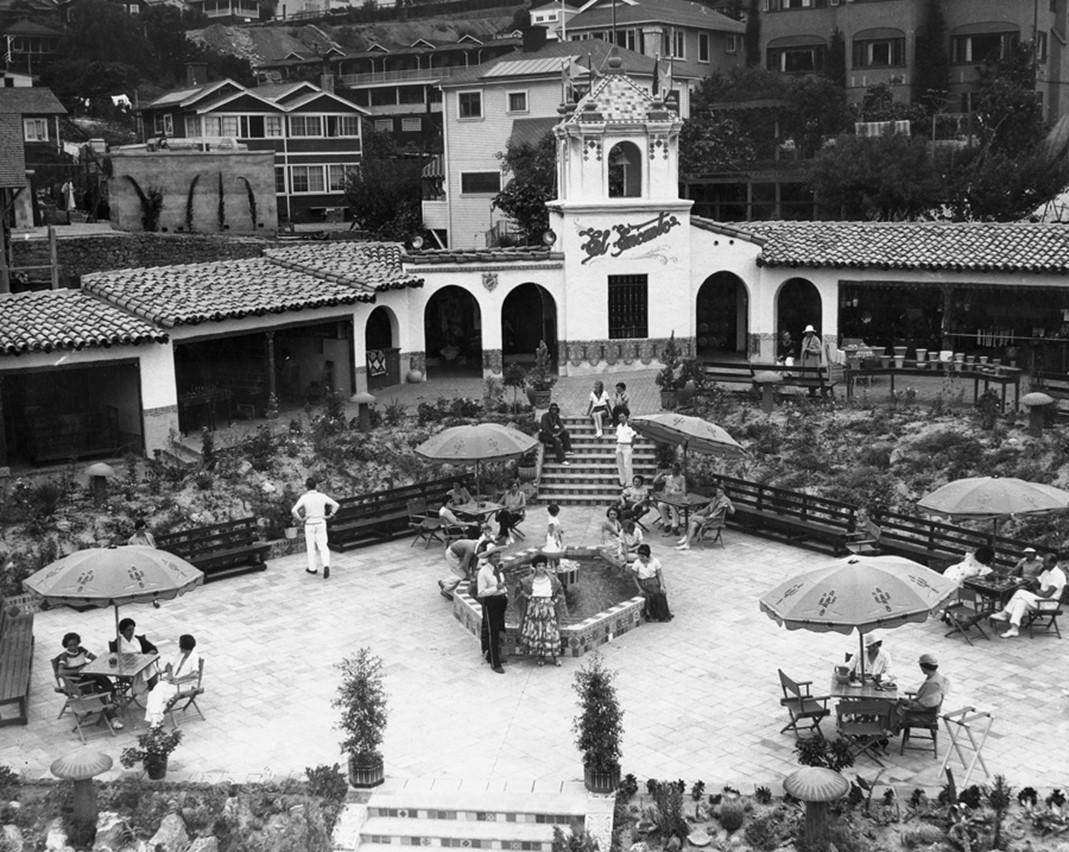 |
|
| (1930s)* - El Elcanto Cafe and Shops with fountain and open air patio, Avalon. |
Historical Notes El Encanto Building was the showpiece of Philip K. Wrigley's early California flare in Avalon. Opened in 1933, the El Encanto was the Santa Catalina Island Company's effort to preserve the traditions and culture of old California. The building radiated the spirit of early California and with the assistance of the island's growing Mexican-American community, El Encanto brought Old California to life for thousands of visitors each season. |
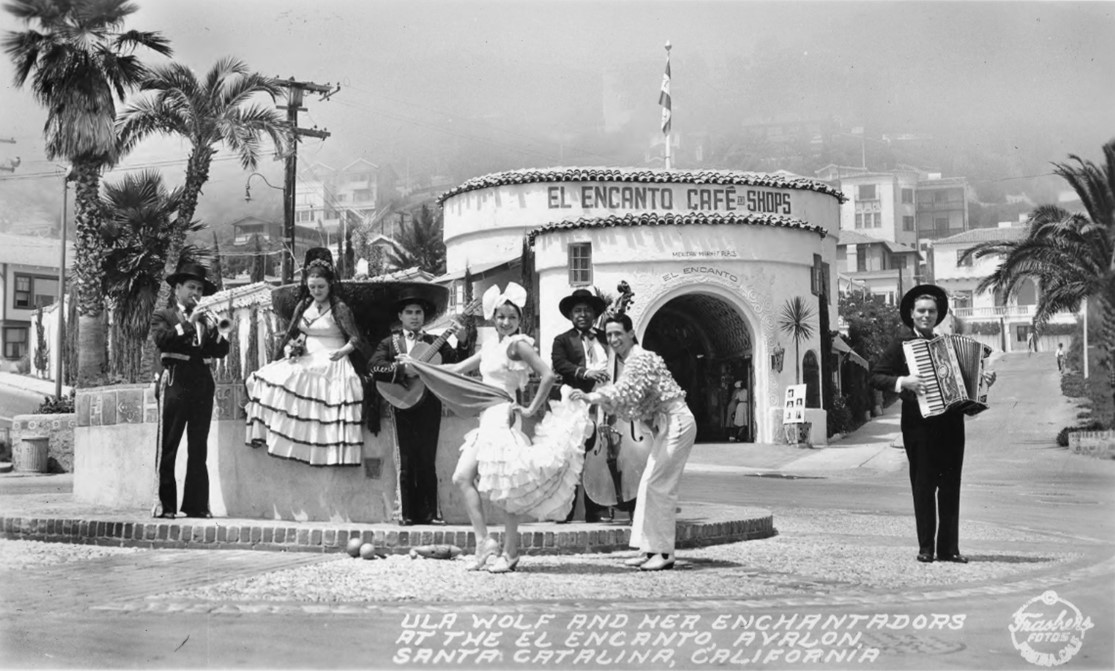 |
|
| (1938)* - Ula Wolf and her Enchantadors at the El Encanto, Avalon, Santa Catalina, California |
Historical Notes Originally known as El Paseo de El Encanto, “Promenade of Enchantment,” El Encanto International Marketplace was dedicated in Aug. 1933. Strolling troubadours, magicians, puppeteers, and artists creating their wares were once a part of El Encanto. Today there are gift & curio shops, and restaurants featuring Mexican and American food in the colorful marketplace, making it a favorite place to shop and dine in Avalon.* |
* * * * * |
St. Catherine Hotel
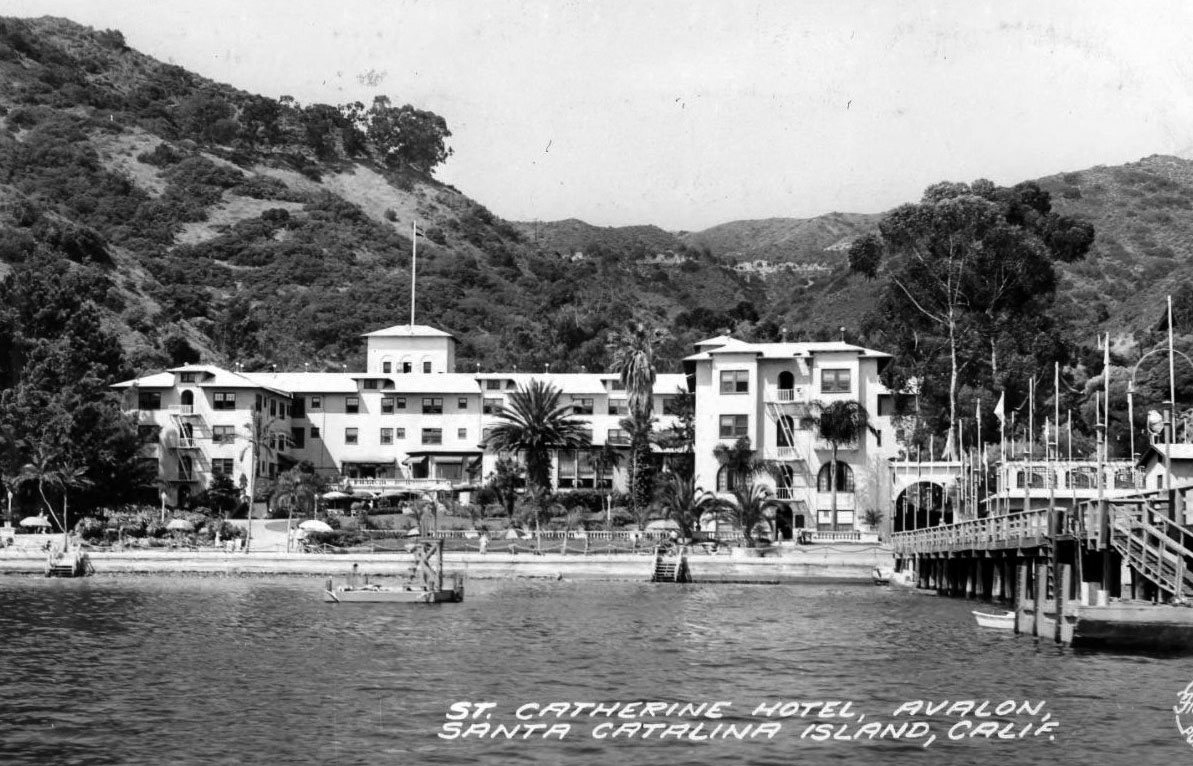 |
|
| (1938)* - Postcard view showing the front of St. Catherine Hotel as seen from a boat in the water. Also seen is what appears to be the hotel's own pier. |
Historical Notes In November of 1915, a devastating fire burned out of control for three days, destroying about a third of the town of Avalon, including the Hotel Metropole. The Banning brothers built the elegant Hotel Saint Catherine to replace it in Descanso Canyon, just around the Point from Avalon. The hotel was put up where the residence of Hancock Banning once stood. |
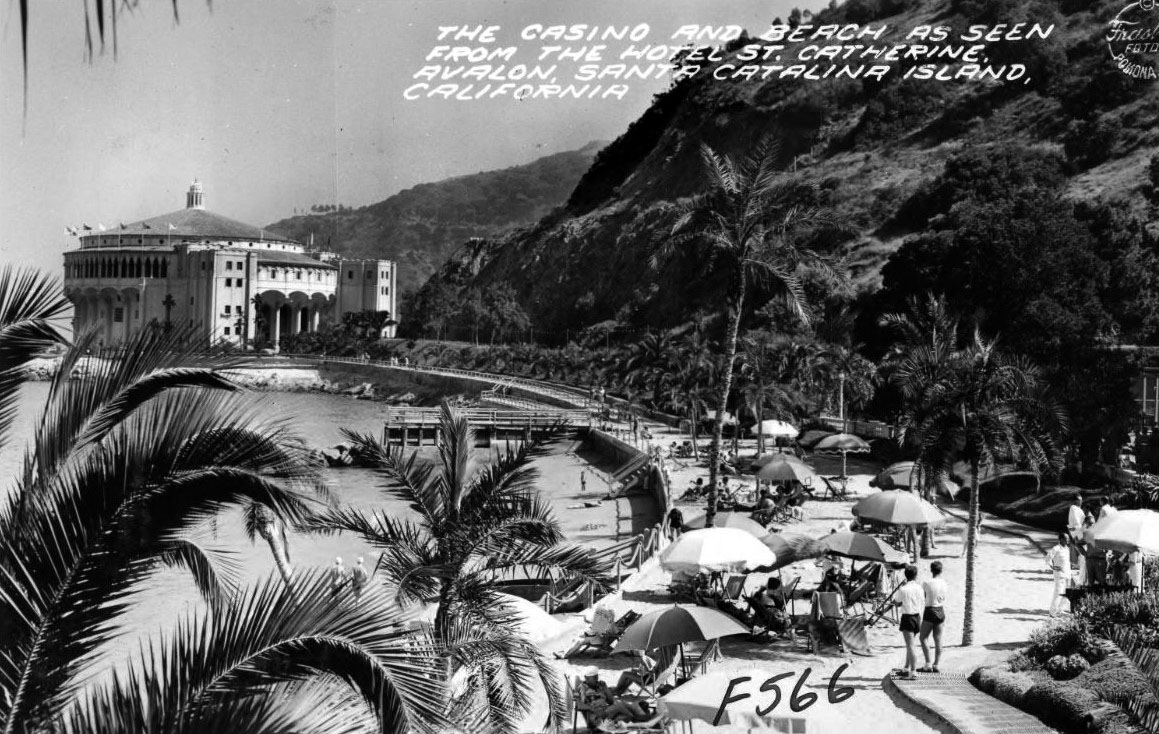 |
|
| (1938)* – Postcard view of the Casino and beach as seen from the Hotel St. Catherine in Descanso Canyon. |
Catalina Casino
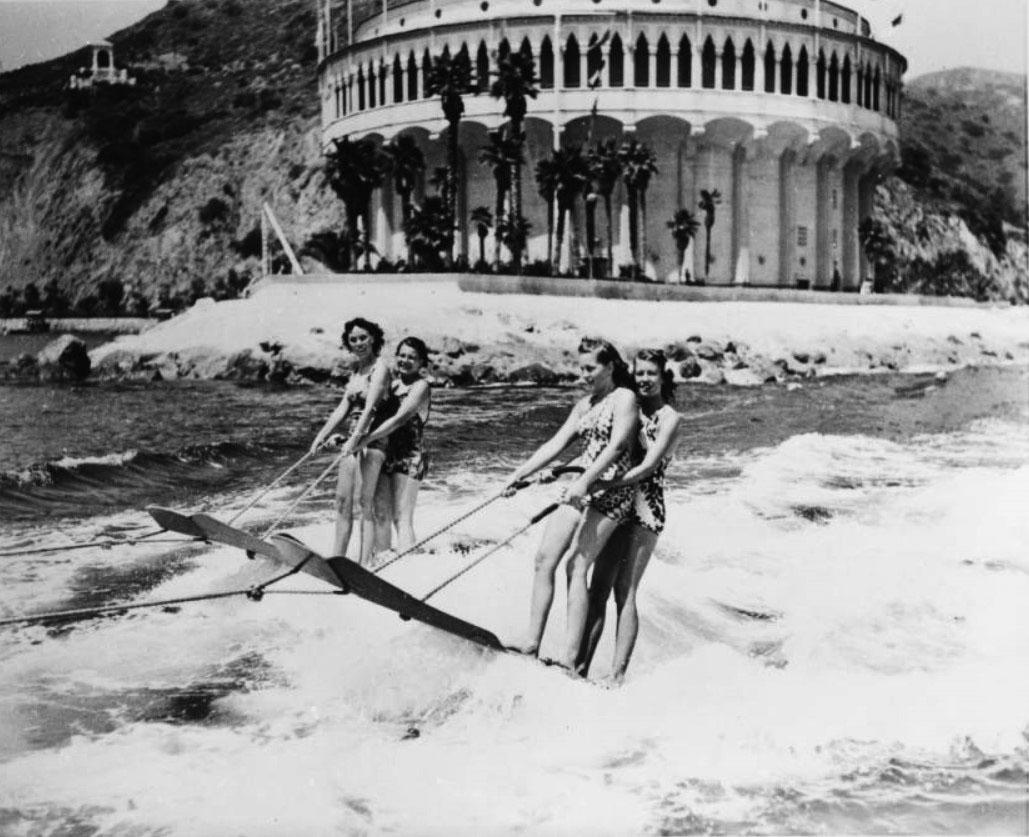 |
|
| (ca. 1930s)* – View showing four women water board skiing in Avalon Harbor with the Catalina Casino in the background. |
Historical Notes During the 1930s, the Casino became a hotspot for Hollywood celebrities and socialites. Movie stars like Cecil B. DeMille, Douglas Fairbanks, and Ronald Colman were frequent visitors, often arriving by yacht. |
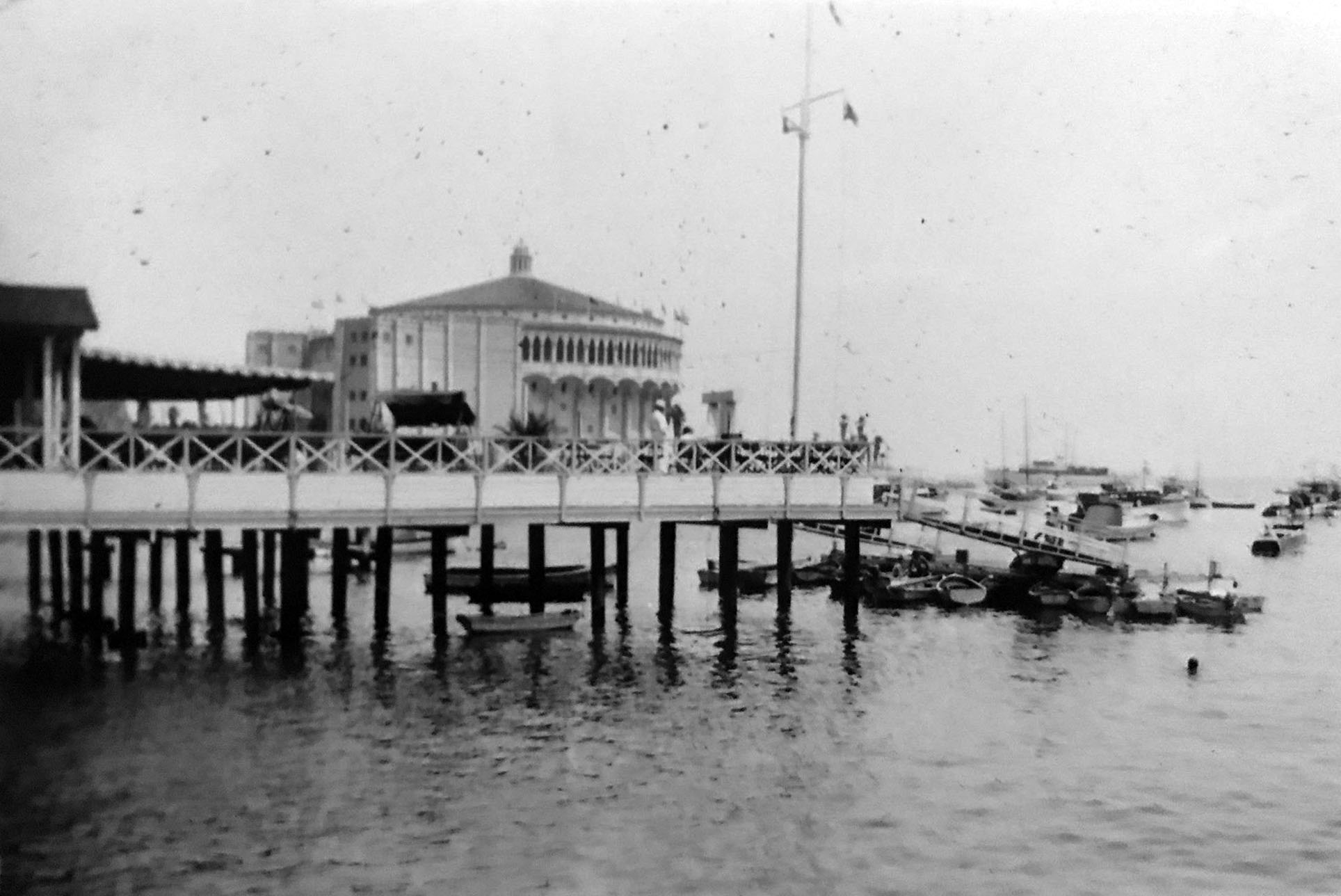 |
|
| (ca. 1930s)^ - Catalina Casino as seen from a boat in Avalon Bay. |
Historical Notes Movie studio tycoons such as Cecil B. DeMille, Louis B. Mayer, and Samuel Goldwyn frequently came by yacht to the Casino to preview their newest cinema productions. It also serves as the island's civil defense shelter, large enough to accommodate Catalina's entire year-round population. Within its walls is stored enough food and water for all Avalon's residents for two weeks. |
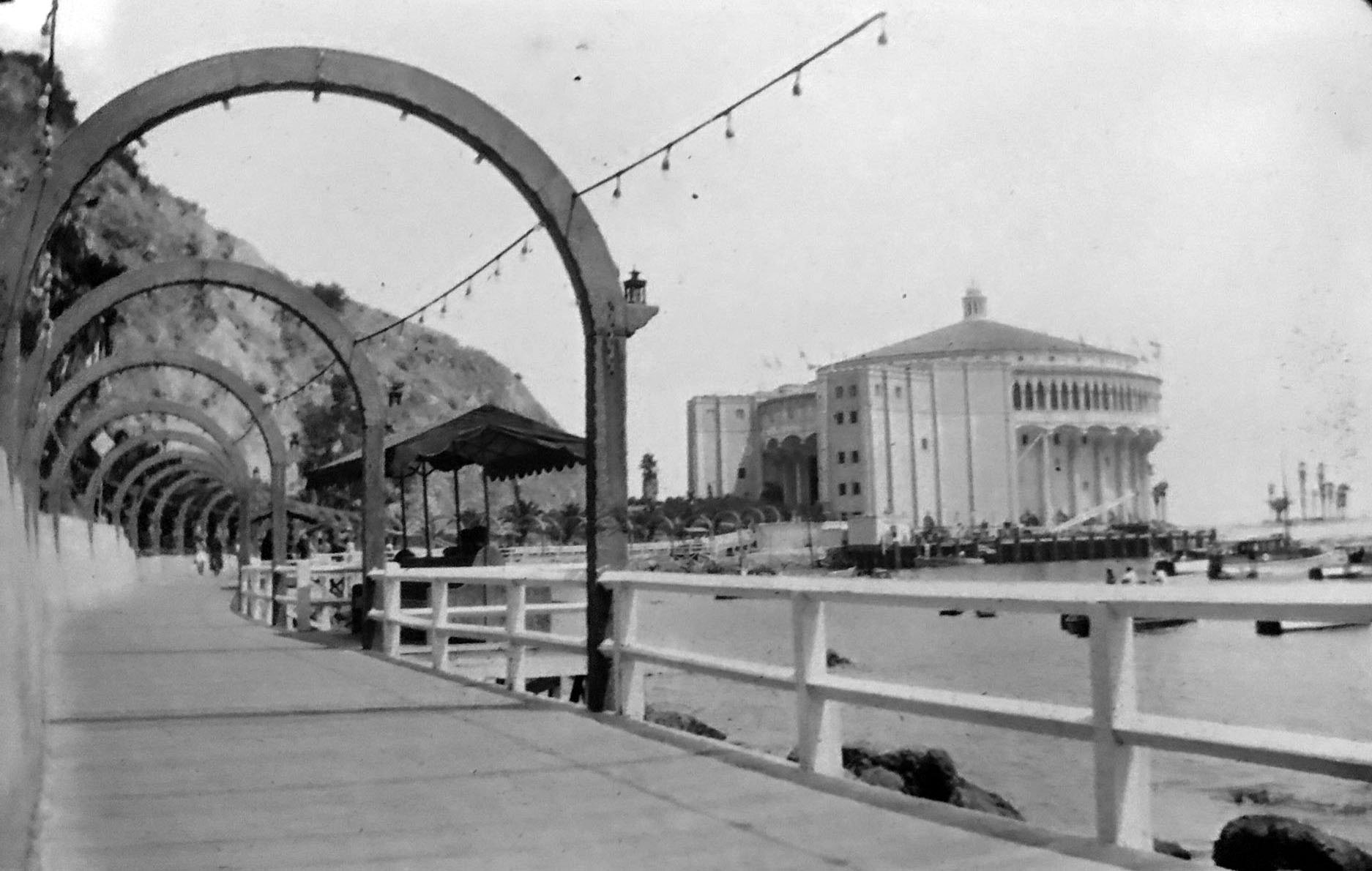 |
|
| (ca. 1930s)^ – View showing the arch-lined walkway leading to the Catalina Casino from the Avalon Bay side. |
Historical Notes The Catalina Casino was built by William Wrigley in 1928, replacing a much smaller version from 1917. Wrigley's original budget for the design and construction was $600,000, but he ultimately spent $2 million—a significant sum at the time. |
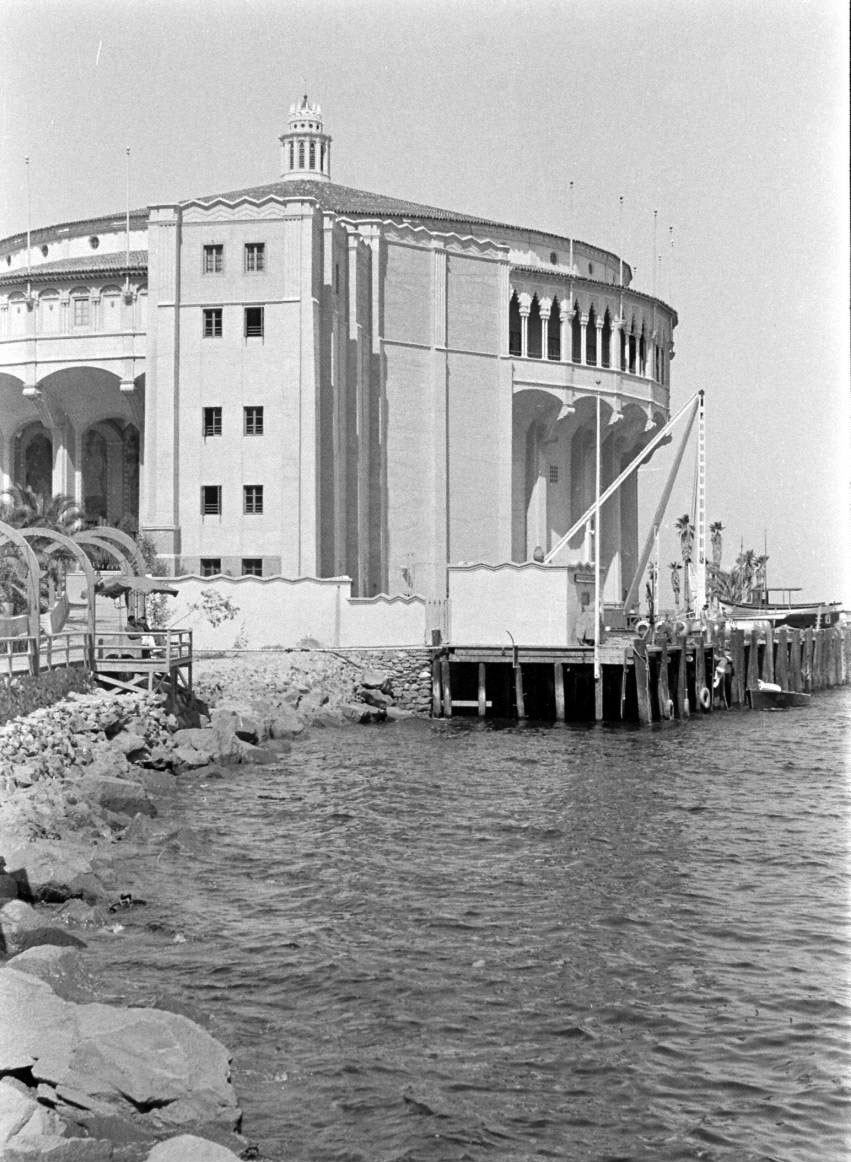 |
|
| (ca. 1930s)^#^ – Close-up view of the Catalina Casino with a height equal to a 12-story building. It was built to serve as a theatre on the main floor and a ballroom and promenade on the upper level. Photo Credit: Life Magazine |
Historical Notes The Catalina Casino was designed by architects Sumner A. Spaulding and Walter Webber in the Art Deco and Mediterranean Revival styles. It was notable for being the first circular building of its time, with a height equivalent to 12 stories |
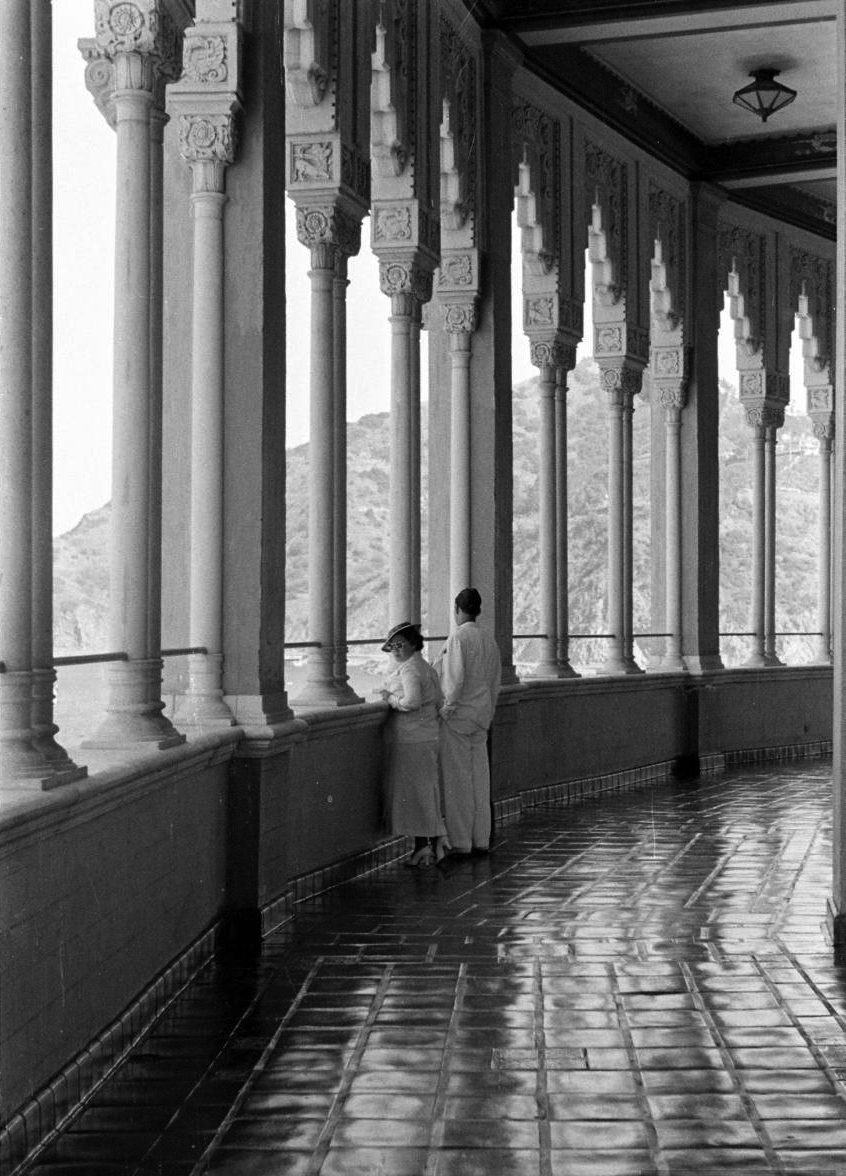 |
|
| (ca. 1930s)* – A couple stands on the balcony of Catalina Casino, looking out toward Avalon Bay. The open balcony, called the "Romance Promenade," encircles the casino building. Photo: Life Magazine |
Historical Notes The "Romance Promenade" is an open balcony encircling the upper level of the Catalina Casino, offering a 360-degree view of Avalon Harbor and the surrounding ocean. Integral to the circular design of the Casino, it is accessed through French doors from the ballroom, allowing dancers to step out for fresh air and breathtaking vistas. Renowned for its romantic ambiance, it was a fashionable spot for couples in the 1930s, contributing to the Casino's glamorous reputation. Today, it remains a highlight of Casino tours, providing spectacular views and continuing to be celebrated as one of Avalon's most romantic spots. |
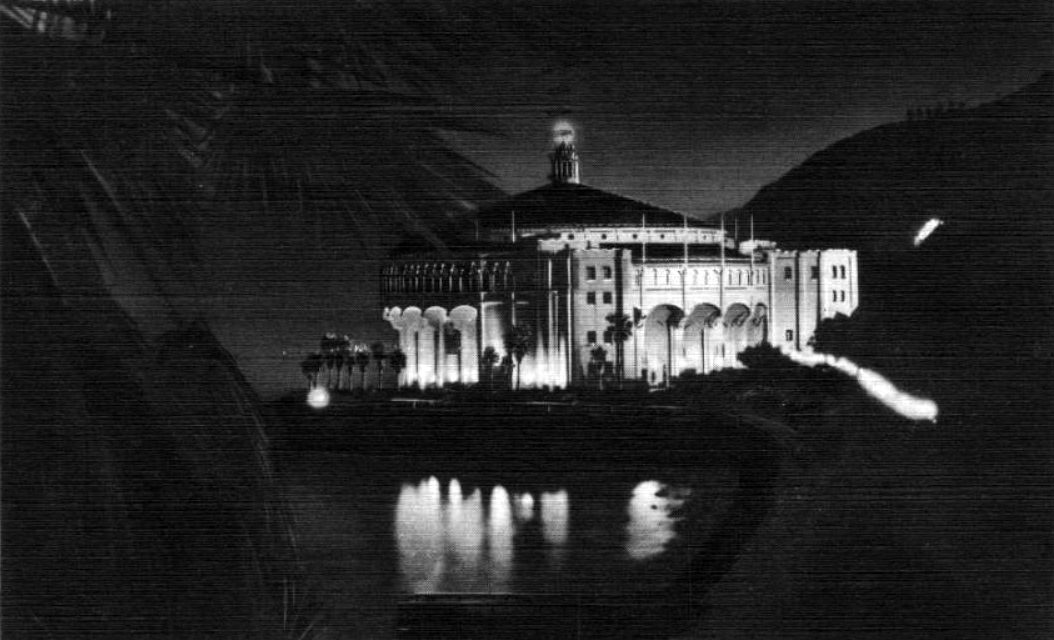 |
|
| (1935)#^^ - Night view of the picturesque Catalina Casino with lights reflecting off the the bay water. |
Casino Ballroom
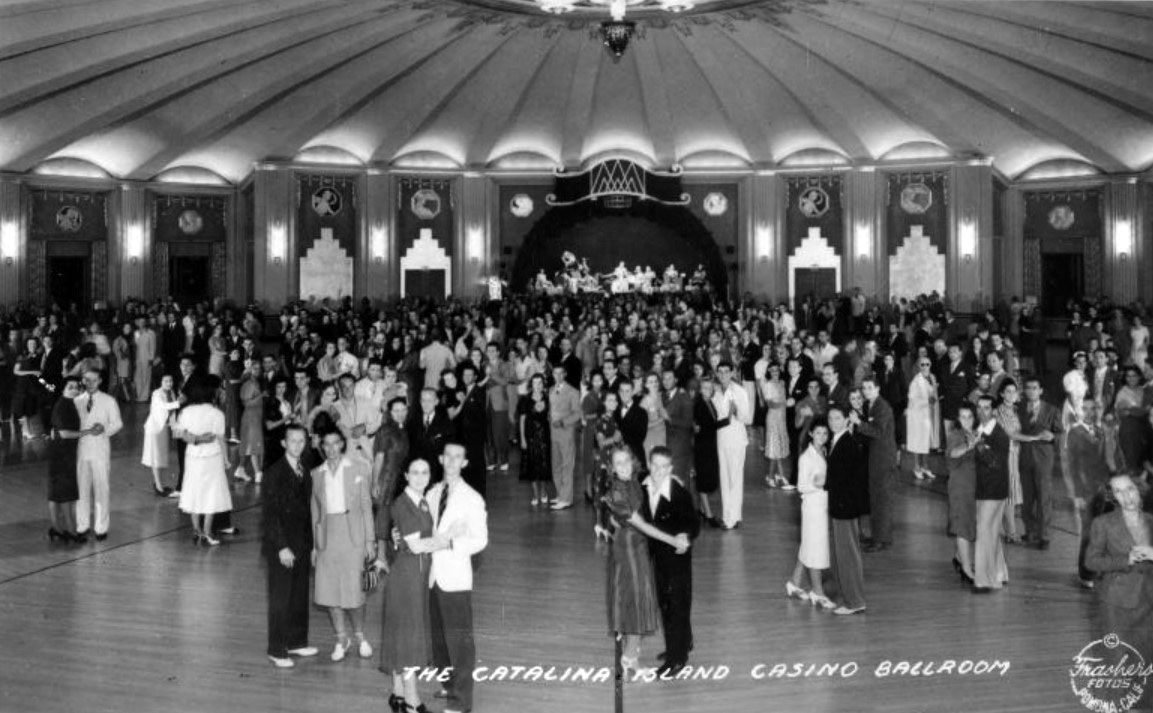 |
|
| (1939)* - Postcard view showing the huge Catalina Island Casino Ballroom floor filled with dancers. A band can be seen in the background. |
Historical Notes The upper level of the Casino building houses the 20,000 square foot Catalina Casino Ballroom. It is the world's largest circular ballroom with a 180-foot diameter dance floor, that can accommodate 3,000 dancers. French doors encircle the room connecting the dance floor with the "Romance Promenade," an open balcony that runs around the building. To reach the ballroom on the top level the Casino building has two ramped walkways, both in enclosed towers that extend out from the circular building. Wrigley took the idea to use ramps instead of stairs from Wrigley Field, his Chicago Cubs stadium. The ramps allowed the large numbers of people using the ballroom to quickly move to and from their destinations. They each have a small lobby areas just below the dance floor level. |
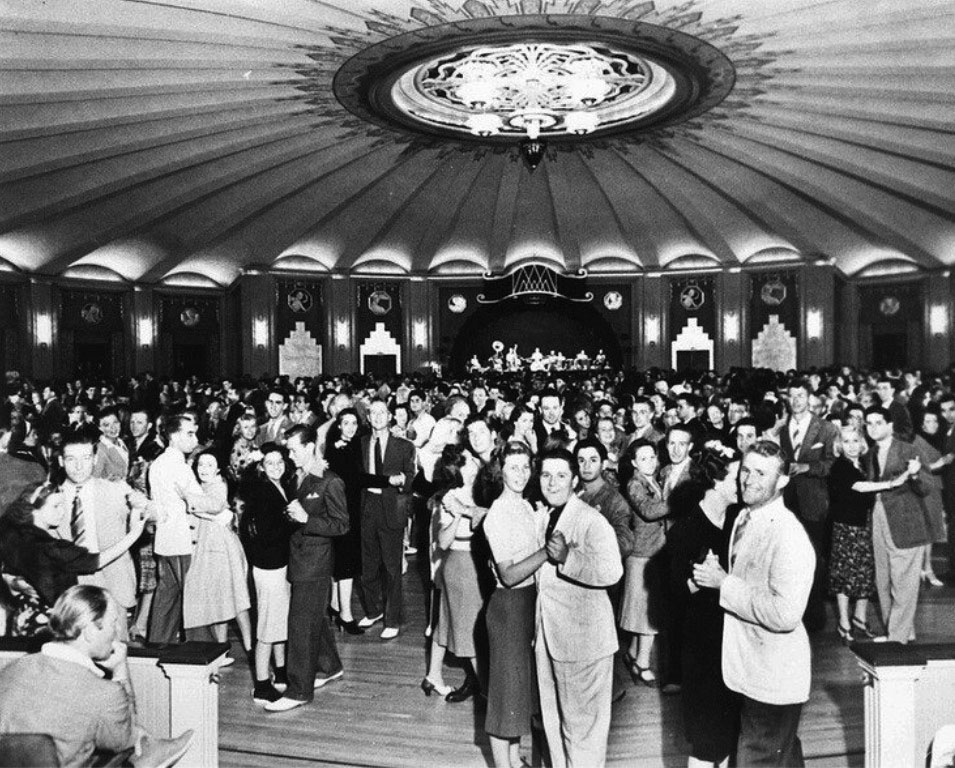 |
|
| (1940)*^*# – Closer view showing a jam packed Casino Ballroom. Everyone seems to be having a good time. Note the beautiful ornate ceiling with its unique sunburst lighting design. |
Historical Notes Sumner Spaulding and Walter Weber designed the building in Art Deco and Mediterranean Revival styles. It received the Honor Award from the California Chapter of the American Institute of Architects, as "one of the outstanding architectural accomplishments.” |
* * * * * |
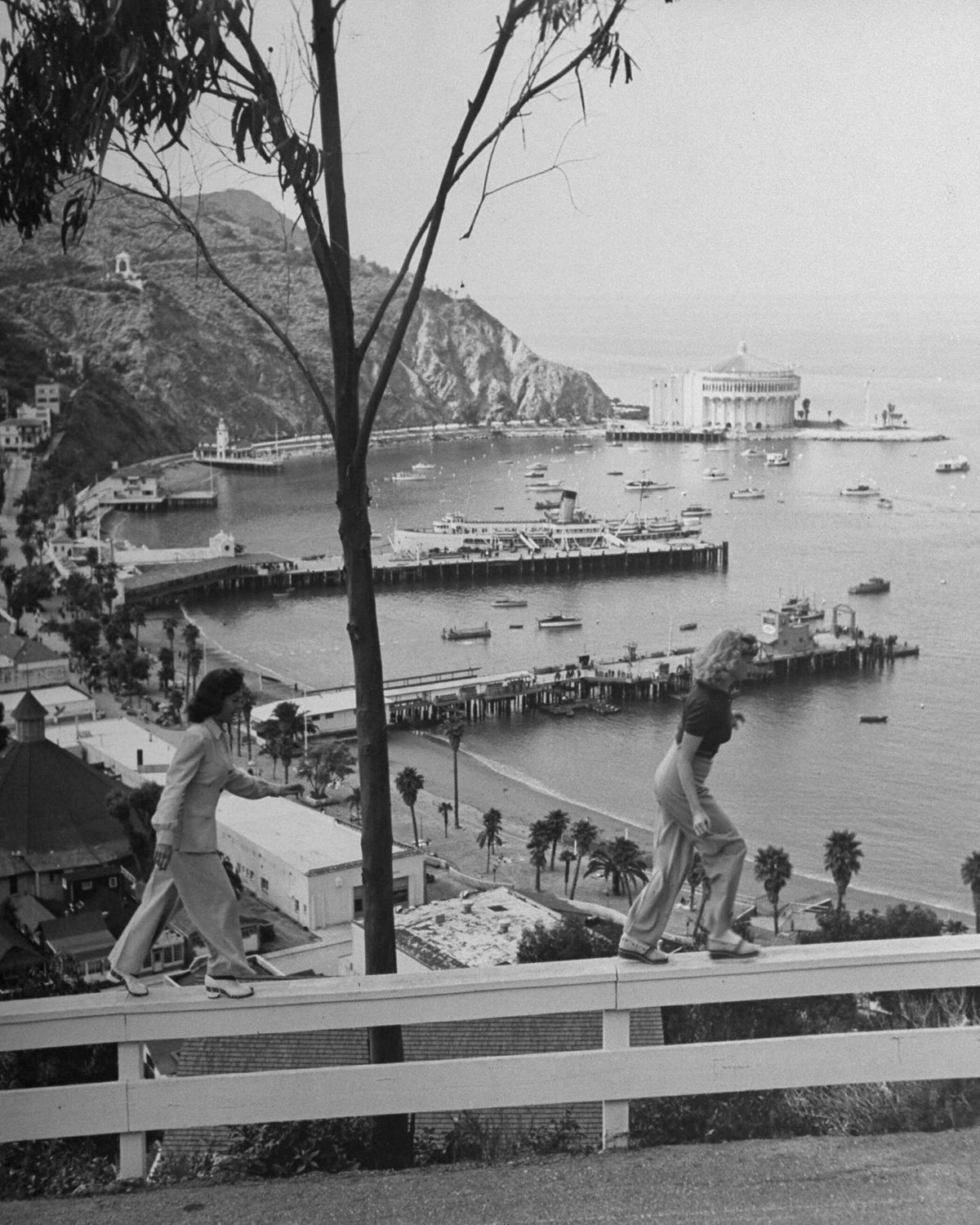 |
|
| (1941)* - Columbia bit-players Patti McCarty and Betty Brooks on a weekend trip to Catalina. Photographed by Peter Stackpole for LIFE. |
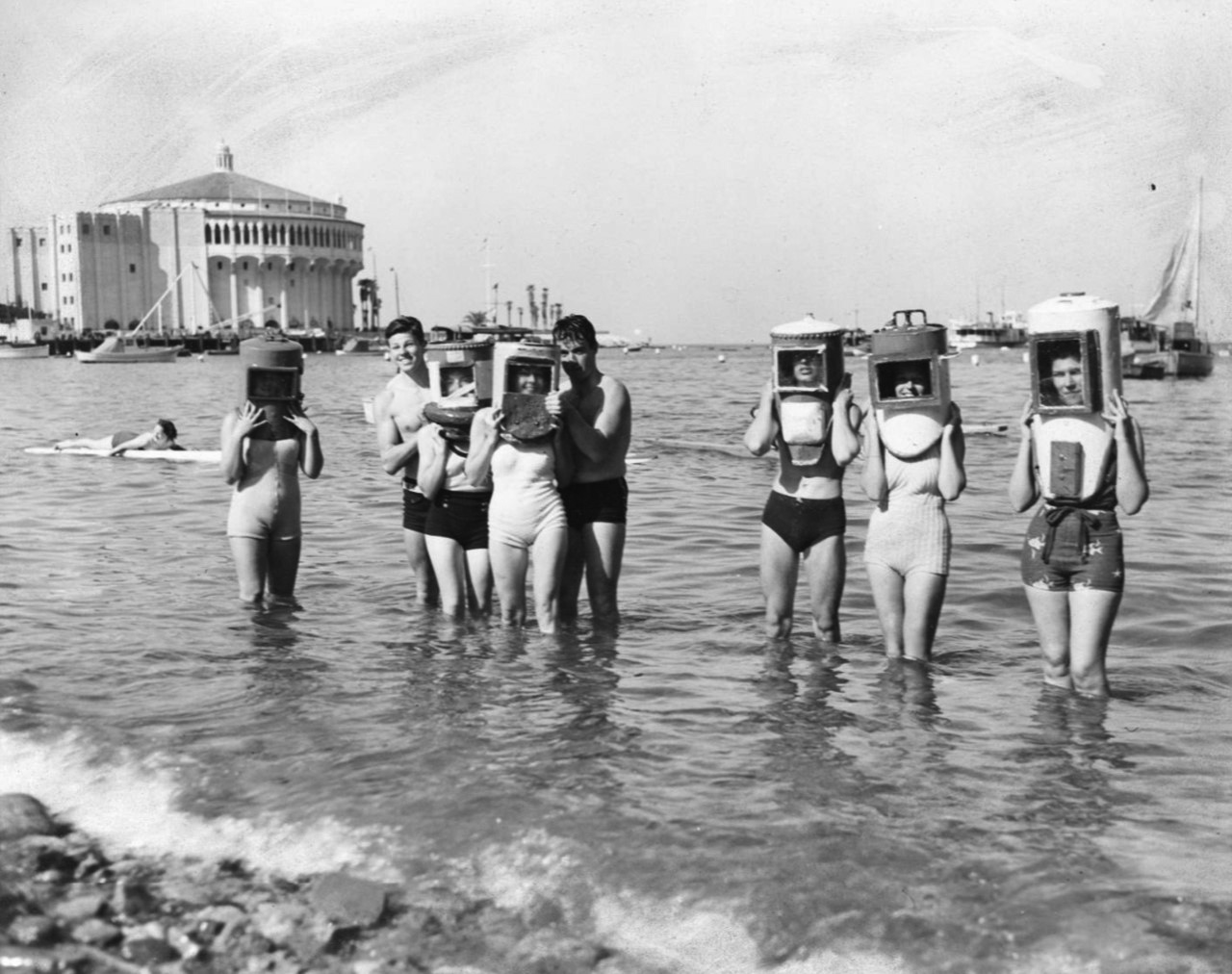 |
|
| (ca. 1940)* - Eight divers stand in knee-deep water on Front Beach in Avalon, Catalina. |
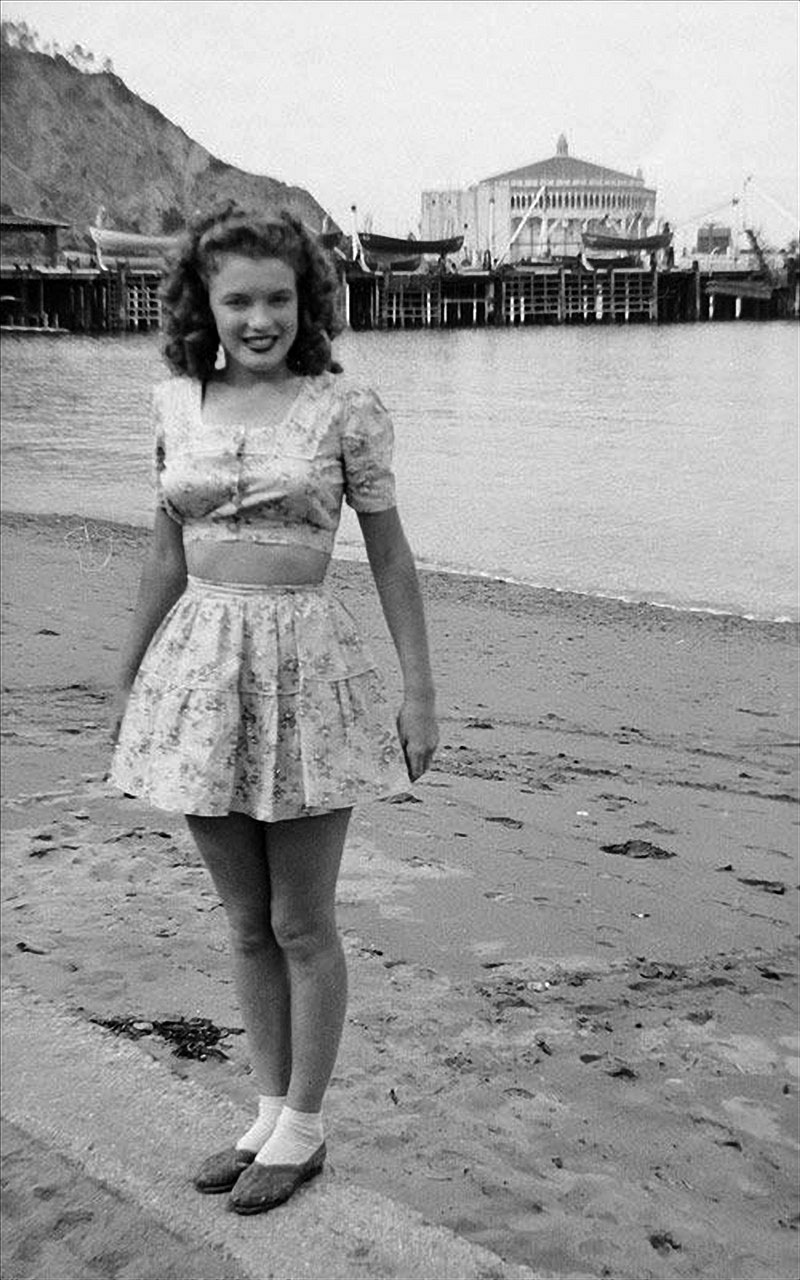 |
|
| (ca. 1943)* - Norma Jeane Baker, future film star Marilyn Monroe (1926 - 1962), on the beach at Avalon. Her first husband James Dougherty was stationed on the island's boot camp at the time. In the background is the Catalina Casino. |
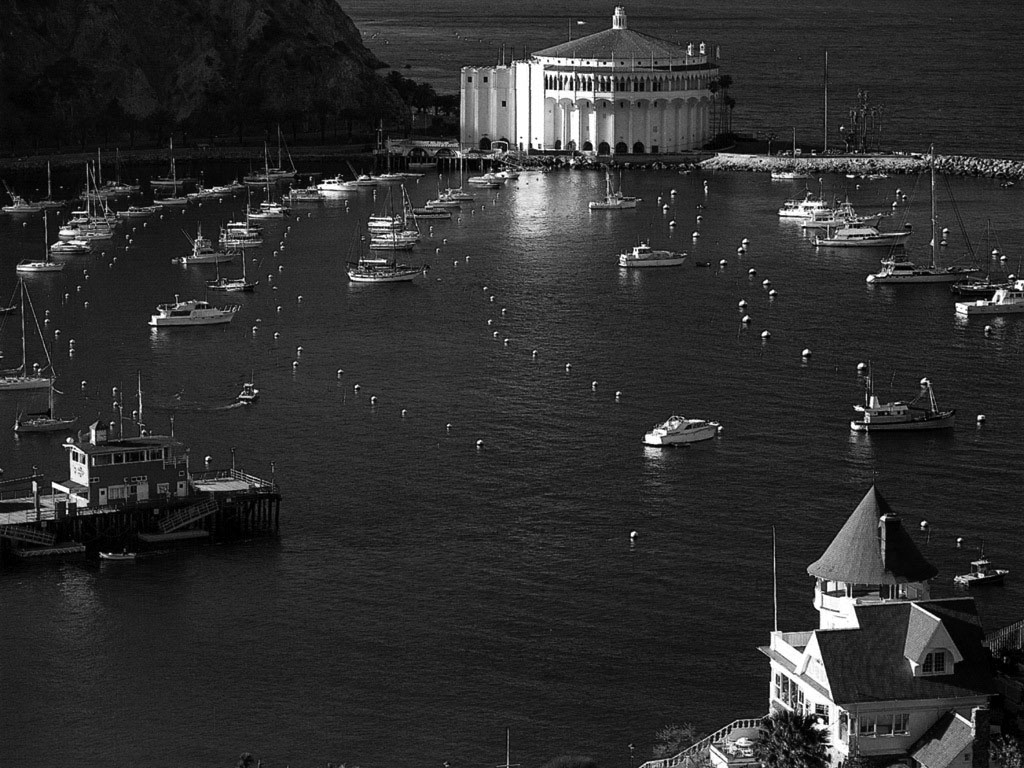 |
|
| (2010)^#^ - View of Avalon Harbor from the south with Holly Hill House at lower right and the iconic Catalina Casino across the bay. |
Historical Notes Avalon's oldest remaining structure, the distinctive Holly Hill House, was built on a lot purchased from Shatto and his agent C.A. Summer for $500 in 1888.*^ |
 |
|
| (ca 1957)* - Night view of Avalon Bay on Santa Catalina Island. Small houses as well as various tourist-oriented businesses and office buildings appear close to the shoreline, with several larger apartment complexes in the hills farther away. The Catalina Casino, surrounded by the sea on three sides, is visible at the edge of the bay on the right along with several boats as well as "The Great White Steamer". |
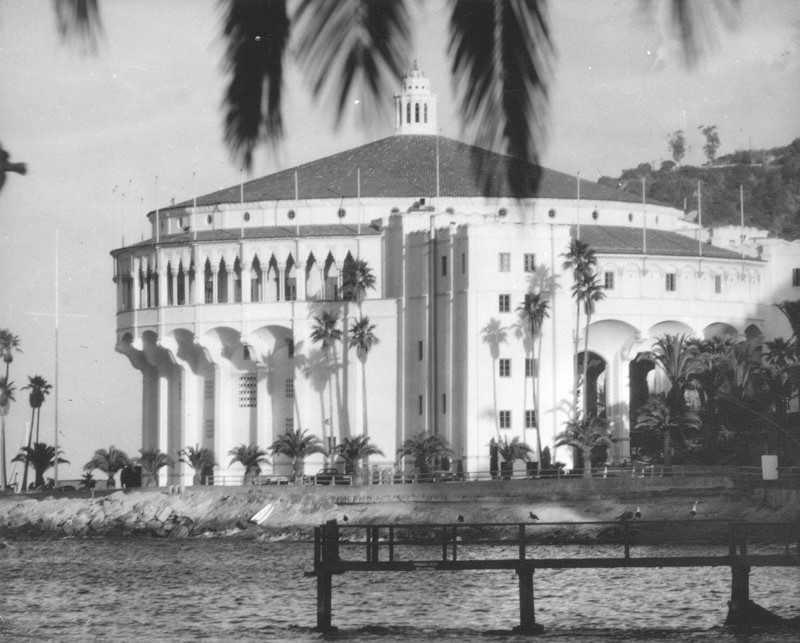 |
|
| (1977)* - Exterior view of the Catalina Casino, which gives the impression of a grand dream castle. |
Historical Notes The twelve-story Catalina Casino, a focal point of Santa Catalina Island entertainment since it opened in 1929, is surrounded by the sea on three sides. Although The Casino is an icon of Catalina and Avalon, there isn't any actual gambling allowed. The stunning Art Deco building stands at 140 feet tall and contains the world's largest circular ballroom with a 180-foot diameter dance floor as well as a beautiful movie theater. The Casino hosts most of Catalina's major indoor events, including the annual New Year's Eve Celebration, and the Catalina Island Jazz Festival..* |
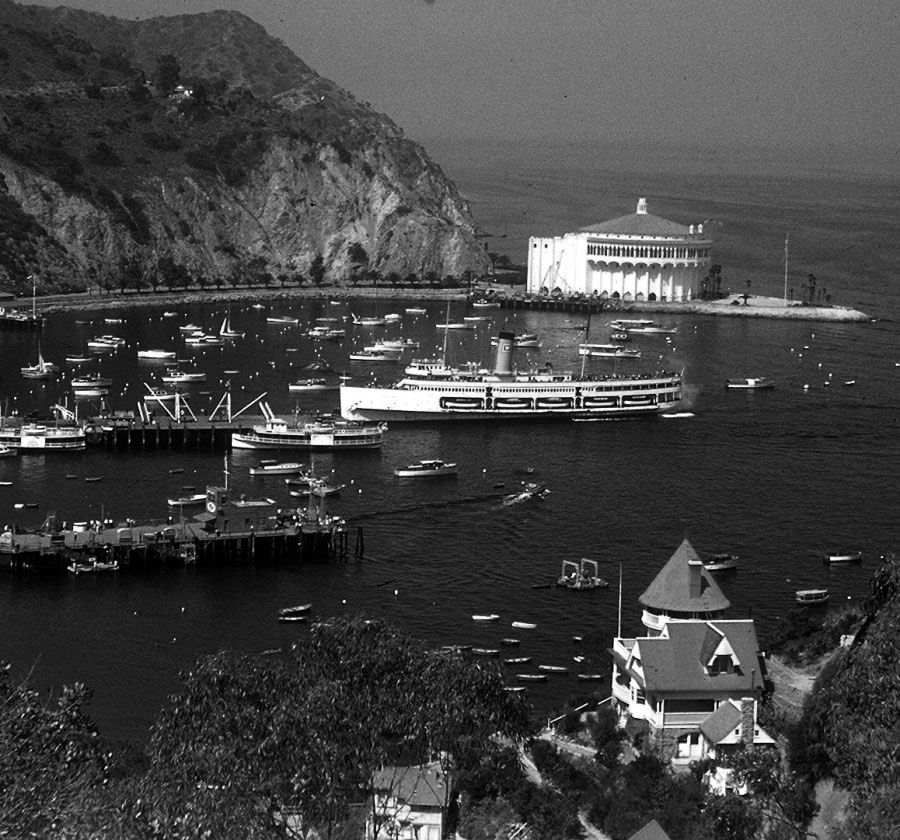 |
|
| (1940s)^#^ - View looking down at Crescent Bay in Avalon showing Catalina Casino where Big Sugarloaf and Little Sugarloaf once stood. The S.S. Catalina is seen approaching the pier surounded by smaller boats. The Victorian-style Holly Hill House, built in 1888, is seen in the foreground. |
Historical Notes The S.S. Catalina, known as "The Great White Steamer", took its maiden voyage on June 30, 1924. The 301-foot ship, originally built at a cost of $1 million dollars, was in service from 1924 until 1975.* |
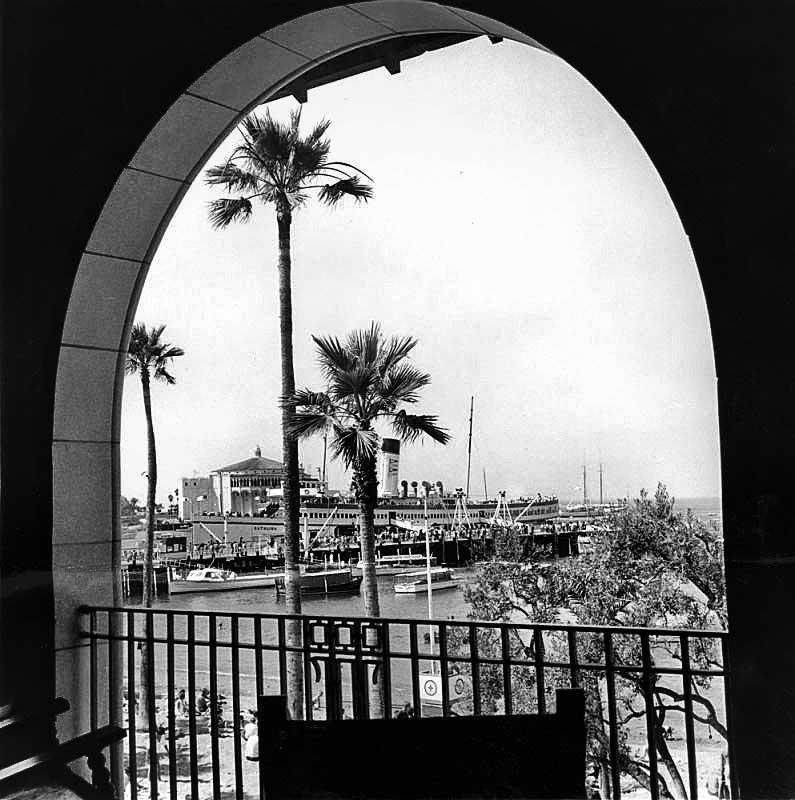 |
|
| (1962)*- Avalon, on the island of Santa Catalina, a world apart, yet only a $6.52 round-trip steamship ticket away. (Larry Paulson - Valley Times Collection) |
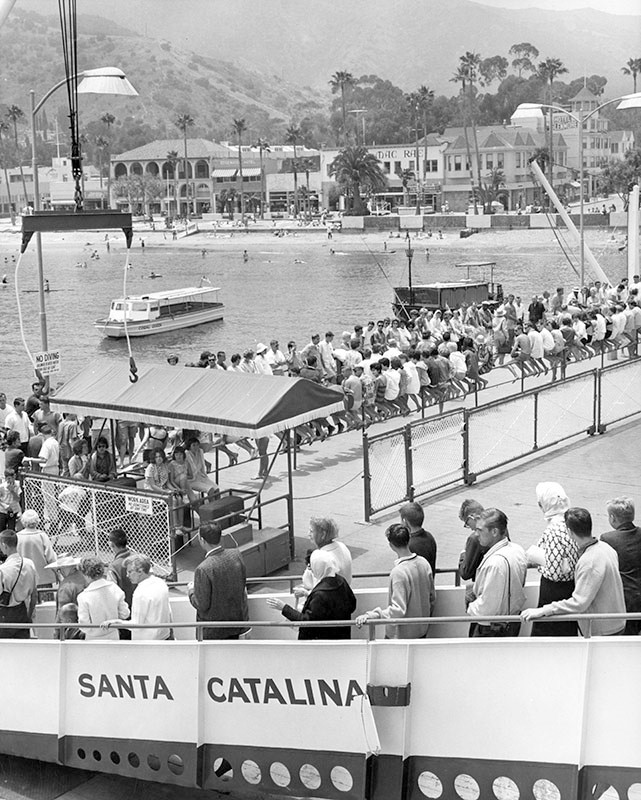 |
|
| (1962)* – View showing S.S. Catalina passengers arriving at Avalon Harbor. Visible in the background are the Campo Bravo Hotel, Hotel Mac Rae and Hotel Glenmore along Crescent Avenue. |
Historical Notes The S.S. Catalina carried 25 million passengers between Los Angeles and Avalon Harbor during its 51 years of service (1924 - 1975).* |
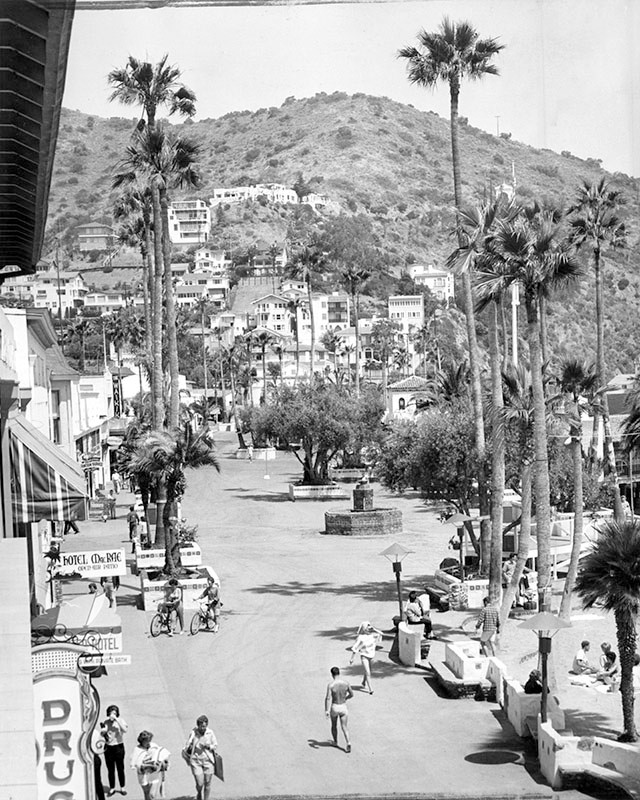 |
|
| (1962)* – View showing beachgoers walking and shopping along busy Crescent Avenue with the Hotel Mac Rae seen on the left. Photo captions reads, "Where the palms meet the pedestrians at the edge of the sea." |
Historical Notes Herbert Dewey Mac Rae moved to Catalina Island in 1906 and was the accountant for the Banning Brothers. He bought the two lots that were destroyed by the 1919 Avalon fire and built the Hotel Mac Rae in 1920. By using clay tile instead of wood, the Hotel Mac Rae became the first fire-proof hotel in Avalon. |
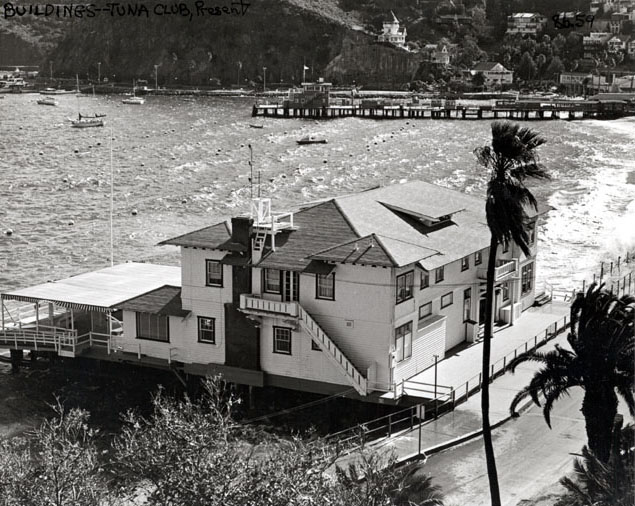 |
|
| (1984)* - View showing the Tuna Club of Avalon, located at 100 St. Catherine Way. Holly Hill House can seen in the distance. |
Historical Notes The Tuna Club of Avalon is listed on the National Register of Historic Places listings in Los Angeles County, since April 2, 1991. It is also listed as California Historical Landmark No. 997 (Click HERE to see more). |
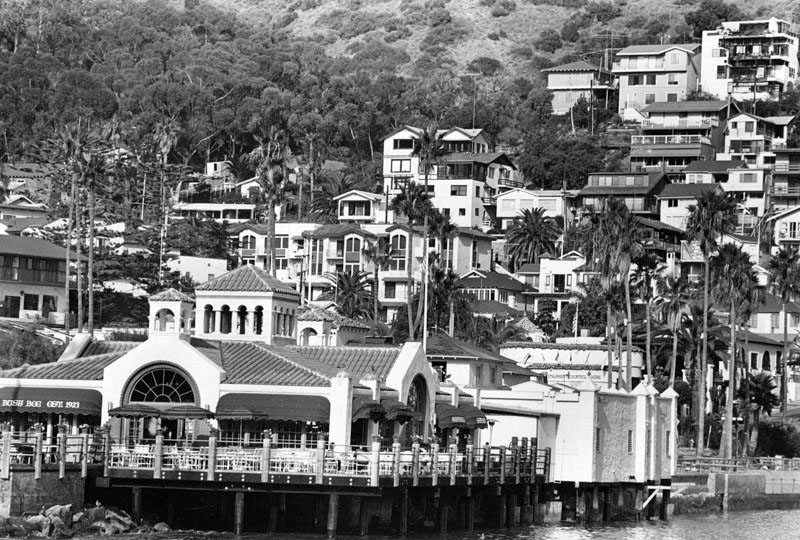 |
|
| (1984)*- View showing mostly homes and palm trees on the hillside above Avalon Bay. |
Historical Notes Avalon, or Avalon Bay, the only "official" city on Santa Catalina Island, is a rural waterfront town with the usual tourist-oriented businesses and services lining the coastline. Beside Avalon, the only other center of population is the small, unincorporated town of Two Harbors on the island. As of the 2000 census, there were approximately 3,127 people residing in the city.* |
.jpg) |
|
| (ca. 2000)*^^* – Close-up view of Avalon Harbor full of pleasure boats, with homes and palm trees seen in the background. |
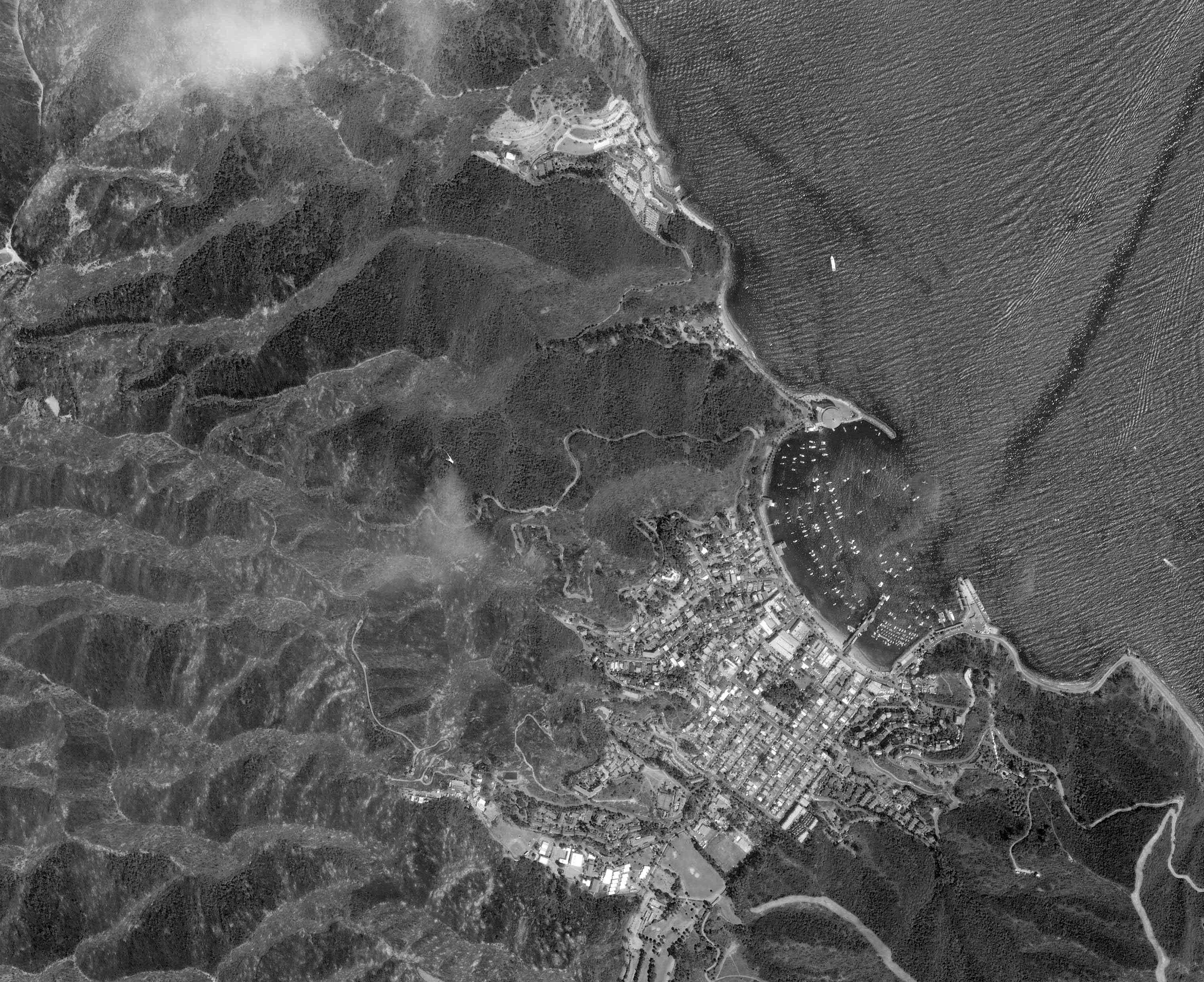 |
|
| (2007)*^^^ – Satellite image of Avalon Bay, courtesy of GeoEye. |
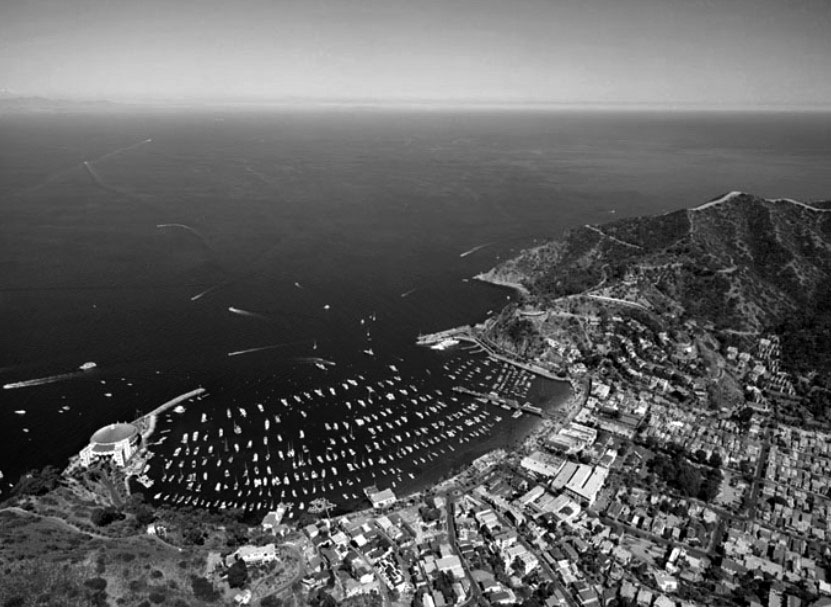 |
|
| (2009)***^ – Aerial view showing an almost filled-to-capacity Avalon Harbor. |
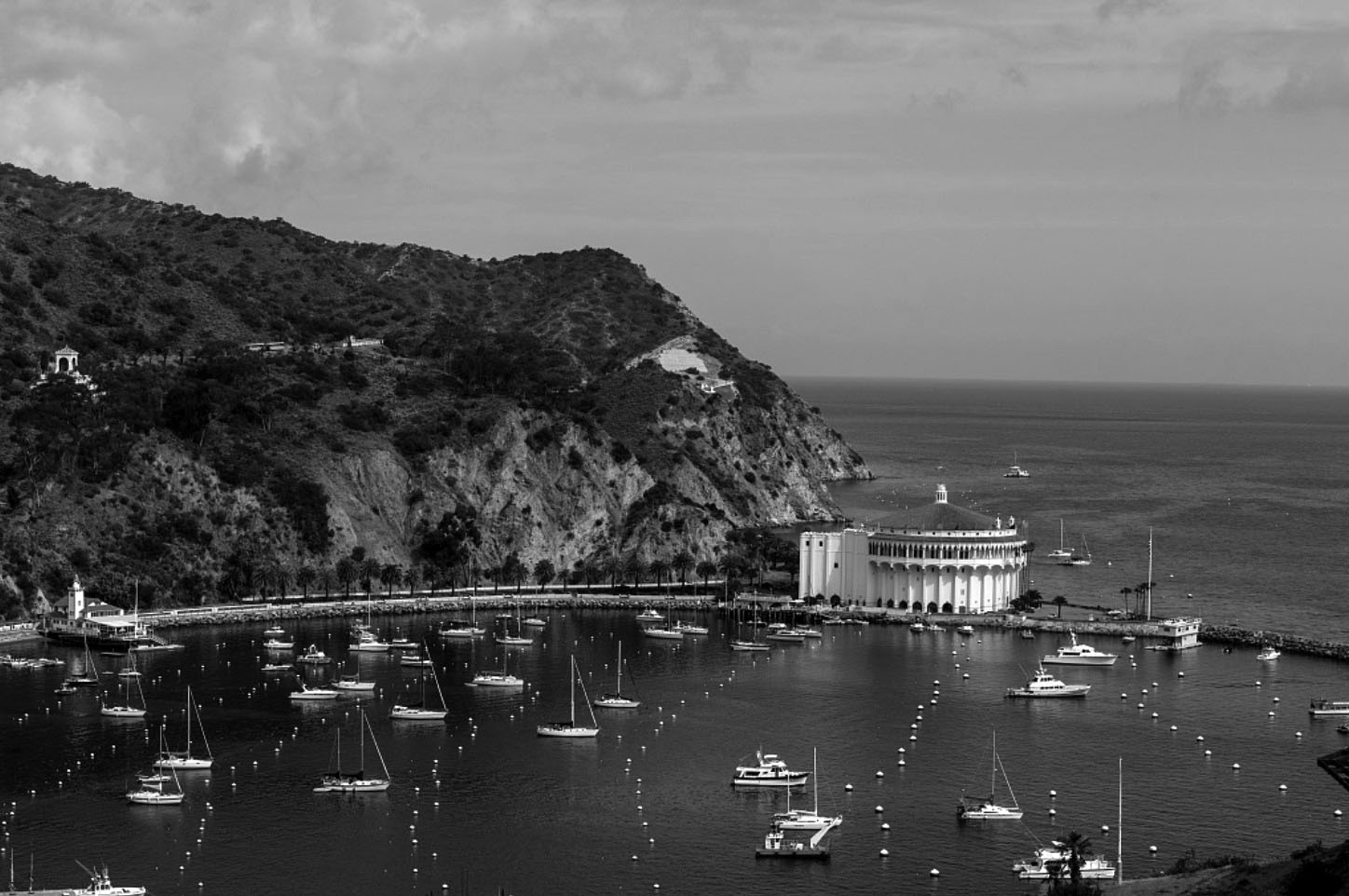 |
|
| (2013)** - View looking across the harbor toward the Avalon Harbor Casino. The Chime Tower can be seen on the hill at left-center. |
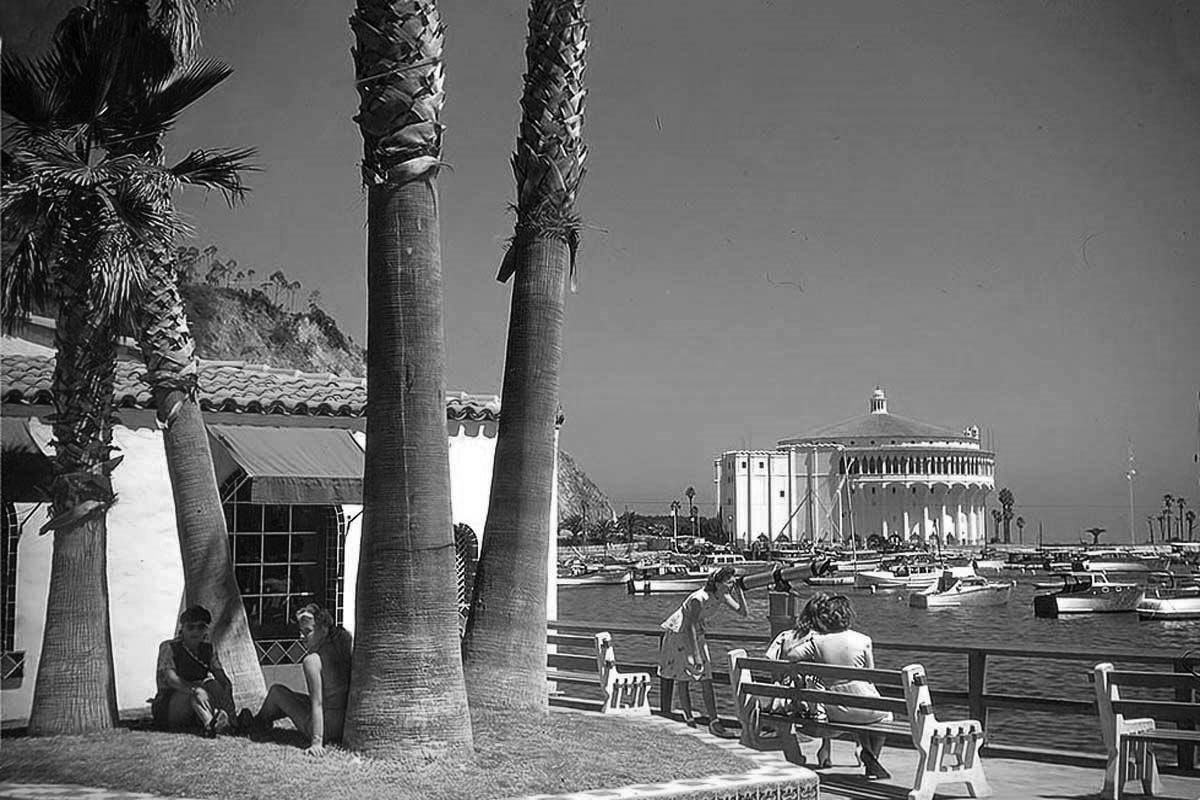 |
|
| (n.d.)*^*# - View showing tourists enjoying the day at Avalon Harbor with the towering Catalina Harbor Casino seen in the background. |
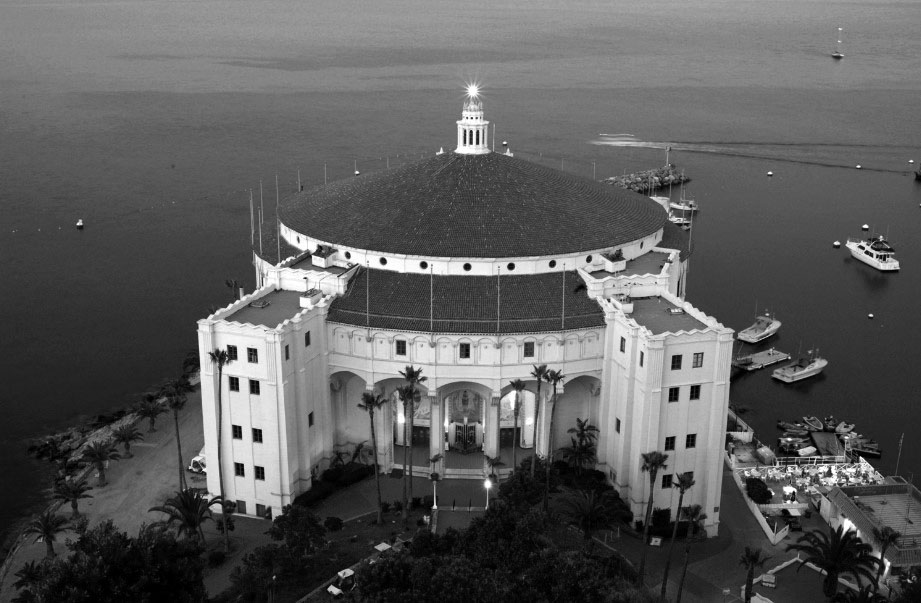 |
|
| (2014)#*^ – Close-up view, looking southeast, of the Catalina Island Casino. It received the Honor Award from the California Chapter of the American Institute of Architects, as "one of the outstanding architectural accomplishments.” |
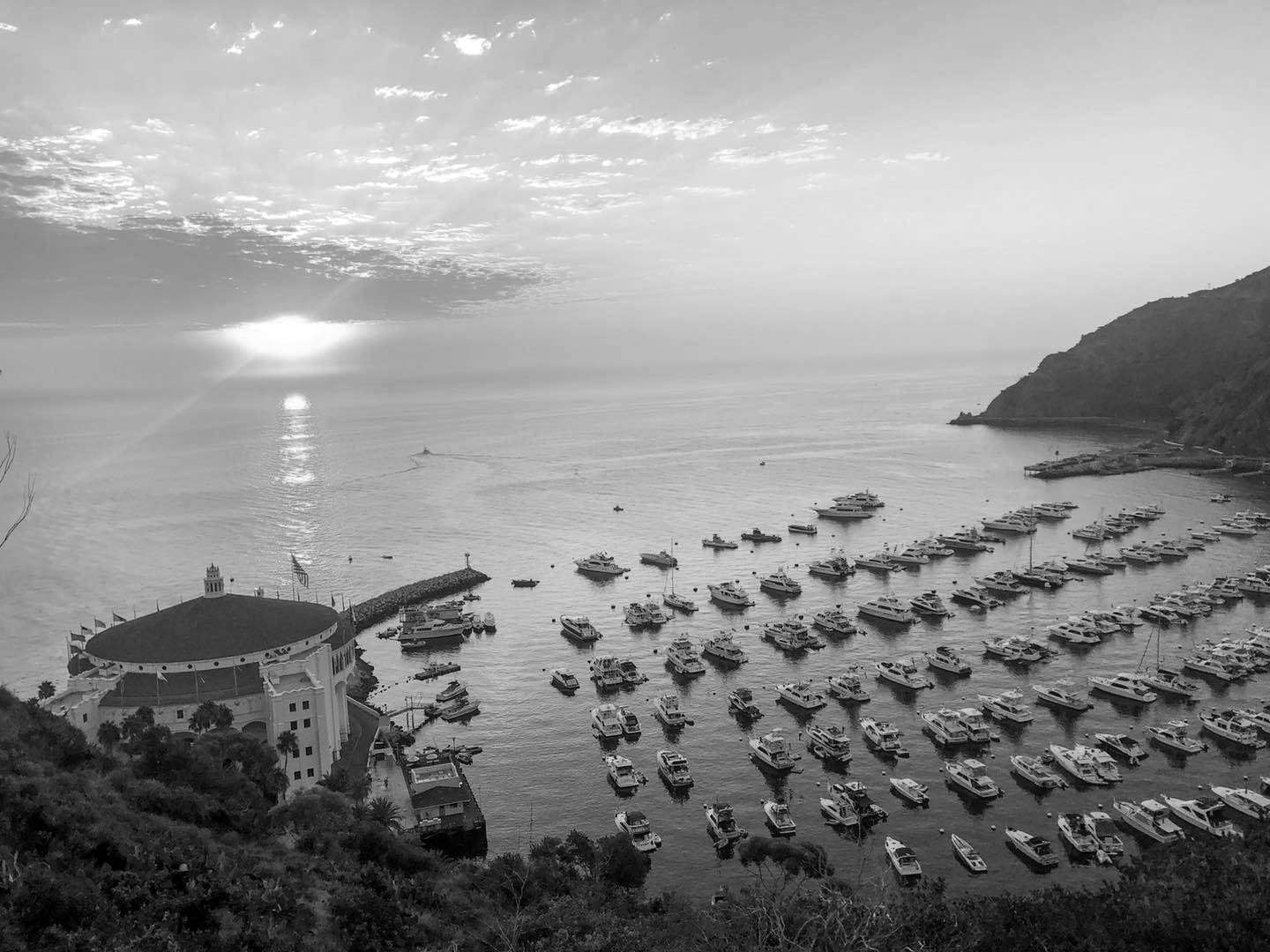 |
|
| (2020)^.^ - Avalon Harbor sunset. Photo courtesy of Love Catalina Island |
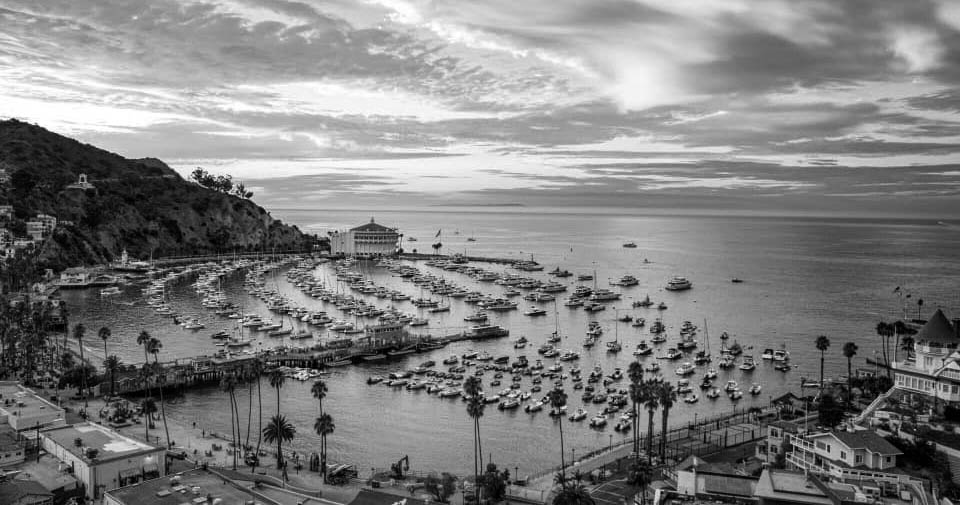 |
|
| (2020)* - Avalon Harbor with the Catalina Island Casino in the distance and the 1890-built Holly Hill House seen at right. Photo courtesy of Love Catalina Island |
* * * * * |
Avalon Bay - Then and Now
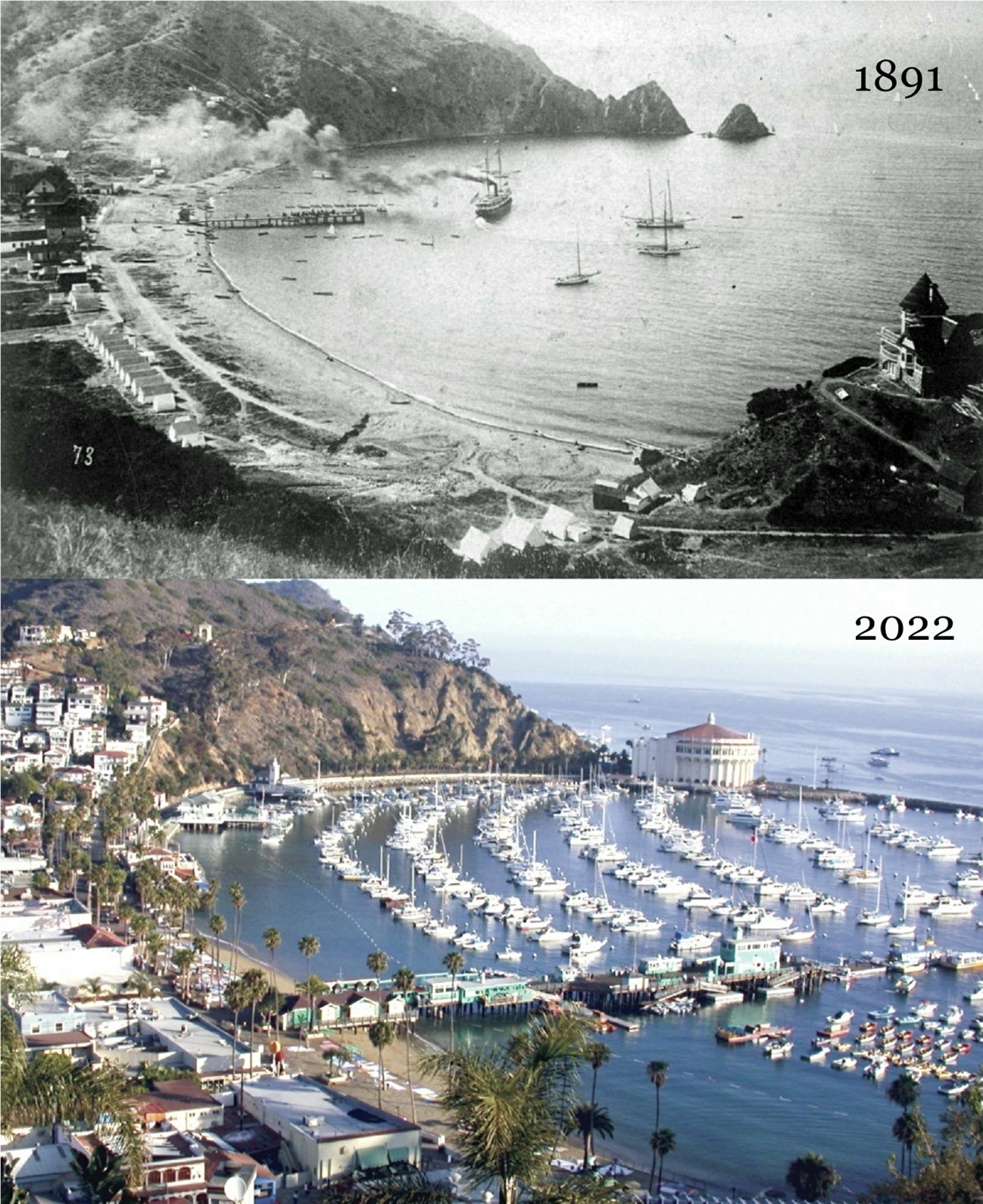 |
|
| (1891 vs 2022)* – Avalon Bay Harbor. Then and Now comparison by Augie Castagnola. |
Avalon Bay - Then and Now
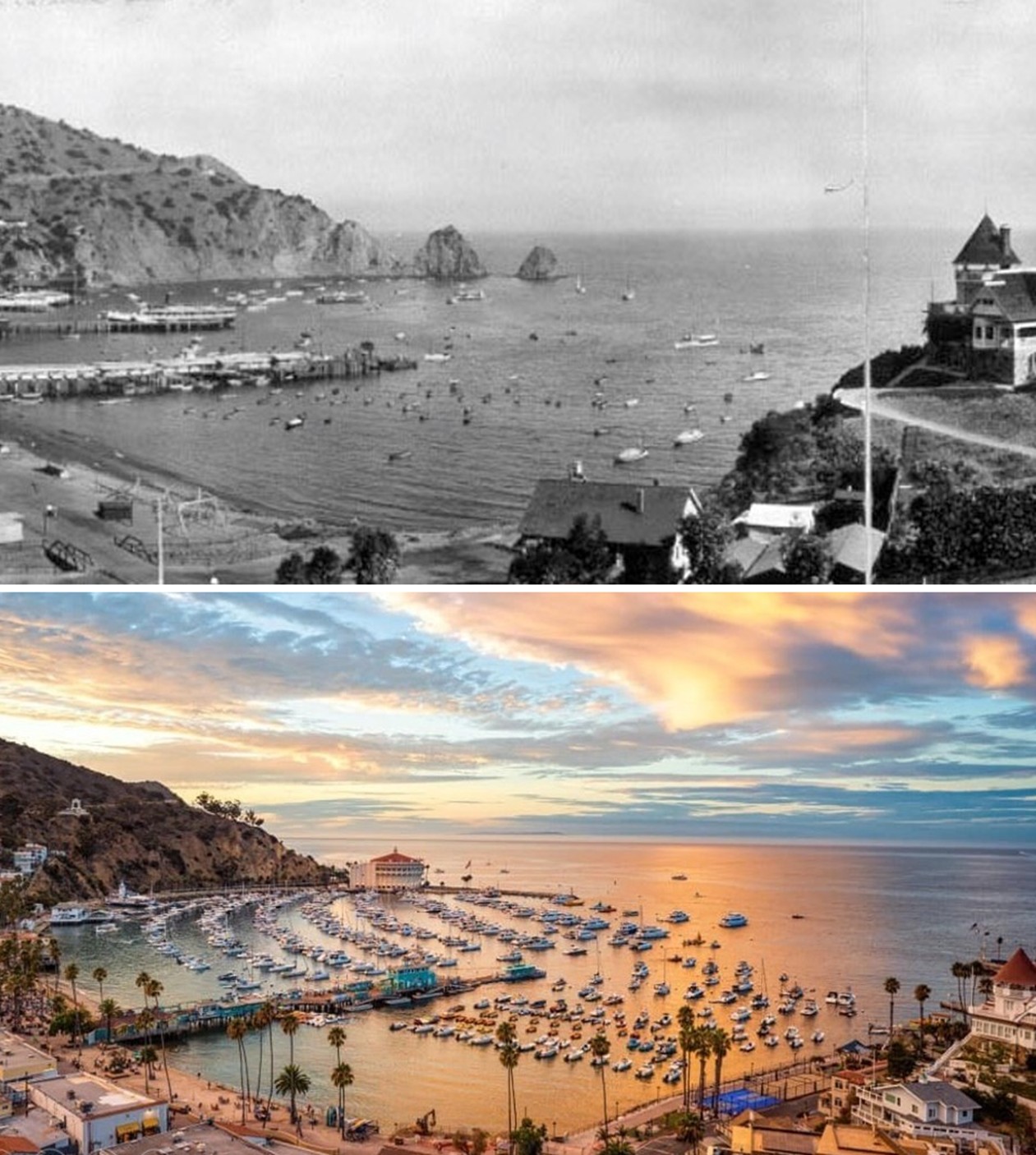 |
|
| (1914 vs 2020)* – A ‘Then and Now’ Photo Comparison of Avalon Bay, Catalina. Photo comparison by Jack Feldman. |
* * * * * |
Sugarloaf Point - Then and Now
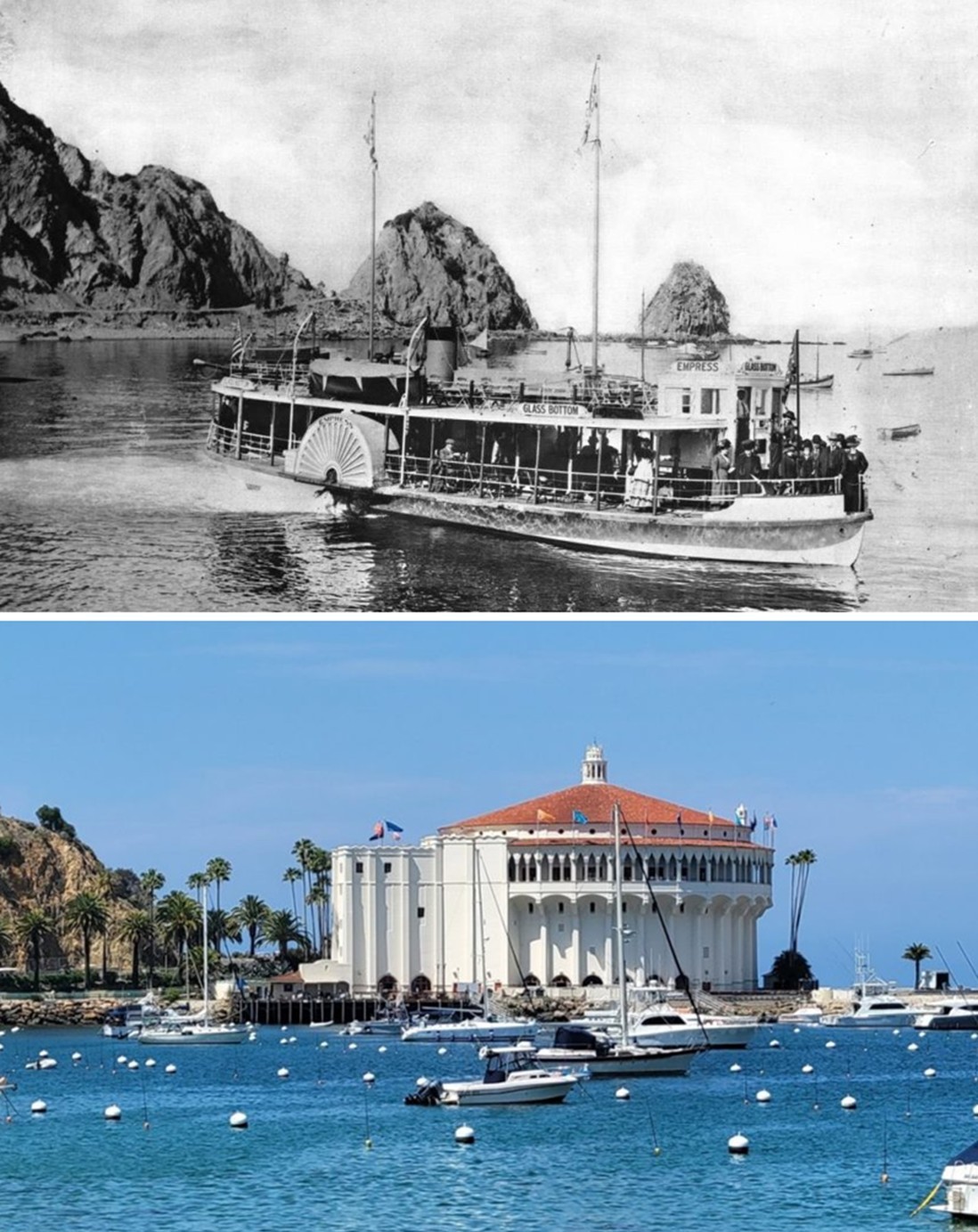 |
|
| (1917 vs. 2022)* – A 'Then and Now' Comparison of Sugarloaf Point, Site of the Present-Day Catalina Casino. Contemporary photo by Andrew Schmidt. Photo comparison by Jack Feldman. |
Historical Notes To make room for the original Sugarloaf Casino (built in 1920), Little Sugarloaf was removed. Later, when Wrigley commissioned the construction of the current Catalina Casino (completed in 1929), Big Sugarloaf was also leveled to provide a larger and more stable foundation. Part of the adjacent hillside was also cut back to allow construction of an access road around the point. |
* * * * * |
Catalina Casino (Before and After)
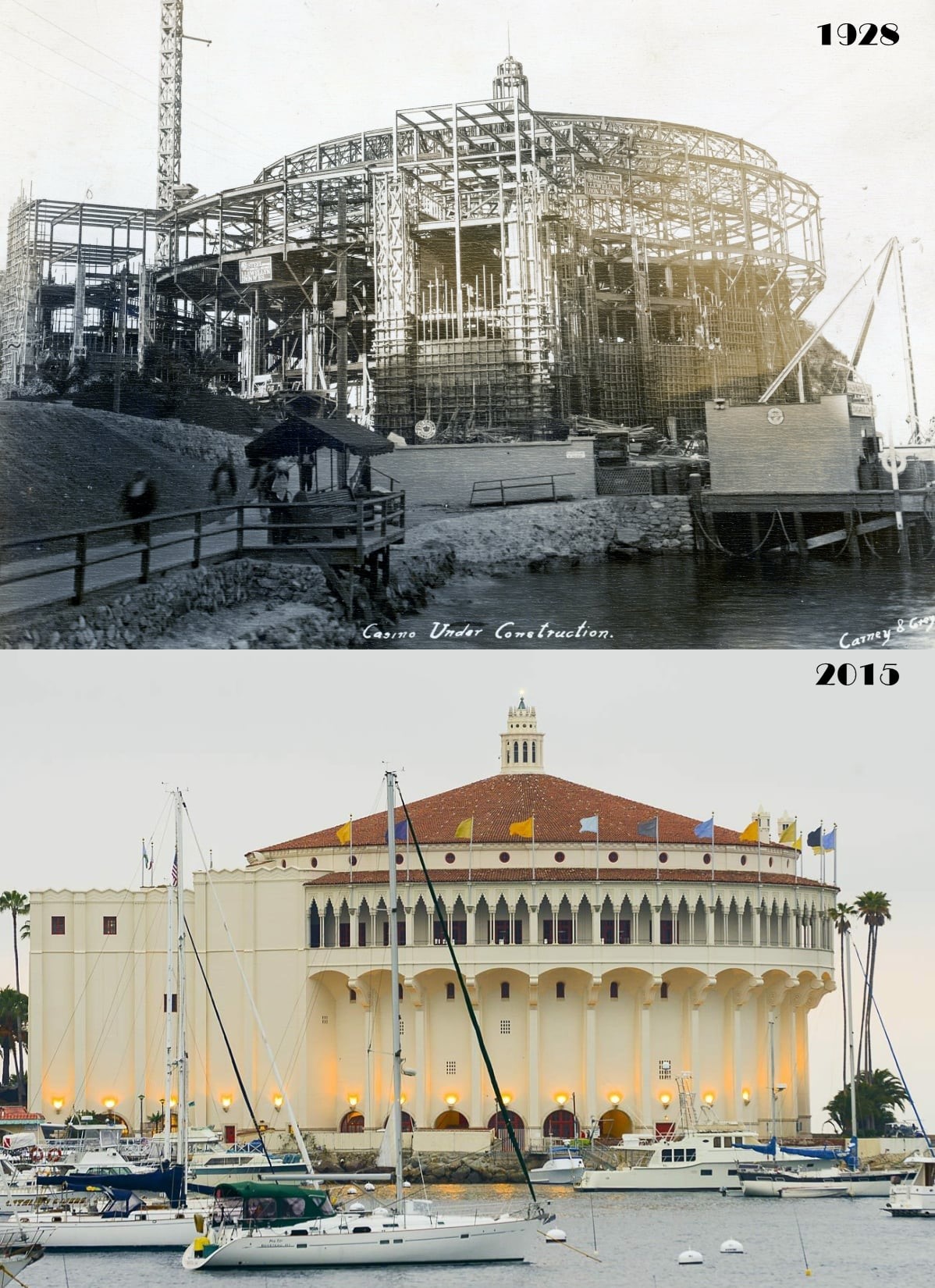 |
|
| (1928 vs. 2015)* - Catalina Island Casino - Before and After. |
* * * * * |
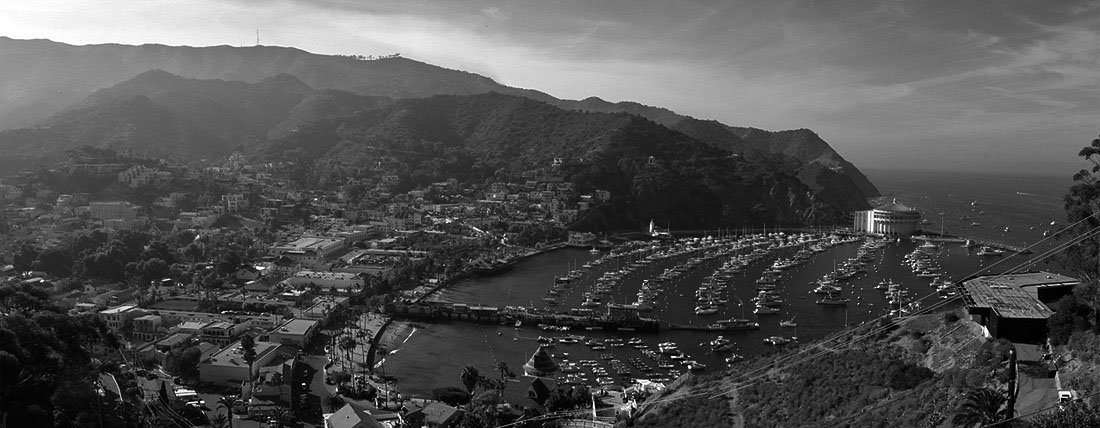 |
|
| (2004)* - Panoramic composite photo of Avalon Bay looking northeast. Photo by Aaron Logan / Wikipedia |
* * * * * |
Catalina - Aerials
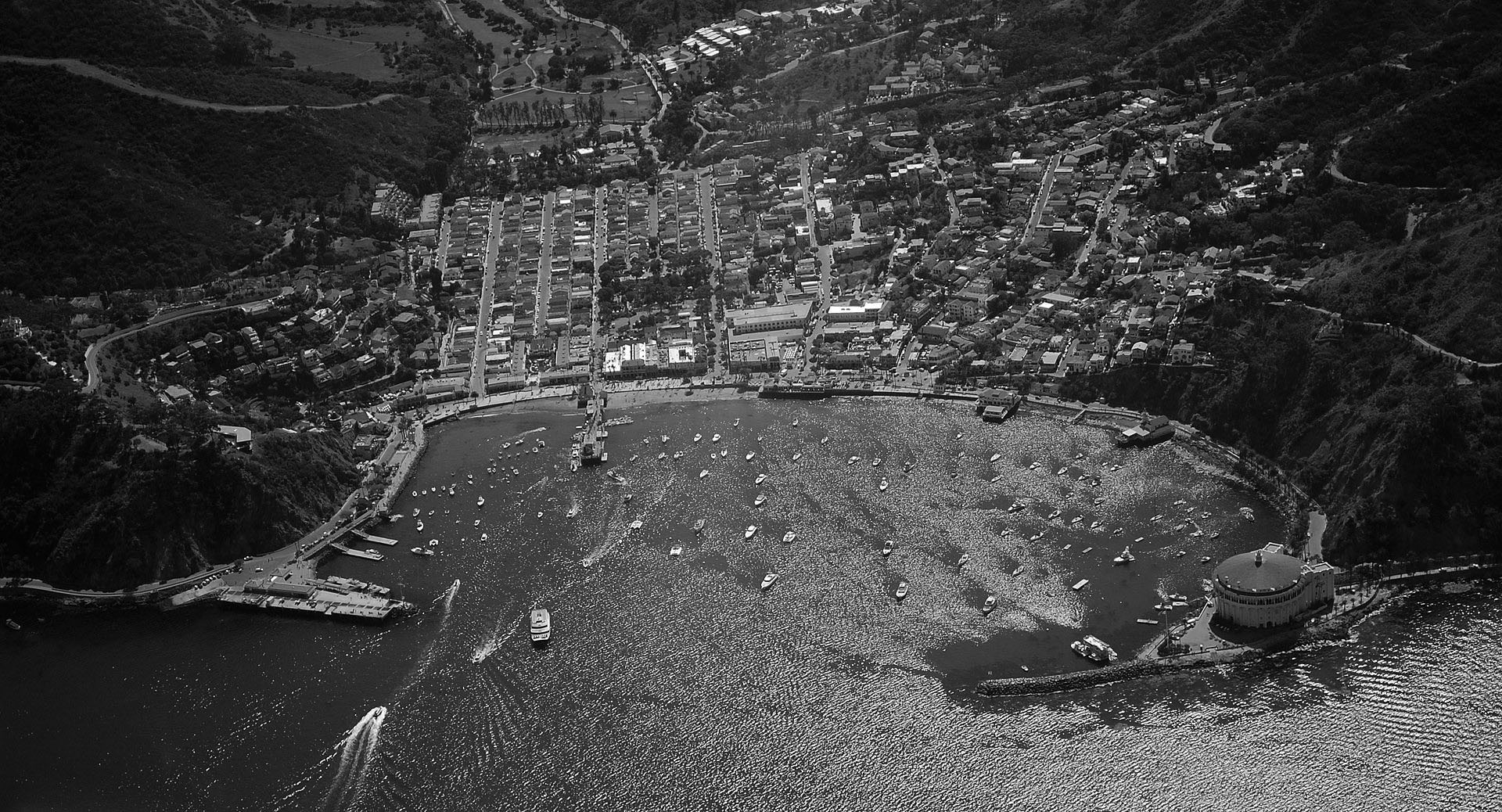 |
|
| (2012)* - Panoramic view of the town of Avalon, Catalina Island, and its bay as seen from the sky. Photo by Spartan7W / Wikipedia |
 |
|
| (ca. 2010s)* - Aerial view showing a boat entering into Avalon Harbor. The beautiful rugged hills stand as a backdrop to the tourist town of Avalon. Photo courtesy of Catalina Conservancy |
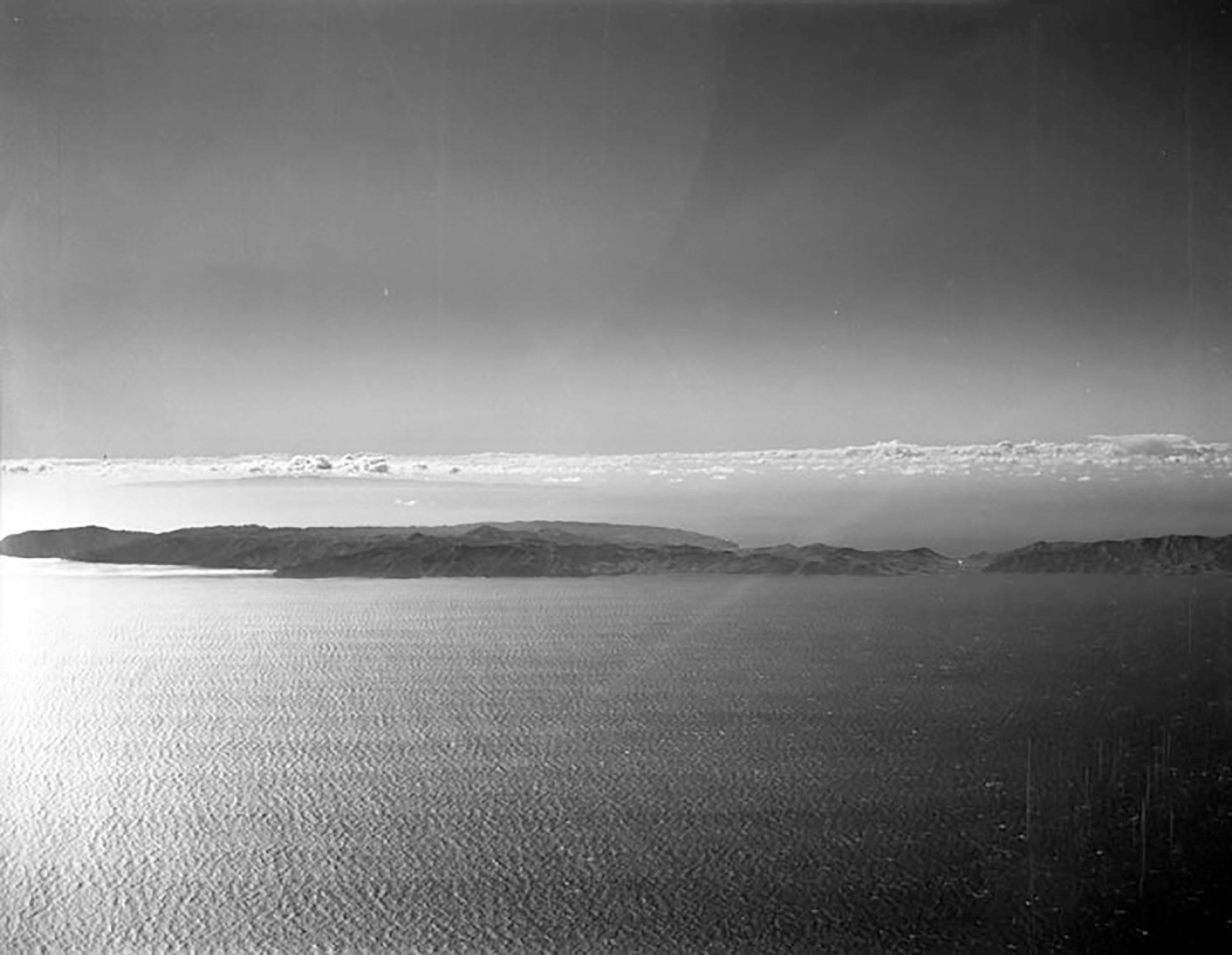 |
|
| (1955)* - Aerial view of Santa Catalina Island. Photo by Howard D. Kelly. |
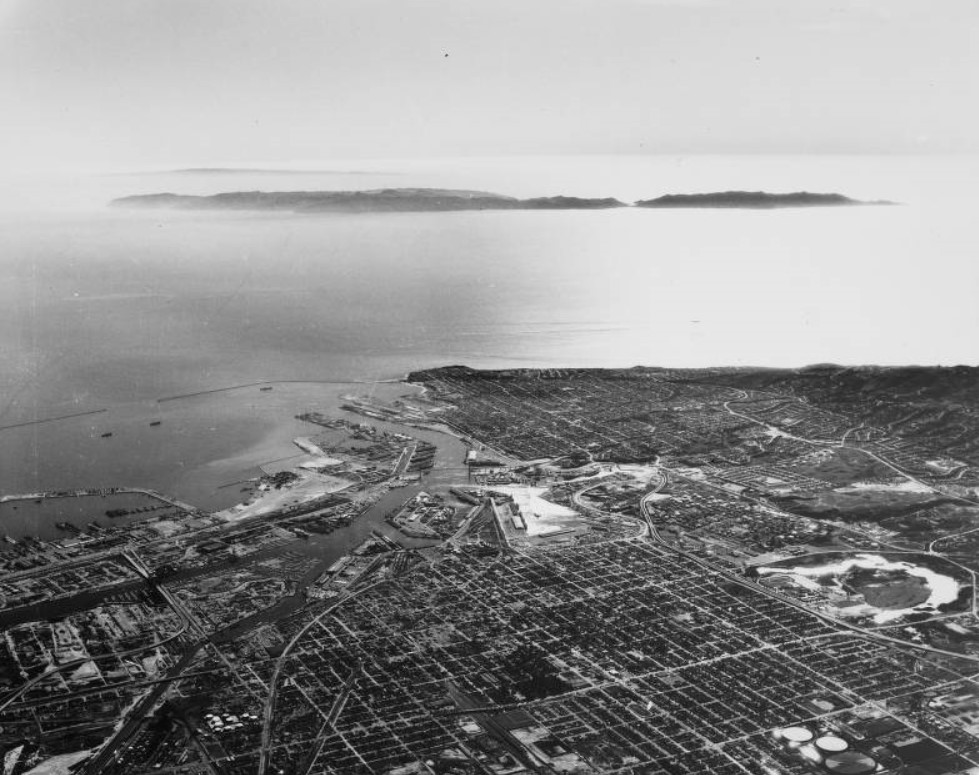 |
|
| (1964)* - Aerial View of Catalina Island as seen from over LA Harbor. 22 miles from the mainland but appearing much, much closer. USC Image Archive |
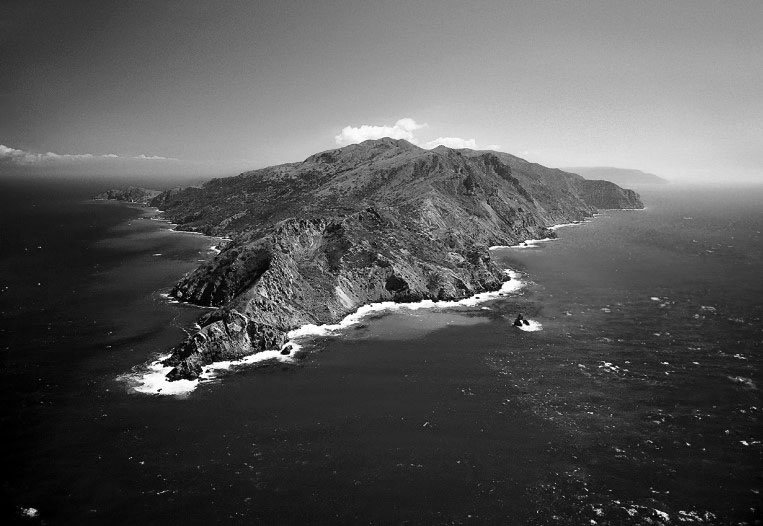 |
|
| Aerial view of Santa Catalina Island as seen from the northwest.* |
* * * * * |
Please Support Our CauseWater and Power Associates, Inc. is a non-profit, public service organization dedicated to preserving historical records and photos. Your generosity allows us to continue to disseminate knowledge of the rich and diverse multicultural history of the greater Los Angeles area; to serve as a resource of historical information; and to assist in the preservation of the city's historic records. |
More Historical Early Views
Newest Additions
Early LA Buildings and City Views
History of Water and Electricity in Los Angeles
* * * * * |
References and Credits
* LA Public Library Image Archive
** Library of Congress Image Archive; Avalon Bay ca. 1914; Sugarloaf Point Access Road
^* Islapedia.com: Black Sea Bass
+# Jennett Family Collection - Courtesy of Gilbert C. Jennett
#+ Glass Bottom Boats - Catalina
## NY Times: Chicago Cubs in Catalina
+^ Californiafish.org: Black Sea Bass
+* S.S. Hermosa
++ Exploregram.com: Chicago Cubs
*^*Seaplanes of the Magic Isle
*^#Avalon: cawreckdivers.org.com
^*#California State Library Image Archive
#*^Catalina Island Chamber of Commerce
*#*Huntington Digital Library Archive
*##Flickr.com: Zane Grey Residence
^^*S.S. Avalon and S.S. Catalina
*^^California Historic Landmark Listing (Los Angeles)
**# KCET - Three Forgotton Incline Railways
^^#Virtual Tourist: Santa Catalina Island
^#*Pinterest.com: Catalina Island
*^*^University of Maryland Digital Archive
*^*#Facebook.com: Classic Hollywood-Los Angeles-SFV
#**^LA County Library Image Archive
**#*Creating a Landmark: the Historic Casino Point
## Library of Congress Image Archive
^*^*Denver Public Library Image Archive
^**^Catalina Island Scrapbook: voncoelln.com
^*^#Facebook.com - Bizarre Los Angeles
****Pamona Public Library’s Frasher Foto Postcard Collection
***^RJL Maps: Avalon Harbor Aerial
**^^Catalina Island Conservancy
*^^^Directionsmag.com: Satellite Image of Avalon Harbor
^#^Noirish Los Angeles - forum.skyscraperpage.com; Sugarloaf Point; Avalon; Avalon Bay; Tuna Club; Chicago Cubs at Catalina Bird Park; Casino Balcony; S.S. Catalina Passengers; Casino Close-up; 425 lb. Sea Bass
^**Cruising the Past: Catalina
^*^South Bay Daily Breeze: Seaplanes to Catalina; Hotel Metropole; Spring Training with the Cubs on Catalina
#***S.S. Hermosa: pasadenastarnews.com
*^ Wikipedia: Santa Catalina Island; William Wrigley, Jr.; Avalon Bay; Avalon; Tuna Club of Avalon; Catalina Island Bison ; Catalina Casino; Zane Grey
< Back
Menu
- Home
- Mission
- Museum
- Major Efforts
- Recent Newsletters
- Historical Op Ed Pieces
- Board Officers and Directors
- Mulholland/McCarthy Service Awards
- Positions on Owens Valley and the City of Los Angeles Issues
- Legislative Positions on
Water Issues
- Legislative Positions on
Energy Issues
- Membership
- Contact Us
- Search Index